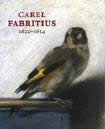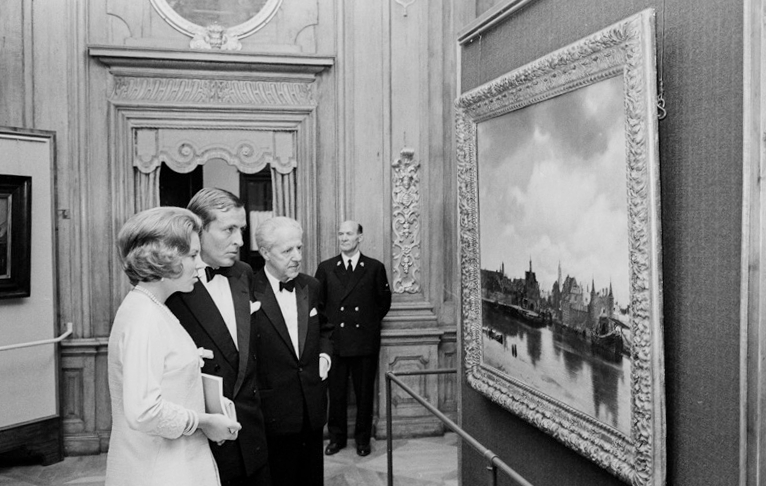
On this page are listed exhibitions, conferences, multimedia events and recent publications of the recent past which are closely related to the life and work of Johannes Vermeer.
Click here to see ongoing Vermeer-related events.
Click here to view a sortable table of all past, ongoing and future exhibitions.
2024
A New Vermeer?
The Guitar Player: A Forgery, a Copy, or an Autograph Replica from Vermeer’s Workshop?
Arie Wallert and Joris Dik
Zeitschrift fur Kunsttechnologie und Konservierung 36 (2) (2023), 334-350
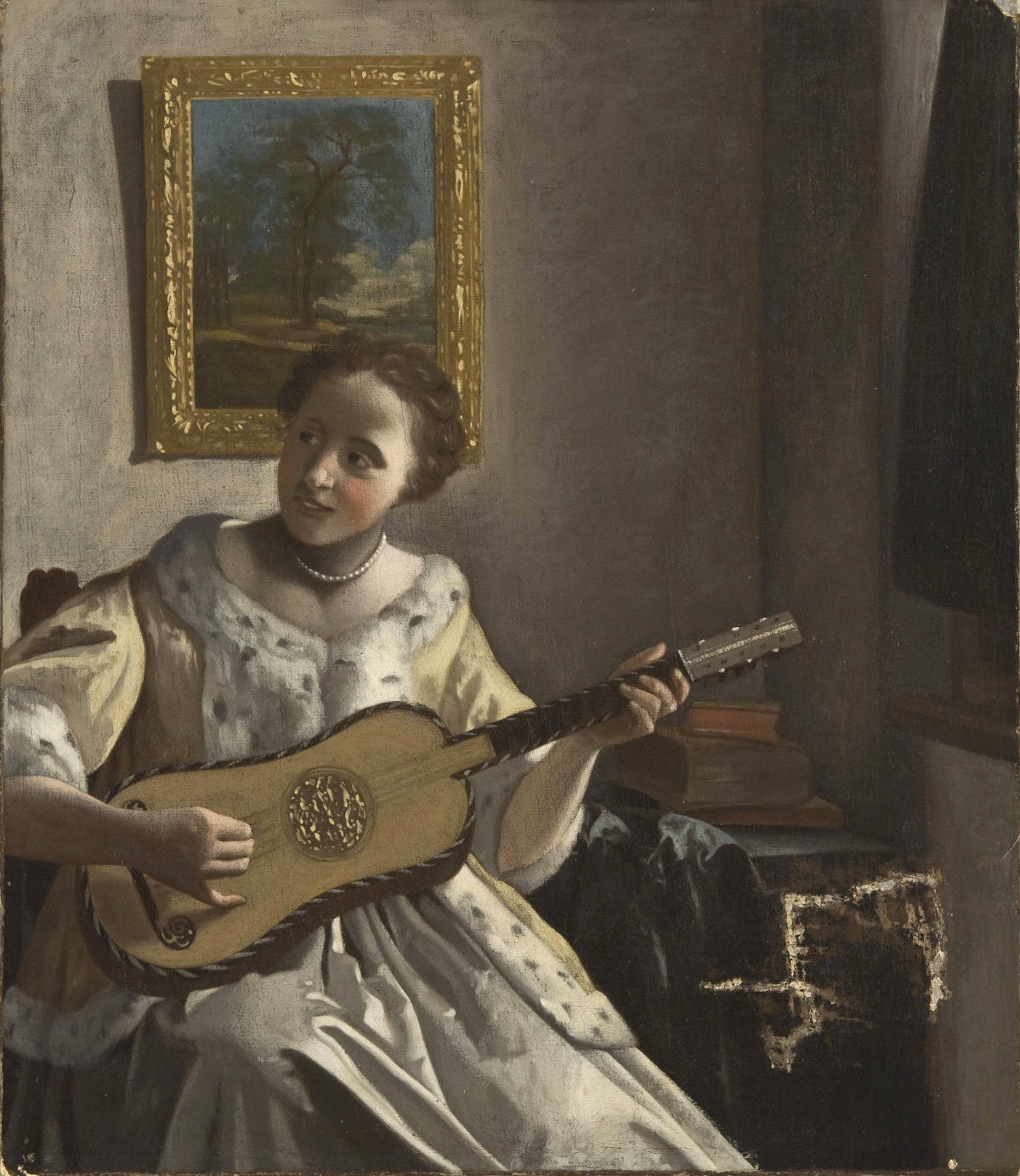
(Johannes Vermeer?)
Philadelphia Museum of Art, Philadelphia
Arie Wallert, the former Senior Scientist at the Rijksmuseum in Amsterdam, has just published an article in which he argues that a copy of Vermeer's Guitar Player in the Philadelphia Museum of Art (the original is in the Kenwood House in London) may be, despite its ruinous condition, not by a different hand but an autograph replica by Vermeer himself.
Here is the paper's abstract:
"In seventeenth century workshops, reproducing pictures was an established—but still relatively unknown—practice. Replication of similar identical paintings was accomplished by repeatedly transferring the imagery from fully worked-out studio drawings onto multiple series of prepared canvases. Mechanical transfer of underdrawings naturally affects the following stages in the process of painting. In the present paper, it is argued that the specific art-technical features of this approach can be seen in two virtually identical paintings: one Guitar Player in the Philadelphia Museum of Art and another Guitar Player in Kenwood House in London. On the basis of art-technological, stylistic, and documentary evidence, we conclude that the two, very similar, paintings are both autograph replicas made by Johannes Vermeer."
Vermeer's Lady Standing at a Virginal to be exibited at the Edinburg National Gallery of Scotland
National Treasures | Vermeer in Edinburgh
National Gallery of Scotland
May 10–September 8, 2024
https://www.nationalgalleries.org/
As part of the momentous bicentenary celebrations of the National Gallery in London, the National Gallery of Scotland has announce a special exhibition featuring Vermeer's exquisite late work: A Lady Standing at a Virginal.
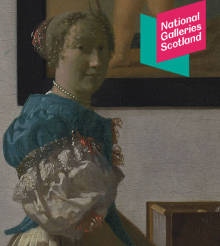
This remarkable artwork arrives in Scotland as a highlight of the National Treasures programme, a nationwide celebration commemorating 200 years of the National Gallery's rich history. In an unprecedented initiative, twelve of the most revered and beloved paintings from the gallery's prestigious collection are being shared with twelve venues across the UK. This initiative is designed to bring these cultural treasures closer to the people, ensuring that more than half of the UK population will be within just an hour’s journey of a National Gallery masterpiece.
The celebration begins on 10 May 2024, coinciding with the National Gallery's 200th birthday. A Lady Standing at a Virginal will be showcased alongside a notable early work by Vermeer from the national collection, Christ in the House of Martha and Mary offering a rare and enriching experience.
A new look at Vermeer's life, his use of the camera obscura and his ties to the Jesuit community in Delft
Johannes Vermeer: Faith, Light and Reflection
Gregor J.M. Weber
2023
https://amzn.to/42kuHGV

Little is known about the personality of Johannes Vermeer, one of the most famous Dutch painters of the seventeenth century. We do know that he married the Catholic Catharina Bolnes, whose family was closely associated with the Jesuit community in Delft. In this book, Gregor J.M. Weber, former head of visual arts at the Rijksmuseum, shows that Vermeer himself actually pursued a Catholic lifestyle. The relationship between the artistic ambitions of the young Vermeer and his Catholic surroundings is also discussed. Vermeer's unique treatment of light, perception, and perspective is examined and linked to the Jesuits' special interest in the camera obscura, the instrument of light and vision par excellence. With his research, Weber places Vermeer's person and art in a new context, which until now has only been touched upon in passing.
New Study of Vermeer's Architectural Paintings
Delft: en de Delftse Topografie (Vermeer and the Delft Topography; Dutch with English summary)
Wim Weve
with numerous diagrams and 142 color and black and white images
2023
https://wbooks.com/winkel/kunst/kunst-oude-kunst/vermeer-en-de-delftse-topografie/
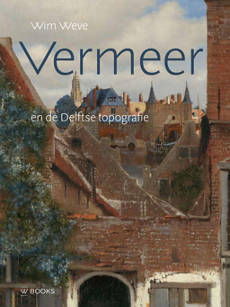
Wim Weve has extensively studied Vermeer's View of Delft and The Little Street with from a rigorous architectural/historical point of view and discovered new interesting aspects. For example, the View of Delft turns out to be, in fact, an accurate view of that city. Unlike previous hypotheses, Weve demonstrates that Vermeer did not alter or distort any buildings within the painting and correctly depicted the bridge between the city gates.
Moreover, Weve, shows that the house with the stepped gable of The Little Street must have been based on an existing house. Frequently assumed architectural 'errors' can be explained on architectural grounds. To the right of the entrance, the house must have had an inner wall that separated a side room from the front house. Because of the location of that wall, the window on the right is slightly narrower than the window on the left. Through the open doorway, however, Vermeer does not show an inner wall. The artist combined various architectural elements in an architecturally impossible way, probably as a visual counterweight to the house with the stepped gable on the right.
Vermeer Retrospective Catalogue
VERMEER
Gregor J. M. Weber and Pieter Roelofs
2023
200 color illustrations
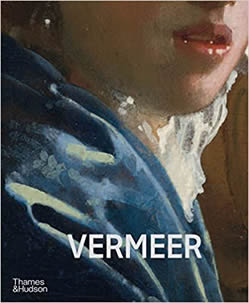
Published to accompany the once-in-a-lifetime exhibition at the Rijksmuseum, Amsterdam, this is the first major study of Vermeer’s life and work in many years.
Johannes Vermeer’s intensely quiet and enigmatic paintings invite the viewer into a private world, often prompting more questions than answers. Who is being portrayed? Are his subjects real or imagined? What is shown on the map on the wall? What news does a letter bring?
Seemingly unaware of the viewer, each subject―the milkmaid,the guitar player, the girl with a pearl earring―occupies an intimate and private space. Vermeer’s paintings, with their enigmatic interiors and masterful handling of natural light, bring us into a closed, internal world, but with many tantalizing points of contact with the outside world. What details do we know of Vermeer’s personal life? How did it affect his painting style?
This is the first major study of Vermeer’s life and work for many years, bringing together diverse strands of his professional and private life in Delft in the seventeenth century and examining important research that has revealed new ways of looking at his paintings.
Vermeer's Misterss and Maid visits Dublin
Vermeer Visits
May 1–Aug 18, 2024
National Gallery of Ireland, Dublin <https://www.nationalgallery.ie/art-and-artists/exhibitions/upcoming-exhibitions/vermeer-visits>
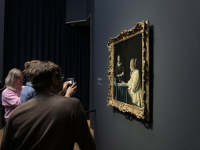
The National Gallery of Ireland unites The Frick Collection’s Mistress and Maid by Vermeer with the National Gallery of Ireland’s Lady Writing a Letter, with her Maid for Vermeer Visits. This is an unprecedented opportunity to unite the works, as the Frick’s Vermeer—one of the highlights of its holdings—has rarely travelled outside of New York. While the Frick’s period home is under renovation, Vermeer’s Mistress and Maid will make an exceptional trip to Dublin.
Curator: Dr Lizzie Marx, Curator of Dutch and Flemish Art
Dublin Tronie Exhibition with Vermeer's Girl with a Red Hat
Turning Heads; Bruegel, Rubens and Rembrandt
National Gallery of Ireland, Dublin
24 February–26 May 2024 <https://www.nationalgallery.ie/art-and-artists/exhibitions/turning-heads-rubens-rembrandt-and-vermeer>
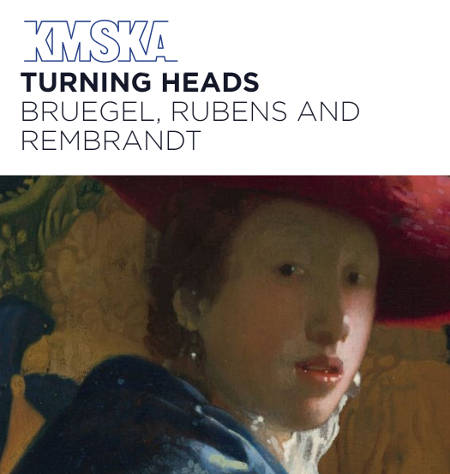
The National Gallery of Ireland is staging an entire exhibition dedicated to the tronie—an old Dutch word for "face"or "head" that represented creative experimenting with facial expressions and particular heads—featuring some of the most iconic examples of the genre by Dutch and Flemish artists, including Peter Paul Rubens, Rembrandt, Michael Sweerts, and Vermeer.
At the forefront of the exhibition will be one of Vermeer’s most exquisitely detailed tronies, Girl with the Red Hat, which has rarely been seen outside the United States in the last century. The painting depicts a female sitter turning back, with two major color themes present through the titular red hat and cascading blue robe. As well as being one of the smallest works he ever produced, the picture is also notable as being painted on panel and not the artist’s usual canvas.
Vermeer's Girl Interrupted at her Music Travels to Pittsburg in 2024
Vermeer, Monet, Rembrandt: Forging the Frick Collections in Pittsburgh and New York
Frick Collection Pittsburg
April 6–July 14, 2024
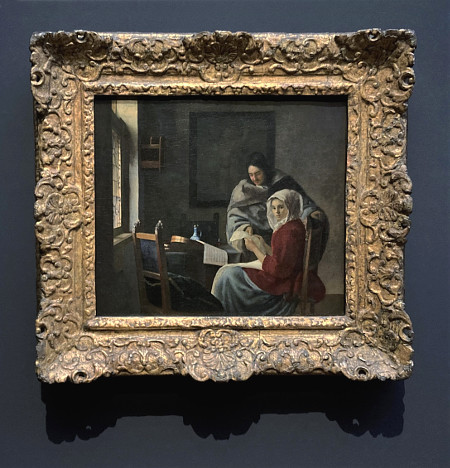
The Frick Pittsburgh is presenting an exhibition this spring that combines many of the most significant artworks from its collection with those of its sister institution, The Frick Collection in New York City. More than 60 artworks will be exhibited, including paintings, sculptures, works on paper, and decorative arts. The exhibition will focus on the collections of 19th-century industrialist Henry Clay Frick and his daughter, philanthropist Helen Clay Frick. It will highlight the similarities and differences in their collecting passions and how their acquisitions shaped the museums they established. The exhibition traces this evolution from its beginnings in the 1880s in Pittsburgh, through the family's move to New York City in 1914, to the eventual creation of The Frick Art Museum in Point Breeze in 1970.
Chief among the works included is the painting Girl Interrupted at her Music by Vermeer. This piece was featured earlier this year in the Rijksmuseum's landmark Vermeer retrospective in Amsterdam.
A pre-exhibition event—the screening of the 2023 documentary Close to Vermeer—will be held in The Frick Art Museum auditorium on Oct. 22, 2023 at 2 p.m. The film provides a behind-the-scenes look at the largest Vermeer exhibition ever mounted, which took place in early 2023 at the Rijksmuseum in The Netherlands. Due to limited seating in the auditorium, advance registration is encouraged.

Vermeer's Lacemaker Exhibited at the Louvre-Lens in Lens (Lens, France)
The Lacemaker: Iconic masterpiece from the Louvre Museum
Louvre Galerie du Temps, Louvre-Lens in Lens (Pas-de-Calais)
November 24, 2023–May 29, 2024
After being shown in the Vermeer exhibition at the Amsterdam Rijksmuseum (February 10–June 4, 2023) Vermeer's iconic Lacemaker will join a collection of 220 works loaned by the Paris Louvre to the Louvre Galerie du Temps at the Louvre-Lens in Lens (Pas-de-Calais), northern France), from June 28, for nearly a year.
The Louvre-Lens, also referred to as the Louvre's "little brother," was established as a way to decentralize France’s vast collection of art and allow a wider audience to have access to the works of great cultural and historical significance.
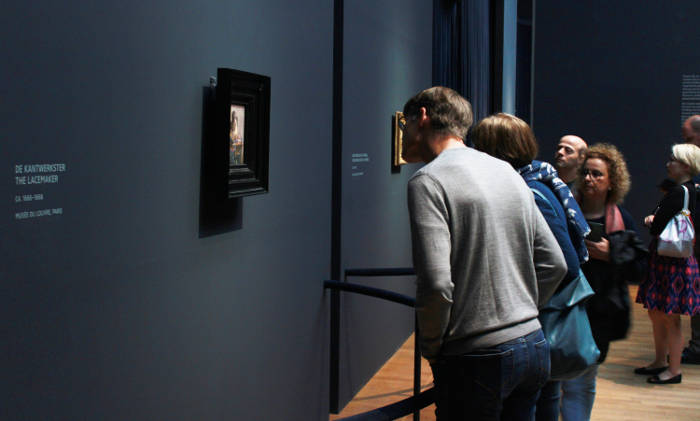
Vermeer's Girl with a Red Hat and the Leiden Collection Young Woman Seated at the Virginal Exhibited in the Rijksmuseum Gallery of Honor
Six Vermeers
Gallery of Honor, Rijksmuseum, Amsterdam
June 7–October 10, 2023<https://www.rijksmuseum.nl/en/whats-on/exhibitions/six-vermeers>
Vermeer's Girl with a Red Hat and the Leiden Collection Young Woman Seated at the Virginal will be shown with the 4 Vermeer's of the Rijksmuseum Gallery of Honor until October 10, 2023.
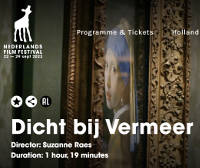

Close to Vermeer Nominated at Netherlands Film Festival
Suzanne Raes' documentary Close to Vermeer (Dicht bij Vermeer) has been nominated at the Netherlands Film Festival to be held in Utrecht from 22 to 29 September 2023. Close to Vermeer will be viewed on Tuesday, 26 September, from 5:30 p.m. to 7:15 p.m. at the Louis Hartlooper Complex 3.
To purchase tickets, login here: https://www.filmfestival.nl/en/film/dicht-bij-vermeer
Close to Vermeer stands as a Golden Calf nominee (Best Long Documentary) and is also in contention for the prestigious Septimius Award (Best Feature Documentary).
Following its successful screenings in both the Netherlands and the United States, Close to Vermeer will be screened in German theaters starting this November.
Stay tuned for a comprehensive update.
Press Reviews
- "Insightful and irresistible. A globe-trotting tale of diplomacy, a detective story and a fascinating insight into the insular world of museum curation, research, and preservation, which helps keep culture alive through the march of history."
– G. Allen Johnson, San Francisco Chronicle - "A gentle, thoughtful documentary populated by knowledgeable individuals, experts at the top of their fields who... help us to not just look at a Vermeer, but to see."
– Sheila O'Malley, RogerEbert.com - "Chronicles the making of the exhibition that brought over half a million visitors to the Amsterdam museum… I felt a lot closer to the elusive Dutch master by the closing credits."
– Maya Pontone, Hyperallergic - "Provides a fascinating behind-the-scenes glimpse of the drama that preceded the [exhibit’s] historic run."
Sarah Cascone, Artnet.com - "Anyone who loves to spend time in a gallery simply must see this documentary. Audiences can see the textures of Vermeer and the details of his work like never before. The film is like having the closest view possible in a gallery."
Pat Mullen, POV Magazine - "Allows us to… experience [the] rich details that would not be possible in a busy museum. Cuts through the crowd so that we can be up close and personal with the art. What we know about Vermeer is limited, but Close to Vermeer is a tribute to his talent that gives us the opportunity to see him and his work like never before."
– Cassandra Bauer, Film Obsessive - "This intriguing documentary… spotlights the unique talent of the artist, the behind-the-scenes work of curators, and the ways in which Vermeer’s paintings still have a lasting impact centuries later."
– Todd Jorgenson, Cinemalogue - "Riveting. The Rijksmuseum's Vermeer retrospective is nothing short of an historic event."
– Alex Billington, First Showing
The Greatest Show on Earth: Vermeer Retrospective at the Rijksmuseum
VERMEER
Rijksmuseum, Amsterdam | February 10–June 4, 2023
https://www.rijksmuseum.nl/en/whats-on/exhibitions/vermeer
The Rijksmuseum is staging the world's largest Vermeer exhibition.
The exhibition features 28 paintings by Vermeer, include masterpieces such as The Girl with a Pearl Earring (Mauritshuis, The Hague), The Geographer (Städel Museum, Frankfurt am Main), Lady Writing a Letter with her Maid (The National Gallery of Ireland, Dublin) and Woman Holding a Balance (The National Gallery of Art, Washington DC). Works never before shown to the public in the Netherlands will include the newly restored Girl Reading a Letter at the Open Window from the Gemäldegalerie Alte Meister in Dresden.
The research for this exhibition focuses on Vermeer’s artistry, his artistic choices and motivations for his compositions, as well as into the creative process of his paintings. Researchers work closely with the Mauritshuis in The Hague. A team of curators, restorers, and natural scientists to examine in depth the seven paintings by Vermeer in Dutch possession, including The Milkmaid, The Little Street, The Love Letter and Woman in Blue Reading a Letter. Works by Vermeer from other collections are also involved in this project.
According to Taco Dibbits, due to the fragility of Vermeer's canvases coupled with the growing competition among museums for loans a show on this scale, which is likely not to happen again, will provide a new generation of researchers and public a unique chance to study many of Vermeer's major works side by side. The Rijksmuseum is working closely with the Mauritshuis with a team of curators, restorers, and natural scientists to examine in depth the seven paintings by Vermeer in Dutch possession. Works by Vermeer from other collections are also involved in this project.
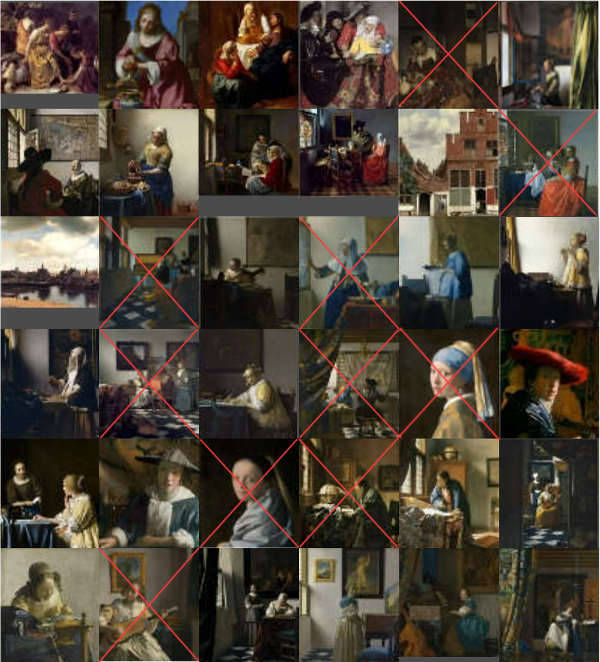
PRESS REVIEW
- Feb. 6, 2023 - THE ART NEWSPAPER - "Vermeer: five must-read books (and a website) on the Dutch Old Master" - José da Silva
- Feb. 7, 2023 - The Washington Post - " There will never be another Vermeer show as great as this one" - Philip Kennicott
- Feb. 7, 2023 - The Guardian - "Much of a Dutchness: the world’s biggest ever Vermeer show is an unmissable feast" - Adrian Searle
- Feb. 7, 2023 - THE ART NEWSPAPER - "Revealed: Vermeer's patron was, in fact, a woman—and she bought half the artist’s entire oeuvre" - Martin Bailey
- Feb. 7, 2023 - VRT MAX - "Never before seen so many paintings by Johannes Vermeer in Amsterdam: 'Almost a meditation to stand in front of such a work'" - Kristien Bonneure
- Feb. 7, 2023 - de Volkskrant - "Geen werk zo aantrekkelijk om van dichtbij te bekijken als het kleinschalige oeuvre van Vermeer ★★★★☆" - Rutger Pontzen
- Feb. 7, 2023 - The Telegraph - "Vermeer: a painter of exquisite artificiality and creepy men 5/5" - Alastair Sooke
- Feb. 7, 2023 - Evening Standard - "Vermeer at the Rijksmuseum, Amsterdam - a once in a generation show, don’t miss it" - Nancy Durrant
- Feb. 8, 2023 - AD - "Hoe Vermeers in Rijksmuseum kwamen: ‘We dachten: zo’n Vermeer-tentoonstelling lukt nóóit’"- Eefje Oomen
- Feb. 8, 2023 - FINANCIAL TIMES - "The Rijksmuseum’s Vermeer retrospective is momentous and dizzying" - Jackie Wullschläger
- Feb. 8, 2023 - HET PAROOL - "Recensie Vermeer tentoonstelling in Rijksmuseum: hopelijk gaat de expositie niet ten onder aan eigen succes" - Kees Keijer
- Feb. 8, 2023 - Bloomberg - "Why Are So Many Once-in-a-Lifetime Art Exhibitions Happening in Our Lifetime?" - James Tarmy
- Feb. 8, 2023 - maxwell museums - "Vermeer exhibition, Amsterdam: What the critics say"
- Feb. 9, 2023 - THE SUNDAY TIMES - "Inside the Vermeer exhibition — and the town where he grew up" - Sean Newsom
- Feb. 9, 2023 - The New York Times - "The Absolute Vermeer, in a Show More Precious Than Pearls" - Jason Farago
- Feb. 9, 2023 - Forbes - "A Blockbuster Vermeer Exhibition Worth A Trip To Amsterdam" - Cecilia Rodriguez
- Feb. 9, 2023 - FRIEZE - "How Did Johannes Vermeer Construct His Famous Interiors?" - Lua Vollaard
- Feb. 9, 2023 - Kommersant - "Синдром Вермеера" - Kira Dolinina
- Feb. 9, 2023 - Deutschlandfunk Kultur - "Wer Vermeer sehen will, muss nach Amsterdam"
- Feb. 10, 2023 - CONNAISSANCE DES ARTS - "Exposition Vermeer à Amsterdam : une fantastique immersion dans l’art mystérieux du peintre" - Céline Lefranc
- Feb. 10, 2023 - ARTnews - "The Largest Exhibition of Johannes Vermeer’s Paintings Opens at Amsterdam’s Rijksmuseum" - Francesca Aton
- Feb. 10, 2023 - ARTE.it - "Una riunione senza precedenti: inaugurata ad Amsterdam la grande mostra su Vermeer"- Francesca Grego
- Feb. 10, 2023 - Avvenire - "Cattolico e ritrovato, ad Amsterdam in mostra tutto Vermeer" - Maurizio Cecchetti
- Feb. 10, 2023 - Artmajeur - "Rijksmuseum otwiera dziś największą kolekcję obrazów Vermeera, jaką kiedykolwiek wystawiono" - Selena Mattei
- Feb. 11, 2023 - DW - "Выставка года: крупнейшее собрание шедевров Вермеера" - Stefan Dege | Pavel Mylnikov
- Feb. 12, 2023 - The Guardian - "Vermeer review – one of the most thrilling exhibitions ever conceived" - Laura Cumming
- Feb. 12, 2023 - ZEIT ONLINE - "Gigant des Jetzt" - Hanno Rauterberg
- Feb. 12, 2023 - la Repubblica - "Vermeer, il mondo in fila davanti al mistero" - Dario Pappalardo
- Feb. 12, 2023 - MY MODERN MET - "Largest Ever Exhibition of Vermeer Paintings Is Now on View in Amsterdam" - Margherita Cole
- Feb. 13, 2023 - SRF - "Freie Sicht auf Vermeer: Diese Werkschau ist eine Wucht " - Elsbeth Gugger Montag
- Feb. 13, 2023 - IL SOLE 24 ORE - "Vermeer: ad Amsterdam una mostra che fa 'storia'" - Stefano Biolchini
- Feb. 13, 2023 - LA STAMPA - "Vermeer: l’orecchino della celebre 'Ragazza' non è una perla" - Emanuela Minucci
- Feb. 13, 2023 - El Confidencial - "Nunca has visto (ni volverás a ver) tantos cuadros de Vermeer juntos" - Irene Hdez. Velasco
- Feb. 14, 2023 - The Guardian - "A world of wonders and catastrophes: discovering Vermeer and his hometown" - Kevin Rushby
- Feb. 14, 2023 - EL PAÍS - "La exposición de Vermeer cuelga el cartel de 'no hay entradas' cuatro días después de su inauguración" - Isabel Ferrer
- Feb. 14, 2023 - Il POST - "Ad Amsterdam c’è una mostra su Vermeer di cui si parla benissimo"
- Feb. 14, 2023 - Artlyst - "Vermeer: Stillness and Light Rijksmuseum Amsterdam" – Sue Hubbard
- Feb. 15, 2023 - Oranda.jp - "オランダ2023年フェルメール展感想とレポート - オランダjp編集部"
- Feb. 17, 2023 - THE ART NEWSPAPER - "The Big Review: Vermeer at the Rijksmuseum ★★★★★" - Tracy Chevalier
- Feb. 18, 2023 - DAGENS NYHETER - "Vermeers underbara måleri och okända liv synas på djupet" - Birgitta Rubin
- Feb. 20, 2023 - BBC - "Five hidden symbols in Vermeer's paintings" - Matthew Wilson
- Feb. 20, 2023 - New Yorker - "The Ultimate Vermeer Collection" - Rebecca Mead
- Feb. 20, 2023 - LiFO - "Επίσκεψη στη μεγαλύτερη έκθεση του Βερμέερ που έγινε ποτέ" - Αργυρώ Μποζώνη
- Feb. 20, 2023 - BBC - "A major new Vermeer exhibition at the Rijksmuseum in Amsterdam displays the artist's evocative and serene paintings of daily life – but they harbour secret, symbolic messages, writes" - Matthew Wilson
- Feb. 21, 2023 - SCREENDAILY - "Deckert picks up ‘Close To Vermeer’ documentary, seals US deal" - Geoffrey Macnab
- Feb. 21, 2023 - la Repubblica - "'La ragazza' di Vermeer lascerà la mostra di Amsterdam" - Dario Pappalardo
- Feb. 23, 2023 - The New York Times - "How Hard Is It to Paint Like Vermeer? TV Contestants Find Out." - Nina Siegal
- Feb. 24, 2023 - This is Media -2022 - "年2月10日より、フェルメールの現存する作品37点のうち28点を展示する、過去最大規模の展覧会が、アムステルダム国立美術館(オランダ)で開幕"
- Feb. 25, 2023 - THE WALL STREET JOURNAL - "‘Vermeer’ Review: Small Focus, Wide Reach" - Mary Tompkins Lewis
- Feb. 27, 2023- artnet news - "The Dutch Are Going Wild for a Reality TV Show Where Artists Compete to Paint Vermeer’s Lost Masterpieces" - Sarah Cascone
- Mar. 2, 2023 - THE ART NEWSPAPER -"The hunt for as many as nine elusive Vermeer paintings continues" - Martin Bailey
-
Mar. 10, 2023 - News World Nation - "The Rijksmuseum is offering new tickets for the Vermeer exhibition but the available dates are running out" - World Nation News Desk
- Mar. 16, 2023 - ARTnews - "Curator Behind 1995 Vermeer Retrospective Talks About What Goes Into Mounting a Blockbuster Exhibition" - Karen K. Ho
- Mar. 17, 2023 - Boston Globe - "Thirty-three years after the Gardner heist, where are the paintings?" - Shelley Murphy
SELECTED CITATIONS
Boston Globe - "Thirty-three years after the Gardner heist, where are the paintings?"- Shelley Murphy - Mar. 17, 2023
Maybe the most conspicuous absence is a Vermeer from Boston. Missing not because it’s in bad shape, but because it was stolen more than three decades ago, without a trace of it since.
"The Concert" is a 1664 painting that depicts a man and two women playing music, and was one of 13 artworks stolen from the Isabella Stewart Gardner Museum on March 18, 1990, in what remains the world’s largest art heist.
On the 33rd anniversary of the theft, empty frames remain on the walls of the Gardner. None of the works have been recovered, despite a $10 million reward, nor has anyone been charged.
"Sooner or later, anybody who saw the real picture is going to be dead," said Jonathan Janson, an American artist living in Rome and author of EssentialVermeer.com, a scholarly website devoted to the beloved painter. Janson was one of the estimated 450,000 people who scored a ticket to the Vermeer exhibition, and he also saw "The Concert" when it was still hanging at the Gardner.
Anthony Amore, the Gardner museum security director, who has worked with the FBI on the investigation for the past 17 years, said the search continues.
US Attorney Rachael Rollins expects to soon announce new efforts to increase awareness and generate tips that could lead to the their recovery.
"One of my first steps as US Attorney was to make sure the Gardner Museum heist was treated as an active federal investigation rather than a documentary film series or classroom discussion," Rollins said in a statement.
Kristen Setera, a spokeswoman for the FBI’s Boston office, said the agency continues to pursue leads and urged anyone with information to come forward.
Over the years, the theft investigation has featured countless theories, a string of discredited conmen, and a dizzying array of suspects, including local petty criminals with Mafia ties, Irish gangsters, and a Hollywood screenwriter.
Amore, the Gardner security chief, believes the artwork is most likely hidden locally and has a message for the person who has them: "We are the only buyers for the paintings. If you have information that you believe will lead us to the paintings, not theories, but information, please be in touch. We can bring this to a happy resolution."
LiFO - Επίσκεψη στη μεγαλύτερη έκθεση του Βερμέερ που έγινε ποτέ (Visit the largest Vermeer exhibition ever) - Αργυρώ Μποζώνη - Feb, 2023
I arrived at the museum on the first day of the exhibition, Friday February 10. The banner and all promotional material is a detail of the painting "Lady and Maid" owned by Frick. Showing a bit of her youthful neck, a patch of fur on her yellow coat, her pearl necklace and a large pearl drop earring, she seems to be asking the visitor to pay attention to the crucial details that recur almost throughout the work. of Vermeer of this period, when he painted many of his greatest paintings.
The details are also highlighted in works such as "Girl in the Red Hat"—cover of the English catalog – with her half-open mouth looking as if it had just been smeared with lip gloss—it was with these glossy lips that Vermeer painted the women inside of the houses, giving their expression a hint of anticipation. There is also a slightly more trivial, technical reason why the details are displayed. The reproduction rights of the works belong to the museums that own them, so you will only find items related to the four Vermeer works owned by the Rijks in the museum shop.
With the system of reservations every 15 minutes, the queues are never too long and no one waits in the cold for two or three hours.
We are directed to follow a triple line on the floor, an homage to Vermeer's ultramarine, to arrive through a serpentine path into the exhibition halls – always wearing our blue paper wristbands.
Next to me there are people of all kinds who have come from everywhere, not very young, although there are also mothers with prams and bottles and unsuspecting babies making their maiden entry into the "sufferings of art." No schools are allowed in the exhibition yet, to ensure a relative calm, and of course photography, videography is allowed, there is no hand without a mobile phone or a camera, everyone except zero is taking pictures incessantly, they are allowed to approach the works at a very short distance – but she does not is it also the value of Vermeer, to get as close as possible, to see the touch on the pearl, the running milk and the lace fingers?
He painted pearl earrings and necklaces in eighteen of his thirty-seven works. They are not only decorative elements, they symbolized purity, beauty, and love and were synonymous with wealth.
The color that dominates and impresses with its vibrancy even if it has faded in some paintings is the ultramarine which, while other painters used sparingly, Vermeer loved it. He lavishly used the most beautiful of all blue pigments, which cost more than gold. Ultramarine, meaning "beyond the sea," was so named because most lapis lazuli came from Afghanistan, and its production required a complex process. You will see ultramarine in almost all of his paintings, on clothes but also on tablecloths, cushions, and curtains – it draws the eye like a magnet, it always impresses.
That same evening I received an email, like every visitor, with a long questionnaire: how I see the museum, if it bothered me that it was crowded, if I was unhappy that there was no audio tour, if I find the ticket expensive. I was asked to describe the experience almost in detail, identify shortcomings, rate various fields and comments made in order to improve the experience of the next visitors. I was also asked if I had come to Amsterdam to see this exhibition, if I was staying in a hotel, how many other museums I would see and how much I would spend in the city during my stay.
The New York Times - "The Absolute Vermeer, in a Show More Precious Than Pearls" - Jason Farago - Feb. 2023
On the highways and in the lowlands of European painting, there may be no more perplexing case of reputational caprice than Johannes Vermeer (1632–75). He was well established in Delft during his life; his art sold; and yet for two centuries after his death, his small and silent pictures of women reading letters or pouring milk elicited no attention at all. When Girl With a Pearl Earring came up at auction in 1881, it hammered at just two guilders. Now Vermeer stops traffic; he diverts planes. And you wonder: that luminousness, that inner calm, how could this not stop everyone’s heart like it stops mine?
It is just called "Vermeer," and from the title on, this exhibition is dazzlingly confident and impetuously spare.
Really, the show is just about perfect: perfectly argued, perfectly paced, as clear and uncontaminated as the light streaming through those Delft windows. And in its proudly spare galleries I felt a little closer to understanding the intense grip of these diamond depictions on contemporary audiences, stronger still in the time of gigapixel reproduction. Why him, out of all the quiet masters of the eruptive 17th-century Dutch art market? Or better: why us? What happened to us, after Vermeer’s long oblivion, to leave us so susceptible to his hushed views of writers and maids?
One factor is scarcity. Vermeer produced little and died young.
Here at the Rijks those 28 small-to-smallish paintings luxuriate across 10 galleries. Each picture is ringed by a simple semicircular balustrade, which permits close inspection and also distributes the crowds. (The show’s designer is the French architect Jean-Michel Wilmotte, who’s also hung heavy velvet curtains to muffle the sound; the curators are the Rijks’ Pieter Roelofs and Gregor J.M. Weber.) Beyond that, and a few minimal texts, nothing. No comparative works, no distracting videos.
The Frick Collection, currently subletting while its Fifth Avenue mansion is under renovation, has allowed all three of its Vermeers to leave New York for the first time in a century. In the Frick’s Mistress and Maid, an uncommonly grand Vermeer, the lady of the house edits a love letter while wearing a yellow morning jacket trimmed with white fur. At last it can be seen with the Met’s Young Woman With a Lute, Washington’s Lady Writing, Berlin’s Woman With a Pearl Necklace, and the Rijksmuseum’s own Love Letter, whose female models all wear that same yellow-and-white coat.
That false innocence bewitched more and more in the alienated 20th century, which turned to Vermeer for transparency, order, harmony. (The paintings’ secular subjects made this easier, whatever his Catholic stimuli.) But beauty and calm just aren’t enough to explain the intensity of Vermeeromania today, and I think his appeal now lies somewhere else. It lies, much more, in the paintings’ capacity for deceleration, and how the difference between their tactile reality and obvious construction can only be seen with time.
Vermeer has become one of our last defibrillators of absorption and awareness. He matters now precisely for his vindication that we have not wholly decayed into data receptors; that we are still human, and if only we find the right master we can slow down time. What is a masterpiece, in 2023? A thing that returns to you—vitally, commandingly, after this clamorous world of news and notifications seemed to have wiped them out—your powers of concentration.
la Repubblica - "Vermeer, il mondo in fila davanti al mistero" (Vermeer, the world lined up in front of the mystery) - Dario Pappalardo - Feb. 2023
In recent weeks, anonymous trucks have delivered without attracting too much attention—bypassing the channels and prying eyes—some of the best kept mysteries in the history of art. The items arrived by air from Washington, New York and Tokyo or by land from Paris, The Hague, Dresden, Berlin, from seven countries and fourteen different locations. All or almost all the Vermeers in the world have landed here, in one place, for the first time: it is an event that has no precedents and is unlikely to repeat itself. Seeing them together finally means trying in vain to reveal the secrets of the rarest painter ever.
Understanding the hidden meanings behind those women who sew, taste wine, play lutes, simply stand at the window, intent on looking outside or reading letters that have come from who knows where.
Johannes of Delft (1632-1675) lived 43 years, leaving us on Earth only 37 paintings: one, The Concert, the most wanted by the FBI, is part of the group of masterpieces that disappeared from the Isabella Stewart Gardner Museum in Boston in the sensational theft of March 18, 1990, which also inspired a Netflix documentary. If it is too early to know how many visitors there will be at closing, the insurance value sets a first record: three billion Euros for less than thirty paintings.
"Vermeer was influenced by the Jesuits—explains Gregor J.M. Weber, curator of the exhibition and author of the essay Johannes Vermeer. Faith, Light and Reflection. It is an element so far underestimated but increasingly evident. In Delft the Jesuits were practically his neighbors.
He certainly owned a book by Peter Canisius and two of his children had been baptized in the Catholic faith with the names of the founders: Francesco (Saverio) and Ignazio. But, above all, for the Society of Jesus, studies on optics were an integral part of religious education: God is light and the mirror reflects the universe. The Jesuits used the camera obscura as well as the painter had to, in order to study the objects to be reproduced on canvas.
This is proved by the fact that, in his works, some details are out of focus compared to others."
In view of the record exhibition, Vermeer's painting was literally x-rayed...Vermeer still remains the Sphinx of Delft, as the French journalist Théophile Thoré defined it in 1866 in the Gazette des Beaux-Arts.
The more we question him, the more he escapes us. Girl with a Pearl Earring keeps challenging us. Vermeer, you won again this time.
The Guardian - "Much of a Dutchness: the world’s biggest ever Vermeer show is an unmissable feast" - Adrian Searle - Feb. 2023
Opening the magnificent Johannes Vermeer exhibition at Amsterdam’s Rijksmuseum, two paintings of these morning scenes plunge us right in, taking us on a journey through Vermeer’s art, spread across 10 rooms. We shuttle from city views to private interiors, between the sacred and the profane; from domestic life, with quiet music and private moments, to religious devotion and bawdy scenes. All this in an exhibition of only 28 paintings.
All the details in his art may be acutely observed—from the clouds passing over Delft to the finial on a Spanish chair, the burr on an Anatolian carpet and the glint on an earring—but they are more than inventories of the visible. Although a devout observer of the surface of things, which he became within a few short years, Vermeer was not a realist. His paintings are careful, complex constructions.
And Vermeer certainly never sat in a camera obscura, copying the inverted image projected on the darkened wall. He was no copyist, although, influenced by the Jesuit scientific and quasi-religious interest in optics, he understood and was interested in the way light illuminated objects in a camera obscura—and used its effects, just as he used single-point perspective to measure and construct the architecture of his painted spaces. Artists are always interested in whatever technology they have to hand. Vermeer wanted to see more, by whatever means.
Mystery and enigma are attractive. Who is that woman in the red hat, or the one with the pearl earring? What’s in that letter? What is that girl looking at through the window? What is she thinking? Who is approaching? This exhibition, at last, gives us not just Vermeer’s painted spaces, but space to be with them and to occupy their unfolding strangeness. Unmissable.
THE ART NEWSPAPER - "Revealed: Vermeer's patron was, in fact, a woman—and she bought half the artist’s entire oeuvre" - Martin Bailey - Feb. 2023
Vermeer’s main patron was probably a woman, according to curators of the retrospective which is opening at the Rijksmuseum in Amsterdam this week. She was Maria de Knuijt, the wife of Pieter van Ruijven. For decades it has been assumed that Van Ruijven, a wealthy Delft citizen, was the patron. New research reveals that De Knuijt had much closer and longer links to Vermeer than her husband.
The identity of Vermeer’s patron is of vital importance, since they purchased half of the artist’s entire oeuvre, at least 20 paintings.
The Rijksmuseum exhibition Vermeer…includes no fewer than 14 paintings once owned by De Knuijt.
The exhibition co-curator Pieter Roelof... points out in the exhibition catalogue that in 17th-century Dutch society "as lady of the house she [De Knuijt] will have taken the lead in furnishing their home and purchasing paintings."
Pictures were then considered "household goods and thus part of domestic consumption." He concludes that "everything points to De Knuijt being the collector of the [Vermeer] paintings."
THE WALL STREET JOURNAL - "'Vermeer' Review: Small Focus, Wide Reach" - Mary Tompkins Lewis - Feb. 2023
Organized by the museum’s curators Gregor J.M. Weber and Pieter Roelofs and designed by the architect Jean-Michel Wilmotte, it is a staggeringly beautiful, brilliantly realized show unlikely to be repeated.
A room of large, ambitious figure paintings from the mid-1650s indicates the artist’s early plans to become a history painter, a path he soon abandoned. Like his father, Vermeer was also an art dealer, and he must have recognized the demand in Delft—where most of his paintings remained—for smaller genre scenes that would appeal to private collectors and fit in their homes. As the show underscores at every turn, such works would play to his unique strengths.
Vermeer’s evocative depictions of women reading or writing letters allowed the artist to conjure up his subjects’ innermost thoughts in their genteel, private domains, and such paintings punctuate the show.
Vermeer’s interest in science, an inescapable thread through his art, is newly considered in the show’s later galleries. "The Geographer" (1669), for example, offers (as does the Louvre’s "The Astronomer," on loan elsewhere) a rare male protagonist who may personify Delft’s vibrant scientific milieu. The pensive, blue-robed scholar, surrounded by maps, a globe and scientific instruments, is a striking image of active, intellectual engagement. The curators propose that his ruminative gaze and the familiar light-flooded windows may be signs of both cerebral and spiritual enlightenment.
..this historic exhibition an absolute must-see.
AD - "Hoe Vermeers in Rijksmuseum kwamen: ‘We dachten: zo’n Vermeer-tentoonstelling lukt nóóit’" (How Vermeers came to the Rijksmuseum: "We thought: such a Vermeer exhibition will never succeed") - Eefje Oomen - Feb. 2023
How does it feel to temporarily have such an entire collection of those unique, very expensive, spectacular paintings by that one world-famous Dutch master under your care?
That, says Pieter Roelofs (Head of Painting and Sculpture at the Rijksmuseum), is somewhat like a school trip to Efteling. "And that as an accompanying parent you not only take care of your own child, but also of the other children. May they return home safe and sound. Well, that's kind of the case with all those loans for this exhibition.''
How does such a loan work?
It is not the case that museums pay each other or have to 'rent' pieces. It is about working together, exchanging works with each other and - above all - giving things to each other and the public. For example, in 2012 we had The Woman Reading a Letter, one of 'our' four Vermeers, travel to China, Japan, and Brazil, among others. And for this exhibition we have offered to conduct extensive research into two works from the Frick Collection: we have the expertise and equipment in-house."
What makes the organization of such an exhibition especially expensive: the insurance premium.
"We can only organize such exhibitions with the support of many institutions, funds, and individuals. The government also helps us. It guarantees part of the insurance premium.''
And how much is that premium? And what is the total value of the entire Vermeer collection? Roelofs will never say anything about that. "We prefer to talk about the cultural-historical value. Any estimate is just an estimate, because Vermeer has a very small oeuvre and, moreover, a Vermeer never comes on the market.
Another mysterious thing: the transport. "You should compare it to the journey of a world-famous pop star. The pop star suddenly turns up and so it is with a Vermeer." What he does want to say: that the Rijksmuseum is doing everything possible for a safe trip. "These paintings were transported, for example, in the 'Turtle', a box developed in the Netherlands with built-in technology that ensures that vibrations are minimal."
THE ART NEWSPAPER - The Big Review: Vermeer at the Rijksmuseum ★★★★★" - Tracy Chevalier - Feb. 2023
Less is more. While the phrase was coined in the 20th century by the Modernist architect Mies van der Rohe, it could easily have been pronounced by Johannes Vermeer back in the 17th century. Not only did the Dutch artist focus primarily on one simple corner of a room, he also probably painted only 45 to 50 works over his lifetime.
Luckily for us, the curators Gregor J.M. Weber and Pieter Roelofs have kept their nerve and trusted in ‘less is more’. Instead of cutting back the number of galleries or cluttering the available space with other contemporaries’ works or information about the world beyond Vermeer’s studio, they have hung each painting with a generous amount of room around it, making a virtue out of what could have been a problem. Several paintings have their own walls; some even have their own galleries. The effect of so much space is to slow visitors down so that we give each painting more time. With less to look at, we contemplate what is there with more attention, and start to see more.
The curators have trusted the Vermeers to speak for themselves, and us to formulate our own opinions.
Marrying what you say with how you say it results in an experience richer than the sum of its parts; this is what every creator—be it painter, writer or curator—is aiming for, and few achieve. I have never seen a show that has managed this so successfully. The exhibition itself has become a work of art. Exhibition organisers will be learning from this show for years to come.
de Volkskrant - "Geen werk zo aantrekkelijk om van dichtbij te bekijken als het kleinschalige oeuvre van Vermeer ★★★★☆" (No work is as attractive to view up close as Vermeer's small-scale oeuvre ★★★★☆) Rutger Pontzen - Feb. 2023
Johannes Vermeer... Small canvases, big impact. There is more monumentality on the square centimeter than many other painters can achieve on meters long pieces of linen. The dull glint in a pearl, the swirling pouring of milk, the moist lips of the girl with the pearl, the golden roof in the View of Delft that kept Marcel Proust awake for nights—no work is so attractive to look at closely as the small-scale oeuvre of the Delft master.
The only question is: how do you present that?
Solution in the Rijks: show the works at an appropriate distance from each other, each painting separately behind a Mona Lisa balustrade, hung against separate panels, interspersed with meter-high velvet curtains in the colors that resonate with Vermeer's work: dark blue, deep green and aubergine red. A design that seems to be largely inspired by crowd control.
The disadvantage of such a spacious arrangement is a large degree of uniformity.
In addition to the thick, informative catalogue, the Rijksmuseum has launched an 'online journey of discovery' through the life and work of Johannes Vermeer on its website. The thirteen-part video production, narrated in Dutch and English by Joy Delima and Stephen Fry respectively, highlights Vermeer's paintings according to their themes. About the importance of harmony, heaven, and earth, stillness, letters, and the charming visit of various men in his work. All in all, the forty-minute narrative is full of broader insights and tasty details.
It remains a mystery how Vermeer, this monomaniac interior painter who has never left his hometown of Delft for more a short period of time and who preferred to lock his protagonists in dim rooms behind thick curtains, has acquired such an international reputation.
New Yorker -"The Ultimate Vermeer Collection" - Rebecca Meda - Feb. 2023
In the spring of 1914, James Simon, an art collector in Berlin, was approached by a London-based dealer with a proposition: Would he accept two hundred and fifty thousand dollars for a work in his collection, Johannes Vermeer’s Mistress and Maid? The would-be buyer was Henry Clay Frick, the American industrialist, who in the late nineteenth century had embarked on an acquisition binge of Old Masters, and who already owned two works by the seventeenth-century painter from Delft. Simon’s answer was definitive: although he had received equally lavish offers from other buyers—Frick was far from alone in his desire to gild his Gilded Age fortune with Golden Age masterpieces—he would not part with the painting. Five years and a crippling Great War later, however, Simon found himself in a weaker bargaining position, and for nearly three hundred thousand dollars—the equivalent of roughly five million dollars today—"Mistress and Maid" was shipped across the Atlantic to Frick’s mansion, on Fifth Avenue, where its new owner enjoyed only a short while in its company before his death, in late 1919. The painting—which depicts a lady seated at a table with a writing set, interrupted by a maid holding a letter—has remained at the mansion more or less undisturbed ever since. Frick turned his home into a museum bearing his name, and it has long been its policy not to lend his acquisitions to other institutions.
In 2021, when the Frick started renovations at the mansion and moved its collection off-site, a chink of light in the institution’s tightly shuttered terms was spotted: during this interregnum, the works could finally travel. Mistress and Maid—along with the Frick’s two other Vermeers, Officer and Laughing Girl and Girl Interrupted at Her Music—has now recrossed the Atlantic, returning to the Netherlands for a landmark show at the Rijksmuseum, in Amsterdam.
There are no drawings by him, or any definitive likenesses of him, though the three-quarter profile of a figure in an early work, The Procuress, suggests that it may be a self-portrait. It’s not the kind of sublimely refined figure one might imagine Vermeer to have been, however; this man is a sly, grinning onlooker to a lewd brothel scene...
EL PAÍS - "La luz de Vermeer inunda Ámsterdam en la exposición de la temporada en Europa" (Vermeer's light floods Amsterdam in the exhibition of the season in Europe) - Isabel Ferrer - Feb. 2023
The paintings View of Delft and The Little Street, the only two exterior oil paintings by the Dutch painter Johannes Vermeer (1632-1675), welcome visitors to the largest retrospective organized to date by the Rijksmuseum in Amsterdam, the national museum of art and Netherlands history. The canvases are the gateway to the private universe full of symbols of an artist recognized in his time, almost forgotten afterwards, and rescued for glory in the 19th century by the French art critic Théophile Thoré-Bürger.
Entitled simply Vermeer, the exhibition is the first dedicated exclusively to the painter since the one organized —between 1995 and 1996— by the National Gallery of Art, in Washington, and the Dutch gallery Mauritshuis, in The Hague. It is also a true balancing act between the blockbuster... and the artistic experience.
..."even though he left no self-portraits behind," says Pieter Roelofs, "but in a way, Vermeer's face is in every one of his paintings. In the use of color and light. In the perspective and his knowledge of optics. In the spaces that open and close, because he plays with the limits of what is ours and what is his"...
With a production of less than fifty, an average of about two pieces a year, the aura of mystery that surrounds Vermeer derives in part from the lack of personal documents. There are no handwritten letters, as in the case of Van Gogh, who was a prolific writer. Rembrandt, for his part, was very famous and has a catalog of 340 works considered his. It is known that Johannes Vermeer was in contact with art as a child, because his father ran an inn in Delft and was a picture dealer. That he learned his trade from a master, otherwise he could not have been a member of the Guild of Saint Luke in Delft. From a Protestant family, he married a young Catholic, Catalina Bolnes, and they had 15 children. His mother-in-law, Maria Thins, was wealthy and initially opposed the couple. As Gregor Weber, chief curator of Fine Arts at the Rijksmuseum, has discovered, the Jesuits showed the artist the use of the camera obscura, an optical instrument forerunner of photography. He believes that it inspired him, but he did not use it in his works, the outline of the clothing shines and the bronze illuminates.
Supported by a Delft collector who bought him some twenty paintings, the artist's life came to a halt in 1672 because of the Franco-Dutch war. He couldn't sell paintings or support his family, and he fell ill and passed away within a couple of days.
la Repubblica - "La ragazza" di Vermeer lascerà la mostra di Amsterdam" (Vermeer's "The Girl" will leave the Amsterdam exhibition) - Dario Pappalardo - Feb. 2023
The exhibition of the year, if not of the century, will soon have to do without its star. At the end of March, Vermeer's Girl with a Pearl Earring will leave the Rijksmuseum in Amsterdam to return home, about sixty kilometers south: to the Mauritshuis in The Hague. From April 1st - and it's no joke - it will be exhibited in its usual location. Paradoxically, Holland, which managed to gather 28 Vermeers from all over the world for the biggest event ever dedicated to the seventeenth-century master, lost an internal battle. Friendly fire and economic reason prevailed.
...after just 8 weeks...the Mona Lisa of Flanders…will be repacked and replaced by a blue tent.
In The Hague, more than theft, they fear the drop in tourists from the Easter period onwards and the collapse of takings. The Girl is the main attraction of the Dutch city.
THE ART NEWSPAPER -The hunt for as many as nine elusive Vermeer paintings continues - Martin Bailey - Mar. 2023
With only 37 authenticated Johannes Vermeer paintings…could there be more out there, not yet recognised as from his hand? Vermeer’s production was certainly larger, so the hunt continues for the missing masterpieces. Experts believe that a number are still unaccounted for.
Around nine Vermeers that have disappeared are listed in old records, including a self-portrait—which would represent the greatest discovery.
The key question is whether the 37 surviving works and the nine or so in early records represent all (or nearly all) of Vermeer’s oeuvre—or if they are just the tip of the iceberg.
El Confidencial - "Nunca has visto (ni volverás a ver) tantos cuadros de Vermeer juntos" (You have never seen [nor will you ever see] so many Vermeer paintings together) - Irene Hdez. Velasco - Feb. 2023
It is a fantastic, fascinating, absorbing, overwhelming exhibition...
Vermeer, today an undisputed superstar of art, was completely forgotten for almost 200 years. Only from the end of the 19th century did he begin to emerge from obscurity, when the French critic Théophile Thoré-Bürger discovered him, fell in love with his works and in 1866 published a catalog on Vermeer.
A good part of his works are scenes of domestic life starring women: women who read, who play an instrument, who make lace, who look through a window, who write…. Women focused on their own thoughts, introspective and contemplative women, women who are self-sufficient, women who enjoy the pleasure of solitude and their inner world. They are the first modern women of art, a kind of secularized madonna.
Vermeer continued in his father's footsteps as an art dealer, in addition to painting his own paintings, for which it is believed that he used his older daughters as models. his wife and his maid.
de Volkskrant - Geen werk zo aantrekkelijk om van dichtbij te bekijken als het kleinschalige oeuvre van Vermeer ★★★★☆ Rutger Pontzen - Feb. 2023
Johannes Vermeer... Small canvases, big impact. There is more monumentality on a square centimeter than many other painters can achieve on a meters’ long pieces of linen. The dull glint in a pearl, the swirling pouring of milk, the moist lips of the girl with the pearl, the golden roof in the View of Delft that kept Marcel Proust awake for nights - no work is so attractive to look at closely as the small-scale oeuvre of the Delft master.
The only question is: how do you present that?
Solution in the Rijks: show the work at an appropriate distance from ea ch other, each painting separately behind a Mona Lisa balustrade, hung against separate panels, interspersed with meters-high velvet curtains in colors that resonate with Vermeer's work: dark blue, deep green and aubergine red. A design that seems to be largely inspired by crowd control.
The disadvantage of such a spacious arrangement: a large degree of uniformity occurs.
In addition to the thick, informative and catalogue, the Rijksmuseum is launching an 'online journey of discovery' through the life and work of Johannes Vermeer on its website. It is a thirteen-part video production, narrated in
Dutch and English by Joy Delima and Stephen Fry, that highlights the themes of Vermeer's paintings. About the importance of harmony, heaven, and earth, stillness, letters, and the charming visit of various men in his work. All in all,about forty minutes of explanation - can also be used as a menu - full of tasty details and broader insights.
Because it remains a mystery how Vermeer, this monomaniac interior painter who has never left his hometown of Delft in a short period of time and who preferred to lock his protagonists in dim rooms behind thick curtains, has acquired such an international reputation.
DAGENS NYHETER - "Vermeers underbara måleri och okända liv synas på djupet" (Vermeer's wonderful painting and unknown life are seen in depth) - Birgitta Rubin - Feb. 2023
For the Rijksmuseum, it has been a challenge to present such a limited number of paintings, most of them surprisingly small, in its spacious halls. The exhibition architect has solved it elegantly with velvet drapes and a color scheme congenial with Vermeer's art, in shades such as plum purple, burgundy, deep green and sky blue. The museum has really succeeded in creating concentration, calm, and air around each painting.
The only downside is that guards and railings prevent the audience from going near the canvases. This is of course for safety reasons, but it makes it frustratingly difficult to closely study all the delicate, finely-brushed details.
The exhibition is divided into eleven thematic sections, which demonstrate the phases of Vermeer's development broadly chronologically. It is fascinating to follow how he tries different genres and motifs, and learns to create spatial illusion. He works with distance and perspective, experiments with colors, light changes, views, and visibility in rooms, as well as people's gaze directions.
Extensive research has preceded the exhibition, of which in-depth analyzes using new scanning techniques are the most interesting. Vermeer's choice of pigments, brushwork, and invisible layers have been examined in eleven paintings and scores of corrections discovered. He has diligently both painted over and moved things, figures, and even buildings (in the View of Delft), in the search for aesthetic perfection.
THE SUNDAY TIMES - "Inside the Vermeer exhibition — and the town where he grew up" - Sean Newsom - Feb. 2023
Nothing quite prepares you for how diminutive Johannes Vermeer’s home turf was. The plaintive cries of the seagulls won’t do it, as you leave Delft’s railway station and wonder where all the cars have gone. Nor will the languid canals, lapping the town’s historic core. Even the villagey tinkle of its church bells won’t shrink your expectations sufficiently.
Why? Because by any measure the world inhabited by this leviathan of 17th-century painting was minute... here, in this prosperous little backwater, seven miles from the coast, you can stroll across the span of his entire domestic life in less than two minutes.
It’s thought that Vermeer may have left town as a teenager to serve an apprenticeship. He was back by the age of 21, and this is where he stayed, creating what has turned out to be the most timeless sequence of masterpieces from the Dutch Golden Age. The Milkmaid, Woman in Blue Reading a Letter, Girl with a Pearl Earring — they were all painted here.
Delft was, after all, the home of Antonie van Leeuwenhoek, a contemporary of Vermeer’s, and "the father of microbiology." He made at least 500 of his own optical lenses, and examined absolutely everything under his microscopes, from rainwater to bodily fluids.
Meanwhile, recent research has shown how the Jesuits in the mission next door to Johannes and Catharina’s house had enthusiastically embraced the power of the camera obscura.
The Telegraph - "Vermeer: a painter of exquisite artificiality and creepy men 5/5" - Alastair Sooke - Feb. 2023
Settle down. We are in the presence of Great Art. That is the message conveyed by the stately décor inside the new.
And the pictures? Like preachers in the pulpit, they appear behind semi-circular balustrades, each accompanied only by a title and date. Vermeer converted to Catholicism, but, here, there’s a Protestant directness to the relationship between viewer and art. A milkmaid preparing bread pudding; well-to-do women reading and writing letters, fiddling with jewellery, flirting, making music: the subjects of these paintings, from the third quarter of the 17th century, are so well known, it seems, they require no explanation.
Foolishly, I thought I knew Vermeer backwards, but seeing his paintings together confounds expectations. His reputation as a realist is a misconception: many passages in his pictures are almost abstract. And, although we still think of him as a painter of "everyday" scenes, his compositions aren’t 17th-century snapshots. Rather, they’re suffused with artificiality and a sense of playacting.
Evening Standard - "Vermeer at the Rijksmuseum, Amsterdam - a once in a generation show, don’t miss it" - Nancy Durrant - Feb. 2023
Vermeer has a reputation as a mystery; this turns out to be nonsense. We know when and where he was born and died; we know that he probably converted to Catholicism in order to marry his wife Catharina in 1653, and that, like his father, he worked as an art dealer.
We know he was elected twice as headman of the Guild of St Luke; that during the Dutch Republic’s ‘Disaster Year’ of 1672 he sold barely anything, driving him towards penury; and that in 1674 he served as a pikeman in the civic guard. We know that he died aged 43 in 1675, penniless, in huge debt and that 14 pall bearers carried his coffin while bells rang out. In the catalogue there’s even an entire chapter, deadly boring or utterly fascinating depending on your prediliction, detailing the goods that were in every room of his house after his death, when Catharina, left with 11 children to support, decided to file for bankruptcy.
What we don’t have is anyone gushing about what he was like – as Giorgio Vasari did with the Renaissance artists – so we have no real picture of him as a man, but who cares, because we do have most of his pictures. I admit to caring little for the larger-scale works here, painted soon after his marriage, when he was trying a bit hard to be a grand painter of grand subjects.
Artmajeur - "Rijksmuseum otwiera dziś największą kolekcję obrazów Vermeera, jaką kiedykolwiek wystawiono" (The Rijksmuseum opens today the largest collection of Vermeer paintings ever exhibited) - Selena Mattei - Feb. 2023
Girl with a Flute, a controversial panel painting, is part of the show. Last year, the National Gallery of Art in Washington, D.C., said the painting did not meet "Vermeer standards" and moved it to "Vermeer's studio." But the Rijksmuseum maintains its opinion that it is the work of a Dutch master, saying that it is "attributed to Johannes Vermeer" in the museum's catalogue. The head of the painting and sculpture department, Pieter Roelofs, said the two galleries had agreed to disagree for now, but further research during the exhibition could change everyone's mind. He said: "We weren't there when it was painted, and our Washington colleagues have done an amazing job researching and collaborating as conservators, curators, and scientists." "We're looking at the same picture, but each of us sees something different." They point out things they think are unusual, and we think we've seen some or most of the same things in other images. It's a great game.
FRIEZE - "How Did Johannes Vermeer Construct His Famous Interiors?" - Lua Vollaard - Feb. 2023
Weber... argues that light and optics are important themes in Jesuit devotional literature, pointing to a sermon that explores the camera obscura's artistic and moral significance, and identifying a drawing of Saint Apollonia dated c.1650 by a local Jesuit Priest Isaac van der Mye, produced using the camera obscura...
Weber goes as far as to speculate that Vermeer could have obtained a camera obscura in 1656, after van der Mye’s death. Its use is perhaps most perceptible in The Lacemaker, on loan from the Louvre. The camera obscura casts an image onto a glass plane, allowing the scene to be traced. The technique enables a focal point in the composition to be meticulously detailed, while the foreground and background are blurred, as in human vision. The lace worker’s eyes are trained on the threads, luminously detailed around the middle plane of the image, while a ball of vermillion red and pearly white threads cascade out of focus towards the front.Deutschlandfunk Kultur - "Wer Vermeer sehen will, muss nach Amsterdam" (If you want to see Vermeer, you have to go to Amsterdam) - Feb. 2023
Most art critics are enthusiastic about the exhibition in the Rijksmuseum. The reason for this is certainly the comparative completeness of Vermeer's work. Never before have so many pictures by the Dutch Baroque artist been shown in one show.
But there is also criticism: Vermeer is not embedded in his time. The 17th century was the heyday of the Dutch colonial empire. People who could afford works of art, such as those by Jan Vermeer, had become rich through the slave trade. Nothing can be learned about this in Amsterdam.
Artlyst - Vermeer: Stillness and Light Rijksmuseum Amsterdam - Sue Hubbard - Feb. 14, 2023
Unlike his contemporaries, Vermeer was not interested in movement but in stillness. Intense moments of revelation and quiet.
Vermeer was the master of light. Yet however close you get to a painting, it’s hard to see the brush marks to discern how he did it. Lawrence Gowing described him as "all eye and nothing else….a walking retina drilled like a machine."
ARTnews - "Curator Behind 1995 Vermeer Retrospective Talks About What Goes Into Mounting a Blockbuster Exhibition" - Karen K. Ho - Mar. 16, 2023
Co-organized with the Mauritshuis in The Hague, Wheelock’s "Johannes Vermeer" brought together 21 Vermeers, a record gathering only surpassed by the current Rijksmuseum exhibition. Several paintings, like the NGA’s Girl with a Flute (1664–67), had recently been cleaned ahead of the 1995 exhibition.
Wheelock retired from the NGA in 2018 after more than 40 years.
ARTnews spoke to Wheelock by phone…about his memories of the NGA exhibition.
Wheelock began working on his Vermeer exhibition about nine years before it opened. In addition to the scholarly research and painting conservation that went into mounting a show of this scale, securing loans was one of his biggest concerns in the run-up to the exhibition. Recalling the stress of how many Vermeers would actually be assembled when the show opened, Wheelock said, "When you contact somebody, and they don’t answer how long do you wait before you inquire again? How do you find the route in to make an opportunity to borrow a painting?"
Taking place before online ticket sales or social media, the NGA’s Vermeer exhibition exceeded expectations, proving that art lovers would line up—even in the winter months—to get a chance to see high-caliber shows by one of art history’s most important figures. According to the museum, more than 300,000 people saw the paintings.
"We knew it was going to be popular but we had no clue," Wheelock said, noting that the museum had done some modest publicity to advertise the show. In addition to advance tickets, the NGA made 2,500 tickets available each day on a first-come, first-serve basis. Lines stretched for hours on some days, and a handful of people even camped overnight.
Even though the National Gallery of Art is one of the largest museums by square footage in North America, capacity proved to be a major issue for the 1995 exhibition due to room occupancy limits. "The problem was back then is that people stayed much, much longer than normal in an exhibition," Wheelock said. "They just didn’t want to leave. It was that special to be among these Vermeers."
A key difference between the 1995 show and the current one is that after its debut at the NGA, it traveled to the Mauritshuis, meaning that Europeans didn’t have to travel across the Atlantic to see it.
Plus, the Rijksmuseum launched an extensive international publicity campaign to promote the new exhibition, "creating a demand beyond anything you can probably handle," Wheelock said...
The Rijksmuseum is now tasked with managing an extremely popular, sold-out show thousands of people are still desperate to get tickets for, with unverified listings on eBay selling tickets for several hundred euros.
"There’s already sense of anger that they can’t get tickets," Wheelock said. "That’s not something you want to see happen at all..."
The Rijksmuseum has made it very clear they’re not giving special access to anyone, including journalists and critics because, according to the museum, "due to the great interest, the maximum number of press accreditations has now been reached."
ONLINE VERMEER EXHIBIT

The Rijksmuseum has launched an excellent entry-level online tour of the Vermeer retrospective by Stephen Fry called CLOSER TO JOHANNES VERMEER which allows you to explore online the artist's life and all his paintings.
<https://www.rijksmuseum.nl/en/stories/themes/vermeer/story/closer-to-johannes-vermeer>
PARALLEL EXHIBITION
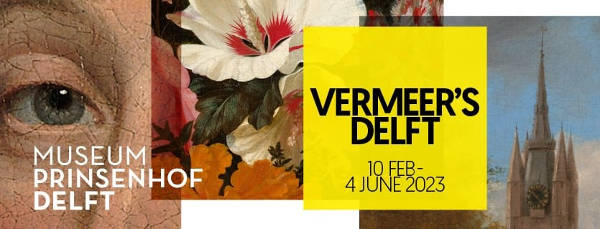
Parallel to the Vermeer exhibition in the Rijksmuseum, Museum Prinsenhof Delft will organize the exhibition Vermeer’s Delft (10 February–4 June, 2023). This will be the first ever exhibition to explore in depth the cultural-historical context in which Vermeer’s practice flourished. Works by Delft contemporaries are displayed alongside Delft pottery, Delft carpets, archival materials and letters.
Vermeer’s Delft
Museum Prinsenhof of Delft
February 10–June 4, 2023
The exhibition will be open throughout the Rijksmuseum Vermeer retrospective, from Monday-Sunday from 11:00-17:00.
<https://prinsenhof-delft.nl/ontdek-het-museum/nieuws/hoofdrol-voor-delft-in-ambitieuze-tentoonstelling-over-vermeer-in-museum-prinsenhof-delft>
FREQUENTLY ASKED QUESTIONS
- What does a ticket cost?
There are no longe any tickets avaible.
The Rijksmuseum has currently reached the maximum amount of Friendships. Therefore, it is temporarily not possible to purchase Friendship Membership, which allows free entrance to the museum and all the special exhibitions for one year without booking a timeslot. - How many works from his oeuvre (that we know) will there be?
Never before have so many works been collected. At the moment there re 28 paintings. The Girl with the Pearl Earring is on display in the exhibition until 30 March. - What are the opening hours?
The exhibition is open every day from 9 am to 6 pm. Thursday, Friday, and Saturday: 9–22h - How long can you stay?
As long as you want, the exhibition closes at 6 pm. - Does a ticket for the exhibition include a visit to the Rijksmuseum itself?
Yes. The entire museum is open until 5 pm, the exhibition until 6 pm. - Is photography allowed?
In the Rijksmuseum it is allowed to take pictures without a flash. - Can tours be booked?
No guided tours are offered. - Is there an audio tour?
No, no audio tour is provided. - Extras
There is free WiFi, a free cloakroom and a snack bar inside very near the entrance to the Vermeer exhibition.
GETTING TO THE RIJKSMUSEUM
The Amsterdam Airport Express Bus (Connexxion line 397) offers a convenient and direct transfer from Schiphol Airport to the city center of Amsterdam and the Rijksmuseum.
During the day (5 a.m. – midnight) the bus runs every 7-10 minutes. At the Amsterdam Airport Express it departs from bus stop B17, which you will find on the right of the exit Schiphol Plaza. You can see the route from Schiphol to the bus stop on the map. At night you can take Niteliner N97 once per hour.
Currently, (2023) a ticket for a one-way ticket costs €6.50. Order an e-ticket online or pay for it with a debit or credit card on board. Cash payment is not possible.
or:
1. Catch the train at Schiphol to travel directly to the Amsterdam Centraal Station, and many other destinations in The Netherlands. The NS train station is located directly below the terminal building. Take the escalator or lift downstairs and board the train. The train gets you to Amsterdam Central Station in 14-17 minutes. This option will cost about €5.50 per person with a €1 surcharge for disposable tickets.
2. Take tram 12 or 2 to Rijksmuseum.
GETTING AROUND AMSTERDAM
Amsterdam Travel Ticket
<https://www.iamsterdam.com/en/tickets/amsterdam-region-travel-ticket>

The Amsterdam & Region Travel Ticket gives you full access to buses, trams, trains, and metro anywhere in the Amsterdam region for the duration of your ticket: options are available for one, two or three consecutive days. When you purchase the ticket online, you’ll receive a voucher by email which you can present at one of the AKO bookshops at Schiphol Airport Plaza in exchange for your ticket. The card is activated from the first time you use it when entering a bus, tram, train or metro. All you need to do is check in and out when entering and exiting each vehicle or means of transportation. Along with your ticket, you’ll receive a map which highlights some suggested routes and sightseeing adventures.
The Amsterdam & Region Travel Ticket can also be purchased at Amsterdam Visitor Centers and the ticket counters of the participating public transport operators.
1 day - €19.50 2 days - €28.00 3 days - €36.50
How to use the Amsterdam & Region Travel Ticket
Tickets are valid for 1, 2 or 3 calendar days. A day in this context begins at 00:00 and ends the next day at 04:00.
You must check in and out with your card every time you enter and exit a bus, tram, train or metro. Your ticket is activated from the first check in.
Tickets are valid on all metro, tram, and bus lines operated by GVB, Connexxion, AllGo, and EBS, including night buses.
While the flowers are in bloom between March and May, you can use the ticket to travel from Amsterdam Airport Schiphol to Keukenhof Gardens (Arriva bus 858).
Tickets are also valid on NS trains in the Amsterdam Area.
New Dutch television program De Nieuwe Vermeer gives creatives all over the Netherlands the chance to recreate one of Vermeer's missing artworks 
De Nieuwe Vermeer (The New Vermeer)
The first episode will be on Sunday the 12th of February at 20:25 (GMT+1). Omroep Max on NPO1 (Dutch Public Network).
<https://www.maxvandaag.nl/de-nieuwe-vermeer/>
2023 will be the year of Johannes Vermeer. As one of the biggest Dutch painters in history, he will get his largest exhibition ever in the Rijksmuseum. However, six paintings are missing. The new Dutch television program De Nieuwe Vermeer gives creatives all over the Netherlands the chance to recreate one of these missing artworks. Everything is allowed, from abstract to realistic and from a painting to a tapestry, as long as it is made in the spirit of Vermeer.
In every episode, two professional painters get the task to recreate one of the missing paintings of Vermeer–in Vermeer’s style. They need to let go of their own style and completely immerse in the world of the famous painter. They will get the help of experts Pieter Roelofs and Abbie Vandivere while they try to find and capture the true essence of Vermeer and his style. Not only do the professional painters get a chance of participating in the competition, as every artist in Holland can join in the second category of the competition; de Vrije Categorie. Their assignment is to focus on their personal interpretation of Vermeer. They can use their own style and materials, as long as it meets the given criteria for the size of the artwork. Hostess Dionne Stax will follow every step of their journey, as they create their own version of one of the six missing paintings.
Judge Pieter Roelofs (Head of Paintings and Sculpture at the Rijksmuseum) and Abbie Vandivere (Paintings Conservator at the Mauritshuis) will eventually decide who will win the episode. From 20 March, the winning works by the professional painters will hang in The Mauritshuis, and the winners from the Vrije Categorie will be displayed in Prinsenhof, Delft.
Masterclass 1 - Feb 12: "A gentleman who washes his hands"
Masterclass 2 - Feb 19: The Second Street
Masterclass 3 - Feb. 26: Venus, Jupiter and Mercury
Masterclass 4 - March 5: The Concert
Masterclass 5 - March 12: The Three Mary's at the Tomb of Christ
Masterclass 6 - March 19: The Self Portrait
All episodes will be aired on Sundays 20.25 NPO 1 Omroep MAX (NPO)
MAX NPO: <https://www.maxvandaag.nl/sessies/themas/media-cultuur/de-nieuwe-vermeer-verdwenen-werken-van-grootmeester-tot-leven-gebracht/>
instagram: <https://www.instagram.com/reel/CoJ7HoODE2l/?utm_source=ig_embed&utm_campaign=loading>
All Masterclasses can be viewed online February. Every week a new episode appears on this website:
<https://www.maxvandaag.nl/de-nieuwe-vermeer/>
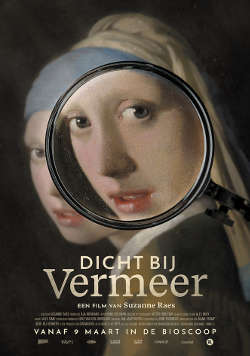
Director: Suzanne Raes
Producer: Ilja Roomans
Writer: Suzanne Raes
Photography:Victor Horstink
Sound: Alex Booy
Editor: Noud Holtman
Music: Alex Simu
Distributor: Kino Lorber
Cast: Gregor Weber, Pieter Roelofs, Anna Krekeler, Abbie Vandivere, Jonathan Janson
Subtitles in English (original language: Dutch)
Close to Vermeer (Dicht bij Vermeer) comes to American theatres
CLOSE TO VERMEER
Directed by Suzanne Raes
DOCMAKERS
For more information about tickets and viewing scedule in the United States, click here
Click here for an (English) interview with the director and writer Suzanne Raes
 WATCH NOW!
WATCH NOW!In Close to Vermeer, award-winning director Suzanne Raes gives us a unique insight into the realization of the largest Vermeer exhibition ever. She films Rijksmuseum curators Gregor Weber and Pieter Roelofs and conservators Abbie Vandivere and Anna Krekeler in their mission to shine a new light on Johannes Vermeer. For although The Milkmaid and Girl with a Pearl Earring are world-famous, we know little about the painter himself. No self-portraits, no letters, no notes; a small oeuvre is all that the Dutch Master left behind.
This fascinating documentary shows everything from the quiet diplomacy required to get the Vermeers to the Netherlands and the new knowledge gained by scanning the paintings layer by layer, to the shocking world news that one work may not be by Vermeer after all. Slowly we discover how Vermeer was able to depict reality so differently from his contemporaries. But above all, Close to Vermeer shows the infectious love of the curators and other protagonists for Vermeer’s art. As Weber lovingly puts it, "A good exhibition should change your view of the world. Vermeer can really do that."
Suzanne Raes studied Cultural Studies in Amsterdam and began her career as a researcher and chief editor for various television programs. Since 2001 she has worked as an independent director of creative documentaries on subjects such as illegal cleaners, old activists and artists. She makes accessible and engaging films that are screened worldwide and have a long life even after broadcast.
CLOSE TO VERMEER is a Docmakers production in co-production with NTR, supported by CoBO, the Netherlands Film Production Incentive, the Netherlands Film Fund, Fonds 21
Reviews
"Close to Vermeer"
Edwin Arnaudin (Ashville Movies - June 9, 2023)
<https://www.ashevillemovies.com/new/close-to-vermeer>
"‘Close to Vermeer’: The 17th-Century Artist Remains a Mystery"
Michael Clark (The Epoch Times - May 22, 2023)
<https://www.theepochtimes.com/documentary-review-close-to-vermeer-the-17th-century-artist-remains-a-mystery_5282833.html>
"Close to Vermeer" (Roger Egbert.com - May 26, 2023)
Sheila O'Malley
<https://www.rogerebert.com/reviews/close-to-vermeer-movie-review-2023>
"Close to Vermeer, BBC4—behind the scenes of a landmark show" (Financial Times- May 30, 2023)
Dan Einav
<https://www.ft.com/content/7e735fbf-78f5-4cd7-bf68-5b0b27b7b350>
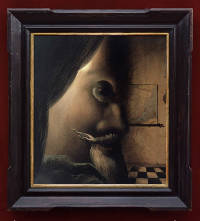
Special Vermeer/Dali exhibition
Dalí/Vermeer: A Dialogue
Meadows Museum, Dallas TX
October 16, 2022-January 15, 2023
<https://meadowsmuseumdallas.org/exhibitions/dali-vermeer-a-dialogue/>
from the Meadows Museum website:
Thanks to the generosity of the Fundació Gala-Salvador Dalí in Figueres, Spain, and the Rijksmuseum in Amsterdam, Dalí/Vermeer: A Dialogue, unites Johannes Vermeer’s Woman in Blue Reading a Letter (c. 1663) and Salvador Dalí’s interpretation thereof, The Image Disappears (1938), for the very first time.
A key part of any artist’s formal training has always been the study of their predecessors’ works, the imitation of which is seen as a crucial step in the development of one’s own style and technique. Dalí stands out as among the modern artists who most revered—indeed obsessed over—the painters that preceded him. The famed surrealist came of age just as earlier painters were being celebrated and publicized outside of their countries of origin, as was the case with the Dutch painter Vermeer, whose work he at first knew only through reproductions.
While a kind of Vermeerian iconography would come to pepper Dalí’s compositions throughout his career, less common are the instances in which the Surrealist painter reinterpreted whole compositions by Vermeer. Among these is The Image Disappears, Dalí’s interpretation of Vermeer’s Woman in Blue Reading a Letter. In The Image Disappears, whose title describes what the image does rather than what it depicts, Dalí takes the basic forms and elements of Vermeer’s composition—a woman wearing a blue night jacket, standing in profile reading a letter in front of an unseen window from which emanates soft light—and plays a visual trick on viewers, creating a second image of a mustachioed male face in profile that has been identified as that of Velázquez.
Not even Dalí would have seen these two paintings side-by-side; thus, the exhibition offers the unique opportunity to contemplate imitator and imitated within the context of the Meadows’s collection of Spanish art. The Meadows welcomes visitors to not only enjoy this rare moment to see a Vermeer in Texas, but to contemplate the broader question of imitation: is it flattery or conceit?
Additional works by Dalí from the Meadows’s collection, including works on paper, will be featured elsewhere in the museum and round out this fall’s celebration of the artist and his many evocations of art historical themes.
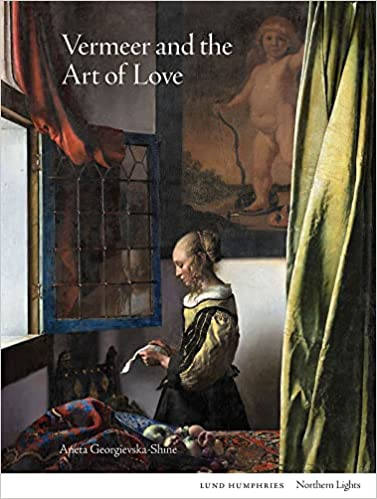
New Vermeer Publication
Vermeer and the Art of Love: A Thoughtful Consideration of Vermeer's Painted Meditation of Love
Aneta Georgievska-Shine
Publication Date: 1st June 2022
Lund Humphries Publishers Ltd
Vermeer and the Art of Love is about the emotions evoked in those elegant interiors in which a young woman may be writing a letter to her absent beloved or playing a virginal in the presence of an admirer. But it is also about the love we sense in the painter’s attentiveness to every detail within those rooms, which lends even the most mundane of objects the quality of something extraordinary
In this engaging and beautifully illustrated book, Georgievska-Shine uncovers the ways in which Vermeer challenges the dichotomies between 'good' and 'bad' love, the sensual and the spiritual, placing him within the context of his contemporaries to give the reader a fascinating insight into his unique understanding and interpretation of the subject.
Vermeer and the Art of Love deals with private emotions evoked in domestic interiors in which a young woman may be writing a letter to her absent beloved or playing a virginal in the presence of an admirer. But it is also about the love we sense in the painter’s attentiveness to every detail within those rooms, which lends even the most mundane of objects the quality of something extraordinary. In this engaging book, the author uncovers the ways in which Vermeer challenges the dichotomies between 'good' and 'bad' love, the sensual and the spiritual, placing him within the context of his contemporaries, as well as within the broader discourse on love and art in early modern Europe.
Aneta Georgievska-Shine is an academic and writer. A senior lecturer in the Department of Art History at the University of Maryland, she has published widely on early modern art, including the books Rubens, Velázquez, and the King of Spain (co-authored, Ashgate, 2014) and Rubens and the Archaeology of Myth (Ashgate, 2009).
TABLE OF CONTENTS
Prologue
Part 1: The Varied Faces of Love in Dutch Genre Painting
1.1: Words into Images
1.2: Love's Rituals: Merry Companies to Music Lessons
1.3: Cupid's Messengers
1.4: Hunts and Conquests
1.5: Indecent Proposals
1.6: The Topsy-Turvy Family
1.7: Picturing the Good Home
Part 2
The Reappearing Cupid
2.1: The Cupid on the Wall
2.2: The Dissolution of Narrative
2.3: Invitation to Liste
2.4: Reading, Writing, and Imagining Love
2.5: Returning the Lover's Gaze
2.6: Metaphysical Love
2.7: Vermeer, his Muse, and the Unfinished History
Mauritshuis launches public Girl with a Pearl Earring contest
My Girl with a Pearl
https://www.mauritshuis.nl/en/what-s-on/mauritshuis-at-home/mygirlwithapearl/
From the Mauritshuis website:
Girl with a Pearl Earring is a magical painting. Many people come to the Mauritshuis from all over the world for the opportunity to stand face to face with Vermeer’s masterpiece. Others dream of doing so. For many, the painting is a source of inspiration, a muse.
See Instagram: @mygirlwithapearl
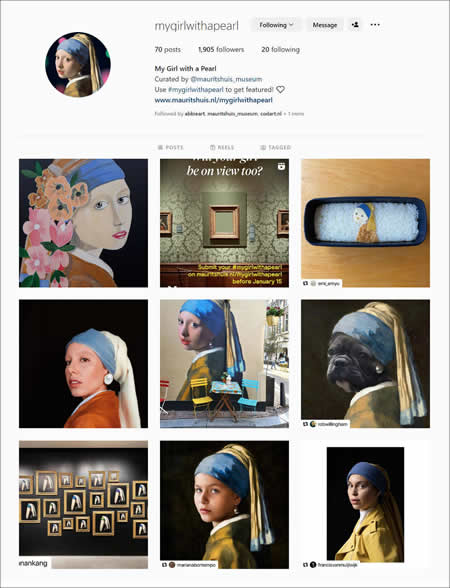
In 2023 the spotlight will be on Johannes Vermeer, painter of our Girl, as the Rijksmuseum hosts a major exhibition of his work from early February to early June. Of course no Vermeer exhibition would be complete without Girl with a Pearl Earring, so she will be moving to Amsterdam for a while (from circa February 10 to 1 April, 2023).
Don’t worry, though–we do not intend to leave her spot on our wall empty. On the contrary: her short visit to Amsterdam provides us with a unique opportunity to issue an "open call" to all her creative admirers.
The commission? To create your own version of Girl with a Pearl Earring, for a chance to show your art in the Vermeer room at the Mauritshuis.
The rules? Well, there aren't many, in fact. Feel free to surprise us. A self-portrait in a bath towel turban, a painted iron or even a pile of dishes: more or less anything goes. Since nearly everyone knows the painting, the Girl is easy to recognised. The distinctive colours, shapes, and Vermeer’s typical use of light: before you know it, she has been conjured before you.

Dutch art historian and Vermeer expert Albert Blankert dies
Albert Blankert
16 June 1940–22 November 2022
Dutch art historian and expert in seventeenth-century Dutch painting and the art of Johannes Vermeer.
Albert Blankert was among the most authoritative modern Vermeer scholars and has written extensively both on Vermeer's art and Dutch painting. His influential, no-nonse volume Johannes Vermeer van Delft, 1632–1675 (1975 ) contained a critical catalog and an important chapter on Vermeer and His Public in which for the first time attention was drawn to a group of collectors of the seventeenth, eighteenth, and early nineteenth centuries who viewed Vermeer not as much as a "sphinx" but as a "first class painter." His essay, "Vermeer's Modern Themes and Their Traditions" in the catalog of the 1995/1996 Washington D.C./The Hague Vermeer exhibition, remains one of the most lucid iconographical studies of Vermeer's painting.
In his 1976 volume he included 31 authentic works by Vermeer and rejected 4 works which were, and still are, largely accepted by authoritative experts of Dutch painting: Woman with a Lute, Girl interrupted in her Music, Girl with a Red Hat and Girl with a Flute. He excluded the Young Woman Seated at the Virginals (Leiden Collection, New York) and Saint Praxedis (Kufu Company Inc., on long-term loan to the National Museum of Western Art, Tokyo from consideration.
I was never able to meet him personally but would like to remember him via an answer he gave in an interview that he kindly granted to the Essential Vermeer in 2005.
"We appreciate, like, admire, love Vermeer's work a very great deal. We want to express all this in words and find them insufficient, so we sing, jubilate, dance, scream, paint, drum, yes, similar to what we do for a loved one or for a god, what is the difference? Personally I find that we should observe utter restraint, but in how far is that a rational stance?"
- An Interview with Albert Blankert (2005) Essential Vermeer
- "Specialism with a human face" (2004)
Gary Schwartz Art Historian: Art History from Holland
http://www.garyschwartzarthistorian.nl/210-specialism-with-a-human-face/ - "Vermeeren of verminderen: in memory of Albert Blankert" (2022)
Gary Schwartz Art Historian: Art History from Holland
http://www.garyschwartzarthistorian.nl/411-vermeeren-of-verminderen-in-memory-of-albert-blankert/
Essential Bibliograhpy
- Johannes Vermeer van Delft, 1632, 1675 with the collaboration of Rob Ruurs and Willem L. Van de Wetering, 1975
- Vermeer. Albert Blankert, John Michael Montias, Gilles Aillaud, Rob Ruurs, Willem van de Watering, and Philip Resche Rigon, Amsterdam, (English ed. New York, 1988)
- "Vermeers Gezicht op Delft" Kunstchrift 38: 48–49, 1994
- "An adjustable leg and a book: Vermeer's Lacemaker compared to others." Albert Blankert, and Louis P. Grijp. in Shop Talk: Studies in Honor of Seymour Slive, 1995
- "Vermeer's Modern Themes and Their Tradition" in Johannes Vermeer. eds. Arthur K. Wheelock Jr. and Ben Broos. National Gallery of Art, New Haven and London: Yale University Press 1995.
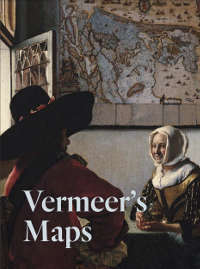
The Frick Collection publishes the most comprehensive study to date on Vermeer and maps
Vermeer's Maps
Rozemarijn Landsman
2022
The Frick Collection in association with DelMonico Books/D.A.P. New York
(hardcover, 7 1/4 x 9 3/4 in., 128 pages, 68 color illustrations)
Of the approximately thirty-four paintings attributed to Vermeer—whose extraordinary art has captivated viewers since his rediscovery in the nineteenth century—wall maps and other cartographic objects are depicted in nine of them, including The Frick Collection’s renowned Officer and Laughing Girl and the artist’s masterpiece in Vienna’s Kunsthistorisches Museum, The Art of Painting. With stunning reproductions and incisive text, the Frick’s new publication, Vermeer’s Maps, is the most comprehensive study of the artist's depiction of wall maps to date. Drawing on rare surviving examples of the physical maps and other primary sources, author Rozemarijn Landsman examines this intriguing aspect of Vermeer’s work, greatly enriching and expanding our understanding of the art and life of the "Sphinx of Delft."
As Landsman writes in the book’s introduction:
While scholars continue to remark on the prominence of maps in Vermeer’s art, these objects are rarely the center of attention. […] Questions about the maps in Vermeer’s paintings linger: What kinds of maps are they? How were they made? For whom were they produced? What were their functions? Above all, the questions of what maps meant for Vermeer and his art and what may have motivated him to choose these specific objects to adorn his painted walls remain to be addressed.
PDF Press Release:
<https://www.frick.org/sites/default/files/pdf/press/2022/Vermeer_Maps_pressrelease_September_20_FINAL%20%281%29.pdf>
sample pages:
<https://www.frick.org/sites/default/files/shop/preview/2022-vermeer-maps-sample-pages-2.pdf>
purchase:
<https://shop.frick.org/vermeers-maps>
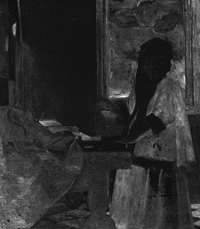
Vermeer exhibition at the National Gallery, Washington D. C. Gallery claims Girl with a Flute is not by Vernmeer's hand 
Vermeer’s Secrets
National Gallery of Art, Washington D. C.
October 8, 2022 – January 8, 2023
<https://www.nga.gov/press/exhibitions/exhibitions-2022/5675.html>
<https://www.nga.gov/index.html>
from the National Gallery website:
Friday, October 7, the Gallery announced that on the basis of new research done in the past two years the Girl with a Flute has been has definitively proven to be the product of someone likely close to Vermeer, but not the painter himself. The Gallery now believes that the work originated in the "studio of Vermeer," which, however nothing is know about.
According to the Gallery:
The mystery artist who painted Girl with a Flute was familiar with Vermeer’s unique methods and materials, but unable to achieve his level of expertise. They may have been a pupil or apprentice in training, an amateur who paid Vermeer for lessons, a freelance painter hired on a project-by-project basis, or even a member of Vermeer’s family.
This exciting notion of a studio calls into question the long-held idea of Vermeer as a lone genius. On the contrary, he might have been a mentor and educator, training a future generation of artists
For decades, conservators, scientists, and curators at the National Gallery have conducted research into this quartet of paintings as well as two enigmatic works that are now considered to be 20th-century forgeries. Vermeer’s Secrets draws on 50 years of imaging technology and microscopic examination to illuminate—and sometimes revolutionize—our understanding of how Vermeer achieved the compelling effects of his paintings’ light-filled moments of quiet solitude.
The exhibition incorporates vivid technical images made using innovative technologies pioneered by two leaders in the field of scientific imaging, the National Gallery’s senior imaging scientist John K. Delaney and imaging scientist Kathryn A. Dooley. Using hyperspectral reflectance imaging techniques first developed to map minerals for remote sensing of the earth and subsequently the moon and Mars, as well as X-ray fluorescence imaging spectroscopy, Delaney, and Dooley are able to identify and map pigments and also reveal what lies beneath the surface of a painting. While earlier technical examination (magnified examinations of the paintings, analysis of microsamples, and X-ray fluorescence spot analysis) allowed Melanie Gifford and Lisha Glinsman to hypothesize the stages in Vermeer’s working methods, these advancements in imaging technologies provided the opportunity to try and visualize those stages. The resulting images allowed the team to analyze the distribution of pigments across the paintings, distinguish compositional changes, and in the case of the Girl with the Red Hat, reveal more details about an earlier unfinished bust-length portrait of a man with a wide-brimmed hat.
- Alexandra Libby et al, "Experimentation and Innovation in Vermeer’s Girl with the Red Hat: New Findings from the National Gallery of Art," Journal of Historians of Netherlandish Art 14:2(Summer 2022)
<https://jhna.org/articles/experimentation-and-innovation-in-vermeers-girl-with-the-red-hat/> - Marjorie E. Wieseman et al, "Vermeer’s Studio and the Girl with a Flute: New Findings from the National Gallery of Art," Journal of Historians of Netherlandish Art 14:2
<https://jhna.org/articles/vermeers-studio-and-the-girl-with-a-flute/>
- E. Melanie Gifford et al, "First Steps in Vermeer’s Creative Process: New Findings from the National Gallery of Art," Journal of Historians of Netherlandish Art 14:2 (Summer 2022)
<https://jhna.org/articles/first-steps-in-vermeers-creative-process/>
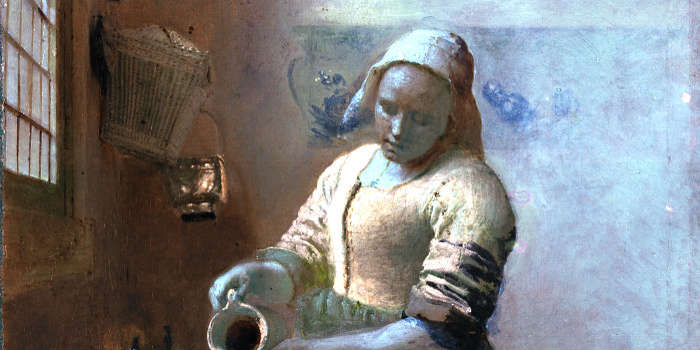
Investigation of Vermeer painting reveals "startling discoveries" about his technique 
from the CODART website:
Recent research into Vermeer’s The Milkmaid have brought to light two objects on the world-famous painting: a jug holder and a fire basket.
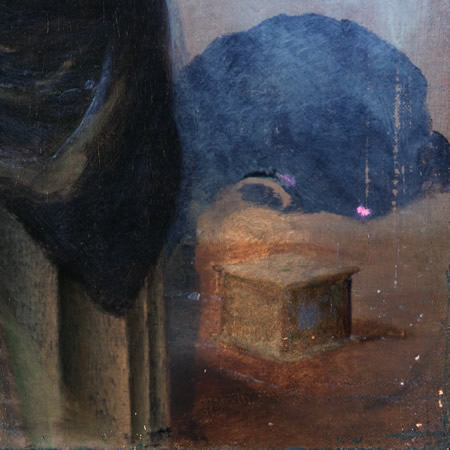
The artist himself later painted over the objects. The most recent scans also uncovered what is clearly an underpainting, suggesting that the master worked much faster than previously assumed. These new findings follow a very recent announcement by the National Gallery of Art in which similar discoveries were made after technical examination of the Vermeer paintings in Washington.
The Art Newspaper
Martin Bailey
8 September 2022
< https://www.theartnewspaper.com/2022/09/08/investigation-of-vermeer-painting-reveals-startling-discoveries-about-his-technique>
from The Art Newspaper:
Scientific investigations of Vermeer’s The Milkmaid reveal what the Rijksmuseum describes as "startling discoveries." Advanced techniques have uncovered two objects in the picture which the artist later painted over. Research also throws fresh light on Vermeer’s technique: the assumption that he worked slowly and meticulously is now being questioned.
The Milkmaid, which was bought by This large construction, which dates from medieval times, was called the Rotterdam Gate. In a drawing by Jan van Kessel the structure's purpose is evident from the crenelated top, arrow slits and apertures for aiming and discharging weapons. Between the defense work and the city gate, a long covered bridge spans most of the moat. The Rotterdam Gate was eventually pulled down in 1836. The only Delft gate which exists today is the lovely Oostpoort, whose twin towers are frequently mistaken by tourists for the Rotterdam Gate. If one compares the site with a section of the large Kaart Figuratief of Delft that was produced in the mid-1670s, we see that the building is a bit more irregular than Vermeer suggests. The twin towers, for example, seem to project farther out into the water. Evidently, Vermeer flattened the angle of the gate distorting the perspective to create a more compact composition. In a drawing by the topographical artist Abraham Rademaker, where the vantage point is slightly closer and lower than Vermeer's, the general aspect of the place is comparable even though it portrays only the portion of the Rotterdam Gate. Rademaker, like many other artists who depicted the area, emphasized the horizontal bands on the side of the gate that were made by alternating levels of brick and light-colored natural stone. Vermeer played these down to give the construction a more solid appearance. Interestingly, an examination of the View of Delft with x-radiography and infrared reflectography has shown that the artist had initially painted the twin towers bathed in bright sunlight. Moreover, the reflections of the Rotterdam Gate were defined more precisely. In the final version, however, Vermeer blurred them considerably and extended them downward so that they intersect with the bottom edge of the picture and hold the composition together.Amsterdam’s Rijksmuseum in 1908, has long been among the museum’s most popular works.
Research on The Milkmaid has been undertaken in conjunction with what will be the largest Vermeer exhibition ever held, to be presented from 10 February to 4 June 2023. It will include 28 of the 35 accepted Vermeers.
An earlier retrospective at the National Gallery of Art in Washington, DC, and the Mauritshuis in The Hague in 1995-96 included 23 paintings.
Vermeer-related exhibiton in Delft
Vermeer’s Delft
Museum Prinsenhof of Delft
February 10–June 4, 2023
https://prinsenhof-delft.nl/ontdek-het-museum/nieuws/hoofdrol-voor-delft-in-ambitieuze-tentoonstelling-over-vermeer-in-museum-prinsenhof-delft
Parallel to the Vermeer exhibition in the Rijksmuseum, Museum Prinsenhof of Delft will organize the exhibition Vermeer’s Delft (10 February to 4 June 2023). This will be the first-ever exhibition to explore in depth the cultural-historical context in which Vermeer's practice flourished. Never before has this been the starting point for an exhibition about this world-famous Delft master.
from the Museum Prinsenhof of Delft website:
The exhibition is structured around three main themes – Vermeer's personal life, the artistic climate in Delft and the socio-economic climate in the city. Each theme is introduced on the basis of a character that Vermeer actually knew. With masterpieces by Delft painters, Delft pottery, Delft carpets, archival documents and ego documents, the museum shows what Vermeer's life in Delft must have looked like and how the city influenced and shaped his work and life.
Janelle Moerman, director of Museum Prinsenhof Delft: "There are already many art historical exhibitions worldwide devoted to Vermeer's work, about the mystery surrounding his working process, his sources of inspiration and possible teachers. For the first time, the context in which he made his paintings is central to an exhibition. With Vermeer's Delft, we look specifically at Johannes Vermeer from a cultural-historical perspective. Nowhere can this story be told better than in Delft, the place where this Delft master was born and flourished."
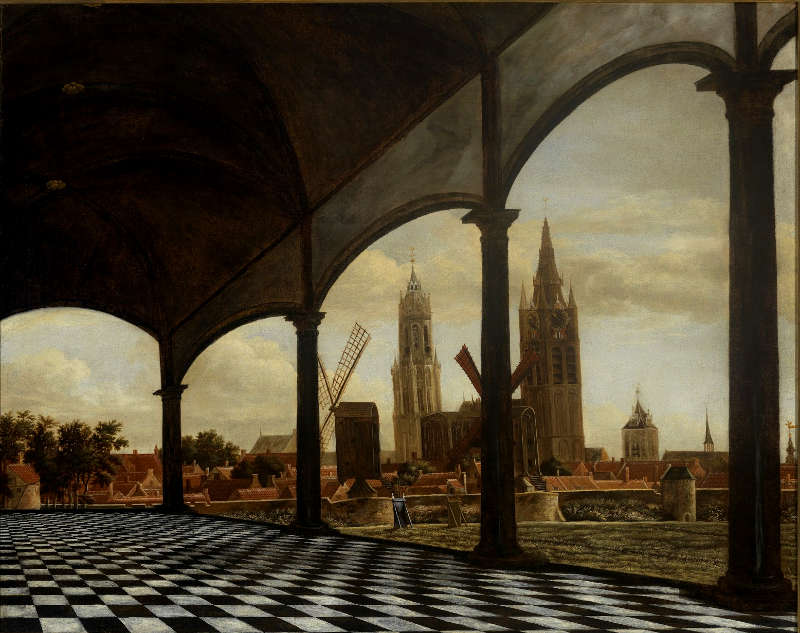
Daniël Vosmaer
1663
Oil on canvas
Museum Prinsenhof Delft (loan from the Cultural Heritage Agency)
2020–2022
.Article about Vermeer's painting technique 
New Brushstroke Analysis Reveals Vermeer Was Not the Painstaking Perfectionist
Art Net News
Taylor Dafoe
August 16, 2022
https://news.artnet.com/art-world/vermeer-underpainting-national-gallery-art-2160477
from Art Net News:
For generations, art historians believed Johannes Vermeer was a perfectionist who worked very slowly—a theory supported by his precisely placed brush strokes and relatively limited career output. But in examining one of the painter’s masterpieces, researchers at the National Gallery of Art, Washington, D. C., found that may not have actually been the case.
Underneath Woman Holding a Balance, Vermeer’s classic canvas dated from around 1664, are layers of spontaneous brushstrokes, chemical imaging has exposed.
That is just one of the revelations at the heart of a new exhibition that foregrounds the work of conservationists, an effort to show viewers "what makes a Vermeer a Vermeer."
Major Vermeer Exhibition
Major Vermeer Exhibition
Rijksmuseum, Amsterdam
February 10–June 4, 2023
The Rijksmuseum (Amsterdam) has just announced that in collaboration with the Mauritshuis (The Hague) it will stage the largest Vermeer exhibition ever. Until now, the most ambitious Vermeer exhibition was the 1995/1996 exhibit with 23 paintings in The Hague (21 in Washington). Taco Dibbits, the Rijksmuseum’s general director, expects to get 24 pictures by Vermeer—and hopefully a few more. Twenty-four paintings would already account for more than 2/3 of the artist's surviving output.
Due to the fragility of Vermeer's canvases coupled with the growing competition among museums for loans, Dibbits believes that a show, which on this scale is likely not to happen again, will provide a new generation of researchers and public a unique chance to study many of Vermeer's major works side by side.
For this exhibition, the Rijksmuseum is working closely with the Mauritshuis with a team of curators, restorers, and natural scientists to examine in depth the seven paintings by Vermeer in Dutch possession. Works by Vermeer from other collections are also involved in this project.
In addition to the works owned by the two museums, which include The Milkmaid and Woman in Blue Reading a Letter, other confirmed major loans to the show include The Girl with a Pearl Earring (from Mauritshuis), The Geographer (Städel Museum, Frankfurt), Lady Writing a Letter with her Maid (National Gallery of Ireland), Woman Holding a Balance (National Gallery of Art, Washington D.C.), and Girl Reading a Letter at an Open Window (Gemäldegalerie Alte Meister, Dresden). Additions will be made public as they are gradually confirmed.
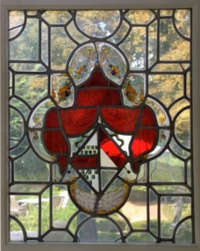
Johannes Vermeer and the Rhoon Castle
In this new paper, Hans Slager submits a hitherto unrecorded location where Vermeer may have created some of his paintings, based on visual evidence and events from his Catholic circle in Delft. Previously unconnected to Vermeer, Slager’s findings indicate that the artist may have painted in Rhoon castle, situated a few kilometers south of Rotterdam. He argues that the heraldic motif in two of Vermeer's paintings, The Glass of Wine (Berlin) and The Girl with a Wine Glass (Brunswick), is likely linked to the name Wendelnesse, a 14th century castle lady. A further inference is that a Delft Jesuit named Isaac van de Mije may have been Vermeer’s teacher. As so often in Vermeer-related studies nothing is ironclad, but Slager's scenario makes good sense and fills in various unknowns in Vermeer’s career.
click here to access PDF file of the paper
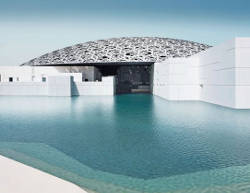
Vermeer's Astronomer on loan to Louvre Abu Dhabi for one year 
Vermeer’s Astronomer has been lent to the Louvre Abu Dhabi along with 59 other paintings of the Louvre Paris, perhaps for a year. No other information is currently available.
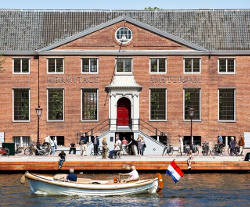
Vermeer's Milkmaid to be exhibited temporaritly in the Amsterdam Hermitage Museum
Dutch Heritage Amsterdam
Hermitage Amsterdam
April 1, 2022–May 15
The Hermitage Amsterdam has severed all ties with Russia and the State Hermitage Museum, which means that most of the museum on the Amstel will be closed with immediate effect. "War destroys everything, including thirty years of cooperation," the museum says on its website. "The Hermitage Amsterdam has no other choice at the moment." The museum has always worked closely with the State Hermitage Museum in the Russian city of Saint Petersburg, one of the largest museums in the world. As a result, many special pieces of art were also exhibited in Amsterdam.
It is no coincidence that the exhibition series is given the name Dutch Heritage Amsterdam. Museum director Annabelle Birnie already speculated in an interview with NRC at the beginning of March about removing the letter "M" from Hermitage. A spokesperson for the museum says that the name is currently "on pause."
The part of the building of the Hermitage Amsterdam that was closed due to the war in Ukraine will be given a temporary new destination from 1 April. From then on, an exhibition series called Dutch Heritage Amsterdam can be seen in the museum building on the Amstel. The intention is to successively exhibit five masterpieces from other Dutch museums, which the museum will borrow for several weeks. The first work to be exhibited in the Hermitage building is Johannes Vermeer's The Milkmaid, which now hangs in the Rijksmuseum and is not often loaned out. Which works of art will follow will be announced later.
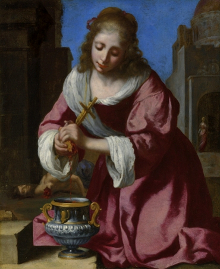
Article on the Vermeer's Saint Praxedis, presumed by some to be an early work by Vermeer
The art historian Gary Schwartz has just published a post on his Schwartzlist Column about the painting Saint Praxedis, claimed by a handful of critics to Vermeer, as a youthful copy of an original by the Italian painter Felice Ficherelli. After Arthur K. Wheelock threw his full critical weight in favor, it was auctioned by Christie’s (2014), fetching the relatively modest sum of $7,7 million. The buyer is said to be an Oriental collector. Today, it’s exhibited at the Tokyo National Museum of Western Art cataloged as "attributed to Vermeer." It soon fell off critical radar.
link to article: http://www.garyschwartzarthistorian.nl/405-early-vermeer-body-fluids/
The article begins with: "Did Vermeer’s Kitchen maid, an icon of Dutchness, have an older, Italian sister? Schwartz finds her resemblance to an earlier, unjustifiably doubted, Vermeer copy after an Italian painting of a saint so convincing that he sticks his neck out to argue that she does."
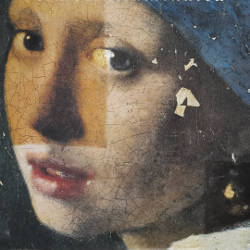
Online seminar
Girl with a Pearl Earring: Vermeer’s mid-career masterpiece, technique & illusion
April 7, 2022 3:00 pm - 4:00 pm BST
Jørgen Wadum
price: £25.00
places available: 80
This seminar will examine the painting techniques of Johannes Vermeer (1632-1675) and take as its starting point the restoration and examinations of the Girl with a Pearl Earring. The artist’s understanding of light and perspective, the use of a traditional, yet effectful way of creating convincing spatial illusions will be set against his proposed use of a camera obscura. Debateable attributions will be presented and placed within the techniques of the master both early and late in his career.
Jørgen Wadum is Special Advisor of Dutch & Flemish art at the Nivaagaard Collection, Nivå, Denmark. Until 2020 he was director of the Centre for Art Technological Studies and Conservation (CATS), Copenhagen, and 2012-2016 he held the position as full Professor in Conservation & Restoration at the University of Amsterdam. From 1990 through 2004 he was Chief Conservator at the Mauritshuis, The Hague, Netherlands. He has published and lectured extensively internationally on a multitude of subjects related to technical art history and other issues of importance for the understanding and keeping of our cultural heritage.
There will be a 55min presentation followed by 15min of discussion.
click here to enquire about this event
© Gemäldegalerie Alte Meister in Dresden, Photo: Wolfgang Kreische
Dutch painting exhibition in Tokyo with Vermeer's recently restored Girl Reading a Letter at an Open Window reopens! 
Johannes Vermeer and 17th-Century Dutch Paintings
Tokyo Metropolitan Art Museum
February 10–April 3, 2022
After a brief closure due to the COVID oandemic, exhibiton of Dutch painting with Vermeer’s Girl Reading a Letter at an Open Window in Japan has beenreopened on February 10, 2022.
After a thorough restoration of the masterpiece revealed a "picture-within-a-picture" showing a Cupid, which had been painted over by another artist years after the painting had left Vermeer's studio. Also featured will be some sixty 17th-century Dutch paintings from the collection of the Dresden Gemäldegalerie Alte Meister, Staatliche Kunstsammlungen, including important works by Rembrandt van Rijn, Gabriël Metsu and Jacob van Ruisdael.
Facebook:
https://www.facebook.com/vermeerten/
tel: 03-3823-6921
fax: 03-3823-6920
© Gemäldegalerie Alte Meister in Dresden, Photo: Wolfgang Kreische
Dutch painting exhibition with Vermeer's recently restored Girl Reading a Letter at an Open Window cancelled for Covid. 
Johannes Vermeer and 17th-Century Dutch Paintings
Tokyo Metropolitan Art Museum
January 22 – April 3, 2022
The exhibiton of Dutch painting with Vermeer’s Girl Reading a Letter at an Open Window in Japan has been cancelled due to the latest Covid 19 outbreak. The new opening date and ticket reservation start date will be announced on the official exhibition website.
After a thorough restoration of the masterpiece revealed a "picture-within-a-picture" showing a Cupid, which had been painted over by another artist years after the painting had left Vermeer's studio. Also featured will be some sixty 17th-century Dutch paintings from the collection of the Dresden Gemäldegalerie Alte Meister, Staatliche Kunstsammlungen, including important works by Rembrandt van Rijn, Gabriël Metsu and Jacob van Ruisdael.
Twitter:
https://www.instagram.com/vermeerten2022/?hl=en
tel: 03-3823-6921
fax: 03-3823-6920
Vermeer Dresden exhibition with 10 Vermeer paintings in Old Masters Pictures Gallery suspended due to anti-COVID-19 measures
Vermeer: On Reflection
Old Master Pictures Gallery, Dresden
September 10, 2021 - Januarury 2, 2002
The exhibiton has been temporarily closed until further notice due to recent anti-COVID-19 restrictions.
On the occasion of the newly-restored Girl Reading a Letter at an Open WIndow, the Dresden Gemäldegalerie has inaurgurated a special exhibition Vermeer, which is to be shown in the special exhibition rooms of the Semper building on the Zwinger in only one exhibition station.
At the heart of the exhibition are the Girl Reading a Letter at the Open Window and another 9 paintings by Vermeer that are closely related to the picture. Moreover, 40–50 works of Dutch genre painting from the second half of the 17th century, including major works by Pieter de Hooch, Frans van Mieris, Gerard Ter Borch, Gabriel Metsu, Gerard Dou, Emanuel de Witte and Jan Steen, also present Vermeer's artistic environment with whom he was in close contact. Selected examples from other art forms such as sculptures, graphic prints, porcelain, and historical furniture will enrich the exhibition in a meaningful relationship to individual paintings.
The restored masterpiece will be shown in an historically-accurate ebony frame.
Vermeer paintings on display: The Procuress, Girl Reading a Letter at an Open Window, The Little Street, The Girl with a Wine Glass, Girl Interrupted in her Music, Woman with a Pearl Necklace, Woman Holding a Balance, The Geographer and A Lady Standing at the Virginal.
for further information contact: besucherservice@skd.museum
or visit:
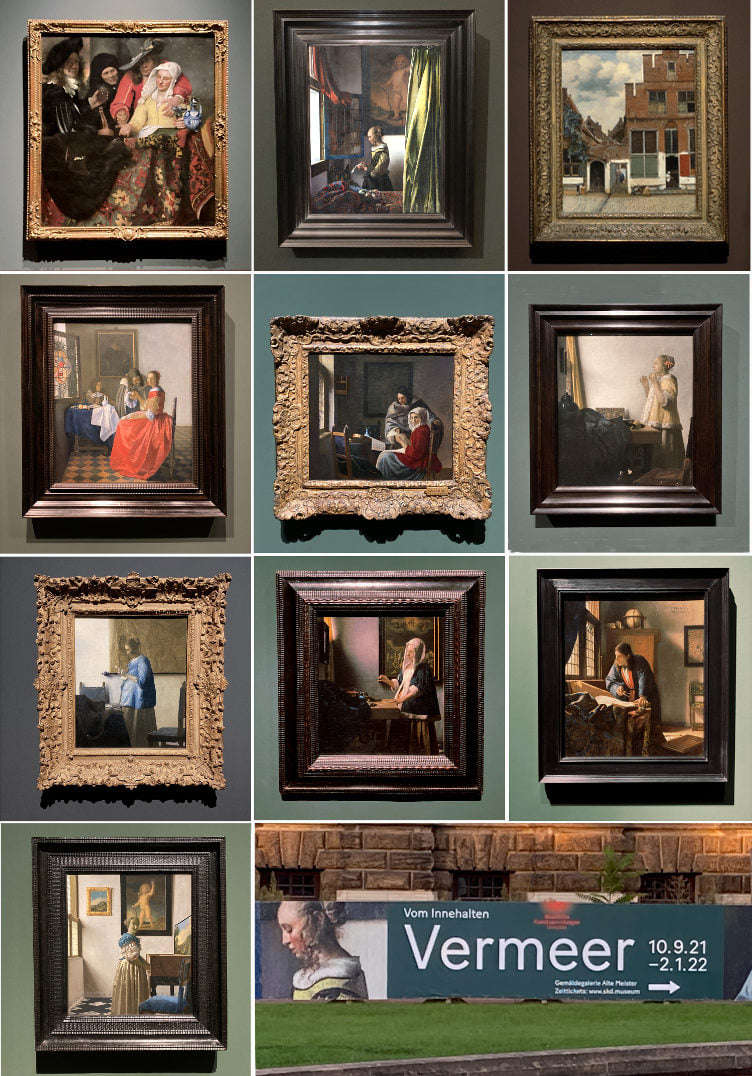
The Restoration
from the Gemäldegalerie website:
After a full restoration, and for the first time in over two and a half centuries, Johannes Vermeer’s well-known and loved painting Girl Reading a Letter at an Open Window has been returned to its original condition when it left the artist’s studio. The famous work will be presented to the public as the focal point and highlight of the Johannes Vermeer. On Reflection exhibition starting on 10 September 2021 in the Gemäldegalerie Alte Meister.
The canvas, painted around 1657-1659, was acquired in Paris in 1742 for the collection of Saxon Prince Elector Friedrich Augustus II, and has been one of the principal works in Dresden’s Gemäldegalerie ever since. An X-ray taken of the painting in 1979 showed that there was a fully overpainted picture-within-a-picture of a nude Cupid that adorned the room’s rear wall in the background. Annaliese Mayer-Meintschel first published this fascinating finding in 1982, and it has been cited in many works on the subject. Since then, academics have assumed that Vermeer rejected the Cupid painting as he was unhappy with the composition, and painted over the room’s rear wall himself.
During a restoration and research project that began in 2017 and was supported by a panel of international experts, the team made or re-evaluated X-rays, infrared reflectance spectroscopies and microscopies of the oil painting in the past few years. The backing canvas was also analyzed in detail and research was conducted into the painting’s restoration history. Multiple color samples were taken from Vermeer’s painting and the layers and consistency were analyzed in Dresden Academy of Fine Arts’ Laboratory of Archaeometry (HfBK). These studies played a decisive role in reassessing the extensive overpainting of the Cupid figure in the Girl Reading a Letter at an Open Window. We can now safely state that it was not Vermeer himself who painted over the background, and that the retrospective change was applied at least several decades after the painting was made, and significantly after the artist’s death. A full-surface X-ray fluorescence scan of the painting, conducted with the support of the Rijksmuseum in 2017, confirmed our new findings on the overpainting.
Given the strong evidence that a third party had painted over the Cupid retroactively, Staatliche Kunstsammlungen Dresden (SKD), endorsed by the panel of experts, made the decision in early 2018 to remove the overpainted layer. Christoph Schölzel, a conservator at the SKD Paintings Conservation Workshop, took on overall responsibility for restoration of the painting.
Following completion of the restoration process in early 2021, the painting now has an entirely new look. A standing Cupid with a bow, arrows, and two masks has been revealed in the background, enriching the room’s rear wall as a picture-within-a-picture. The figure is treading on the masks of pretence lying on the ground before him – a sign of sincere love overcoming deception and hypocrisy. The presence of Cupid in the composition is a meaningful ‘comment’ that adds greatly to the painting’s message.
Stephan Koja, Director of the Gemäldegalerie Alte Meister und Skulpturensammlung bis 1800: "It is in Girl Reading a Letter that Vermeer discovers his own, distinct style. It marks the beginning of a series of paintings in which individuals, generally women, pause during an activity to find a moment of calm, and to reflect. In this series, Vermeer examines fundamental existential questions, in particular in this piece: Restoring the Cupid in the background shows us the master from Delft’s true intention. Beyond the superficial romantic context, it makes a fundamental statement on the nature of true love. Until now, we could only see this as a fragment. Now we know what a key role it plays in his oeuvre."
Uta Neidhardt, Head Conservator and Exhibition Curator: "The changed appearance of the Girl Reading a Letter at an Open Window, including the overpainting removed at the borders of the canvas, gives us an opportunity to reconsider the painting’s composition and how it works visually. The borders appear curiously unfinished—perhaps Vermeer covered it with an actual wooden frame, which is why he left them in such an "open" condition. If we assume that he had planned to use such a construction, we immediately recall the experimental works by church interior painters from Delft, with their trompe-l’oeil curtains, or Pieter de Hooch’s intricate interiors."

Exhibition Catalogue
Johannes Vermeer: On Reflection
Stephan Koja, Uta Neidhardt; Arthur K. Wheelock Jr. et al.,
264 pages, 252 color illus.
28 x 24 cm,
hardcover
release date 9/10/2021
ISBN 978-3-95498-610-1
On the occasion of the ground breaking Vermeer exhibition, Vermeer : On Reflection in Dresden, the Staatliche Kunstsammlungen Dresden has published a sumptuously illustrated catalogue that will illustrate the relationships and interactions in the work of the Delft painter and his fellow artists. The catalogue brings together texts by renowned authors who address both the restored work and fundamental questions about the style and essence of Vermeer's painting, his optical realism, his love symbolism and the world of women in the so-called Golden Age.
preorder here:
https://verlag.sandstein.de/detailview?no=98-610
thumb through the catalogue at:
https://verlag.sandstein.de/reader/98-611_Vermeer-engl/
essays:
STEPHAN KOJA - From the Inner Support of the World: Vermeer's Painting as Spaces for Reflection
ARTHUR K. WHEELOCK JR. - Johannes Vermeer: A Classicist among Genre Painters
MARJORIE E. WIESEMAN - Women in the Republic of United Netherlands: Genre Painting and Society in the Second Half of the 17th Century
ROBERT FUCCI - Curtains and Perspectives: Vermeer's Optical Realism
GREGOR J. M. WEBER - Cupid in Vermeer's Paintings
UTA NEIDHARDT - Interplay of Art and Life: Vermeer's Girl Reading a Letter at the Open Window in a New Shape
CHRISTOPH SCHÖLZEL - The Restoration and Painting Technique of the Girl Reading a Letter at an Open Window by Johannes Vermeer
An extensive accompanying program, which includes film documentation and a digitorial, as well as special tours, a series of lectures and a reading series, serves to convey the ambitious exhibition project. A catalog and a children's guide will be published for the special exhibition.
Below are the ten Vermeer paintings that will be part of the exhibition.
The Procuress
Girl Reading a Letter by an Open Window
The Little Street
Girl Interrupted in her Music
The Girl with a Wineglass
Woman in Blue Reading a Letter
Woman Holding a Balance
Woman with a Pearl Necklace
The Geographer
Lady Standing at the Virginal
First image of newly-restored Girl Reading a Letter at an Open Window just released
The Dresden Gemäldegalerie has just posted the first image of the newly restored early masterpiece Girl Reading a Letter by an Open Window by Vermeer that has undergone a major restoration initiated in May 2017. The picture exhibits a brilliant color scheme that is quite in line with Vermeer's other early works (e.g., The Procuress, The Milkmaid, Officer and Laughing Girl), all very distant from the previous comfortable but false Rembrandtesque glow caused by aged varnish.
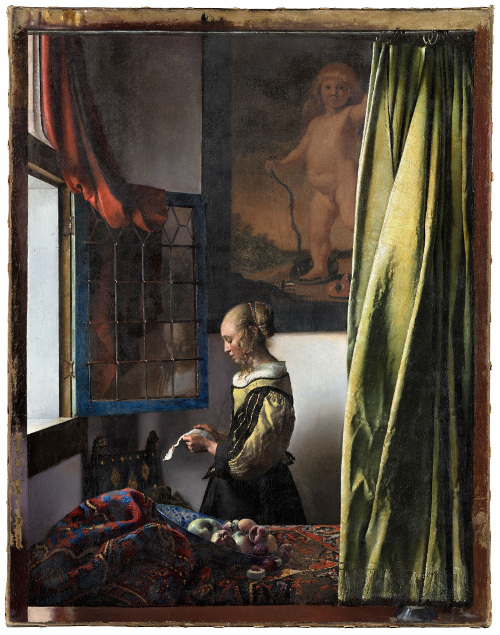 Girl Reading a Letter at an Open Window
Girl Reading a Letter at an Open Window Johannes Vermeer
c. 1657–1659
Oil on canvas, 83 x 64.5 cm.
Gemäldegalerie Alte Meister, Dresden
© Gemäldegalerie Alte Meister in Dresden,photo: Wolfgang Kreische
from the Gemäldegalerie website:
After a full restoration, and for the first time in over two and a half centuries, Johannes Vermeer’s well-known and loved painting Girl Reading a Letter at an Open Window has been returned to its original condition when it left the artist’s studio. The famous work will be presented to the public as the focal point and highlight of the Johannes Vermeer. On Reflection exhibition starting on 10 September 2021 in the Gemäldegalerie Alte Meister.
The canvas, painted around 1657-1659, was acquired in Paris in 1742 for the collection of Saxon Prince Elector Friedrich Augustus II, and has been one of the principal works in Dresden’s Gemäldegalerie ever since. An X-ray taken of the painting in 1979 showed that there was a fully overpainted picture-within-a-picture of a nude Cupid that adorned the room’s rear wall in the background. Annaliese Mayer-Meintschel first published this fascinating finding in 1982, and it has been cited in many works on the subject. Since then, academics have assumed that Vermeer rejected the Cupid painting as he was unhappy with the composition, and painted over the room’s rear wall himself.
During a restoration and research project that began in 2017 and was supported by a panel of international experts, the team made or re-evaluated X-rays, infrared reflectance spectroscopies and microscopies of the oil painting in the past few years. The backing canvas was also analyzed in detail and research was conducted into the painting’s restoration history. Multiple color samples were taken from Vermeer’s painting and the layers and consistency were analyzed in Dresden Academy of Fine Arts’ Laboratory of Archaeometry (HfBK). These studies played a decisive role in reassessing the extensive overpainting of the Cupid figure in the Girl Reading a Letter at an Open Window. We can now safely state that it was not Vermeer himself who painted over the background, and that the retrospective change was applied at least several decades after the painting was made, and significantly after the artist’s death. A full-surface X-ray fluorescence scan of the painting, conducted with the support of the Rijksmuseum in 2017, confirmed our new findings on the overpainting.
Given the strong evidence that a third party had painted over the Cupid retroactively, Staatliche Kunstsammlungen Dresden (SKD), endorsed by the panel of experts, made the decision in early 2018 to remove the overpainted layer. Christoph Schölzel, a conservator at the SKD Paintings Conservation Workshop, took on overall responsibility for restoration of the painting.
Following completion of the restoration process in early 2021, the painting now has an entirely new look. A standing Cupid with a bow, arrows, and two masks has been revealed in the background, enriching the room’s rear wall as a picture-within-a-picture. The figure is treading on the masks of pretence lying on the ground before him – a sign of sincere love overcoming deception and hypocrisy. The presence of Cupid in the composition is a meaningful ‘comment’ that adds greatly to the painting’s message.
Stephan Koja, Director of the Gemäldegalerie Alte Meister und Skulpturensammlung bis 1800: "It is in Girl Reading a Letter that Vermeer discovers his own, distinct style. It marks the beginning of a series of paintings in which individuals, generally women, pause during an activity to find a moment of calm, and to reflect. In this series, Vermeer examines fundamental existential questions, in particular in this piece: Restoring the Cupid in the background shows us the master from Delft’s true intention. Beyond the superficial romantic context, it makes a fundamental statement on the nature of true love. Until now, we could only see this as a fragment. Now we know what a key role it plays in his oeuvre."
Uta Neidhardt, Head Conservator and Exhibition Curator: "The changed appearance of the Girl Reading a Letter at an Open Window, including the overpainting removed at the borders of the canvas, gives us an opportunity to reconsider the painting’s composition and how it works visually. The borders appear curiously unfinished—perhaps Vermeer covered it with an actual wooden frame, which is why he left them in such an "open" condition. If we assume that he had planned to use such a construction, we immediately recall the experimental works by church interior painters from Delft, with their trompe-l’oeil curtains, or Pieter de Hooch’s intricate interiors."
On the occasion, the Gemäldegalerie is planning the exhibition Vermeer, which is to be shown in the special exhibition rooms of the Semper building on the Zwinger in only one exhibition station.
At the heart of the exhibition are the Girl Reading a Letter at the Open Window and another 9 paintings by Vermeer that are closely related to the picture. Moreover, 40–50 works of Dutch genre painting from the second half of the 17th century, including major works by Pieter de Hooch, Frans van Mieris, Gerard Ter Borch, Gabriel Metsu, Gerard Dou, Emanuel de Witte and Jan Steen, also present Vermeer's artistic environment with whom he was in close contact. Selected examples from other art forms such as sculptures, graphic prints, porcelain, and historical furniture will enrich the exhibition in a meaningful relationship to individual paintings.
The restored masterpiece will be shown in an historically-accurate ebony frame in the Johannes Vermeer. On Reflection exhibition (10 September 2021 until 2 January 2022).
As a result of the research project, the painting technique and restoration of the Girl Reading a Letter at the Open Window will be devoted to a separate exhibition segment to illustrate the comple, experimental process used in creating the painting.
for further information contact: besucherservice@skd.museum
or visit:

Essential Vermeer Facebook
Special exhibition with three Vermeers in The Hague
Facelifts & Makeovers
October 7, 2021–January 9, 2022
Mauritshuis, The Hague
https://www.mauritshuis.nl/en/what-s-on/exhibitions/
from the Mauritshuis website:
Very few people know that there is a conservation studio in the Mauritshuis attic. A team of in-house conservators works there, dedicating their time to conservation, restoration, and research and ensuring that the collection remains in top condition. In 2021 it will be some 25 years since the studio was installed in the attic. In Facelift & Make-overs the most intriguing restorations of the past twenty years will be unveiled, including paintings by Rembrandt, Johannes Vermeer, Hals, Steen, and Rubens, but also by some lesser-known artists such as Cornelis de Heem and Jacob Ochtervelt. Restoring centuries-old paintings appeals to the imagination. What does it involve? What can we learn from conservation treatment? What do paintings look like "before" and "after"? And what have been the most surprising findings?
How is it possible that centuries-old paintings by Rembrandt, Vermeer and Rubens still look so good today? This is partly thanks to conservators, who ensure that paintings are preserved in the best possible way.
The exhibition Facelift & Make-overs shines a light on what usually remains out of sight, namely the conservation of paintings. What is conservation? Why is it necessary? And what secrets do conservators uncover above and below the layers of paint? Welcome to the hidden world of conservation!


Vermeer's Allegory of Faith travels to Australia
European Masterpieces from The Metropolitan Museum of Art, New York
Gallery of Modern Art, Brisbane
June 12, 2021–October 17, 2021
Brisbane’s Gallery of Modern Art will be the exclusive Australian venue for a major exhibition which will feature many of the most important works of the Metropolitan Museum of Art, the majority of which rarely leave permanent display in New York. European Masterpieces’ will include portraiture, still-life, landscape, and figure studies and will be a must-see for art-lovers and anyone with an interest in history, society or art.
Vermeer's late-career "Allegory of Faith" will be among the paintings exhibited. Other works include Titian’s "Venus and Adonis,"Caravaggio’s "The Musicia," Rembrandt’s "Flora" and Vincent van Gogh’s "The Flowering Orchard."

Vermeer's Music Lesson on continous display at Buckingham Palace
Masterpieces from Buckingham Palace
The Queen's Gallery, Buckingham Palace, London
Friday, 11 Dec 2020 - Monday, 31 Jan 2022
The exhibition brings together some of the most important paintings in the Royal Collection from the Picture Gallery at Buckingham Palace. Normally on public view for a limited time during the annual Summer Opening of the Palace, the paintings will be shown in The Queen’s Gallery while reservicing works are carried out to protect the historic building for future generations. The Picture Gallery was originally designed by the architect John Nash for George IV to display his collection of Dutch, Flemish, and Italian Old Master paintings.
Artists represented in the exhibition include Titian, Guercino, Guido Reni, Vermeer, Rembrandt, Van Dyck, Rubens, Jan Steen, Claude, Canaletto, and Vermeer with his late-career masterpiece, The Music Lesson. All events at the Queen's Gallery Buckingham Palace will be managed in line with COVID-secure procedures.
See the gallery's Welcome Back page for
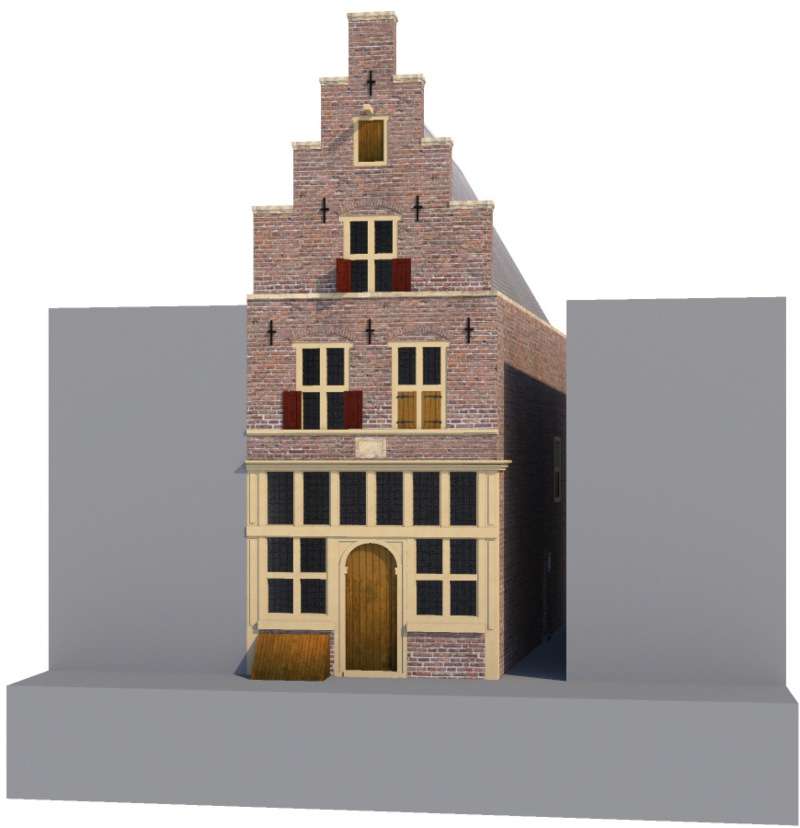
New Essential Vermeer article about the house where Vermeer grew up
Mechelen: 1625–1885, curated by Jonathan Janson
Mechelen
In 1641, the young Vermeer and his family moved into a large building on the corner of Market Place and Old Men's Ally in Delft called Mechelen. Here his father would conduct his business as an innkeeper, art dealer and caffa worker, and, perhaps, Vermeer made his first paintings. Little is know about the building except that it had four fireplaces and was demolished in 1885. In mainstream Vermeer-related literature Mechelen has been traditionally illustrated with a print of the Market Place published in c. 1730 by Leonard Schenk.
However, only a few of today's Vermeer devotees are aware that a number of images of Mechelen have survived.
This brand-new, richly illustrated EV article traces the life of the building from 1625, when the first known effigy was made, to 1885, when plans were drawn up to widen the narrow Old Men's Ally by demolishing the historic building.
The article features an in-depth analysis of rarely considered period engravings, lithographs, maps, diagrams, and pre-1885 photographs. Moreover, two 3-D virtual reconstructions help us to picture what Mechelen may have looked like in 1625 and in its final days. In-depth research was done in collaboration with the painter and Vermeer lover Peter Jochems. 3-D reconstructions by Timothy De Paepe, curator of the Museum Vleeshuis.
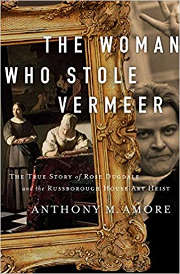
New book on Vermeer thief
The Woman Who Stole Vermeer: The True Story of Rose Dugdale and the Russborough House Art Heist
available at Amazon.com: November 10, 2020
by Anthony M. Amore
https://amzn.to/3BWj7ac
The extraordinary life and crimes of heiress-turned-revolutionary Rose Dugdale, who in 1974 became the only woman to pull off a major art heist.
In the world of crime, there exists an unusual commonality between those who steal art and those who repeatedly kill: they are almost exclusively male. But, as with all things, there is always an outlier—someone who bucks the trend, defying the reliable profiles and leaving investigators and researchers scratching their heads. In the history of major art heists, that outlier is Rose Dugdale.
Dugdale’s life is singularly notorious. Born into extreme wealth, she abandoned her life as an Oxford-trained PhD and heiress to join the cause of Irish Republicanism. While on the surface she appears to be the British version of Patricia Hearst, she is anything but.
Dugdale ran head-first towards the action, spearheading the first aerial terrorist attack in British history and pulling off the biggest art theft of her time. In 1974, she led a gang into the opulent Russborough House in Ireland and made off with millions in prized paintings, including works by Goya, Gainsborough, and Rubens, as well as Lady Writing a Letter with her Maid by the mysterious master Johannes Vermeer. Dugdale thus became—to this day—the only woman to pull off a major art heist. And as Anthony Amore explores in The Woman Who Stole Vermeer, it’s likely that this was not her only such heist.
The Woman Who Stole Vermeer is Rose Dugdale’s story, from her idyllic upbringing in Devonshire and her presentation to Elizabeth II as a debutante to her university years and her eventual radical lifestyle. Her life of crime and activism is at turns unbelievable and awe-inspiring, and sure to engross readers.
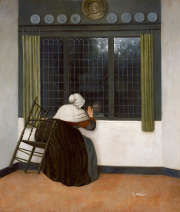
"Minor" Dutch painter reevaluated: first venue (Munich) canceled.
Who was Jacobus Vrel? Looking for Clues of an Enigmatic Painter
Alte Pinakothek, Munich
October 19, 2021 - January 23, 2022
As a result of the Covid pandemic, the first venue (Munich) of the exhibition has been canceled.
Jacobus Vrel’s works seemingly reflect everyday life in a small Dutch town in the 17th century while creating enigmatic worlds at the same time in which the viewer is not addressed in any way at all. The figures turn away from us, show only their backs or appear lost in thought. The depictions even exude, in part, an oppressive stillness. Not without reason a close affinity to the well-known Dane Vilhelm Hammershøi (1864–1916) has repeatedly been construed, whose atmospheric compositions, however, were created two centuries later.
Equally unusual are Vrel’s street scenes. The spatial arrangement of the buildings shown is reminiscent of film or theater sets. It is difficult to find comparable examples from the painter’s own time. There are neither plausible paradigms nor are there any clear similarities to the works of better-known fellow artists. Always in vertical format, the compositions show multi-storeyed but slender brick houses, mostly with pointed gabled roofs, lined up close to one another. Only a few figures populate the narrow alleyways paved with cobblestones. Are these real places that Vrel has rendered here or are they the painter’s invention, bearing no semblance to his immediate surroundings?
Together with the Fondation Custodia in Paris and the Mauritshuis in The Hague, the Alte Pinakothek in Munich is staging the first monographic exhibition on the mysterious painter Jacobus Vrel and, with 35 paintings by Vrel, focuses on this harbinger of modernism whose secret is only revealed at second glance. The new findings of the international project do away with the preconceived notion of a "Vermeer du pauvre"—the poor-man’s Vermeer—and show that Vrel is to be seen much more as a precursor of Pieter de Hooch and Vermeer and not as their successor.
related publication:
A comprehensive monograph with a catalogue of all the artist’s works will be published in German, English, and French to accompany the exhibition.
all venues:
Alte Pinakothek, Munich (13 October 2020 – 10 January 2021)
Fondation Custodia, Collection Frits Lugt, Paris (2003?)
Mauritshuis, The Hague (2003?)

EV article on the maps in Vermeer's painting
"Vermeer's Maps
curated by Jonathan Janson
In half a dozen of Vermeer's paintings, 5 maps can be seen hanging on the white-washed walls of his interior (another map, a large wall map, had originally been included Woman with a Pearl Necklace but was subsequently eliminated by the artist). Other than being interesting compositional elements and a technical challenge of the first order, maps provided Vermeer and many other Dutch painters a type of theoretical window to the greater world outside of the quiet intimacy of household environment. This lushly illustrated article provides historic information about each of the maps as well as a technical analysis of how they were painted.

Vermeer's Music Lesson on dispay at Buckingham Palace for two years
Masterpieces from Buckingham Palace
Friday, 11 Dec 2020 - Monday, 31 Jan 2022
The Queen's Gallery, Buckingham Palace, London
https://www.rct.uk/collection/themes/exhibitions/masterpieces-from-buckingham-palace/the-queens-gallery-buckingham
The exhibition brings together some of the most important paintings in the Royal Collection from the Picture Gallery at Buckingham Palace. Usually on public view during the annual Summer Opening of the Palace, the paintings will be shown in The Queen’s Gallery while Reservicing works are carried out to protect the historic building for future generations. The Picture Gallery was originally designed by the architect John Nash for George IV to display his collection of Dutch, Flemish, and Italian Old Master paintings.
Artists represented in the exhibition include Titian, Guercino, Guido Reni, Vermeer, Rembrandt, Van Dyck, Rubens, Jan Steen, Claude, Canaletto, and Vermeer with his masteriece, The Music Lesson

Be alone with a Vermeer masterpiece
Alone with Vermeer
Exhibition: 26 September 2020–3 January 2021
https://www.mauritshuis.nl/en/what-s-on/exhibitions/
The renowned French novelist Marcel Proust visited the Mauritshuis in 1902 and was deeply impressed by Vermeer’s masterpiece. Many years later he wrote in a letter: "From the moment that I saw View of Delft in the museum in The Hague, I knew that I had seen the most beautiful painting in the world."
This exhibition consists solely of the View of Delft. During a pre-booked slot, visitors will have the opportunity–either alone or in a very small group–to experience in silence the effect that this very special artwork has on them. An ideal viewing experience is being created to support this: subtle design, perfect lighting and no external sounds or distractions. Alone with Vermeer. For many this display offers the opportunity to (re)discover their favorite painting, with which they sometimes already have a strong bond, in a unique environment.
find more information and book your time slot alone with View of Delft via the museum website:
https://www.mauritshuis.nl/en/ticketshop/alleenvermeer/selecteer/

New film about Vermeer forger, Han van Meegeren
The Last Vermeer
Director: Dan Friedkin
Writers: Jonathan Lopez (based on the book The Man Who Made Vermeers)
Stars: Guy Pearce, Claes Bang, Vicky Krieps
The Last Vermeer (originally titled Lyrebird) is an American drama film directed by Dan Friedkin from a screenplay by John Orloff, Mark Fergus, and Hawk Ostby. It is based on the 2008 book The Man Who Made Vermeers by Jonathan Lopez, and tells the story of Han van Meegeren (played by Guy Pearce), an art forger who forged Vermer paintings and swindled millions of dollars from the Nazis, alongside Dutch Resistance fighter Joseph Piller (Claes Bang).
The film had its world premiere at the Telluride Film Festival on August 31, 2019, and is scheduled to be theatrically released on November 20, 2020, by Tristar Pictures.
Click here to read an exclusive interveiw with Lopez.
The Frick Collections upgrades web presence and adds a new page on Vermeer
Johannes Vermeer
https://www.frick.org/art/artists/vermeer
The Frick recently upped their digital presence with an elegant, user-friendly web study dedicated exclusively to their three paintings by Vermeer: Officer and Laughing Girl, Girl Interrupted in her Music and Mistress and Maid. their three Vermeers. The page offers access to the paintings, articles, podcasest, and a few vidoes, as well links to as the Frick's rich collection of Photoarchive images, scanned books and archival documents.
Frick curator Aimee Ng pulls back the curtain on Vermeer's Mistress and Maid in video
Cocktails with a Curator: Vermeer's Mistress and Maid
Friday, December 11, 5 p.m. EST
In an initiative to bring the public closer to its fabulous collection, the Frick is "concocting the perfect mix of cocktails and art." Every Friday at 5:00 p.m., join the Frick for happy hour (remotely) while a museum insider offers insights on a work of art with a complementary cocktail (sorry, the Frick will provide the happiness but you have to mix you own beverage).
This Friday's Cocktails with a Curator video (available at link below from 5 p.m. NYC time) will feature Vermeer's luxurious Mistress and Maid. Curator Aimee Ng will pull back the curtain on hidden details in the painting, the largest of the Frick’s three Vermeers. Take a closer look at the rumpled tablecloth, the lady’s wispy curls, and the dark background to understand how this mysterious work has changed since Vermeer applied paint to canvas in the mid-17th century.
Youtube Cocktails with a Curator playlist:
https://www.youtube.com/playlist?list=PLNVeJpU2DHHR_0y_Zvgn3MgZQQFcFx2eI
cocktail:
Genever Brulée: 2 oz. genever, 1 teaspoon brown sugar, few dashes of classic bitters, dash of orange bitters, a splash of sparkling water, garnished with a caramelized orange slice.
suggested image:
In order to get the most out of the talk you might wish to pull up a good image of the Mistress and Maid and set it side by side on your monitor as the video plays. The largest image is at the Google Art Project:
https://artsandculture.google.com/asset/mistress-and-maid-johannes-vermeer/xwFyx_AQGT2Y-w?hl=en\
But the colors are far superior on the Frick website, although it is a bit more tricky to maneuver the painting in the zoom box.
Video episode from the Frick Collection, New York: Cocktails with a Curator: Vermeer's 'Officer and Laughing Girl'
by Frick curator Aimee Ng
https://www.youtube.com/watch?v=zol1VWHPKdU&list=PLNVeJpU2DHHR_0y_Zvgn3MgZQQFcFx2eI&index=1
Have you heard about the weekly Cocktails with a Curator video premieres yet? Friday at 5 p.m. NYC time....a curator of the Frick Collection speaks in a fresh way about a work from the renowned New York collection collection, often with reference to the moment we're in... and there is a cocktail (and mocktail) accompaniment as well.
In this week’s episode of Cocktails with a Curator, get up close to one of the Frick’s three beloved Vermeer paintings, Officer and Laughing Girl, with Curator Aimee Ng. While enjoying your Kopstootje—a shot of jenever (a traditional Dutch liquor) paired with a pint of beer—join Aimee in examining the artist’s masterful skill at portraying light and exploring the complex histories behind a seemingly simple hat.
(See the playlist of all published Cocktails with a Curator on the icon with "1/15" of the video below)

Vermeer-related talk by David G. Stork
David G. Stork, PhD Lecturer, Department of Computer Science, Stanford University, special online LASER Talk at the UC Santa Cruz Institute of the Arts and Sciences entitled "Did Tim paint a Vermeer?"
lecture given: October 13, 2020
https://www.youtube.com/watch?v=Y8MTFw8bG-o&list=PLRYckK179c3R2IVbSkOFXNIicfde7YYEU&index=1
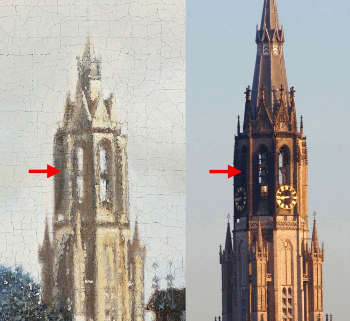
Scientist attempts to refine dating of Vermeer’s View of Delft
Dating Vermeer’s View of Delft
in Sky & Telescope (25–20)
Donald Olson, Regents Professor Emeritus
https://skyandtelescope.org/magazine_categories/sky-and-telescope-magazine/
Known as the "celestial sleuth" for his work in so-called "forensic astronomy," Donald Olson, an astronomer at Texas State University, and a few colleagues, were able to determine the precise time of day that Life magazine photographer Alfred Eisenstaedt took iconic photograph: a sailor and a woman in a white nurse's uniform kissing in the young lady. More recently Olson turned his attention to Vermeer's View of Delft. After lengthy investigation which entailed making precise measurements of the painting's architectural features, traveling to Delft to make on-site measurements, including topographical surveys and taking photographs roughly in line with what would have been Vermeer's viewpoint, he claims that he ia able to give a more accurate date of the painting. He states "If Vermeer intended to portray a morning scene consistent with the time shown by the clock in the painting, then the combined evidence—the hour hand of the Schiedam Gate clock, the empty bell tower, and the Sun’s position in the sky—indicates that the painting dates from 1659 or an earlier year and matches the view that the artist could have observed from his window at the inn at 8:00 a.m. on a date near September." Although Olson grants the painting could have taken weeks, months or even years to paint, he maintains that "the remarkably accurate depiction of the distinctive and fleeting pattern of light and shadows on the Nieuwe Kerk suggests that at least this detail was inspired by direct observation of the sunlit tower rising above the wall and roofs of Delft."
review:
https://phys.org/news/2020-07-celestial-sleuth-vermeer-masterpiece-view.html

Vermeer's The Concert to be recovered?
https://www.bbc.co.uk/iplayer/episode/m000nnzl/the-billion-dollar-art-hunt
On October 19, the BBC Four broadcast a documentary called The Billion Dollar Art Hunt.
As most of us will remember, on 18 March 1990, $1bn-worth of paintings were stolen from the walls of Boston’s Isabella Stewart Gardner Museum including Vermeer's The Concert. 29 years later, journalist John Wilson received a tipoff that the works WERE ABOUT TO BE RECOVERED—not in Boston, as the FBI had assumed, but in west Dublin.
Wilson’s source is Charley Hill, a former detective in the Metropolitan Police Art Squad with a record of recovering famous paintings estimated at $100 million, including Munch’s The Scream and a Vermeer stolen from an Irish stately home. Hill, works privately now but is convinced that his intelligence about the Boston art theft is solid. A notorious Dublin gangster, Martin "The Viper " Foley, who was cultivated by Hill for years says he knows where the art can be found and wants to claim the $10 million reward. Foley is currently on he run but is 99% sure of the painting’s location.
The documentary recounts Wilson’s investigative journey into the hidden economy.
See:
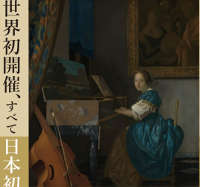
Vermeer's A Lady Seated at a Virginals travels to Japan (Tokyo-Osaka) and Australia (Canberra) in 2020/2021 
Masterpieces from the National Gallery
June 18–October 18, 2020
Kufu Company Inc., on long-term loan to the National Museum of Western Art, Tokyo
https://www.nmwa.go.jp/jp/exhibitions/pdf/2020london_gallery_new.pdf
Masterpieces from the National Gallery, London is a largest exhibition ever drawn from the collection of the National Gallery, London. It will include a total of 61 never-before-shown works. Viewers can look forward to world-renowned masterpieces such as Vermeer's A Lady Seated at a Virginal and Vincent van Gogh's, Sunflowers (1888). Originally scheduled to open on 3rd March, the exhibition will begin its four-month stint at the National Museum of Western Art, Tokyo on 18th June, followed by two other venues.
second venue:
National Museum of Art, Osaka
November 3, 2020–January 31, 2021
third venue:
Botticelli to Van Gogh: Masterpieces from the National Gallery
March 5–June 14, 2021
National Gallery of Australia, Canberra
https://nga.gov.au/exhibitions/botticelli-to-van-gogh/

Critical review of Tim Jenison's claim that Vermeer used a hitherto unknown optical apparatus to create his paintings
Did Tim Paint a Vermeer?
by David G. Stork, Christopher W. Tyler, and Sara J. Schechner
![]()
Tim’s Vermeer is a 2013 documentary feature-film following engineer and self-described non-artist Tim Jenison’s extensive efforts to "paint a Vermeer," (The Music Lesson) by means of a novel optical telescope and mirror-comparator procedure. In this article David Stork, Christopher Tyler and Sara Schechner examine Jenison’s proposed telescope optics in historical perspective, the difficulty and efficacy of the mirror comparator procedure and the particular visual evidence adduced in support of the comparator hypothesis. The authors contend some of Jenison key claims, including that the luminescence gradient along the rear wall of Vermeer's painting was impossible to achieve without the use of an optical instrument, as well as the fact that a slight bowing of a few straight lines of the virginals can be explained without the use of a mirror, which is part of Jenison's device. The study emphasizes not only that Jenison's apparatus would have been one of the most complicated optical systems of its time, but that it has thus far been proven particularly difficult to operate in a practical studio setting.
(Accepted for publication)
David G. Stork — scientist and author, who has made contributions to machine learning, pattern recognition, computer vision, artificial intelligence, computational optics, image analysis of fine art, and related fields.
Christopher W. Tyler — Head, Smith-Kettlewell Brain Imaging Center, Smith-Kettlewell Eye Research Institute
Sara J. Schechner — David P. Wheatland Curator Collection of Historical Scientific Instruments, Harvard University
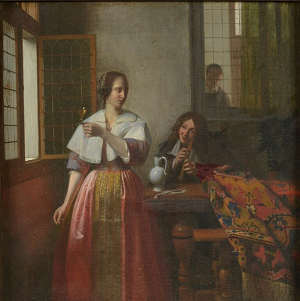
Presentation of a hitherto unknown seventeenth-century Dutch painting 
About Johannes Vermeer: A Case Study
June 17–July 17, 2020
Keizerskapel, Keizerstraat 21-23, B-2000 Antwerp, Belgium
The CODART website has just released the announcement of an upcoming presentation called "About Johannes Vermeer: A Case Study." Dr. Jean-Pierre Désiré De Bruyn will present a previously unknown Dutch painting entitled A Young Woman with Wine Glass and Musician Playing a Tenor Recorder (oil on canvas, 47 x 47 cm.) at the Keizerskapel, in Antwerp from June 17 to July 17, 2020.
While stopping short of attributing the painting directly to Vermeer, De Bruyn draws a number of analogies to his authentic works claiming that among the painting's Vermeer ingredients are the background chair with lion-head finials, the gray-wall, the carpet (see that of Vermeer's The Music Lesson), the white faience jug with a silver cap and lady's dress (almost identical to that of Vermeer's The Glass of Wine). He further writes that although "further comparisons can be made with works by Pieter de Hooch, Gabriel Metsu... it seems justifiable that our painting refers to an unknown composition by Johannes Vermeer, dating from the beginning of the 1660's."
:
About Johannes Vermeer: A Case Study: Keizerskapel, Antwerp CODART
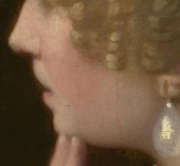
Latest results of the technical study of Vermeer's Mistress and Maid
Johannes Vermeer’s 'Mistress and Maid': New Discoveries Cast Light on Changes to the Composition and the Discoloration of Some Paint Passages
by Dorothy Mahon, Silvia A. Centeno, Margaret Iacono, Federico Carό, Heike Stege & Andrea Obermeier
https://heritagesciencejournal.springeropen.com/articles/10.1186/s40494-020-00375-2
Since the nineteenth century, with the growth in the number of studies focusing on Vermeer’s paintings, critics and scholars have struggled to understand the visual peculiarities presented by Mistress and Maid. Recent advances in imaging techniques coupled with the improvement in the sensitivity of microanalytical methods have allowed a team of specialists to address the long-standing questions as well as to resolve some persistent misunderstandings. Among the discovers made while examining this unusually large-scale composition are that a tapestry or painting with multiple figures originally filled up background and that previous speculation that the painting was left in an unfinished state can be definitively put to rest. Discoveries pertaining to a few of the work's original color, which have degraded after the painting left the artist's easel, are also reported.
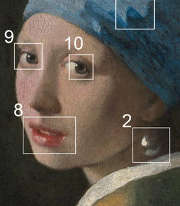
Latest results of the technical study of Vermeer's Girl with a Pearl Earring
The Girl in the Spotlight: Vermeer at Work, his Materials and Techniques in Girl with a Pearl Earring
Abbie Vandivere, Jørgen Wadum & Emilien Leonhardt
Heritage Science volume 8, Article number: 20 (2020)
https://heritagesciencejournal.springeropen.com/articles/10.1186/s40494-020-0359-6
The 2018 technical examination project The Girl in the Spotlight aimed to characterize the materials and techniques that Johannes Vermeer used to paint Girl with a Pearl Earring. Five research questions guided the micro- and macro-scale analyses: What can we find out about layers beneath the surface? What steps did Vermeer take to create the painting? Which materials did Vermeer use and where did they come from? Which techniques did Vermeer use to create subtle optical effects? What did the painting look like originally, and how has it changed? This paper concludes the special issue of Heritage Science by summarizing the results and putting them in an art-historical and materials history context.
Six new technical investigations of Vermeer's Girl with a Pearl Earring
The Girl in the Spotlight: A technical re-examination of Vermeer's Girl with a Pearl Earring
edited by Abbie Vandivere (Mauritshuis, The Hague)
https://www.springeropen.com/collections/gits
In 2018, Johannes Vermeer's Girl with a Pearl Earring underwent a technical examination within the research project The Girl in the Spotlight. The painting was examined in front of the museum public with state-of-the-art non-invasive imaging techniques. Samples taken during the 1990s were re-analysed. The goal was to document the current condition of the painting, and to find out more about the materials, techniques that Vermeer used to create this masterpiece. This special collection of articles in Heritage Science is devoted to the results of the technical examination.
The research project The Girl in the Spotlight is a Mauritshuis initiative and involves a team of internationally recognized specialists associated with the Netherlands Institute for Conservation+Art+Science+ (NICAS)+, and scientists from the University of Antwerp, Belgium, and the National Gallery of Art, Washington DC, USA. It has thus far yielded seven technical reports, which are listed below.
1.
Mapping the pigment distribution of Vermeer's Girl with a Pearl Earring
As part of the 2018 Girl in the Spotlight project, reflectance and molecular fluorescence imaging spectroscopy (RIS, FIS), and macroscale X-ray fluorescence scanning (MA-XRF) were performed on Johannes Vermeer's...
authors: John K. Delaney, Kathryn A. Dooley, Annelies van Loon and Abbie Vandivere
2.
Beauty is skin deep: the skin tones of Vermeer's Girl with a Pearl Earring
The soft modeling of the skin tones in Vermeer's Girl with a Pearl Earring has been remarked upon by art historians, and is their main argument to date this painting to c. 1665. This paper describe...
authors: Annelies van Loon, Abbie Vandivere, John K. Delaney, Kathryn A. Dooley, Steven De Meyer, Frederik Vanmeert, Victor Gonzalez, Koen Janssens, Emilien Leonhardt, Ralph Haswell, Suzan de Groot, Paolo D'Imporzano and Gareth R. Davies
3.
Comparison of three 3D scanning techniques for paintings, as applied to Vermeer's Girl with a Pearl Earring
A seventeenth-century canvas painting is usually comprised of varnish and (translucent) paint layers on a substrate. A viewer's perception of a work of art can be affected by changes in and damages to these...
authors: Willemijn S. Elkhuizen, Tom W. J. Callewaert, Emilien Leonhardt, Abbie Vandivere, Yu Song, Sylvia C. Pont, Jo M. P. Geraedts and Joris Dik
4.
Fading into the background: the dark space surrounding Vermeer's Girl with a Pearl Earring
The background of Vermeer'’s Girl with a Pearl Earring has, until recently, been interpreted as a flat dark space. The painting was examined in 2018 as part of the research project The Girl.
authors: Abbie Vandivere, Annelies van Loon, Tom Callewaert, Ralph Haswell, Art Ness Proaño Gaibor, Henk van Keulen, Emilien Leonhardt and Joris Dik
5.
Imaging secondary reaction products at the surface of Vermeer's Girl with the Pearl Earring by means of macroscopic X-ray powder diffraction scanning
The use of non-invasive macroscopic imaging techniques is becoming more prevalent in the field of cultural heritage, especially to avoid invasive procedures that damage valuable artworks. For this purpose, and…
authors: Steven De Meyer, Frederik Vanmeert, Rani Vertongen, Annelies van Loon, Victor Gonzalez, Geert van der Snickt, Abbie Vandivere and Koen Janssens
6.
Revealing the painterly technique beneath the surface of Vermeer's Girl with a Pearl Earring using macro- and microscale imaging
The initial steps that Johannes Vermeer took to create Girl with a Pearl Earring are, partially or completely, hidden beneath the painted surface. Vermeer’s painting technique involved applying underlay...
authors: Abbie Vandivere, Annelies van Loon, Kathryn A. Dooley, Ralph Haswell, Robert G. Erdmann, Emilien Leonhardt and John K. Delaney
7.
From "Vermeer Illuminated" to "The Girl in the Spotlight": approaches and methodologies for the scientific (re-)examination of Vermeer's Girl with a Pearl Earring
Girl with a Pearl Earring by Johannes Vermeer is the most beloved painting in the collection of the Mauritshuis in The Hague, The Netherlands. The Girl was last examined during a 1994 restoration.
authors: Abbie Vandivere, Jørgen Wadum, Klaas Jan van den Berg and Annelies van Loon

The origins of Vermeer's Glass of Wine and the Girl with a Wineglass: a new hypothesis
Click here to access the article.
In a recent paper, Huib Zuidervaart, of the History of Science Department of the Huygens Institute for the History of the Netherlands, has advanced an interesting theory on the origin of Vermeer's Glass of Wine and The Girl with a Wine Glass. Zuidervaart asserts that the two works, which represent an open window that features an identical coat of arms, were commissioned as wedding presents for two of the grandchildren of Moijses van Nederveen and Janetge de Vogel. Moijses van Nederveen came from of a prominent Delft family which was one of the four local producers of gunpowder, delivered to the Dutch army. Although historians had previously identified the families to which the coat or arms belonged—the heraldic emblem is a combination of those belonging to the Van Nederveen and De Vogel families—no one had as of yet explained why Vermeer would have chose to include such a conspicuous elements into two ambitious compositions. Zuidervaart points out that dates given to both paintings by Vermeer experts coincide with the dates of the weddings in question. Moreover, the symbolic implications of the coat of arms (figure of female virtue holding a crest) would appear in agreement with the idea as a wedding gift as well as being consistent with the background of Vermeer's presumed clients. Given that both paintings present not only the same window but the same set of ceramic tiles, which Vermeer never painted again, it is also possible that the Delft master executed both works on the premises of the Van Nederveen/De Vogel residence in Delft.
Mr. Zuidervaart's paper, "Een nieuwe theorie over twee schilderijen van Johannes Vermeer (1632–1675)" published in Jaarboek Delfia Batavorum 28 (2018). He has kindly permitted Essemtial Vermeer to publish an English translation of it accessible by clicking here.
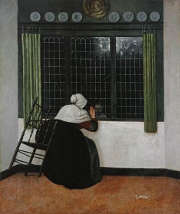
Upcoming exhibiton of idiosyncratic Dutch painter
Who was Jacobus Vrel? Looking for clues of an enigmatic painter (Postponed to 2021)
Alte Pinakothek, Munich
from the CODART website:
His pictures are idiosyncratic, his figures odd and his street scenes stage-like. The works of Jacobus Vrel have frequently been mistaken for those by Johannes Vermeer. His street scenes and interiors are included in the holdings of the best-known museums in the world and are, at the same time, much sought-after rarities among collectors. However, to this day, Jacobus Vrel has remained virtually unknown—and, despite extensive archival research work since his discovery in the 19th century, it has not been possible to find any details about his person or where he worked.
Jacobus Vrel's works seemingly reflect everyday life in a small Dutch town in the 17th century while creating enigmatic worlds at the same time in which the viewer is not addressed in any way at all. The figures turn away from us, show only their backs or appear lost in thought. The depictions even exude, in part, an oppressive stillness. Not without reason a close affinity to the well-known Dane Vilhelm Hammershøi (1864–1916) has repeatedly been construed, whose atmospheric compositions, however, were created two centuries later.
Equally unusual are Vrel's street scenes. The spatial arrangement of the buildings shown is reminiscent of film or theatre sets. It is difficult to find comparable examples from the painter's own time. There are neither plausible paradigms nor are there any clear similarities to the works of better-known fellow artists. Always in vertical format, the compositions show multi-storeyed but slender brick houses, mostly with pointed gabled roofs, lined up close to one another. Only a few figures populate the narrow alleyways paved with cobblestones. Are these real places that Vrel has rendered here or are they the painter's invention, bearing no semblance to his immediate surroundings?
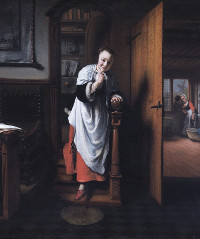
Exhibit on dedicated to Vermeer' contemporary 
Nicolaes Maes: Dutch Master of the Golden Age
February 22 –May, 31 2020
https://www.nationalgallery.org.uk/exhibitions/nicolaes-maes-dutch-master-of-the-golden-age
Share a knowing look with mischievous eavesdroppers and peer behind the doors of 17th-century Dutch households...From illicit goings-on in servants’ quarters to portraits of high society, Nicolaes Maes captured life upstairs and downstairs in the Dutch Golden Age.
Starting his career as one of Rembrandt’s most talented pupils, this exhibition – the first in the UK devoted to Maes – charts the artist’s rise to fame. Through nearly 50 paintings and drawings, it follows Maes’s move away from paintings of historical and biblical scenes, where Rembrandt’s influence is most clear, to the scenes of everyday life and portraits that made him one of the most sought-after artists of his time. Maes was an astute businessman, and produced over 900 portraits, adapting his style to reflect the high fashion and decoration of the second half of the 17th century. But it is his ‘genre’ scenes – which often feature the central character eavesdropping and breaking the fourth wall to interact directly with the viewer – which best reveal Maes’s inventive and distinct style.
Exhibition organized by the National Gallery, London and the Mauritshuis, The Hague.
admission: free
location: Ground Floor Galleries
related events
Portraiture
Saturday, 22 February 2020 | 11 am - 1 pm (tickets necessary)
What can paintings and possessions tell us about self-presentation in 17th-century Holland? Thousands of 17th-century portraits by Dutch artists of Dutch sitters survive today. They give us enormous insight into the period, not just from what we see, but also what we don’t see. From portraits of the wealthy and the conscientious to children and young people aspiring to adulthood, we discuss what Maes’s portraits tell us about how his sitters wished to be seen.
Paintings of everyday life
Saturday, 29 February 2020 | 11 am - 1 pm (tickets necessary)
What can Dutch genre paintings tell us about morality within and beyond the home? Dutch scenes of interiors tell us a great deal about Dutch values. They tell us about the importance of the role of the mother, the well-ordered household, and the attention that should be paid to religious matters. The largely female cast of characters in these paintings also presents us with a number of Dutch society stereotypes and gives an insight into Dutch ideals of good behavior, if not always the reality.
Success and failure
Saturday, 7 March 2020 | 11 am - 1 pm (tickets necessary)
What were the career prospects for an artist in the competitive art world of 17th-century Holland? In this session, we consider the drivers for success in the changing decades of the 17th century. Why did some artists thrive but others like Vermeer, Hals and Rembrandt end up bankrupt? We will explore workshop arrangements and the relationship of masters and pupils in Rembrandt’s circle. And we will also consider why artists like Peter Lely, Gerrit van Honthorst and Mathias Stom moved abroad, taking their Dutch style with them. To what extent did they alter their practice to fit in outside of Holland?
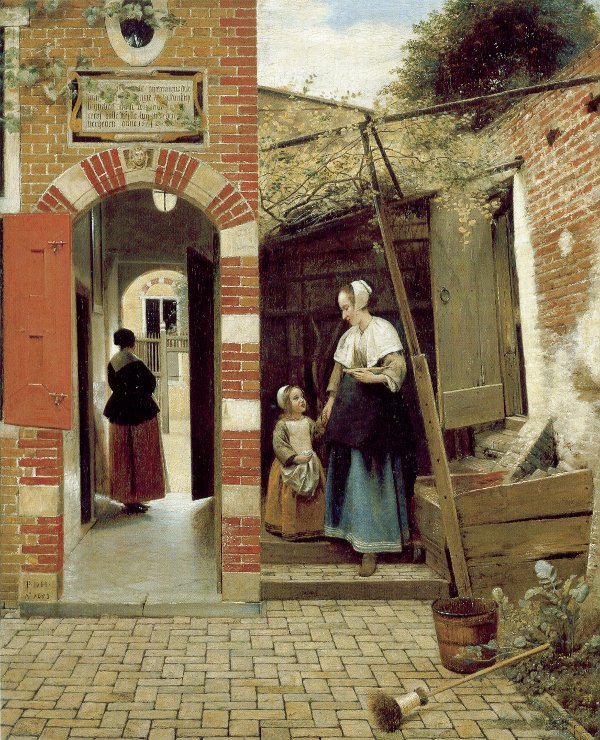
Pieter de Hooch in Delft: From the Shadow of Vermeer 
11 October 2019–16 February 2020
Museum Prinsenh - Delft
T +31 (0)15 260 23 58
https://prinsenhof-delft.nl/pieterdehooch/?lang=en
The exhibition is the first retrospective of the artist’s work in his own country. After Vermeer, Pieter de Hooch is widely considered to be the most celebrated Delft master of the 17th century. The paintings De Hooch produced in Delft (c. 1652–1660) will be at the heart of the exhibition: his most beautiful courtyards and interiors will return to the city where they were painted almost 400 years ago.
29 works will be coming to Delft on loan from leading museums in Europe and the United States. These include many famous paintings never before exhibited in the Netherlands such as the well-known Courtyard of a House in Delft from the National Gallery, London. Other Pieter de Hooch masterpieces will come from Museo Thyssen-Bornemisza, Madrid, the Kunsthaus Zürich and the National Gallery of Art in Washington. An extraordinary work on loan from the Royal Collection of Her Majesty Queen Elizabeth II is the masterpiece Cardplayers in a Sunlit Room. In addition, the exhibition will comprise works on loan from the Mauritshuis, the Museum Boijmans van Beuningen, the Amsterdam Museum and of course the Rijksmuseum, which holds one of the largest collections of De Hoochs in the world.

Restoration of Vermeer's Girl Reading a Letter at an Open Window reveals spectacular surprise
An x-ray photograph taken decades ago revealed that behind the solitary female figure in Vermeer's Girl Reading a Letter by an Open Window the artist had originally incorporated a large ebony-framed "painting-within-a-painting" of a pot-belied Cupid. It was believed that the artist himself, unsatisfied with the results, presumably painted out the picture in order to nuance the painting's iconographic significance and/or improve the composition equilibrium.
However, the ongoing investigation and restoration of the painting Dresden Gemäldegalerie Alte Meister has been proven that the overpainting was not done by Vermeer himself but, unexpectedly, by a different hand some years after the completion of the work. It has not yet been possible to identify who or what point after the painting left Vermeer's studio time the alteration was performed, although Uta Neidhardt, the senior conservator at Dresden’s Gemäldegalerie, told The Art Newspaper:
There was even a layer of dirt above the original varnish on the Cupid, showing the painting had been in its original state for decades. [. . .] This is the most sensational experience of my career [. . .] It makes it a different painting.
In conformance with the new findings, the Gemäldegalerie decided to remove the layer of gray paint which obsures such a major background element and thus restore it the artist's original intention.
For a short period of about 5 weeks the painting can now be enjoyed in a special studio presentation at the Gemäldegalerie, from May 8 to June 16.
The restoration is taking place in the paintings conservation department at the Staatliche Kunstsammlungen Dresden and is being performed by paintings conservator Dr. Christoph Schölzel. Accompanying the restoration is a research project about the painting, carried out in cooperation with the archaeometry laboratory at the Hochschule für Bildende Künste Dresden, the Doerner-Institut at the Bayerische Staatsgemäldesammlungen München, the Rijksmuseum Amsterdam and The National Gallery in London.
Time-lapse video of resoration process
At the outset of the restoration, a symposium was held in March 2017 with specialists from Amsterdam, Copenhagen, Vienna and Dresden, who have investigated and restored works by Vermeer in the past years. They were invited by the Dresden Gemäldegalerie and will continue to accompany the conservation project and provide their professional input.
After completing the restoration of Vermeer’s Girl Reading a Letter at an Open Window, the painting is scheduled to be shown again to the visitors from March, 2020.
Video presenatation of the restoration
For videos, further information and images regarding on the restoration of the painting, visit the Gemäldegalerie dedicated webpage.

Nicolaes Maes - Rembrandt’s Versatile Pupil 
Mauritshuis, The Hague
17 October 2019–19 January 2020
Concluding the Rembrandt & the Golden Age year the Mauritshuis will stage the first international retrospective exhibition about one of Rembrandt's most talented students, Nicolaes Maes.
With his original representations of everyday life, Nicolaes Maes was one of the most innovative painters of the Dutch Golden Age. His domestic scenes have been a source of inspiration for painters such as Pieter de Hooch and Johannes Vermeer. In his lifelike representation of emotions, Maes shows himself to be a fully fledged student of Rembrandt.
Maes began his career by painting Biblical stories, in which the influence of his teacher is clearly visible. Rembrandt was a dedicated teacher who challenged his pupils to be inventive and come up with new things. Maes was inspired by his teacher, but at the same time always looked for his own, new solutions. This can be clearly seen in The Sacrifice of Isaac (c. 1653). Maes gave this Biblical theme an explosive charge.
In the following years, Maes painted intimate scenes with women engaged in their household duties. The eavesdroppers are a favourite; representations of how the lady of the house catches her maid with a lover. Roguishly and conspiratorially, the woman looks at us; with her finger on her lips she draws the attention of the viewer and calls for silence. Some beautiful "eavesdroppers" will be on loan from the Dordrechts Museum, the Guildhall Art Gallery and the Wellington Museum (both London).
The second venue of the exhibition wil be held at the National Gallery, London,
22 February – 31 May 2020.

Exploring the Physical and Psychological Realities in Vermeer’s Genre Paintings 
Lecture by Arthur K. Wheelock Jr.
Wallace Collection, London
November 11, 2019 (17:00–18:30)
Vermeer's genre paintings depict men and women engaged in daily activities that seem familiar and related to our own lives. We greatly admire his ability to depict the physical reality of these scenes, whether through the shimmer of satin, the translucency of glass, or his mastery of light. Less noticed, however, is how successfully he conveyed the inner life of his figures. This talk by Arthur Wheelock will examine this important aspect of Vermeer's artistic genius by examining the types of moments he portrayed, and the relationships of his figures to their milieu.
Arthur K. Wheelock Jr. is Senior Advisor to The Leiden Collection. He recently retired as curator of Northern Baroque painting at the National Gallery of Art in Washington, D.C., and as Professor of Art History at the University of Maryland. During his tenure at the National Gallery from 1975 to 2018, Wheelock oversaw a significant expansion of the Gallery’s collection of Dutch and Flemish paintings and organized a number of major exhibitions.
evening lecture general admission £15
evening lecture concession £13
for tickets and information, see:
https://www.wallacecollection.org/whats-on/exploring-the-physical-and-psychological-realities-in-vermeers-genre-paintings/
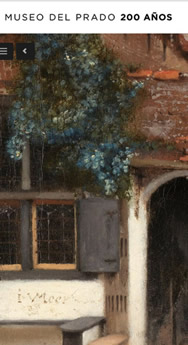
Upcoming Vermeer exhibition in Madrid
Velázquez, Rembrandt, Vermeer. Parallel Visions
Museo del Prado, Madrid
June 2-August 29, 2019
Velázquez, Rembrandt, Vermeer. Parallel visions is the result of an extensive and important research project on the part of the Museum arising from a collaborative agreement with the Rijksmuseum in Amsterdam, which will be lending a significant group of works, in which ties between late 16th- and early 17th-century Dutch and Spanish painting will be investigated.
The exhibition will offer a reflection on the pictorial traditions represented by Spain and the Low Countries. While the art-historical literature, particularly that generated in Holland, has considered these traditions as essentially different, this exhibition will aim to juxtapose the historical myths and artistic realities of the two countries and to reflect on the numerous traits that they share.
curator:
Alejandro Vergara,
Museo del Prado Senior Curator Flemish Painting and Northern Schools (to 1700).
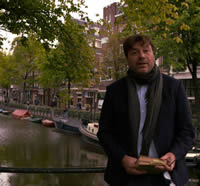
New four-part Vermeer TV series 
Silenzi di Vermeer (The Silences of Vermeer), in four episodes
author: Tomaso Montanari
director: Luca Criscenti
director of photography: Francesco Lo Gullo
editor: Emanuele Redondi and Anjan Di Leonardo
music: Giorgio Giampà
language: Italian
produced by: Land Comunicazioni
On January 11, (9:15 P.M), Rai5, the Italian public cultural TV channel, will broadcast the fourth and final episode of the four-part series, I Silenzi di Vermeer (Vermeer's Silences).
The series' author, the Italian art historian, academic and newspaper columnist Tomaso Montanari, is well known to the Italian public for his brilliant multi-episode TV series on Caravaggio and Bernini (see information below).
Guided along voyages throughout America and Europe to rediscover Vermeer and his surviving 36 canvases, the spectator is awarded a number of surprisingly fresh insights into the artist's seemingly faceless art by means of an exacting but intuitive reading of the thematic content and composition of each work, while simultaneously fleshing out the circumstances in which the artist lived and painted. To enrich the viewer's parallel voyage, the narrative is peppered with lesser-known but evocative experiences of the collectors, art historians, writers and painters who, like Montanari himself, have endeavored to sound the silent depths of Vermeer's art.
I Silenzi di Vermeer confirms Montanari's aptitude as a narrator as well as his commitment to divulging the works of the great artists of the past. Drawing force from an unmediated participation and complete command of historical material, he is able to arouse intellectual inquiry and transmit the essential poetry of a work of art even to the neophyte, in effect, transporting him back in time to the moment of its creation. Perhaps the only shortcoming of the series, at least for the moment, is that it is accessible only to those familiar with Italian.
All four episodes will be accessible online at a date to be announced.
broadcasting schedule:
December 21, 2018 | La poesia di ogni giorno (The Poetry of Everday Life)
December 28, 18 | Il dentro e il fuori (The Inside and the Outside)
January 4, 2019 | Cartografia d’amore (The Cartography of Love)
January 11, 2019 | Con altri sensi (With Other Senses)
Highly recommended for those who speak Italian, are Montanari's:
La Vera Natura di Carvaggio (The True Nature of Caravaggio; 12 episodes; Land Comunicazioni)
accessible at:
https://www.raiplay.it/programmi/laveranaturadicaravaggio/
La Liberta' di Bernini (The Freedom of Bernini; 8 episodes; Land Comunicazioni)
accessible at:
http://www.landcomunicazioni.it/it/sul-sito-della-rai-la-sesta-puntata-de-la-liberta-di-bernini/
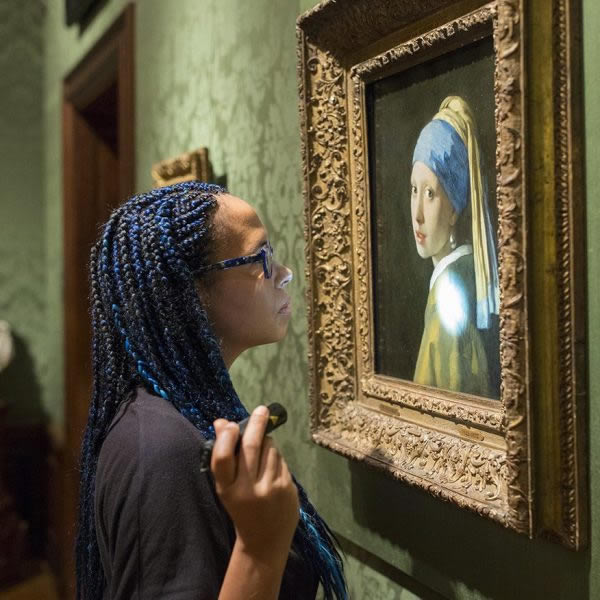
Abbie Vandivere lectures in Stockholm and London 
The Girl in the Spotlight: A Technical Examination of Vermeer’s Girl with a Pearl Earring
Stockholm University, Department of Culture and Aesthetics, Stockholm, Sweden
January 28, 2019 (4.00 p.m.–5.00 p.m.)
The Auditorium, Manne Siegbahn Building, Frescativägen 24E
by Dr. Abbie Vandivere (Mauritshuis)
Dr. Abbie Vandivere will give a lecture about the recent technical examination of Johannes Vermeer’s Girl with a Pearl Earring, the most beloved painting in the collection of the Mauritshuis.
The painting was last examined in 1994, during a conservation treatment. Although further restoration was not required, major advances in non-invasive technical analysis have been made over the last 25 years making it possible to learn more about how Vermeer painted his most iconic work, as well as the materials that he used.
Earlier this year, the painting was the subject of an in-depth scientific examination project: The Girl in the Spotlight. The technical examination was conducted over a two-week period in front of the museum public. An international team of experts used the latest scientific technology to examine the Girl, including: macro x-ray fluorescence scanning, near-infrared imaging, optical coherence tomography, 3D digital microscopy, macro-x-ray powder diffraction, colour/gloss/topography scanning, and the re-examination of paint samples taken 1994. For more information see Vandiver's informative blog dedicated to the project; Girl with a Blog.
Click here for lecture website page.
second venue:
The Courtauld Institute of Art, Vernon Square, London
Monday, February 25, 2019 (6:00 p.m.–7:00 p.m.)
The lecture is free, but booking is required:
https://courtauld.ac.uk/event/the-girl-in-the-spotlight-a-technical-examination-of-vermeers-girl-with-a-pearl-earring
Dr. Abbie Vandivere is a Paintings Conservator at the Mauritshuis, and the Head Researcher for the project The Girl in the Spotlight. She also coordinates the Technical Art History MA programme at the University of Amsterdam. She received her PhD in 2013: "From the Ground Up: Surface and Sub-surface effects in Early Netherlandish Paintings." Before this, she received her postgraduate diploma in Paintings Conservation from the Courtauld Institute in London, and BA from Princeton University.
Vermeer goes to Abu Dhabi 
Rembrandt, Vermeer and the Dutch Golden Age Masterpieces from the Leiden Collection and the Musee du Louvre
Louvre Abu Dhabi (Saadiyat Cultural District Abu Dhabi, United Arab Emirates)
February 14–May 18, 2019
This exhibition presents ninety-five objects, drawn largely from The Leiden Collection, with works from the Musée du Louvre, the Louvre Abu Dhabi, the Bibliothèque Nationale de France and the Rijksmuseum. It highlights the artistic cross referencing that occurred in the Netherlands during the seventeenth century. Among the works on display are Rembrandt's Self-Portrait with Shaded Eyes and Minerva in Her Study and Vermeer's The Lacemaker. Also exhibited in the Young Woman Seated at a Virginal, from the Leiden Collection. Other artworks from The Leiden Collection include those of Rembrandt's teacher Pieter Lastman, his friend and rival Jan Lievens, and his pupils Ferdinand Bol, Carel Fabritius and Arent de Gelder.
hours:
Saturday, Sunday, Tuesday, Wednesday: 10:00 a.m.–8:00 p.m.
Thursday, Friday: 10:00 a.m.–10:00 p.m., closed: Monday
ticket:
63 AED; 31.5 AED for ages 13-22
Nine Vermeer paintings in a major Dutch art exhibition in Japan 
Making the Difference: Vermeer and The Dutch Art
Ueno Royal Museum, Tokyo
October 5, 2018–February 3, 2019
Following a consolidated trend by organizers to tout the number of Vermeer paintings in their exhibitions, the Ueno Royal Museum boasts 9 out of 36 Vermeers have been brought to Japan, making it the largest showing of his work in the country. One of the exhibit'sv highlights is The Wine Glass, loaned from the Gemäldegalerie in Berlin, one of a handful of paintings by Vermeer that rarely travels. Other paintings from museums in Europe and the U.S. include Christ in the House of Martha and Maria, The Procuress, The Milkmaid, Woman with a Lute, A Lady Writing, Girl with a Red Hat, Woman with a Pearl Necklace and Woman Writing a Letter with her Maid.
An illustrated catalogue featuring all 49 works including the 10 Vermeer exhibited between the Tokyo and Osaka exhibitions will be available for purchase.
Each day, tickets are designated into six entry windows. After entrance visitors may remain in the exhibition for an unlimited time.
dedicated website:
https://www.vermeer.jp/
special exhibition features:
https://www.vermeer.jp/special/
the second venue will be held at Osaka :
Making the Difference: Vermeer and The Dutch Art
Museum of Fine Arts of Osaka
February 16, 2019–May 12, 2019
The exhibit will differ from the Tokyo venue and will feature six paintings by Vermeer: Christ in the House of Martha and Mary, The Procuress, A Lady Writing, Woman with a Lute, The Love Letter and A Lady Writing a Letter with her Maid.
New location proposed for Vermeer's house
In his article Johannes Vermeer and his Neighbors (2017), Hans Slager tentatively supposed that what has been traditionally believed to be the location of Vermeer's house in Delft—Oude Langendijk/corner Molenpoort alley—may not be correct. Following additional investigation, Slager strengthened his case and has come to the conclusion that Vermeer's house was more likely located at the opposite (western) corner of the Molenpoort alley. In the past, this location had been dismissed for reasons that Slager now shows to be unfounded. In his new article, Vermeer's House Revisited, Slager details all of his arguments, which are supported by primary archival sources.
Essential Vermeer website addition
Vermeer and Perspective
Jonathan Janson
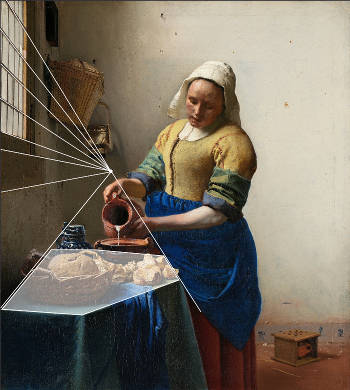
(perspective diagram showing octagonal gatleg table)
Johannes Vermeer
c. 1657–1661
Oil on canvas, 45.5 x 41 cm.
Rijksmuseum, Amsterdam
Soon after Pieter Teding van Berkhout, a young scion of a landed gentry family from The Hague, made a visit to Vermeer's studio in June 1669, he wrote in his diary, "I went to see a celebrated painter named Vermeer." But Van Berkhout understood Vermeer's paintings differently than we do today. He described them not as "allegories" or "scenes of daily life," much less "masterpieces of light" or "suspended moments in time" that "exude silence." Van Berkhout wrote that the most "extraordinary and curious aspect" of Vermeer's art consists in "perspective."
This new and richly illustrated two-part study is the most comprehensive examination thus far undertaken into Vermeer and linear perspective. The first part considers how Vermeer and his contemporaries could have acquired knowledge of linear perspective needed to create the sensation of foreshortening and spatial recession in their paintings. The methods considered include geometric construction, the drawing frame, the pin-and-string method and the camera obscura. Each of these four methods is first examined in its functionality and practicality, and then weighed against correlating evidence exhibited in Vermeer's paintings.
The second part examines the perspective armature of each of his paintings, reveling their strengths, weakness and anomalies.
Also included are perspective diagrams of each painting, a list of period perspective manuals—many of which can be downloaded integrally in PDF format—a glossary of perspective terms as well as a list of writings focused on questions of Vermeer and perspective.
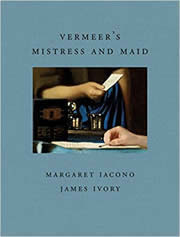
A new publication on Vermeer's Mistress and Maid 
Vermeer's Mistress and Maid (Frick Diptych)
by James Ivory and Margaret Iacono
Hardcover, 64 pages, London (D. Giles ltd.)
2018
This slim but richly illustrated publication is the second volume in the Frick Diptych Series, which pairs an essay by Margaret Iacono, the Frick’s Associate Research Curator, with a literary piece by Academy Award-winning film director, producer and screenwriter James Ivory.
Particularity fascinating for Vermeer devotees is Iacono's 36-page essay, which examines the picture from its inception to the complicated financial transactions which brought the Maid and Mistress— the third and last Vermeer—to the collection of the New York magnate Henry Clay Frick, who assembled one of the finest private art collections in the world. While the painting's authorship has rarely been questioned, its oversized figures, dark background and anomalous execution have been a source of considerable debate. Iacono weighs the various sides and, after analyzing the work's theme and composition, provides the most insightful "picture" yet proposed of this luxurious but enigmatic canvas. She also discusses the recent technical examination of the picture performed by the Metropolitan Museum of Art conservation department which provides provisional—a full report is forthcoming—but exciting new evidence concerning work's compositional iter as well as its present condition, allowing us to gaze deeper into the artist's intentions and the picture-making process. Included is a revised provenance.
Margaret Iacono is associate research curator at The Frick Collection. Her areas of interest include northern European painting of the fifteenth to seventeenth centuries and the history of collecting. Most recently she organized Vermeer, Rembrandt and Hals: Masterpieces of Dutch Painting from the Mauritshuis (2014), and also served as the Frick coordinator for The Frick Collection: Art Treasures in New York, held at the Mauritshuis, The Hague (2015).
James Ivory is an American film director, producer and screenwriter. Films produced by his company Merchant Ivory Productions (producer Ismail Merchant and script writer Ruth Prawer Jhabvalar) won six Academy Awards. For his work onCall Me by Your Name (2017), which he wrote and produced, Ivory won awards for Best Adapted Screenplay from the Academy Awards, British Academy of Film and Television Arts, Writers Guild of America, the Critics' Choice Awards, and the Scripter Awards, among others.
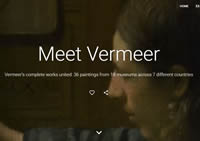
Google's new A Google Art Project addition 
Meet Vermeer
https://artsandculture.google.com/project/vermeer
In cooperation with 18 art institutions that house paintings by Vermeer, Google has launched a new monographic website called Meet Vermeer as a part of its Google Art Project website. The new project features an ample series of videos and richly illustrated introductory essays that address various aspects Vermeer's life and artistic afterlife, including the artist's technique, defining themes and critical reception. The project also vaunts a smartphone app called Pocket Gallery. Pocket Gallery transforms an iOS- or Android-based smartphone into an ultra-high resolution exhibition that brings the complete works of Vermeer into a single Augmented Reality museum, designed specifically for the project by Google and curated by art historians.
For the pleasure of the more discerning art lover or savvy art scholar, the California-based technical Goliath has turned its Art Camera—designed specifically for photographing works of art—on eight canvases by Vermeer creating the highest-ever resolution image ever made. In various works (e.g., The View of Delft, Girl with a Pearl Earring or The Geographer) the level of magnification is so astounding that we can question if greater magnification is any longer necessary, outside for purely conservational needs. The remaining works were photographed by the museums and collectors themselves and vary in resolution and color quality. The best high-resolution images include: Diana and her Companions, Christ in the House of Martha and Mary, The Milkmaid, The Little Street, The Glass of Wine, Girl with a Wineglass, The View of Delft, Woman in Blue Reading a Letter, Woman with a Pearl Necklace, A Lady Writing, The Geographer, The Girl with a Pearl Earring, The Love Letter, A Lady Standing at a Virginal and A Lady Seated at a Virginal. Both the newly photographed and museum images can been zoomed online, but they cannot be downloaded.
Meet Vermeer website:
https://artsandculture.google.com/project/vermeer
Meet Vermeer | 63 stories
https://artsandculture.google.com/search/exhibit?project=vermeer
High-resolution images can be accessed from:
https://artsandculture.google.com/search/asset?project=vermeer
Or go directly to the painting which interests you most:
Diana and her Companions
https://artsandculture.google.com/asset/-/CwHVjcoJyEyrtg?childAssetId=uAGPKfpdVrKXng
Christ in the House of Martha and Mary
https://artsandculture.google.com/asset/christ-in-the-house-of-martha-and-mary/qQFE84jjbAZMxw
The Milkmaid
https://artsandculture.google.com/asset/the-milkmaid/9AHrwZ3Av6Zhjg
Officer and Laughing Girl
https://artsandculture.google.com/asset/officer-and-laughing-girl/BAGeJEKy9TZJog
The Little Street
https://artsandculture.google.com/asset/the-little-street/YAGJRuPz8yVuRQ
The Glass of Wine
https://artsandculture.google.com/asset/the-glass-of-wine/_wGElyA8n9R8iQ
Girl with a Wineglass
https://artsandculture.google.com/asset/girl-with-a-wineglass/LgHXGzeiFPn9PQ
The View of Delft
https://artsandculture.google.com/asset/view-of-delft/CgGsQh01dnFdDQ
Woman in Blue Reading a Letter
https://artsandculture.google.com/asset/woman-reading-a-letter/QQF82wPVTRfMPw
Woman with a Pearl Necklace
https://artsandculture.google.com/asset/young-woman-with-a-pearl-necklace/kQFMVJh6zAXoxQ
Woman Holding a Balance
https://artsandculture.google.com/asset/woman-holding-a-balance/-wHFDKu7-mhjtQ
The Geographer
https://artsandculture.google.com/asset/the-geographer/xQFs38J6ShT4nA
The Girl with a Pearl Earring
https://artsandculture.google.com/asset/girl-with-a-pearl-earring/3QFHLJgXCmQm2Q
The Guitar Player
https://artsandculture.google.com/asset/the-guitar-player/TQGoRQoowsW0uQ
The Lacemaker
https://artsandculture.google.com/asset/the-lacemaker/KgFdRFKLfvwp8g
The Love Letter
https://artsandculture.google.com/asset/the-love-letter/fwEiDs-Dommm3g
A Lady Standing at a Virginal
https://artsandculture.google.com/asset/-/eAGR4D907yOWcw?childAssetId=LAHpXWgi2wozMw
A Lady Seated at a Virginal
https://artsandculture.google.com/asset/-/ZQERy3a51gsnrQ?childAssetId=OQFvovWu5HGuoQ

Essential Vermeer website addition
Vermeer on Stamps: the collection of Vitaliy Demin
http://www.essentialvermeer.com/misc/stamps/stamps-01.html
More than a thousand stamps currently in circulation are dedicated to the works of famous artists, such as Leonardo, Raphael, Michelangelo, Rubens, Rembrandt and Vermeer. It is almost impossible to collect all of them; one must pick and choose in order to assemble a thematically coherent collection. Vermeer, one of the most intriguing artists in history, is an ideal candidate for a small collection.
Vitaliy Demin has compiled a complete list of all the stamps with Vermeer's works that are currently circulation all over the world, which counts fewer than 200 items. On display in this EV web article are all the available items from Mr. Demin's collection except a few non-perforated varieties, which, however, will be added later.
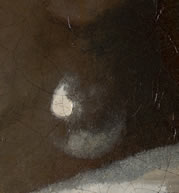
Girl with a Pearl Earring undergoes a technical examination, on public view at the Mauritshuis
The Girl in the Spotlight
Monday 26 February to Sunday 11 March, 2018
Mauritshuis, The Hague
Beginning Monday, February 26, Vermeer's iconic Girl with a Pearl Earring will undergo a two-week technical examination dubbed "The Girl in the Spotlight," at the Mauritshuis.
Although further restoration is not required at the moment, major advances in non-invasive technical analysis made over the last 25 years will allow the painting to be examined deeper than before. Using the latest technologies, such as fluorescent X-rays, optical coherence tomography and digital microscopy, experts hope to answer a number of unanswered questions about the materials and methods Vermeer used to paint Girl with a Pearl Earring. The project will take place 24 hours a day.
Visitors will be able to observe the progress of the examination through an especially built transparent enclosure in the museum's the Golden Room. The collection's two other Vermeer paintings, View of Delft and Diana and her Companions remain on view in room 15.
The project involves a team of internationally recognized specialists associated with the Netherlands Institute for Conservation, Art and Science (NICAS). The NICAS partners are Rijksmuseum Amsterdam, TU Delft, and Cultural Heritage Agency of the Netherlands (RCE)..
Girl with a Blog
As part of a multimedia presentation, Mauritshuis paintings conservator and head researcher Abbie Vandivere will be blogging and posting photos daily updates during the project.
click here to view the project program and here follow daily updates.
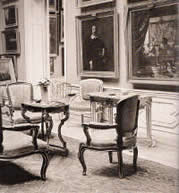
New study of the provenance of Vermeer's The Art of Painting
The Puzzle Solved? Notes on the Early Provenance of Vermeer's The Art of Painting
by Erik de Visser
The Puzzle Solved? Notes on the Early Provenance of Vermeer's The Art of Painting sets out in well-considered detail the high probability that Vermeer's masterpiece did indeed, as suspected by some scholars, come to Vienna in 1745 at the time that Gerard van Swieten (1700–1772) took up his position as Empress Maria Theresa's personal physician. In addition, the paper shows that the Dutch doctor could not have come into possession of this painting if, in the immediate years following Vermeer's death (1675), the artist's wife, Catharina Bolnes, and his mother-in-law, Maria Thins, had failed to keep Vermeer's masterpiece safe in Delft. As will be shown, a chain of events set in motion by Maria Thins resulted in the painting leaving the Vermeer family to eventually come into the ownership of two Van Swieten generations.
Detailed study of Vermeer's neighborhood with house-by-house database
Johannes Vermeer and his Neighbours (PDF)
by Hans G. Slager, independent researcher
Click here for the PDF.
It has been universally accepted that the mature Johannes Vermeer lived on Oude Langendijk in Delft, situated amidst the Catholic living quarter known as the Papist Corner. Following John Michael Montias 'Vermeer and His Milieu: A Web of Social History, published in 1989, however, no further research was conducted in regards to either the location of the artist's living quarters or the neighborhood in which he lived. Persuaded that a more accurate reconstruction of the Papist corner was possible, and that neighbors may influence the lives of its individual members, the independent researcher Hans Slager has examined afresh the circumstances of those who lived in the vicinity of Vermeer in the hopes of uncovering not only undiscovered information but clues for further research.
This new study of the Papist Corner investigates a wealth of housing and genealogical data in the light of house sales, taxation records, legal issues and other events, at times mundane, but nevertheless vital to the success of the reconstruction. Slager's analysis suggests that Vermeer's traditionally held residence on the Oude Langendijk may, in fact, be erroneous, and that his real residence may still physically exist.
Aside from the Papist neighborhood, other issues are addressed, such as the fate of the Mechelen inn, Van Ruijven's patronage and Van Leeuwenhoek's presumed friendship with Vermeer. Lastly, an analysis of the name linked to the two prominently pictured heraldic stems that appear on the two stained-glass windows in Vermeer's The Glass of Wine and The Girl with a Wine Glass reveals possible links to various Leiden fijnschilder painters. Ties between some of Vermeer's principal clients are also described in detail.
Necessarily, a study containing such a significant amount of data demands a selective rather than a story-telling approach so that all data is organized within a house-by-house scheme. Moreover, data is published in full in order to serve as a springboard for future investigation—there may still be more information on Vermeer, hopefully complimenting Montias' seminal study on Vermeer and his extended family.
Johannes Vermeer and his Neighbours may be read by art historians, Delft historians and Vermeer lay enthusiasts alike.
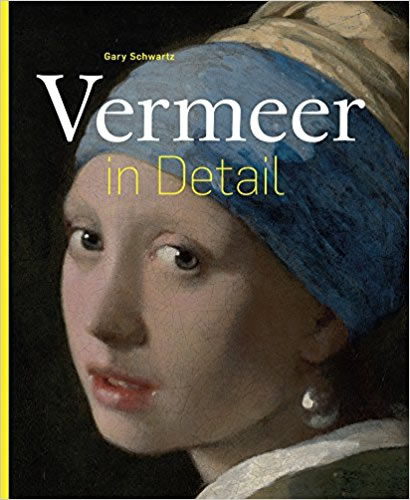
New in-detail Vermeer monograph by Gary Schwartz
Vermeer in Detail
by Gary Schwartz
March 2017
An excellent introduction to the art of Johannes Vermeer based on 120 large and lavish details from his work. Each is provided with refreshing commentary, covering subject matter, technique and modes of picture-making, the origins of the objects he paints, comparisons of motifs, scholarly discussion concerning his work and more.
Concise entries and illustrations of the 37 paintings currently given to Vermeer, including the disputed attributions. Preceded by a capsule biography.
Purchase of the volume provides the buyer with exclusive access to a website with high-resolution images of the complete paintings.
price:
€39.90
languages:
Dutch (Ludion, Antwerp), French (Hazan, Paris) and English (UK: Thames & Hudson, London - US: Abrams, New York)
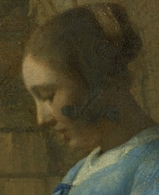
Vermeer's Woman in Blue Reading a Letter visits Munich
Alte Pinakothek, Munich
July 3–September 30, 2018
For the reopening of the modernized exhibition spaces of the Alte Pinakothek Munich audiences will have the unique opportunity to see first-hand the world-famous Woman in Blue Reading a Letter' by the Vermeer, on loan from the Gallery of Honour in the Rijksmuseum in Amsterdam. This masterpiece of the Dutch Golden Age—without a doubt one of the best known and most beautiful works by the painter from Delftenters into a fascinating dialogue with the major works of Dutch painting in the Munich collection.

Vermeer's Girl Reading a Letter at an Open Window begins restoration
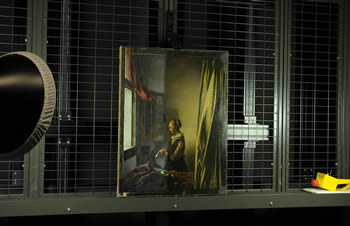 Image from the Gemäldegalerie Alte Meister website
Image from the Gemäldegalerie Alte Meister websiteIn March, 2017, the Gemäldegalerie Alte Meiste of Dresden removed Vermeer's Girl Reading a Letter at an Open Window from the permanent exhibition in order to begin the restoration of the picture. The procedure will accompanied by an expert commission of five restorers and scientists from Dresden, Amsterdam, Copenhagen and Vienna.
Click here to visit the museums website for further images and updates.
Considering its age, the painting is stable in terms of its conservation condition. Its surface, however, is characterized by severely darkened layers of varnish and old retouching, and this above all gave rise to the decision to restore the painting. The restoration is taking place in the paintings conservation department at the Staatliche Kunstsammlungen Dresden and is being performed by paintings conservator Dr. Christoph Schölzel. Accompanying the restoration is a research project about the painting, carried out in cooperation with the archaeometry laboratory at the Hochschule für Bildende Künste Dresden, the Doerner-Institut at the Bayerische Staatsgemäldesammlungen München, the Rijksmuseum Amsterdam and The National Gallery in London.
Vermeer's Girl Reading a Letter at an Open Window will be presented to the public when the renovation of the Gemäldegalerie in the Semperbau is complete and the museum reopens in 2019. It will be a highlight of the new permanent exhibition.
Vermeer-related documentary
Vermeer-Beyond Time
directors: Jean-Pierre Cottet & Guillaume Cottet
opening in Dublin on June 17, 2017 and runs through to September 17.
A new feature documentary, VERMEER, BEYOND TIME will be released in cinemas this month ahead of the major Vermeer exhibition at the National Gallery of Ireland entitled Vermeer and the Masters of Genre Painting: Inspiration and Rivalry which opens on June 17.
French filmmaker Jean-Pierre Cottet adopts an imaginative and sensitive approach to his subject focusing on the work itself but also choosing to explore Vermeer's family life including his conversion to Catholicism, his artistic contemporaries and the wider world of the short-lived Dutch Golden Age of the 17th Century.
RTÉ will screen the documentary in early June. After this, the DVD will be available for purchase. More details about the screenings and sales points for the DVD to follow.
Vermeer-related website 
Connect Vermeer
http://www.connectvermeer.org/
from the website:
In conjunction with the Vermeer and the Masters of Genre Painting: Inspiration and Rivalry exhibitive, the Connect Vermeer website grew out of a research project conducted by the National Gallery of Ireland in collaboration with the Netherlands Institute for Art History (RKD). Through a series of interactive visualizations, Connect Vermeer allows users to discover the network of connections between Vermeer and his sixteen contemporaries. Users can discover the strength and likelihood of relationships between the seventeen artists, the impact of an individual artist's paintings on the work of his contemporaries, as well as how artists adopted, adapted and disguised elements, from their peers' work, in their own paintings.
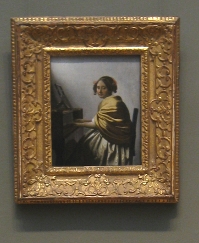
A Young Woman Seated at the Virginals exhibited in China
Rembrandt, Vermeer and Hals in the Dutch Golden Age: Masterpieces from The Leiden Collection
The Long Museum (West Bund), Shanghai
http://thelongmuseum.org/en/exhibition/overview/51dfps
September 23, 2017–February 25, 2018
from the Long Museum website:
The Leiden Collection and Long Museum (West Bund) have collaborated to stage an exhibition of masterpieces from the celebrated Leiden Collection, the largest and most important collection of paintings from the Dutch Golden Age in private hands. The exhibition will open on September 23, 2017 and continue through February 25, 2018. It will feature 78 works, making it the largest showing of seventeenth-century Dutch art ever presented in China. The selections will comprise 12 works by Rembrandt van Rijn, two portrait paintings by Frans Hals, a recently attributed painting by Vermeer, and as well as masterpieces by other artists from the period.
The Leiden Collection, founded in 2003 by American collectors Dr. Thomas S. Kaplan and his wife, Daphne Recanati Kaplan, comprises some 250 paintings and drawings and represents one of the largest and most important assemblages of seventeenth-century Dutch paintings in private hands.
The collection is named after Rembrandt's native city in honor of the master's greatness and focuses on the works of Rembrandt and his followers, illuminating the personalities and themes that shaped the Golden Age over five generations. The collection is the most comprehensive representation of the Leiden artists known as fijnschilderen ("fine manner painters"), who concentrated on painting portraits, tronies (character studies), genre scenes, and history paintings.
about the exhibition curator:
Dr. Lara Yeager-Crasselt is the Curator of The Leiden Collection. She earned her Ph.D. in Art History from the University of Maryland with a specialty in seventeenth-century Dutch and Flemish art.
New study of Vermeer's painting technique 
Traces of Vermeer
by Jane Jelley
July 27, 2017
from Oxford University press release:
Jane Jelley has taken a new path in this detective story. A painter herself, she has worked with the materials of his time: the cochineal insect and lapis lazuli; the sheep bones, soot, earth and rust. She shows us how painters made their pictures layer by layer; she investigates old secrets; and hears travelers' tales. She explores how Vermeer could have used a lens in the creation of his masterpieces, and made some experiments in her own studio to transfer images from projections directly to a canvas. She has found a reliable solution that corresponds to the scientific examination of Vermeer's work, which provides answers to some of the puzzles he left behind.
The clues were there all along. After all this time, now we can unlock the studio door, and catch a glimpse of Vermeer inside, painting light.
Jane Jelley is a painter of still life and landscape who became interested in the unusual technical qualities of Vermeer's painting, and in the arguments about whether or not he might have used a camera obscura in his work. Jane lives and works in Oxford. More information about Jane and her work can be found on tracesofvermeer.com.
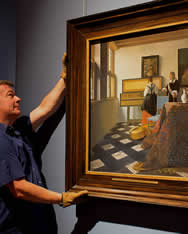
Limited accessibility for Vermeer's The Music Lesson
Vermeer's The Music Lesson, it is not currently on public view, although it can be seen during pre-booked guided tours of the Buckingham Palace State Room until the 4 February. Details are available at the webpage below.
The painting will again be accessible to the general during the opening of the Buckingham Palace State Rooms between August and October 2018 (exact dates to be communicated–please check the Royal Collection Trust website near that time for more details).
https://www.royalcollection.org.uk/visit/the-state-rooms-buckingham-palace
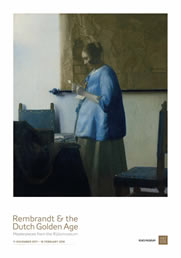
Vermeer's Woman in Blue Reading a Letter travels down under to Sydney
Rembrandt and the Dutch Golden Age: Masterpieces from the Rijksmuseum
Art Gallery of New South Wales, Sydney
November 11,
2017–February 18, 2018
https://www.artgallery.nsw.gov.au/exhibitions/rembrandt/
from the gallery website:
The Rembrandt and the Dutch Golden Age exhibition at the Gallery is devoted to the greatest Dutch painters of the seventeenth century and the flourishing artistic culture of the time.
This is a rare opportunity for Sydney audiences to experience 77 outstanding works of art by Rembrandt, Vermeer, Ruisdael, Hals, Steen, Dou, Lievens and Leyster—each masters of their respective genres—drawn from the Rijksmuseum, Amsterdam, the great national collection of the Netherlands.Rembrandt and the Dutch golden age presents a richly unfolding panorama of Dutch society in an era of unparalleled wealth, maritime power and cultural confidence. Vivid and compelling, the paintings encompass the tranquil Dutch landscape, the colorful life of the cities, Dutch society and morality, ships on the high seas and the characterful people who made the Dutch Republic such a success.
Major Vermeer exhibition in Washington D.C.
Vermeer and the Masters of Genre Painting: Inspiration and Rivalry
National Gallery of Art, Washington D.C.
October 22, 2017–January 21, 2018
https://www.nga.gov/content/ngaweb/exhibitions/2017/vermeer-and-the-masters-of-genre-painting.html
The National Gallery of Ireland, Dublin is staging a landmark exhibition that explores the network of relationships among Dutch genre painters of the period 1650–1670.
Vermeer and the Masters of Genre Painting: Inspiration and Rivalry will afford visitors and scholars insights into how Vermeer and contemporary painters of scenes of everyday life admired, inspired and rivaled each other.
Affluent Dutch citizens, who styled themselves as liefhebbers (lovers of art), were expected to be able to compare paintings, recognize artists' hands and point out stylistic and thematic borrowings from other artists. This exhibition invites visitors to take on the role of seventeenth-century art lovers and compare small groups of paintings that reflect the cross-currents of inspiration. Exhibition visitors will also be able to observe how each artist had a particular ways of inserting and disguising his borrowings, trying to surpass the others in verisimilitude, technical prowess and aesthetic appeal. This vibrant artistic rivalry contributed to the exceptionally high quality of their combined oeuvre.
The exhibition and accompanying catalogue benefits from an extensive research program, which will include a website that is currently being developed in collaboration with the Netherlands Institute for Art History (RKD), The Hague.
Admission is always free and passes are not required.
Ten Vermeer paintings will be exhibited:
- Woman with a Balance
- A Lady Writing
- Woman with a Lute
- Woman with a Pearl Necklace
- The Astronomer
- The Geographer.
- The Lacemaker
- Woman Writing a Letter with Her Maid
- The Love Letter
- A Lady Seated at a Virginal
exhibition checklist:
https://www.nga.gov/content/dam/ngaweb/press/exh/3799/3799-list.pdf
curators:
This exhibition is curated by Arthur K. Wheelock Jr., curator of northern Baroque paintings, National Gallery of Art, Washington; Adriaan E. Waiboer, head of collections and research, National Gallery of Ireland, Dublin; and Blaise Ducos, curator of Dutch and Flemish paintings, Musée du Louvre, Paris.
catalogue:
The exhibition and accompanying catalogue benefits from an extensive research program, which will include a website currently under development in collaboration with the RKD. This website will chart and illustrate painters' responses to each other's stylistic and thematic innovations. Currently, already over 1250 paintings are represented in the database RKDImages, which will be linked to each other on the basis of artistic relations, visualizing the exchange of artistic motives between the several artists. A technical research project, led by Melanie Gifford, Conservation Scientist at the National Gallery of Art, presently examines the exchanges of painting techniques and materials among Dutch genre painters of the period 1650–1675.<
lecture:
Vermeer and the Masters of Genre Painting: Inspiration and Rivalry
October 22 at 2:00
East Building Auditorium
lecture
Innovation, Competition, and Fine Painting Technique: Marketing High-Life Style in the Dutch 17th Century
October 30 at 12:10 and 1:10
East Building Auditorium
teacher workshop:
Vermeer and the Masters of Genre Painting: Inspiration and Rivalry
November 8 at 4:30 to 7:30 p.m.
Advance registration is required
lecture:
More than Mimicry: The Parrot in Dutch Genre Painting
November 20 at 12:10 and 1:10
East Building Auditorium:
lecture:
Time and Temporality in Seventeenth-Century Dutch Genre Painting
December 18 at 12:10 and 1:10
West Building Lecture Hall
lecture:
Johannes Vermeer: An Artist of His Time Yet Timeless
January 7 at 2:00
East Building Auditorium
concert:
Piffaro, The Renaissance Band
January 21 at 3:30
West Building, West Garden Court
film:
A documentary film, entitled, Vermeer - The Man His Time His World, is currently in production, to be released in 2017 as one of the events associated with the National Gallery of Ireland's exhibition Vermeer and the Masters of Genre Painting: Inspiration and Rivalry. The film is directed by Jean-Pierre Cottet and produced by James Mitchell, as a co-production between iO Production (Paris) and Soho Moon Pictures (Dublin), with the support of Arté in France, PBS in USA, and RTÉ, Ireland's public service broadcaster. It will be broadcast on RTÉ One Television next summer to coincide with the exhibition during its run here.
other venue:
National Gallery of Art, Washington D.C.
October 22, 2017–January 21, 2018
in the news:
February 21, 2017 - The Guardian (Jonathan Jones)
Vermeer and the Masters of Genre Painting review – the birth of the cool
March 8, 2017 - Hyperallergic
Louvre Security Staff Threaten To Strike as Blockbuster Vermeer Show Causes Disarray
March 9, 2017- New York Times
Louvre Attendants Strike After Vermeer Bottleneck
March 4, 2017 - Essential Vermeer
Vermeer and the Masters of Genre Painting review
Video Stream of Vermeer-related lecture at the Frick Collection in New York
Using Computed Weave Maps to Gain Art-Historical Insight from Vermeer's Canvases
by Dr. C. Richard Johnson, Jr. (Cornell University)
from the Frick Collection website:
The Thread Count Automation Project (TCAP) (link is external) launched by Professor Johnson in 2007 discovered striped patterns in color-coded images of local thread densities obtained from digital image processing of x-radiographs of Old Master paintings on canvas. These striped patterns provide a "fingerprint" for pieces of canvas cut from the same roll. This spurred a four-year effort assisted by the late Walter Liedtke, one of the world's leading scholars of Dutch and Flemish paintings, to gather x-radiographs of all thirty-four paintings on canvas by Vermeer. Six matching pairs of roll-mates have been identified thus far that provide evidence regarding authentication, dating and —potentially—artistic intent. In addition to weave density maps, images were created of thread angle from their nominal horizontal and vertical directions. These angle maps provide forensic information regarding warp/weft thread designation and cusping, which offers insight into Vermeer's studio practice and the possible re-sizing of his paintings since their creation. The insights generated by computed weave maps arising from the application of digital image processing are pioneering contributions from engineering to the emerging field of computational art history.
Essential Vermeer website addition
Vermeer-Related Artworks
November 29, 2016
click here to access
Click on the thumbnails or the titles of the paintings to access the relative works page for that work.
Click on the thumbnail images to access a higher resolution image.

Rather than attempting to establish direct links between Vermeer and specific artworks of his time, the goal of this web article is to trace the evolution of both the themes and compositions which can be associated with each painting by Vermeer, before and after it was presumably executed. Therefore not only works traditionally linked to Vermeer's paintings are listed but a broad range of artworks which a range from Classical times to the 20th century.
Hopefully, this approach will provide useful information not only for the seasoned art historian but for a wider readership. Some of the pictures, like Vermeer's Woman with a Lute, unravel like a film, exhibiting relatively few compositional inventions but many symbolic variations.
Vermeer-related lecture at the Frick Collection in New York
Using Computed Weave Maps to Gain Art-Historical Insight from Vermeer's Canvases
by Dr. C. Richard Johnson, Jr. (Cornell University)
May 2, 2017 | 4–6 p.m.
The Music Room, The Frick Collection, 1 East 70th Street, New York
from the Frick Collection website:
The Thread Count Automation Project (TCAP) (link is external) launched by Professor Johnson in 2007 discovered striped patterns in color-coded images of local thread densities obtained from digital image processing of x-radiographs of Old Master paintings on canvas. These striped patterns provide a "fingerprint" for pieces of canvas cut from the same roll. This spurred a four-year effort assisted by the late Walter Liedtke, one of the world's leading scholars of Dutch and Flemish paintings, to gather x-radiographs of all thirty-four paintings on canvas by Vermeer. Six matching pairs of roll-mates have been identified thus far that provide evidence regarding authentication, dating and —potentially—artistic intent. In addition to weave density maps, images were created of thread angle from their nominal horizontal and vertical directions. These angle maps provide forensic information regarding warp/weft thread designation and cusping, which offers insight into Vermeer's studio practice and the possible re-sizing of his paintings since their creation. The insights generated by computed weave maps arising from the application of digital image processing are pioneering contributions from engineering to the emerging field of computational art history.
After the presentation The Frick Collection's Associate Research Curator Margaret Iacono will hold a conversation with Dr. Johnson about his discoveries regarding some of Vermeer's masterpieces, including The Collection's iconic Mistress and Maid.
entrance: free, but registration is required
contact: dahlprograms@frick.org
lecture sign up page: https://www.frick.org/programs#/?i=1.
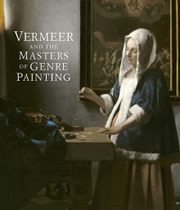
Major Vermeer exhibition at Paris, Dublin and Washington
Vermeer and the Masters of Genre Painting: Inspiration and Rivalry
February 22 – May 22, 2017
Musée du Louvre, Paris
Click here for the Essential Vermeer review of this exhibition.
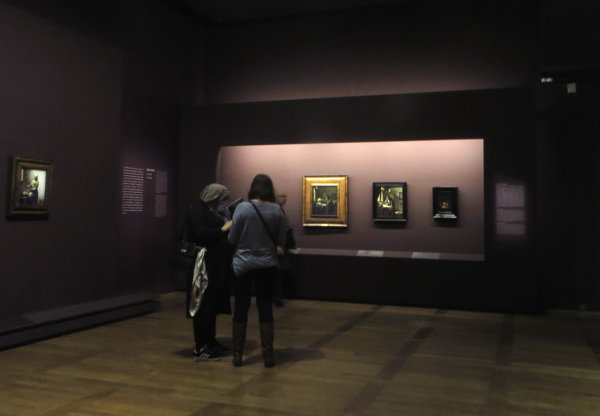
 First-day timed reservation for Vermeer exhibition (top) and all-day ticket for Louvre (bottom)
First-day timed reservation for Vermeer exhibition (top) and all-day ticket for Louvre (bottom) The Musée du Louvre, Paris, the National Gallery of Ireland, Dublin and the National Gallery of Art, Washington, are staging a landmark exhibition that explores the network of relationships among Dutch genre painters of the period 1650–1670.
Vermeer and the Masters of Genre Painting: Inspiration and Rivalry will afford visitors and scholars insights into how Vermeer and contemporary painters of scenes of everyday life admired, inspired and rivaled each other.
Affluent Dutch citizens, who styled themselves as liefhebbers (lovers of art), were expected to be able to compare paintings, recognize artists' hands and point out stylistic and thematic borrowings from other artists. This exhibition invites visitors to take on the role of seventeenth-century art lovers and compare small groups of paintings that reflect the cross-currents of inspiration. Exhibition visitors will also be able to observe how each artist had a particular ways of inserting and disguising his borrowings, trying to surpass the others in verisimilitude, technical prowess and aesthetic appeal. This vibrant artistic rivalry contributed to the exceptionally high quality of their combined oeuvre.
The exhibition and accompanying catalogue benefits from an extensive research program, which will include a website that is currently being developed in collaboration with the Netherlands Institute for Art History (RKD), The Hague.
Twelve (?) Vermeer paintings will be exhibited.
- The Milkmaid
- Woman with a Balance
- A Lady Writing
- Woman with a Lute
- Woman with a Pearl Necklace
- The Astronomer
- The Geographer.
- The Lacemaker
- Woman Writing a Letter with Her Maid
- Allegory of Faith
- A Lady Seated at a Virginal
- A Young Woman Seated at the Virginals (?)
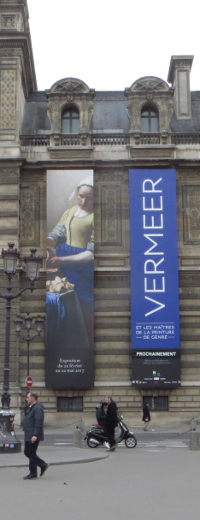
curators:
The exhibition's curatorial team is comprised of Adriaan E. Waiboer, Curator of Northern European Art, National Gallery of Ireland, Dublin; Arthur K. Wheelock Jr., Curator of Northern Baroque Painting, National Gallery of Art, Washington; and Blaise Ducos, Curator of seventeenth- and eighteenth-century Dutch and Flemish paintings, Musée du Louvre, Paris.
catalogue:
The exhibition and accompanying catalogue benefits from an extensive research program, which will include a website currently under development in collaboration with the RKD. This website will chart and illustrate painters' responses to each other's stylistic and thematic innovations. Currently, already over 1250 paintings are represented in the database RKDImages, which will be linked to each other on the basis of artistic relations, visualizing the exchange of artistic motives between the several artists. A technical research project, led by Melanie Gifford, Conservation Scientist at the National Gallery of Art, presently examines the exchanges of painting techniques and materials among Dutch genre painters of the period 1650–1675.
website:
The Connect Vermeer research project website for the National Gallery of Ireland
The exhibition partners, in collaboration with the Netherlands Institute for Art History (RKD) have undertaken a research project addressing the interconnectivity between the seventeen principal genre painters and their works of art. Lead by the National Gallery of Ireland, the aim of the project is to share the research results with the public on a website, which will be launched to coincide with the opening of the exhibition in the Musée du Louvre in February 2017.
This website will chart and illustrate painters' responses to each other's stylistic and thematic innovations. A technical research project, led by Dr Melanie Gifford, Conservation Scientist at the National Gallery of Art presently examines the exchanges of painting techniques and materials among Dutch genre painters of the period 1650–1675.
film:
A documentary film, entitled, Vermeer - The Man His Time His World, is currently in production, to be released in 2017 as one of the events associated with the National Gallery of Ireland's exhibition Vermeer and the Masters of Genre Painting: Inspiration and Rivalry. The film is directed by Jean-Pierre Cottet and produced by James Mitchell, as a co-production between iO Production (Paris) and Soho Moon Pictures (Dublin), with the support of Arté in France, PBS in USA, and RTÉ, Ireland's public service broadcaster. It will be broadcast on RTÉ One Television next summer to coincide with the exhibition during its run here.
AT THE LOUVRE
exhibition album:
Co-published by Musée du Louvre Éditions and Somogy Éditions d'Art. 48 pages, 50 illustrations, €8
documentary:
Vermeer's Revenge
Directed by: Jean-Pierre Cottet and Guillaume Cottet
Jointly produced by: ARTE France, Martange Production, Soho Moon Pictures, Musée du Louvre
lectures:
February 23, 2017 at 12:30 p.m. and 6:30 p.m.
Presentation of the exhibition (in French)
Blaise Ducos, Musée du Louvre
March 2, 9, 16 and 30, 2017 at 6:30 p.m.
"Understanding Vermeer—"The Sphinx of Delft"
"From "Drolleries" to Interior Scenes: the Birth and Beginnings of Dutch Genre Painting"
Sabine van Sprang, Royal Museums of Fine Arts of Belgium, Brussels (March 2)
"The Fabric of Society: Fashion in the Republic (1650–1680)"
Bianca du Mortier, Rijksmuseum, Amsterdam (March 9)
"Johannes Vermeer's Milkmaid"
Blaise Ducos, Musée du Louvre (March 16)
"Vermeer Forgeries"
Jonathan Lopez, art historian and writer, New York (March 30)
PRATICAL INFORMATION / AUDITORIUM
Information: +33 (0)1 40 20 55 55, Monday to Friday, 9 a.m. to 7 p.m., or online : www.louvre.fr
Tickets: In person: Auditorium ticket windows; Telephone: +33 (0)1 40 20 55 00;
Online: www.fnac.com
other venues:
National Gallery of Ireland, Dublin
17 June–17 September, 2017
https://www.nationalgallery.ie/art-and-artists/exhibitions
National Gallery of Art, Washington D.C.
22 October, 2017–21 January, 2018
In the News
February 21, 2017 - The Guardian (Jonathan Jones)
Vermeer and the Masters of Genre Painting review – the birth of the cool
March 8, 2017 - Hyperallergic
Louvre Security Staff Threaten To Strike as Blockbuster Vermeer Show Causes Disarray
March 9, 2017- New York Times
Louvre Attendants Strike After Vermeer Bottleneck
March 4, 2017 - Essential Vermeer
Vermeer and the Masters of Genre Painting review
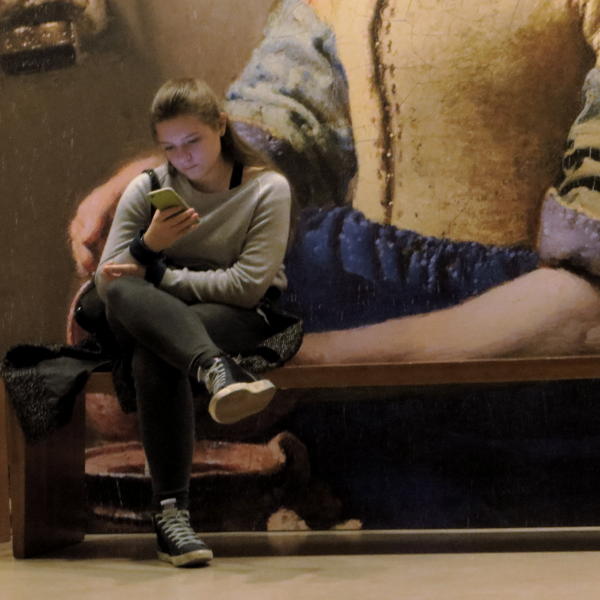
Mauritshuis app for Vermeer's Girl with a Pearl Earring
New App Reveals Secrets of Girl with the Pearl Earring
from Mauritshuis press release:
The Mauritshuis and Madpixel show Seventeenth Century Masterpieces as Never Before
THE HAGUE,
November 10, 2016
As of today a brand new app, Second Canvas Mauritshuis, renders Vermeers Girl with the Pearl Earring and The Garden of Eden by Brueghel and Bosch to zoom in on the brushstrokes of the paintings in Gigapixel. This is the first app in the world to offer Gigapixel integrated infrared images, which take users below the surface a painting revealing to layers and millimeter-sized details that are not normally visible to the naked eye. The Mauritshuis has joined forces with an innovative digitization company, Madpixel, to bring part of the collection to a broader audience in an entirely new way.
Second Canvas Mauritshuis takes users on a voyage of digital discovery through a selection of the museum's masterpieces and introduces the artworks in an interactive way. It harnesses high resolution technology to zoom in on the brushstrokes, thereby revealing a level of detail in famous paintings that are otherwise invisible. It features an audio tour, which directs the eye to important aspects of the work, and can also be used to share the details directly via social media. Next to the Girl with the Pearl Earring by Vermeer and The Garden of Eden by Brueghel and Bosch, the app presents eight other works of the Mauritshuis collection by Rembrandt, Rubens, Brueghel, Avercamp, Steen and others in high-resolution.
Practical Information The Second Canvas Mauritshuis app is downloadable from the App store and Google Play at a cost of €1.99. It is available in English and Dutch, for iPad, iPhone, Android and AppleTV.
Download the app in AppStore
Download the app in GooglePlay
Madpixel The Mad Pixel Factory is a Spanish company specialized in digital solutions for museums and institutions managing artistic and cultural heritage. Founded in 1999 and headquartered in Madrid, it has taken part in scores of innovative projects with other leading national and international companies providing creativity, design and technology as part of its work. More information: www.madpixel.es
Classic Vermeer monograph reissued by Phaidon
Vermeer
by Ludwig Goldscheider
April 11, 2016
https://amzn.to/3Pma85ghttps://amzn.to/3Pma85g
Phaidon Press celebrates one of the greatest painters of the Dutch Golden Age with a luxurious, large-format image book originally published in 1958. This sumptuously produced volume features full-color reproductions of all 36 surviving works by the artist, along with numerous details that reveal the exquisite complexity of his paintings.
An updated essay for the 1958 edition by Ludwig Goldscheider, co-founder of Phaidon Press, is accompanied by a new preface from Dutch painting specialist Wayne Franits, putting Vermeer into a contemporary context. Elegant design, fine papers and tipped-on image plates make this a true collector's edition.
120 color illustrations
Vermeer's Girl with a Wine Glass returns to Herzog Anton Ulrich-Museum in Brunswick
Johannes Vermeer's Girl with the Wine Glass at the Herzog Anton Ulrich-Museum in Brunswick will back to its place in the museum, which will reopen on 23 October, 2016, after seven years renovation.
Due to renovation was the Herzo- Anton Ulrich Museum closed for years in Brunswick, Lower Saxony. Some of the masterpieces from the collection, including Vermeer's Girl with a Wine Glass were housed in a gallery of the Danwarderode castle in the same city.
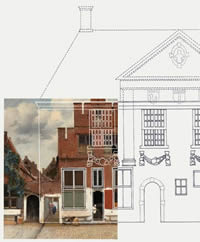
Frans Grijzenhout proposes new location of Vermeer's Little Street.
Philip Steadman argues there is a better fit.
Frans Grijzenhout has recently proposed that Vermeer's The Little Street shows houses at 40 and 42 Vlamingstraat in Delft. His theory is the subject of a current exhibition at the Rijksmuseum in Amsterdam. Philip Steadman, author of Vermeer's Camera, argues the case for an alternative location on the Voldersgracht. Steadman's case is supported with contemporary maps, drawings and a 19th century photograph.
Click here to read Steadman's illustrated article.
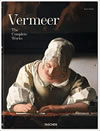
New Vermeer monograph
Vermeer: The Complete Works
Karl Schütz
December 5, 2015
from the Taschen website:
The Dutch Republic in the seventeenth century was home to one of the greatest flowerings of painting in the history of Western art. Freed from the constraints of royal and church patronage, artists created a rich outpouring of works that circulated through an open market to patrons and customers at every level of Dutch society. The closely observed details of daily life captured in portraits, genre scenes and landscapes offer a wealth of information about the possessions, activities and circumstances that distinguished members of the social classes, from the nobility to the urban poor. The dazzling array of paintings gathered here—by artists such as Frans Hals, Jan Steen, Pieter de Hooch and Gerrit ter Borch, as well as Rembrandt and Vermeer—illuminated by essays from leading scholars, invites us to explore a vibrant early modern society and its reflection in a golden age of brilliant painting.
This XL edition brings together the complete catalog of Vermeer's work, presenting the calm yet compelling scenes so treasured in galleries across Europe and the United States into one monograph of utmost reproduction quality. With brand new photography of many works, Vermeer's restrained but richly evocative repertoire of domestic actions—ranging from letter writing to music making to preparations in the kitchen—unfolds in a generous format, including three fold-out spreads. Numerous details emphasize the artist's remarkable ability not only to bear witness to the trends and trimmings of the Dutch Golden Age but also to encapsulate an entire story in just one transient gesture, expression, or look.
also available at: amazon.com
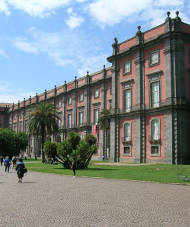
Vermeer's Woman Playing a Lute travels to Naples
Naples, Pinacoteca di Capodimonte
November 21 –February 9, 2016
Vermeer's Woman with a Lute will be on exhibition at the Pinacoteca di Capodimonte in Naples. To highlight the artistic relationships between the Netherlands and Italy in the seventeenth century various works from the museum's collection of analogous subject matter will be shown. These include three representations of Santa Cecilia, the patron of musicians, by the Italian painters Bernardo Cavallino, Carlo Sellitto and Francesco Guarino.

British Queen lends 22 Paintings to the Mauritius including Vermeer's Music Lesson
At Home in Holland: Vermeer and his Contemporaries from the British Royal Collection
Mauritsius, The Hague
September 29, 2016– January 8, 2017
https://www.mauritshuis.nl/en/press/
from Mauritshuis press release:
From 29 September, 2016 to 8 January, 2017 the Mauritshuis in The Hague will exhibit a selection of the most important Dutch genre paintings from the British Royal Collection. The star of the exhibition is The Music Lesson by Vermeer.
The exhibition covers a broad selection of the best Dutch genre paintings from the Royal Collection. It includes 22 paintings from the British Royal Collection and one from the collection of the Mauritshuis, The Young Mother by Gerrit Dou. This painting was part of the British Royal Collection until about 1700, and came into Dutch ownership through King and Stadholder William III. Other than Vermeer's Music Lesson' and Jan Steen's A Woman at her Toilet, the exhibition also featured are significant works by other grand masters of Dutch genre painting, such as Gerrit ter Borch, Gerrit Dou, Pieter de Hooch, Willem van Mieris and Gabriël Metsu.
timed tickets:
Especially
for this exhibition the Mauritshuis is offering timed tickets to the
visitors to have the opportunity to reserve a ticket at a specific time.
Visitors
have direct access to the exhibition at a specific time every day from 3
p.m. onwards by purchasing a time slot (at € 2.50) in combination with a
ticket. The exhibition is open to all visitors without a timed ticket at
any time during the day.
catalogue:
The exhibition is accompanied by a richly illustrated catalogue in both English and Dutch, published by Royal Collection Trust, the Mauritshuis and Mercatorfonds. The catalogue was written by the exhibition's curators, Desmond Shawe-Taylor (Surveyor of the Queen's Pictures, Royal Collection Trust) and Quentin Buvelot (Senior Curator at the Mauritshuis). Masters of the Everyday: Dutch Artists in the Age of Vermeer is currently available in the shop at the Mauritshuis.
Masters of the Everyday: Dutch Artists in the Age of Vermeer
ISBN 978 94 6230 104 7
(price: €29,95)
Vermeer en zijn tijdgenoten: Hollandse genrestukken uit de Royal Collection
ISBN 978-94-6230-102-3
sponsors:
The exhibition is made possible with the support of ABN AMRO, the Friends of the Mauritshuis Foundation and the Dutch Masters Foundation.
contact:
Natalie Bos, Mauritshuis
+31 (0)70 302 3438 / +31 (0)6 1444 8460
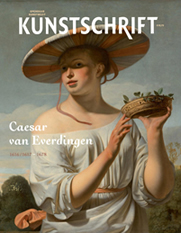
Award-winning exhibition of Vermeer's contemporary, Caesar van Everdingen
Painting Beauty - Caesar van Everdingen (1616/1617–1678)
Stedelijk Museum Alkmaar, Alkmaar
https://stedelijkmuseumalkmaar.nl/
September 24, 2016– January 26, 2017
0Perhaps not all Vermeer devotees are familiar with the work of the Dutch history painter Cesar van
Everdingen, but it is likely that Vermeer was very much so. Although it has not survived, art historians, believe that the large-scale painting of Cupid that once appeared four of Vermeer's interiors was probably by his hand (a Cupid was listed among the personal art collection of Maria Thins Vermeer's mother-in-law). Certainly, Van Everdingen's exceptional technique could not have been lost on Vermeer and perhaps works of such exquisite intimacy and formal perfection, A Young Woman Warming her Hands over a Brazier: Allegory of Winter, struck a particularly sympathetic chord with the Delft master.
After four hundred years after his birth Stedelijk Museum Alkmaar presents the first monographic exhibition of Van Everdingen, whose "flattering brush" allowed him to capture on canvas the softness of velvet, the sleekness of fur and the sheen of fabrics in his impressive history paintings and civic guard portraits. The exhibition brings together works by Van Everdingen from Dutch and foreign museums and private collections to Alkmaar as well as the Rijksmuseum's recently purchased Young Woman in a Broad-Brimmed Hat. Other keys works will be lent by museums in Dresden and Stockholm especially for this occasion. Venus from The Hague will be reunited with Adonis from Cape Town. A recently discovered painting of a sensual peasant woman from a Russian private collection will also be on display.
The museum has won the prestigious Dutch Turing Award II for the exhibition concept.
exhibition catalogue (available in Dutch and English)::
Christi
M. Klinkert and Yvonne Bleyerveld (eds.), Caesar van Everdingen
(1616/1617–1678): Painting Beauty, exh. cat. Stedelijk Museum Alkmaar, Alkmaar/Zwolle (Waanders Uitgevers) 2016,
ISBN 978 94 6262 108 4
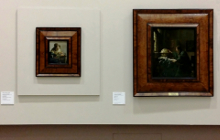
Two Louvre Vermeers again on display
Due to restoration of the Louvre, the museums's two Vermeers (The Astronomer and The Lacemaker) are currently on display in a new gallery (Flanders and Holland 17th C.) - Room 20, Sully Wing (second floor), closest lift/elevator is G.
(Information and image kindly provided by Brian.S.)
Vermeer's A Lady Writing visits Chrysler Museum for a limited engagement
Chrysler Museum, Norfolk
November 1–December 18, 2016
http://www.chrysler.org/exhibitions/johannes-vermeer/
from the museum website:
For a limited six-week engagement Vermeer's A Lady Writing will be on display at the Chrysler Museum of Art. It is being lent to the Chrysler by the National Gallery of Art in Washington, D.C.
"The beguiling expression of the young lady is the result of Vermeer's meticulous care in composition and pose," says Lloyd DeWitt, the Chrysler Museum's Chief Curator and Irene Leache Curator of European Art. "Adorned in the fashionable style of the day—hair ribbons, pear-drop pearl earrings, and a fur-trimmed jacket—she meets our gaze with a slight smile while writing a letter" he says. "The nib of her quill pen is still on the paper."
The painting will be on view in Gallery 202 of the Dalis Foundation Galleries.
admission: free.
related programs:
Special Vermeer Lecture
by Arthur K. Wheelock, Jr.
Sunday, November 20 | 2 p.m. | Kaufman Theater | Free
Revel in the beauty of Johannes Vermeer's A Lady Writing, one of only 35 works by the venerable seventeenth-century Dutch painter. Arthur K. Wheelock, Jr., Curator of Northern Baroque Paintings at the National Gallery of Art, guides you through the old master's work in this very special Kaufman Theater lecture. Seating is limited.
Vermeer Gallery Talk
by Chief Curator Lloyd DeWitt
Thursday, December 8 | 2 p.m. | free
Look deeper into the subjects and the psyches in Johannes Vermeer's paintings in this very special gallery talk by our resident expert in seventeenth-century Dutch art, Lloyd DeWitt. Meet at the Welcome Desk in Huber Court.
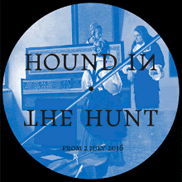
Vermeer-related installation at the MONA, Hobart, Australia
HOUND IN THE HUNT
Museum of Old and New Art
Hobart, Australia
beginning July 2, 2016
https://mona.net.au/stuff-to-do/art/hound-in-the-hunt
Did Vermeer use the comparator mirror to paint?
The Museum of Old and New Art in Hobart, Australia is currently staging an installation which explores the presumed use of optical devices by various seventeenth-century painters in order to reach the astonishing illusionist qualities their works.
The exhibition centers around a simple optical device invented by the American businessman Tim Jension, called the comparator mirror, which Jenison claims may have allowed these painters to copy the forms, colors and tones of nature directly to their canvases, bypassing traditional methods (see Tim's Vermeer, 2013).
In a series of innovative experiments 10 contemporary painters will test various applications of the Jenison's comparator mirror to recreate such works as Vermeer's Girl with Red Hat, Caravaggio's Supper at Emmaus and a still-life by Willem Claesz. Heda's from reconstructed settings and live models, all of which on public view.
Jonathan Janson, painter and author of the Essential Vermeer website, will paint two versions of Vermeer's A Lady Standing at a Virginal from a full scale mock-up of the picture's scene. The first will be executed using traditional painting procedures and with the aid of a booth- type camera obscura (as proposed by Philip Steadman), and the second using Jension's comparator mirror. It is hoped that by comparing the finished works executed within a controlled experimental conditions light may be shed light on to what extent Vermeer might have employed optical devices in his work.
The exhibition is accompanied by a richly illustrated catalogue that presents two contrasting essays. In the first, Jension explains his innovative hypothesis via a lively, first-person discovery trip while in the second Janson attempts to illustrate how Vermeer worked with a camera obscura while remaining largely within the bounds of traditional studio procedures. Janson also makes some considerations on Vermeer's peculiar brand of realism with a few comments on Jenison's device.
catalogue:
http://shop.mona.net.au/auxiliary/Reserve.aspx?p=16123
museum address and opening hours:
Museum of Old and New Art
655 Main Road Berriedale
Hobart Tasmania 7011, Australia
opening hours:
Wed.–Mon.
10 a.m.–5 p.m.
Open every day in January
contact:
+61 (3) 6277 9900
info@mona.net.au
collateral event:
In conjunction with our Hound in the Hunt gallery experiments, Cinemona presents Tim's Vermeer, the feature documentary that introduced most of us to Tim Jenison. Once described as the "'ultimate geek documentary,"' the film pays patient, passionate attention to Jenison's investigative processes, their technical details and the delights of discovery. You may or may not be convinced by Tim's premise—that Vermeer was aided by novel optical instruments—but you will want him to succeed in his ultimate goal of painting a Vermeer himself.
FREE WITH MUSEUM ENTRY (NO BOOKING REQUIRED)
2 p.m. every Sat., Mon., Thur. until 21 July, then 24, 25, 27 July
11.30 a.m. every Sun., Wed., Fri., until 22 July, then 28 July–1 August
Cinemona will also screen The Hound Pack, a selection of short films detailing Jenison's investigations, from 10.30 a.m. Wednesday–Monday. Details at the venue, or on the O.
USA | 2013 | 80 min.
A Penn and Teller Film
Produced by Penn Jillette
Directed by Teller
Consumer advice: infrequent coarse language
Vermeer's Geographer visits the Hermitage
Johannes Vermeer: The Geographer. From the Städelsches Kunstinstitut (Frankfurt am Main)
Masterpieces from the World's Museums in the Hermitage
Hermitage, St. Petersburg (Main Museum Complex, Hall of the School of Rembrandt\)
August 27–November 20, 2016
https://www.hermitagemuseum.org/what-s-on?lng=ru
After The Love Letter in 2010, Vermeer's Geographer will be on temporary loan at the Hermitage.
from Hermitage press release:
When speaking of the history of Vermeer's remarkable picture, which over the course of the centuries changed hands on multiple occasions and spent time in several European countries, mention must be made of one intriguing, albeit brief "Russian" episode. The memory of it is preserved by an oval stamp inscribed "GALERIE DE SAN DONATO" on the back of the canvas, and a half-erased mark made with sealing-wax on the stretcher. Also attached to the back of the painting is a sheet of paper carrying a detailed list of the collections through which it passed between 1713 and 1872. Around 1877, The Geographer was bought in Paris by the Russian businessman and art patron Pavel Pavlovich Demidov (1839–1885). After inheriting the famous Villa San Donato outside Florence from his uncle, he settled in Italy. There the connoisseur enlarged through his own purchases the art collections assembled by several generations of Demidovs. Soon, though, as early as 1880, Pavel Pavlovich decided to sell the villa and its treasures and to move to a new estate, Pratolino. On 15 March, 1880, a tremendous auction began at San Donato that went on for several days. The Vermeer was Lot 1124 in the auction catalogue.
curator:
The exhibition has been curated by Irina Alexeyevna Sokolova, Doctor of Culturology, Keeper of Dutch Painting and Chief Researcher in the Department of Western European Art. Sokolova is the author of The Russian Passion for Dutch Painting of the Golden Age. The
Collection of Pyotr Semenov and the Art Market in St Petersburg,
1860–1910 comes out in the Netherlands (2015)
catalogue:
A scholarly publication in Russian only, Johannes Vermeer: The Geographer (State Hermitage Publishing House, 2016) has been produced for the exhibition. The text is by Irina Sokolova.

Young Woman Seated at a Virginal travels to Dallas
Vermeer Suite: Music in Seventeenth-Century Dutch Painting
January 17–August 21, 2016
https://www.dma.org/press-release/johannes-vermeer-s-young-woman-seated-virginal-go-view-new-dallas-museum-art
from the museum website:
The Dallas Museum of Art presents Vermeer Suite: Music in Seventeenth-Century Dutch Painting, an exhibition organized by the DMA showcasing paintings from the prestigious Leiden Collection of New York, including a work by Johannes Vermeer. The great seventeenth-century Dutch painter created fewer than forty paintings during his lifetime, and Young Woman Seated at a Virginal from 1670–72 is believed to be one of Vermeer's last. This masterpiece is the inspiration for the DMA exhibition Vermeer Suite: Music in Seventeenth-Century Dutch Painting, which includes seven additional loans from The Leiden Collection of works by Vermeer's contemporaries—artists Jan Steen, Gerrit ter Borch, Jacob Adriaensz Ochtervelt, Eglon van der Neer, Gerard Dou, and Frans van Mieris—whose paintings also portray musicians performing period instruments such as the lute, violin and violincello and demonstrate key aspects of seventeenth-century musical culture.
entrance: free of charge
Two Louvre Vermeers not on display
The Northern European rooms of the Louvre are currently under renovation until February 17, 2017, so neither of the museum's Vermeer, The Astronomer and The Lacemaker, are on display.
As of yet, the Louvre has not been announced where or when either of the pictures will be available for public viewing.
Vermeer's Little Street returns to Delft
Vermeer is Coming Home
Museum Prinsenhof Delft
March 25–July 17, 2016
http://prinsenhof-delft.nl/en/
from the museum website:
The Little Street returns to Delft describes the long search to identify the place that inspired Vermeer to paint his masterpiece. It deals with a number of theories (see alternative proposal by Philip Steadman), but specifically explains recent research by professor Frans Grijzenhout into the location of The Little Street.
The exhibition is accompanied by a programme full of activities in the city center of Delft and in Museum Prinsenhof Delft.
Interactive city tour - (App)
The exhibition is accompanied by a smartphone and tablet app that takes visitors independently past some twenty locations that have a link with Vermeer's life and work. They are all in the immediate vicinity of Museum Prinsenhof Delft. The 'Where is Vermeer?' app is suitable for iOS and Android and can be downloaded for free of charge after the opening.
Escape room Vermeer's Workshop
In an escape room designed especially for the exhibition, small groups of visitors visit Vermeer's studio. They then need to try and exit the room in a short period of time by solving puzzles and riddles.
Master Class Vermeer in pieces (Dutch)
The archives of Delft contain various historical documents that can provide a better picture of the mysterious Johannes Vermeer. The Public Archivist takes a close look at these documents together with participants on 22 April and 24 June. For more information or to sign up, send an e-mail.
Guided tour
Every other week there is a brief guided tour on Sunday afternoons where visitors obtain an overall view of The Little Street exhibition.
Opera Writing to Vermeer
On 9 en 10 July a film of the opera 'Writing to Vermeer' (1999) by Louis Andriessen will be shown in de Van der Mandelezaal of Museum Prinsenhof Delft. Theme of the opera: the women around Vermeer and the letters they wrote to him. Filmmaker Andriessen provides the audience with an explanation and Marije van Stralen (soprano) en Bas de Vroome (harpsichord) perform parts of the opera live on stage.
City programme
In the city center, Delft's entrepreneurs and other cultural institutions organize lots of activities around Vermeer and The Little Street.
hours:
Mondays to Sundays - 11.00–17.00 hours.
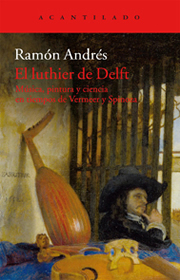
Vermeer-related publication (Spanish)
El luthier de Delft: Música, pintura y ciencia en tiempos de Vermeer y Spinoza (Spanish)
by Ramón Andrés
2015
https://www.acantilado.es/catalogo/el-luthier-de-delft/
from the publisher's website:
El luthier de Delft es una obra que analiza la música (aunque también el arte y la ciencia) del siglo XVII, especialmente centrada en la cultura neerlandesa. El libro gira en torno a tres personajes centrales, el pintor Jan Vermeer, el filósofo Baruch Spinoza y el músico Jan Pietrszoon Sweelinck. A partir de ellos, el lector se encontrará con la construcción de instrumentos musicales, sus maderas y barnices, así como con el papel de la mujer en el arte y la música; la vida de los pintores y el mundo simbólico de sus obras y los estudios científicos destinados a la óptica y la difusión del telescopio. Un libro lleno de resonancias y armonías, sabiduría y sutileza.
(The luthier of Delft is a work that analyzes the music (but also art and science) of the seventeenth century, especially focusing on Dutch culture. The book revolves around three central characters, the painter Johannes Vermeer, the philosopher Baruch Spinoza and musician Jan Sweelinck Pietrszoon. From them, the reader will discover the construction of musical instruments, their woods and varnishes, as well as the role of women in art and music; the lives of the painters and the symbolic world of his works and scientific studies for the optical telescope and dissemination. A book full of resonances and harmonies, wisdom and subtlety.)
Ramon Andrés is a celebrated spanish musicologist and essay-writer.
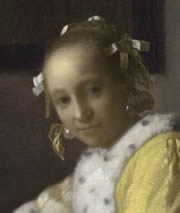
Vermeer's A Lady Writing travels to Kansas City
Reflecting Class in the Age of Rembrandt and Vermeer
The Nelson-Atkins Museum of Art, Kansas City
February 24–May 29, 2016
https://nelson-atkins.org/art/exhibitions/
from the museum website:
This groundbreaking exhibition examines seventeenth-century Dutch paintings in light of the new Republic's social structure. Although the Dutch Republic was relatively democratic at the time, class distinctions remained and conveyed a variety of meanings to its citizens.
Through approximately 71 carefully selected and arranged paintings, this exhibition will present the ways in which Dutch pictures reflect various socio-economic groups. Additionally, three place settings featuring the everyday tableware of the upper, middle and lower classes will bring to life the tangible differences within the Republic's stratified population.
By exploring how class distinctions were expressed and the associations each group held, a more nuanced picture of Dutch society will emerge. Highlights of the exhibition include Vermeer's A Lady Writing and portraits by Rembrandt and Hals.
This exhibition was organized by the Museum of Fine Arts, Boston.
admission prices:
members and children under 12: Free
adults: $12
seniors over 55: $10
students with ID: $6
Exhibition Programs
Presentations
Reflecting On…
6–7 p.m. | Atkins Auditorium
Tickets Required
February 25 | Reflecting On the Power of Dutch Maps and Landscapes
March 31 | Reflecting On 17th- and 18th- Century Dutch Design in the Global Marketplace
April 28 | Reflecting On 17th-Century Dutch Influence in American Scenes of Everyday Life
May 26 | Reflecting On Poverty in Early 20th-Century American Photography
Four curators reflect on themes presented in the exhibition, including the importance and legacy of seventeenth-century Dutch painting and depictions of the social classes in art. Works from across art-historical periods and museum collections will be discussed.
Rank and Status in the Dutch Golden Age
Thursday, March 24
6–7 p.m. | Atkins Auditorium
Tickets required
Join exhibition curator Ronni Baer, William and Ann Elfers Senior Curator of Paintings, Art of Europe, Museum of Fine Arts, Boston, for a lecture that encourages close looking at portraits, genre scenes, landscapes and seascapes to discover clues to the social standing of the people depicted and the workings of the seventeenth-century Dutch Republic.
Performance
Musical Distinctions Inspired by Rembrandt & Vermeer
Friday, March 18
6:30 p.m.–7:30 p.m. | Atkins Auditorium
Tickets required
Distinguished faculty and students from the UMKC Conservatory of Music and Dance and The Sacred Arts Chorale from Central Theological Society present a program of popular Baroque music from the 1600s.
Talks
Crossfire Talks: The Social Classes in Dutch Art
Sundays, 2 p.m. | Exhibition Galleries
Exhibition ticket required
March 20 | The Upper Classes in Dutch Art
April 17 | The Middle Classes in Dutch Art
May 15 | The Lower Classes in Dutch Art
Three short talks explore class distinctions expressed in Dutch paintings and table settings featured in the exhibition. Join Catherine Futter, Director of Curatorial Affairs, and Rima Girnius, Associate Curator of European Painting and Sculpture, and return for all three talks.
Exhibition Tours
February 24–May 29
Exhibition ticket required.
Docent-led tours 1 p.m. Wed.–Fri. | No reservations required.
Vermeer's Young Woman with a Water Pitcher on tour in Japan
Vermeer and Rembrandt: the Masters of the 17th-Century Dutch Golden Age
6-10-1 Roppongi | 52 fields Mori Tower Roppongi Hills, Minato 106-6151, Tokyo Prefecture
February–March 31, 2016
http://www.tbs.co.jp/vermeer2016/#info1
from exhibition web page:
The Dutch Golden Age of Dutch history spanned the seventeenth century, and it was during this period that the Netherlands underwent great development. In the field of painting, a great many excellent painters produced numerous splendid masterpieces. They include well-known painters such as the painter of light, Johannes Vermeer (1632–1675) from Delft, as well as Rembrandt Harmenszoon van Rijn (1606–1669) famed in Amsterdam, and then more widely for his unique ideas, techniques and composition. Their paintings remain still colorful and vivid even after 400 years, leaving the viewer with a powerful impression.
This exhibition introduces the Dutch Golden Age and painters of the era through around 60 artworks. The highlights include Young Woman with a Water Pitcher by Vermeer and Bellona by Rembrandt; both presented to the public for the first time in Japan.
venue two:
Fukushima Prefectural Museum
Fukushima City
April 6–May 8, 2016
Catalogue
authors: Giltaij, Jeroen (editor); Wieseman, Betsy (texts); Dibbits, Taco (texts); Wheelock,
Arthur K. (jr.) (texts); Ozaki, Masato (texts)
publisher: Tokyo: Tokyo Broadcasting System Television, 2015
review:
"Dutch painters cut from the same canvas"
by C.B. Liddell
The Japan Times
http://www.japantimes.co.jp/culture/2016/02/09/arts/dutch-painters-cut-canvas/#.Vrnl-VKPbCl
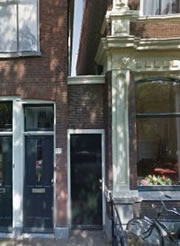
Exact location of Vermeer's Little Street finally discovered?
:
Janene Pieters, "Mystery of world-famous Vermeer setting finally solved"
November 19, 2015
NLTIMES.NL
http://www.nltimes.nl/2015/11/19/mystery-of-world-famous-vermeer-setting-finally-solved/
The century-old mystery of the exact location of Johannes Vermeer's painting Little Street, has finally been solved. The setting for the world-famous painting is on Vlamingstraat in Delft, where houses 40–-42 now stand.
This extraordinary revelation was made by Dr. Frans Grijzenhout, professor of Art History at the University of Amsterdam, the Rijksmuseum announced on Thursday.
Grijzenhout searched seventeenth-century records in the Delft archives and found the conclusive answer in The file of the deep waters within the city of Delft from 1667, also called the Register of the quayside fee. This register kept record of how much tax everyone who owned a house on a canal in Delft had to pay for the deepening of the canal and for maintenance of the wharf in front of his door. It contains detailed, accurate up to 15 cm., information on the breath of all the houses and ports on the Delft canals in Vermeer's time.
The two houses that then stood on Vlamingstraat where numbers 40–42 are now located, completely correspond with the Little Street. No other houses from Vermeer's time correspond so exactly.
The research also revealed that Vermeer's aunt—the widow Ariaentgen Claes van der Minne, Vermeer's father's half-sister—lived in the house on the right side of the painting. Vermeer's mother and sister lived on the same canal, diagonally across the street. According to the Rijksmuseum, it is therefore likely that Vermeer knew the house well and had personal memories linked to it.
"The answer to the question of where Vermeer's Little Street is located, is of great significance and will have profound consequences, both for the way we look at this one painting by Vermeer as well as for the image we have of Vermeer as an artist," said Pieter Roelofs, curator of seventeenth-century paintings at the Rijksmuseum.
To celebrate the Little Street's address being found, the Rijksmuseum is dedicating an exhibition to the discovery. The exhibition will be in the Rijksmuseum between November 20th of this year and March 13th, 2016.
see also:
Rijksmuseum presentation:
https://www.rijksmuseum.nl/en/vermeers-the-little-street-discovered:
Rijksmuseum Press Release (high-resolution images of Vermeer's Little Street and Vlamingstraat, Delft)
https://www.codart.nl/our-events/codart-25/documents-videos/frans-grijzenhout/
Martin Bailey, "Exact location of Vermeer's Little Street discovered"
The Art Newspaper, November 20, 2015
http://theartnewspaper.com/news/exact-location-of-vermeer-s-little-street-discovered/
Brian Boucher, "Has the Site of Johannes Vermeer's 'Little Street' Been Identified?"
Art News, Monday, November 23, 2015
https://news.artnet.com/art-world/vermeer-little-street-identified-370025
Google Art Project presentation:
https://www.google.com/culturalinstitute/exhibit/sgLy5pT_lFc9IQ?projectId=art-project&position=0%3A0
A special exhibition about the newly found location of Vermeer's Little Street will be held in two venues:

Rijksmuseum, Amsterdam
20 November, 2015–13 March, 2016
Stedelijk Museum Het Prinsenhof, Delft
25 March-17 July, 2016
Patrick van Mil, Director of Museum Prinsenhof Delft, says "This offers the opportunity to put Delft on the map as the Vermeer City. With new routes through the city, a special virtual reality App, Vermeer packages etc. We bring the Vermeer of Delft for the visitors to life. To achieve this we are looking for cooperation with various parties such as the Oude Kerk, the Vermeer Centre, TU Delft, Delft Marketing and business. Together we can develop an attractive program whereby Delft would again be dominated by Johannes Vermeer and 'The Little Street', Delft, Vermeer and Vermeer's Delft!"

"Vermeer's The Little Street: A More Credible Detective Story"
by Philip Steadman
Frans Grijzenhout has recently proposed that Vermeer's The Little Street shows houses at 40 and 42 Vlamingstraat in Delft. His theory is the subject of a current exhibition at the Rijksmuseum in Amsterdam. Philip Steadman, author of Vermeer's Camera: The Truth behind the Masterpieces, argues the case for an alternative location on the Voldersgracht. Steadman's case is supported with contemporary maps, drawings and a 19th century photograph.
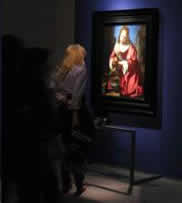
Early Vermeer(?) exhibited in Tokyo
National Museum of Western Art, Tokyo
from March 17, 2015
The Saint Praxedis, which is believed by some scholars to be an authentic early work by Vermeer will be on public display for the first time since it was auctioned by Christie's on July 8, 2014 for $10,687,160 (£6,242,500). The painting, exhibited as "attributed to Vermeer," in the Permanent Collection Galleries (Main Building, 2nd Floor).
Vermeer-related publication
EYE OF THE BEHOLDER: JOHANNES VERMEER, ANTONI VAN
LEEUWENHOEK, AND THE REINVENTION OF SEEING
by Laura J. Snyder
March 16, 2015
from the publisher's
website:
In Eye of the Beholder, Laura J. Snyder transports us to the streets, inns and guildhalls of seventeenth-century Holland, where artists and scientists gathered, and to their studios and laboratories, where they mixed paints and prepared canvases, ground and polished lenses, examined and dissected insects and other animals, and invented the modern notion of seeing. With charm and narrative flair Snyder brings Vermeer and Van Leeuwenhoek—and the men and women around them—vividly to life. The story of these two geniuses and the transformation they engendered shows us why we see the world—and our place within it—as we do today.
also available at amazon.com
reviews:
"Rich and Rewarding"—Graeme Wood, The American Scholar
http://laurajsnyder.com/2015/03/rich-and-rewarding-graeme-wood-the-american-scholar/
"It is clear that Snyder is out of her depth in much of the perspective and optics that she discusses. She gives a rather abbreviated account of the experiments made with cameras by art historians and fails to pinpoint properly what exactly it was that led them and numerous others to suspect Vermeer of using the camera in the first place. She rejects out of hand my own theoretical and experimental work. And she makes no mention of Tim Jenison's very remarkable experiment, which proves beyond doubt the feasibility of painting in color and in meticulous minute detail with a camera obscura. Indeed all the exciting work that has been happening on these questions over the last fifteen years is absent from Snyder's account. This is work in progress, there are many matters of debate and uncertainty, and much remains to be investigated and discovered. But what an opportunity has been missed here!" Philip Steadman (author of Vermeer's Camera: Uncovering the Truth behind the Masterpieces, 2001) Amazon Customer Review
http://www.amazon.com/review/R22326DX82NKS5
"Laura Snyder is both a masterly scholar and a powerful storyteller. In Eye of the Beholder, she transports us to the wonder-age of seventeenth-century Holland, as new discoveries in optics were shaping the two great geniuses of Delft—Vermeer and van Leeuwenhoek—and changing the course of art and science forever. A fabulous book."
—Oliver Sacks
—Jonathan Lopez, The Wall Street Journal Online
http://www.wsj.com/articles/book-review-eye-of-the-beholder-by-laura-j-snyder-1427487412
"Eye of the Beholder is a thoughtful elaboration of the modern notion of seeing. Laura J. Snyder delves into the seventeenth century fascination with the tools of art and science, and shows how they came together to help us make sense of what is right in front of our eyes."
— Russell Shorto, author of Amsterdam:
A History of the World's Most
Liberal City
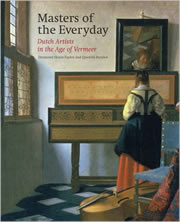
Vermeer's Music Lesson exhibited in London, Edinburgh and Netherlands
venue one:
Masters of the Everyday: Dutch Artists in the Age of Vermeer. An exhibition from the British Royal Collection
The Queen's Gallery, Buckingham Palace
November 13, 2015–February 14,
2016
https://www.royalcollection.org.uk/exhibitions/qgbp/masters-of-the-everyday-dutch-artists-in-the-age-of-vermeer
all information below from
the Royal Collection website:
The Dutch artists of the seventeenth century painted ordinary people doing everyday things. They offer us a glimpse into the rambunctious life of village taverns and peasant cottages, and the quiet domesticity of courtyards and parlors. While the subject-matter may be ordinary—the preparation of food, eating and drinking, the enjoyment of music or a family game—the painting is rich and jewel-like, with equal attention paid to a discarded clay pipe as to a fine silk drape. The meticulously documented details often allude to a work's deeper meaning or to moral messages that would have been familiar to the contemporary viewer.
Presenting 27 masterpieces from the Royal Collection, the exhibition includes works by Gerrit Dou, Gabriel Metsu, Jan Steen and Pieter de Hooch, and Johannes Vermeer's Music Lesson (A Lady at a Virginal with a Gentleman).
opening times:
opens daily, 10:00–17:30
last admission 16:15
admission prices:
adult £10.00
concessions £9.20
under 17/disabled £5.20
under 5 free
For more details please see Royal Collection ticket pages.
Related Activities
Exhibition Talk for groups - Masters of the Everyday
November 12, 2015–February, 2016
To enhance your group visit to Masters of the Everyday: Dutch Artists in the Age of Vermeer, book an exclusive introductory talk by a Royal Collection Trust expert in the Gallery's Redgrave Room. After your 30-minute talk in English, your group is free to enjoy the exhibition at leisure using a complimentary audio tour. Please note Exhibition Talks are for pre-booked groups only.
duration: 1 hour 30 minutes–2 hours
time: 11:00
price: adult £18.80 - over 60/student (with valid ID) £16.90 - under 17/disabled £9.30
minimum: 25
maximum: 80
location: The Queen's Gallery, Buckingham Palace
essential information: Exhibition Talks can be booked on Tuesday and Thursday at 11:00.
Private Evening View for groups - Masters of the Everyday
November 16, 2015–February 11, 2016
Private Evening Views can be arranged for groups to explore Masters of the Everyday: Dutch Artists in the Age of Vermeer at The Queen's Gallery, Buckingham Palace. This exclusive after-hours event offers groups the opportunity to enjoy the exhibition without the crowds. The evening concludes with a glass of wine served in the Gallery Shop. Groups may bring their own guide to interpret the exhibitions or simply explore them at leisure. Price includes a Private Evening View and a glass of wine in the Gallery Shop.
Please be aware, Private Evening Views are only available for pre-booked groups.
duration: 1 hour
time: 18:30–19:30
price: £35.00 per person
minimum number: 50 or booking value £1,750.
maximum number: 150.
location: The Queen's Gallery, Buckingham Palace
essential information: Private Evening Views can be booked on Monday, Wednesday and Thursday at 18:30 during exhibitions. Please be aware the £2.00 telephone booking transaction fee is not payable on this group visit.
contact: +44 (0)20 7766 7321
catalogue:
Masters of the Everyday: Dutch Artists in the Age of Vermeer
Desmond Shawe-Taylor and Quentin Buvelot
Hardback, 176 pages, 289 x 233 mm, over 150 color illustrations
During the seventeenth century, Dutch artists were unparalleled in their dedication to depicting ordinary people doing everyday things. Genre painting was the pre-eminent expression of this dedication, offering candid glimpses into the peasant cottages and village courtyards of the Dutch Golden Age, each painting lit with the period's vibrant color palette and rich with radiant natural light.
This superb collection focuses on a selection of works of Dutch genre painting from the Royal Collection's holdings. Johannes Vermeer, Jan Steen, Gerrit Dou, Gabriel Metsu, and Pieter de Hooch are among the masters whose works are finely reproduced here. While the subject matter may be ordinary—the preparation of food, the bustle of a busy market, the enjoyment of taverns and town festivities—the meticulously documented details often allude to a work's deeper meaning, that would have been familiar to the contemporary viewer.
The book explores these hidden moral messages, as well as the artist's penchant for clever visual puns.
also available at amazon.com
Desmond Shawe-Taylor is Surveyor of The Queen's Pictures, Royal Collection Trust. His previous publications include Dutch Landscapes (2010) and most recently The First Georgians: Art & Monarchy 1714–1760 (2014).
Quentin Buvelot is Senior Curator at the Mauritshuis. His recent publications include Dutch Portraits: The Age of Rembrandt and Frans Hals (2007) and Jacob van Ruisdael Paints Bentheim (2009).
venue two:
Edinburgh The Queen's Gallery, Palace of Holyroodhouse
March 4–July 24, 2016
venue two:
The Mauritshuis, The Hague
September 29, 2016–January 8
2017

Vermeer-related publication makes National Book Awards longlist
Travels in Vermeer: A Memoir
by Michael White
https://amzn.to/3PmC0X9
Michael Whites's Travels in Vermeer: A Memoir made the National Book Awards longlist for Nonfiction. Finalists will be announced on October 14th, and winners will be announced at a ceremony in New York on November 18th.
from publisher's website:
A lyrical and intimate account of how a poet, in the midst of a bad divorce, finds consolation and grace through viewing the paintings of Vermeer, in six world cities. In the midst of a divorce (in which the custody of his young daughter is at stake) and over the course of a year, the poet Michael White, travels to Amsterdam, The Hague, Delft, London, Washington and New York to view the paintings of Johannes Vermeer, an artist obsessed with romance and the inner life. He is astounded by how consoling it is to look closely at Vermeer's women, at the artist's relationship to his subjects, and at how composition reflects back to the viewer such deep feeling. Includes the author's very personal study of Vermeer. Through these travels and his encounters with Vermeer's radiant vision, White finds grace and personal transformation.
"White brings [sensitivity] to his luminous readings of the paintings. An enchanting book about the transformative power of art."
—Kirkus Reviews)
"… Figures it took a poet to get it this beautifully, thrillingly right." - (
— Peter Trachtenberg
"A unique dance among genres...clear and powerful descriptions touch on the mysteries of seduction, loss and the artistic impulse."
— Clyde Edgerton
about the author:
Michael White is the author of four award-winning collections of poetry. He lives in Wilmington, North Carolina, and heads the creative writing department at UNC-Wilmington.
See also the companion volume, MIchael White's Vermeer in Hell, winner of Persea's Lexi Rudnitsky / Editor's Choice Award.
Original Trade Paperback / $17.95 (Can $20.95) / ISBN 978-0-89255-437-9 / 192 pages / Memoir, Literature, Art History

Vermeer's Christ in the House of Martha and Mary goes in Australia
Vermeer's Christ in the House of Martha and Mary will form part of a touring exhibition of America and Australia and will return to the Scottish National Gallery in February of 2016.
The Greats: Masterpieces from the National Galleries of Scotland
The Art Gallery of New South Wales, Sydney, Australia
October 24, 2015–February 14, 2016
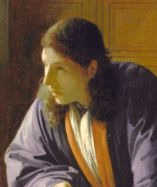
Two Vermeer's exhibited in special Frankfurt anniversary exhibition
Masterworks in Dialogue. Eminent Guests for the Anniversary
Städel Museum, Frankfurt am Main
October 7, 2015–January 24, 2016
http://www.staedelmuseum.de/en/exhibitions/masterworks-dialogue
from the museum website:
The Städel collection looks forward to welcoming a number of international visitors on the occasion of its bicentennial. A show that has been conceived by all the Städel's curators together will confront key works of the institution's own holdings with masterpieces from the most renowned museums over the world.
The approximately 40 encounters of important anniversary guests with works from the Städel's collection will not only yield insights into exciting and sometimes surprising art-historical and historical connections but also unfold a background for reassessing the Städel's own holdings.
Among the paintings exhibited will be Vermeer's Geographer and Lady Writing a Letter with her Maid will be exhibited.
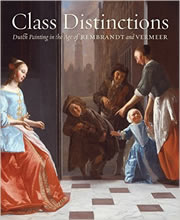
Vermeer-related exhibition in Boston
Class Distinctions: Dutch Painting in the Age of Rembrandt and Vermeer
Museum of Fine Art, Boston
Ann and Graham Gund Gallery (Gallery LG31)
October 11, 2015–January 18, 2016
http://www.mfa.org/exhibitions/class-distinctions
from the CODART website:
Organized by the MFA, this groundbreaking exhibition proposes a new approach to the understanding of seventeenth-century Dutch painting. Included are 75 carefully selected and beautifully preserved portraits, genre scenes, landscapes and seascapes borrowed from European and American public and private collections—including masterpieces never before seen in the US. The show will reflect, for the first time, the ways in which art signals the socioeconomic groups of the new Dutch Republic, from the Princes of Orange to the most indigent of citizens. Class distinctions had meaning and were expressed in the type of work depicted (or the lack thereof), the costumes, a figure's comportment and behavior, or his physical environment. Arranged according to seventeenth-century ideas about social stratification, paintings by artists such as Rembrandt, Vermeer, Jan Steen, Pieter de Hooch, Gerrit ter Borch and Gabriel Metsu, will be divided into three classes—upper, middle and lower—and further sub-divided into eight categories. A final section will explore the places where the classes in Dutch society met one another. Additionally, 45 works of decorative arts—objects used by each class but diverging in material and decoration (for example, salt cellars, candlesticks, mustard pots, linens)—will be installed in three table settings to highlight material differences among the classes. The accompanying publication features essays by a team of distinguished Dutch scholars and exhibition curator Ronni Baer, the MFA's William and Ann Elfers Senior Curator of Paintings.
tickets information:
To order tickets by phone, call 1-800-440-6975; to order in person, visit any MFA ticket desk. Tickets must be purchased prior to the start of the first session; individual sessions are not available.
catalogue:
Class Distinctions: Dutch Painting in the Age of Rembrandt and Vermeer
Ronni Baer, with essays by Henk van Nierop, Herman Roodenburg, Eric Jan Sluijter, Marieke de Winkel, and Sanny de Zoete
about the curator:
from Dutch Culture USA website:
A specialist in seventeenth-century Dutch and Flemish art, Dr. Ronni Baer joined the MFA in 2000 as Senior Curator of Paintings in the Art of Europe Department. Prior to arriving in Boston, she held positions as curator, professor and researcher at numerous museums and higher learning institutions. Baer has overseen the installation of several European galleries in the Museum and was curator of the exhibitions El Greco to Velázquez: Art during the Reign of Philip III (2008), Rembrandt's Journey: Painter | Draftsman | Etcher (co-curated with Cliff Ackley, 2004) and The Poetry of Everyday Life: Dutch Painting in Boston (2002). She was also responsible for the traveling exhibitions, Still Life from the MFA, Boston: Tradition and Innovation (2011, Nagoya/Boston Museum of Fine Arts), Five Centuries of European Portraiture (2006, Nagoya/Boston Museum of Fine Arts) and Gerrit Dou (1613–1675): Master Painter in the Age of Rembrandt' (2000), National Gallery of Art, Washington, DC).
Baer completed her Master's and Ph.D. in art history at the Institute of Fine Arts at New York University, following her undergraduate work in French literature at Emory University (Atlanta). Baer was awarded a Getty Research Institute Guest Museum Scholarship in 2013 and received the Encomienda de la Orden de Isabel la Católica from King Juan Carlos I of Spain in 2008. In addition to authoring the catalogues for the exhibitions above, she is author and editor of the catalogue for the upcoming show, Class Distinctions: Dutch Painting in the Age of Rembrandt and Vermeer.
Vermeer's Young Woman with a Water Pitcher on Tour
Vermeer and Painters of the Dutch Golden Age
Kyoto Municipal Museum of Art, Kyoto
https://www2.city.kyoto.lg.jp/bunshi/kmma/en/2015fiscal_vermeer.html
October 24, 2015–January 5, 2016
from exhibition web page:
Seventeenth-century Holland's withdrawal from religious painting to an emphasis on the appreciation of the everyday opened up a new worldview. It was not only the images of women, wives and their husbands, it was also the mothers within the interior settings and the masters of the kitchens that were painted. Furthermore, it was the fashions that colored lives in feminine cultivation and religious practices that resulted in painted works. These were the opening acts of the "world theater" of women's entry onto the world stage. Vermeer's Young Woman with a Water Pitcher and Rembrandt's Verona are the highlights of this Japan premier.
Vermeer's Young Woman with a Water Pitcher will return in Spring 2016 to the Metropolitan after two other venues in Japan.
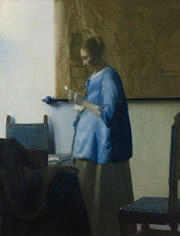
Vermeer's Woman in Blue Reading a Letter travels to Washington D.C.
Vermeer's Woman in Blue Reading a Letter from the Rijksmuseum
National Gallery of Art, Washington D.C.
West Building, Main Floor - Gallery 50C
September 19–December 1, 2015
from the National Gallery of Art website:
In celebration of the 20th anniversary of the Gallery's history-making exhibition Johannes Vermeer (1995–1996), the Rijksmuseum in Amsterdam is lending one of its great treasures: Vermeer's Woman in Blue Reading a Letter.. Last seen in Washington in 1996, this luminous masterpiece has been recently restored and will hang in the Gallery's Dutch and Flemish Cabinet Galleries alongside other works by Vermeer in the permanent collection, including Girl with the Red Hat.
Related Activities
lecture:
The Vermeer Phenomenon
November 15, 2:00–3:30 p.m.
East Building Auditorium
Maygene Daniels (chief of Gallery Archives), Arthur K. Wheelock Jr. (curator of Northern Baroque paintings), and Deborah Ziska (chief of press and public information) give a lecture about the Vermeer exhibition's origins, importance, popularity and impact.
gallery talk:
Woman in Blue Reading a Letter by Johannes Vermeer
September 24–28, 30, 12:00 p.m.
October 8, 21–23, 27–29, 2:00 p.m.
West Building, Main Floor, Rotunda
Diane Arkin or Eric Denker (30 mins.)

Vermeer's Woman in Blue Reading a Letter travels to San Diego
The Private World of Vermeer
The Timken Museum, San Diego CA
May 14–September 11, 2015
The Timken Museum of Art will exhibit one of the finest works by Vermeer from May 14 through September 11, 2015. The exhibition, The Private World of Vermeer, showcases his masterpiece, Woman in Blue Reading a Letter. This generous loan from the Rijksmuseum in Amsterdam marks the first appearance of this remarkable painting in San Diego. The Timken's special installation allows visitors to have an intimate experience with Woman in Blue Reading a Letter and highlights one of the most celebrated painters of the Dutch Golden Age.
The four-month exhibition also features a variety of events, which include noted scholars on Vermeer. Many of the events are free to the public and are designed to give guests an enhanced understanding of the Vermeer and other masterpieces in the Timken's collection:
1. Guest Lecture
"Extraordinary Observation: Vermeer's Woman in Blue"
speaker: Anne Woollett (curator, department of paintings, J. Paul Getty Museum)
Monday, May 18 at 10 a.m.
admission: free
In its compositional refinement and visual impact, Woman in Blue Reading a Letter represents a turning point in Vermeer's career. This lecture considers Vermeer's signature approach—its rapid development in previous works, and the sophisticated handling of space and light in this work and the so-called "pearl pictures."
Anne Woollett is Curator of Paintings at the J. Paul Getty Museum, Los
Angeles. She specializes in northern European painting before 1800,
and is currently working on a catalogue of the Getty's Flemish Baroque
paintings.
2. Art in the Evening Lecture and Reception
speaker: Arthur K. Wheelock (curator of Northern Baroque painting, National Gallery of Art)
Wednesday, June 3
admission: $35 member / $45 non-member
Arthur K. Wheelock is the curator of Northern Baroque painting, National Gallery of Art, Washington, D.C. and author of the 1995 publication Vermeer and the Art of Painting. He is one of the most prolific writers on Vermeer and offers numerous insights linking painting techniques and artistry.
3. Guest Lecture
"Vermeer's Time: The Woman in Blue"
speaker: Ann Jensen Adams (professor, UC Santa Barbara)
Monday, June 8 at 10 a.m.
admission: free
Vermeer's paintings of figures engaged in quiet activities are masterpieces of silence. They have also been described as "stilled lives."This lecture discusses Vermeer's Woman in Blue Reading a Letter in relation to contemporaneous concerns about the passage of time, and its measurement.
4. Free Family Fun
"Tall Tales at the Timken"
Saturday, June 13 at 11 a.m
speaker: Harlynne Geisler
admission: free
Bring your kids to explore Vermeer's Woman in Blue Reading a Letter. Professional storyteller Harlynne Geisler will weave fanciful tales around this masterwork that was created 350 years ago. Ages 5+ are welcome. No reservations required.
5. Art in the Afternoon Gallery Talk
"The Unseen Window in Vermeer's "Woman in Blue Reading a Letter"
Wednesday, June 24 at 12:30 p.m.
speaker: Karen Hellman (assistant curator, department of photographs, J. Paul Getty Museum)
Admission: Free
Although the canvases of Vermeer were created two centuries prior to the invention of photography, their quiet, luminous depictions of interior scenes have often been related to "photographic" qualities. This presentation discusses a few ways in which photography can offer a new lens through which to view Woman in Blue Reading a Letter.
Karen Hellman is an assistant curator in the department of photographs at the J. Paul Getty Museum. She is the curator of the exhibitions, In Focus: Picturing Landscape (2012), At the Window: The Photographer's View (2013), and In Focus: Ansel Adams (2014). Currently she is working on a forthcoming exhibition In Focus: Daguerreotypes (fall 2015). She received her master's in art history from the Institute of Fine Arts at New York University, in 2004, and she received her doctorate in art history from The Graduate Center, The City University of New York, in 2010.
6. Art in the Afternoon Gallery Talk
"Discordant Serenity and the Painting of Vermeer"
July 1 | 2:30 p.m.
speaker: Claudine Dixon (curatorial administrator, prints and drawings, Los Angeles County Museum of Art)
admission: free
Vermeer's Woman in Blue Reading a Letter will be discussed in the context of some of the historical and contemporary events surrounding the painting and its fantastic journey from seventeenth-century Delft in the Netherlands to recent visits to Southern California. The writings of various authors, including essayist Lawrence Washer and poet W. H. Auden, offer variant paths to consider thoughts and musings about history and art, allowing us to look at our relationship to this picture and think about a perspective that lies beyond the painted surface.
Claudine Dixon is the curatorial administrator for the department of prints and drawings at the LACMA. Before joining LACMA, Claudine worked at the UCLA Grunwald Center for the Graphic Arts at the Hammer Museum. In addition to museum positions, she has taught art history courses for UCLA Extension, most notably on German art of the 19th and 20th centuries, and Rembrandt and Dutch art of the seventeenth century.
7. Guest Lecture
"The Interior Life of Vermeer"
Monday, July 13 | 10 a.m.
Amy Walsh (curator of European paintings, Los Angeles County Museum of Art)
admission: free
Gallery talks feature leading curators, historians, scholars and artists. Guests will walk, talk and explore the Timken collection and special exhibitions. Registration is not required.
For more events and details about The Private World of Vermeer, visit the website at www.timkenmuseum.org or call (619) 239-5548.
About the Timken Museum of Art
Known as one of the finest small museums in the world, the Timken Museum of Art celebrates its 50th anniversary in 2015, and provides visitors with an accessible and enriching cultural experience featuring a beautiful collection, intimate surroundings, and free admission.
The museum is open from 10 a.m. to 4:30 p.m. Tuesday through Saturday and Sundays, noon to 4:30 p.m. It is closed on Mondays and major holidays. For more information, visit http://www.timkenmuseum.org. Follow the museum on Facebook or Twitter at @TimkenArtMuseum or call (619) 239-5548.
Walter Liedtke dies in tragic train crash
Walter Liedtke, Curator of Metropolitan Museum of Art and renowned Vermeer expert as well as one of the most distinguished scholars of Dutch and Flemish painting in the world, died in the train incident outside New York on the evening of February 3. Walter was returning to his home in Bedford Hills, where he lived with his wife, Nancy. As was his habit, he was riding the front "quiet car," in which he found the tranquility necessary for writing and reading. Five other people died in the accident.
Walter conjugated culture, curiosity, passion and rigor in whatever he wrote and in all the exhibitions he curated, whether it be the monumental Vermeer and the Delft School or the intimately scaled Vermeer's Masterpiece: 'The Milkmaid'. The catalogue of the former remains a fundamental contribution to the proper contextualization of the artist. His monograph (Vermeer: The Complete Paintings) constitutes a finely nuanced reading of the artist's unique accomplishments in the light of modern Vermeer scholarship. But Walter interest in things Vermeer was wide and varied enough to comprise a computerized analysis of the weave of the artist's canvases or the opinions from practicing artists and art lovers outside of the art institutional setting.
Walter's energy, brilliance and organizational capacity allowed him to publish extensively and curate a number of key exhibitions at the Metropolitan.
His most important exhibitions include:
Vermeer: il secolo d'oro
dell'arte olandese (September 2012-January 2013), Rembrandt at Work: The Great
Portrait from Kenwood House (April-May 2012), Vermeer's Masterpiece: The
Milkmaid (September-November 2009), The Age of Rembrandt: Dutch Paintings in
the Metropolitan Museum of Art (September 2007-January 2008) and Vermeer and
the Delft School (June-September 2001). The latter brought in over 500,000 visitors to the Metropolitan.
His most important publications include:
Vermeer: The Complete Paintings (2008), Dutch Paintings in the Metropolitan Museum of Art (2001), Vermeer and
the Delft School (1995), Rembrandt/not Rembrandt in the
Metropolitan Museum of Art: Aspects of Connoisseurship (1992) and Flemish
Paintings in the Metropolitan Museum of Art (1982).
remembering Walter:
The young Walter Liedtke
—Garry Schwartz
http://www.garyschwartzarthistorian.nl/schwartzlist/?id=198
Walter Liedtke: A Reflection and Appreciation
—Arthur K. wheelock Jr.
http://www.wsj.com/articles/walter-liedtke-a-reflection-and-appreciation-1423263645
Walter Liedtke, Our Friend and Distinguished Colleague (1945–2015)
—Thomas P. Campbell
Walter Liedtke, Curator at Metropolitan Museum of Art, Dies at 69
—Randy Kennedy
http://www.nytimes.com/2015/02/05/arts/design/walter-liedtke-curator-at-metropolitan-museum-of-art-dies-at-69.html?_r=0
video testimonies:
Mr. Liedtke's Metropolitan presentation, Connections/Living with Vermeer:
http://www.metmuseum.org/connections/living_with_vermeer#/Feature/
Youtube video Mr. Liedtke's discussion of Rembrandt's Aristotle and Bust: https://www.youtube.com/watch?v=B2dCeTPDEKY
Vermeer-related publication 
VERMEER (ARTS AND IDEAS)
by Wayne Franits
March 23, 2015
https://amzn.to/3DGohrr
In this new monograph, the latest in Phaidon's Art and Ideas series, Wayne Franits examines the work of Vermeer within the framework of his times, one of the most intellectually creative periods in this history of art. Written in a lively and accessible style, and incorporating the latest scholarship on the artist, Franits provides fresh insights into many of Vermeer's most famous works, uncovering the creative process behind them and their wealth of meanings. All paintings by Vermeer are illustrated.
about the author:
Wayne Franits, a specialist in seventeenth-century Dutch and Flemish art, is Professor of Art History at Syracuse University, New York. His numerous publications have explored a variety of topics within the field, ranging from genre painting and portraiture to the work of the Dutch followers of Caravaggio.
also available at amazon.com
Surprise exhibition of Vermeer's Woman in Blue Reading a Letter in Minneapolis
MASTERPIECE IN FOCUS: JOHANNES VERMEER
Minneapolis Institute of Arts (Cargill Gallery)
Minneapolis, Minn.
January 16–May 3, 2015
price: free of charge
http://new.artsmia.org/masterpiece-in-focus/
article:
"On Vermeer's Girl Reading a Letter: A Q&A with MIA's Patrick Noon"
by Pamela Espeland
http://www.minnpost.com/artscape/2015/01/vermeers-woman-reading-letter-qa-mias-patrick-noon
lecture:
Lawrence
Weschler | "Posers: Marvel, Majesty and Sovereignty among the Habsburgs and in Vermeer"
Sunday, April 19, 2015 at 2:00 pm
http://new.artsmia.org/event/lawrence-weschler-%C7%80-posers-marvel-majesty-and-sovereignty-among-the-habsburgs-and-in-vermeer/
With one of the world's finest Vermeer paintings presently residing at the MIA alongside a magnificent exhibition of Habsburg splendors, Lawrence Weschler will unpack a posit about posing and the posed. Kings, queens, noblemen and noblewomen are continually striking a pose, but who exactly is posing whom (and what?) when a painter attempts to capture that stance? And what was Vermeer up to when he set about capturing something altogether new and different in his portraits? In other words, what does it mean to be sovereign—sovereign over what, in whose eyes, and to what end?
Lawrence Weschler is director emeritus of the New York Institute for the Humanities at NYU and author of such books as Vermeer in Bosnia and Mr. Wilson's Cabinet of Wonder.
$10; $5 MIA members; free for Paintings Affinity Group members. To register, call (612) 870-6323 or reserve online.
THE STREAM AND THE TORRENT –
THE CURIOUS CASE OF JAN TORRENTIUS AND THE
FOLLOWERS OF THE ROSY
by Brian Howell
2014
Limited to 82 numbered copies
http://www.zagava.de/?post_type=books&p=277
"Having been rescued from prison and torture in Haarlem, as of 1632 Torrentius is confined to a secret chamber in White Hall to be the King's painter. He is not allowed to go out except at night and the early morning and must show a special pass to the guards. After making the acquaintance of a fellow Dutch painter one morning, Simon, he visits him and his wife, who reminds him of one of his many amours in Holland. Later, King Charles asks him to do a portrait of himself and his wife."
So begins a fascinating novel of history, magic and moral terror. A grand oeuvre in the tradition of Leo Perutz.

Vermeer's Christ in the House of Martha and Mary goes on world tour
Vermeer's Christ in the House of Martha and Mary will form part of a touring exhibition of America and Australia and will return to the Scottish National Gallery in February of 2016.
Botticelli to Braque: Masterpieces from the National Galleries of Scotland
Kimbell Art Museum, Fort Worth Texas
June 28-September 20, 2015
The Greats: Masterpieces from the National Galleries of Scotland
The Art Gallery of New South Wales, Sydney, Australia
October 24, 2015–February 14, 2016
Vermeer's Astronomer travels to Japan
LOUVRE
MUSEUM: GENRE PAINTING -
SCENES FROM DAILY LIFE
The National Art Center, Tokyo, Japan
February 21–June 1, 2015
From the museum website:
Genre painting refers to works that deal with the subject of everyday life. This exhibition, made up of 83 works that were carefully selected from the Musée du Louvre's massive collection, traces the development of genre painting across four centuries, from the Renaissance to the mid-19th century.
In addition to Vermeer's Astronomer, which will be shown in Japan for the first time, the exhibition presents works by prominent painters from every era and region including Titian, Rembrandt, Murillo, Watteau, Chardin and Millet, allowing viewers to enjoy the diverse charms of genre painting.

Vermeer-related lecture
LUNCH HOUR LECTURE: VERMEER'S CAMERA AND TIM'S VERMEER
Philip Steadman
Darwin Lecture Theatre, Darwin Building, London
March 5, 2015
price: free
contact: +44 (0)20 3108 3841 | events@ucl.ac.uk
http://events.ucl.ac.uk/event/event:vi9-i3a4g43z-yedit6/lunch-hour-lecture-vermeers-camera-and-tims-vermeer
In 2001, Philip Steadman published Vermeer's Camera, a book that offered new evidence that the great Dutch painter relied on optical methods. An American video engineer Tim Jenison read the book and, believing he could take the argument further, proposed a simple arrangement of lens and mirrors that Vermeer might have employed. Jenison used this setup to paint a version of The Music Lesson in the Queen's collection. The process was filmed for the Oscar-shortlisted documentary Tim's Vermeer, released in 2014. Jenison's method throws more light, literally, on how Vermeer could have achieved his distinctively "photographic" tonal effects.
The lecture will be streamed live online and recorded for YouTube or downloaded.

Vermeer-related lecture
MILTON ESTEROW: REDISCOVERIES IN ART
Milton Esterow
March 25, 2015 | 7 p.m.
Lexington Avenue at 92nd St
Warburg Lounge
price: from $30.00
http://www.92y.org/Event/Milton-Esterow-Rediscoveries-in-Art.aspx
from the 92/Y website:
It seems unimaginable now, but the works of Piero della Francesca and Vermeer were forgotten and neglected for longer than they have been admired. No other great painter has been overlooked for such a long time as Botticelli. Hardly anyone paid much attention to Frans Hals and Giotto for many years. Why have tastes in art have been changing since art first came into being? Milton Esterow, former publisher of ARTnews, gives a fascinating perspective.
Can't make it to the event? Leave your questions for our guests below, and they might be used on stage during the Q&A. Keep an eye on 92Y On Demand after the event for any video clips we might share! You might see your question used on stage. http://92yondemand.org

Vermeer lecture
Eye of the Beholder: Johannes Vermeer, Antoni van Leeuwenhoek, and the Reinvention of Seeing
Laura Snyder
1 Session: Wednesday, April 8 | 7:00–8:30 p.m.
location: The Arnold Arboretum of Harvard University, 125 Arborway, Boston, MA 02130, Hunnewell Building
Fee $5 member, $10 nonmember Students: email to register for free.
from the Arnold Arboretum of Harvard University website:
"See for yourself!" was the clarion call of the 1600s. Scientists peered at nature through microscopes and telescopes, making the discoveries in astronomy, physics, chemistry and anatomy that ignited the Scientific Revolution. Artists investigated nature with lenses, mirrors and camera obscuras, creating extraordinarily detailed paintings of flowers and insects, and scenes filled with realistic effects of light, shadow and color. By extending the reach of sight the new optical instruments prompted the realization that there is more than meets the eye. But they also raised questions about how we see and what it means to see. In answering these questions, scientists and artists in Delft changed how we perceive the world. Author of The Philosophical Breakfast Club, a Scientific American Notable Book, Laura Snyder returns to the Arboretum to share her latest book, Eye of the Beholder, in which she pairs painter with natural philosopher to explain the revelatory ways of seeing in the seventeenth century.
Fee $5 member, $10 nonmember Students: Email to register for free.
Exhibition of three Vermeer paintings in Budapest
REMBRANDT AND THE DUTCH GOLDEN AGE
Szépművészeti Múzeum, Budapest
31 October, 2014–15 February, 2015
Rembrandt and the Painting of the Dutch Golden Age, a large-scale exhibition to run in the Museum of Fine Arts from 1 November surveys the period of seventeenth-century Dutch art, one of the golden ages of European culture. The exhibition is built around Rembrandt, the greatest master of the period, by whom 20 masterpieces will be on display. The exhibition will showcase over 170 works by some 100 painters, of which 40 originate from the Museum of Fine Arts' rich Dutch collection and 130 paintings will be contributed by private and public collections, with the most important loaning institutions including the Rijksmuseum in Amsterdam, the National Museum in Stockholm, the Louvre in Paris, the National Gallery in London, the Getty Museum in Los Angeles, the Metropolitan in New York, the Uffizi in Florence and the Prado in Madrid. A further sensation of the exhibition is that in addition to the significant number of works by Rembrandt, including the painting known as his earliest and his last self-portrait.
Visitors can also view three works by Vermeer: The Astronomer, The Geographer and The Allegory of Faith.
click here for museum page:
http://www.szepmuveszeti.hu/exhibitions/rembrandt-and-the-painting-of-the-dutch-golden-age-1427
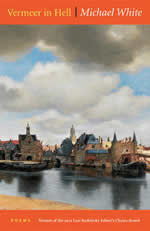
Vermeer inspired poetry and memoir
Vermeer in Hell
by Michael White
2013
https://amzn.to/3PmAm7I
from publisher's website:
Through the paintings of Vermeer, Michael White explores new landscapes and transforms familiar ones in this extraordinary new collection of poems. This captivating masterwork transports us across eras and continents, from Confederate lynchings to the bombing of Dresden, through its lyrical inhabitations of some of Vermeer's most revered paintings, each one magically described and renewed. More than mere ekphrasis, Michael White explores the transformative possibilities of great art in his fourth collection.
reviews:
"Vermeer in Hell is Michael White's museum of ghosts and shades, of narratives woven masterfully out of the personal and historical alike—out of the lived, the envisioned, the loved, and the terrible. Rarely have I felt the ekphrastic to be as dramatic as in White's tour through the portraits of Vermeer, with its history of fiery damages, wars and afflictions, but also its own depiction of 'love's face as it is.' Out of Michael White's vision, each poem achieves for us the delicacy and durability of Vermeer's own art."
—David Baker
"Nearly every one of Michael White's new poems is the equivalent of a quiet stroll through a blazing fire, igniting the reader's imagination. His insights are frightening and comforting at the same time, his craft allowing for the most surprising and thrilling of associations. Vermeer in Hell is a collection that belongs in the room with all of the traditions of our language's poetry, but it brings something completely original to us, too. It is not an overstatement to call this poetry Genius."
—Laura Kasischke
"In these elegant, powerful poems, Michael White pays homage to a great painter while engaging social realities that affect us all. They are brave, beautiful poems linked by authentic vision and a sensitive, educated ear."
—Sam Hamill
Travels in Vermeer: A Memoir
by Michael White
2015
https://amzn.to/3PmC0X9
from the publisher's webpage:
In the midst of a bad divorce, the poet Michael White unexpectedly discovers the consoling power of Johannes Vermeer's radiant vision. Over the course of a year, he travels to Amsterdam, The Hague, Delft, Washington D.C., New York, and London to view twenty-four paintings, including nearly all of Vermeer's major work.
"A certain chain of events has left me open, on a startlingly deep level, to Vermeer's gaze, to his meditation on our place on earth," White writes.
Part travelogue, part soul-searching investigation into romantic love and intimate discourse on art, this erudite and lyrical memoir encompasses the author's past—his difficult youth, stint in the Navy, alcoholism and the early death of his first wife—and ends with his finding grace and transformation through deeply affecting encounters with the paintings of Vermeer, an artist obsessed with romance and the inner life, who has captivated millions, from the seventeenth century until now.
reviews:
"All the sorrow of love is compressed into White's memoir. But so, too, is all the consolation of art. Nothing I've read...suggests so eloquently what [Vermeer's paintings] hold for a contemporary viewer…Figures it took a poet to get it this beautifully, thrillingly right."
— Peter Trachtenberg
"[Travels in Vermeer] touches on the mysteries of seduction, loss and the artistic impulse. It shows how time can be interrupted."
—Clyde Edgerton
"This book is a treasure and a guide. It is a type of healing for the intellect and the heart."
—Rebecca Lee
about the author:
Michael White is the author of four collections of poetry and a memoir, Travels in Vermeer (Persea 2015), and has published widely in respected periodicals, including The Paris Review, The New Republic, The Kenyon Review, Ploughshares, Western Humanities Review, and the Best American Poetry. White teaches poetry and is presently chair of the Creative Writing department at the University of North Carolina, Wilmington.
publisher's webpage:
https://amzn.to/3PmAm7I
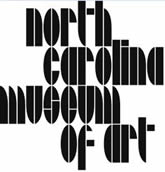
Vermeer-related exhibition
Small Treasures: Rembrandt, Vermeer, Hals and their ContemporariesOctober 12, 2014–January 4, 2015
North Carolina Museum of Art, Raleigh, NC
from the museum website:
Small Treasures: Rembrandt, Vermeer, Hals and Their Contemporaries represents the first exhibition to focus exclusively on small-format seventeenth-century Dutch and Flemish figure paintings. Many of the century's greatest masters contributed to this tradition: pictures by Anthony van Dyck, Adriaen Brouwer, David Teniers, Frans Hals, Rembrandt, Vermeer, Jan Steen, Gerard ter Borch, Gerrit Dou, and Frans van Mieris are featured in the exhibition. Drawn primarily from public and private collections throughout the United States, the works in Small Treasures showcase the quality, skill and diversity these artists brought to their small miracles in paint. Viewers encounter various portrait formats and types, including group and individual portraits, self-portraits, allegorical portraits, and tronies, a Dutch word for faces or character studies. A handful of genre and history paintings are also shown in order to provide a larger context for the portraits. A fully illustrated catalogue accompanies the exhibition, featuring all of the exhibited paintings reproduced in full size.
The exhibition includes:
Johannes Vermeer, Girl with a Red Hat (c. 1665–1667)
Johannes Vermeer, A Young Woman Seated at the Virginals (c. 1670), 9 7/8 x 7 7/8 in.
Adriaen Brouwer, Youth Making a Face (c. 1632–35), 5 3/8 x 4 1/8 in.
Rembrandt van Rijn, Portrait of an Old Man with a Beard (c. 1630)
Anthony van Dyck, Portrait of Nicholas Rockox (1636), 6 in. diam. (round)
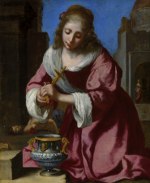
Saint Praxedis sold for $10,687,160
The London-based auction house Christie's reported via a Twitter feed that the Saint Praxedis (101.6 x 82.6 cm.) was sold on Tuesday, July 8 for $10,687,160 (£6,242,500). This figure barely higher that than the auction house's lowest estimate of $10,284,000 but considerably lower than the upper estimate of $13,712,000. The painting was sold after a few bids to an Asiatic client.
The low price paid for the Saint Praxedis suggests that the results of the scientific analysis were less than convincing and that it was bought in hopes that future critical or scientific investigations will strengthened its attribution.
In 2004, Sotheby's sold the minuscule A Young Woman Seated at the Virginals (25.2 x 20 cm.) for $42 million (£16.2 million) a price five times greater than the auction house's initial estimate. Previous to the two sales, the authorship of both works had been for debated for decades. On occasion of the sales the picture were proposed as authentic Vermeer's largely the basis of scientific analysis spearheaded, in both cases, by the respective auction houses.
Before the painting was sold, Christie's reported that after having examined the picture the conservator Libby Sheldon said that although no firm conclusion about the exact date of the picture's Vermeer signature could be reached, she believed that it is nonetheless "old." In 1998, Jørgen Wadum, then the chief curator of the Mauritshuis, stated that the signature had been added after the painting had been completed. Tests carried out by the Rijksmuseum show that the lead component of the lead white pigment extracted from the picture derives from a northern European source making it improbable that the picture was painted in southern Europe, as some critics had speculated. In addition, Christie's claims that the lead white used to paint the Saint Praxedis is from the same "batch" used to painted the Diana and her Companions, a secure work by Vermeer.
However, since the results of these tests have not been published, for the moment it is not clear what meant by the term "batch." Many pigments used by artists, including white lead, were already being produced on a large scale with the products being delivered to the retail dealers. There exists no evidence that might indicate if Vermeer prepared his own paints or bought them through one or other commercial venues.
Mauritshuis Opening on 27 June, 2014
The Mauritshuis will open its doors on Friday 27 June, 2014 after a two-year renovation.
The world famous painting collection, including three paintings by Vermeer, Girl with a Pearl Earring, View of Delft and Diana and her Companions, will once again be displayed in the fully renovated and expanded Mauritshuis. After a celebratory opening, the museum will be open to the public for visit free of charge until midnight. The renovated Mauritshuis doubles its surface with an underground expansion into a building on the other side of the street. Still, little about the character of the museum will change. The appearance and unique homely atmosphere are preserved, thanks to the design of Hans van Heeswijk architects. The most obvious change is the relocation of the main entrance to the forecourt. Visitors will descend via the stairs or lift to a light foyer, connecting 'old' and 'new' underground. The new part, the Royal Dutch Shell Wing, will house the exhibition space, the brasserie and the museum shop. Furthermore, it will accommodate the educational Art Workshop, a library, and event rooms.
The museum has also renovated its website and has added new high-resolution image is their Vermeer's paintings which can be viewed with a zoom feature or downloaded to one's hard disk. The downloadable images are lower resolution than the zoom versions.
zoom features:
Girl with a Pearl Earring
View of Delft
Diana and her Companions
downloads:
Girl with a Pearl Earring
View of Delft
Diana and her Companions
Mauritshuis
Korte Vijverberg 8
2513 AB The Hague
P.O. Box 536
2501 CM The Hague

Another new Vermeer?
On June 6, Christie's announced that it was declaring the Saint Praxedis a Vermeer. According to Henry Pettifer, the head of Old Master paintings at Christie's, after isotope analysis tests carried out by scientists at Amsterdam's Rijksmuseum and Free University, it was found that the lead white of the painting was a precise match for that used in another early Vermeer, Diana and her Companions—"So precise as to suggest that the same batch of paint could have been used." He stated that the research, including an analysis of the date and signature on the painting, amounted to "a compelling endorsement" of Vermeer's authorship. In the event that the painting is accepted by art scholars as an authentic Vermeer, it will become the second once-doubted painting in ten years to be accepted into the painter's thin oeuvre largely on the basis of technical analysis.
The auction house excepts the work could fetch about $13 million when it is auction in early July. The work is part of the collection of Barbara Piasecka Johnson, a Polish-born art-lover who amassed a huge trove of art after marrying Johnson & Johnson heir J. Seward Johnson. Piasecka died last year.
Click here to access the Christie's PDF online catalogue entry for the Saint Praxedis for art which contains further art historical and technical information.
Old Master & British Paintings Evening Sale
Christie's
8 King Street, St. James's, London - Tuesday, July 8, 2014 at 6:00 pm
viewings:
Saturday, July 5 10:00 a.m.–5:00 p.m.
Sunday, July 6 10:00 a.m.–5:00 p.m.
Monday, July 7 9:00 a.m.–4:30 p.m.
Tuesday, July 8 9:00 a.m.–3:30 p
The Painting
The painting is believed to be a copy of a work by Felice Ficherelli (1605–1669 ?) from about 1640–1645, now in the Collection Fergnani in Ferrara. It represents the early Roman martyr, Saint Praxedis or Praxedes, who squeezes a martyr's blood from a sponge into an ornate vessel. The most obvious difference between the copy and the original is that there is no crucifix in the Ferrara work.
Critical Fortunes
The painting's provenance before the mid-twentieth century is unknown. The collector Jacob Reder bought it at a minor auction house in New York in 1943. The painting was first publicly viewed in 1969 when it was exhibited at the Metropolitan Museum of Art as a work by Felice Ficherelli in the exhibition Florentine Baroque Art from American Collections, no. 39. Vermeer's signature in the lower left was noted in the catalogue after it had been examined by Ted Rousseau and members of the conservation department at the Metropolitan Museum of Art.
After the work appeared in New York exhibition, it was first published (1969) as a Vermeer by Michael Kitson, an art historian with the University of London. Kitson believed the signature was integral with the paint surface and "the form of the signature corresponds exactly to those on Vermeer's early works, particularly the Girl Asleep." Kitson likened the Saint Praxedis copy to Vermeer's Christ in the House of Martha and Mary, for its "breadth of form and handling and a similar gravity (though not sickness) of mood."*
In 1986, Arthur K. Wheelock Jr. enthusiastically embraced the work as an authentic Vermeer** the citing the stylistic and technical similarities with the two early Vermeers and the essentially Dutch character of the modeling of Saint Praxedis' face, which he compared to the down turned head of Vermeer's Maid Asleep. Wheelock noted two signatures. One, at the lower left was the name "Meer" and the date "1655." On the suggestion of Egbert Haverkamp-Begemann, Wheelock advanced that the other inscription contained the word "Meer," followed by the letter "N," the letter "R," then two lower case "o's." Wheelock holds that both the signatures and the date are integral to the paint surface and that the second could be interpreted as: "[Ver]Meer N[aar] R[ip] o [s] o" or "Vermeer after Riposo," Ficherelli's Italian nickname (Repose).
However, on the occasion of the 1994–1995 Vermeer Washington/The Hague exhibition where the work was shown by Wheelock as the earliest known painting by Vermeer, its authenticity was seriously contested by a number of art historians and conservators. Jørgen Wadum, then the chief curator of the Mauritshuis, firmly stated that the "Meer 1655" inscription had been added after the painting had been completed. Contrary to Wheelock, he believed the brushwork of Saint Praxedis had nothing to do with the brushwork of either the Diana and her Companions or the Christ in the House of Mary and Martha. He also noted that no smalt, a dull blue pigment which is now obsolete, had been detected in the Saint Praxedis while both the Christ in the House of Mary and Martha and the Diana and her Companions had significant amounts of smalt.
When Saint Praxedis was examined by Marten Jan Bok, a specialist on the seventeenth-century Utrecht painter Johannes van der Meer, he was unable even to see the second inscription, and in any case, he wrote "nowhere in seventeenth-century Dutch painting will you find such an inscription on a copied painting."
Ben Broos found that Wheelock's interpretation of the signature as "Meer naar Riposo" was "wishful thinking" at best. "In my opinion, Saint Praxedis is the latest wrongly attributed Vermeer of the caliber of Van der Laan and Vrel." Other experts such as Albert Blankert, Gregor J. M. Weber, and the National Gallery in London's Christopher Brown have arrived at similar conclusions.
In 2002, Jon Boone wrote, "In looking at Saint Praxedis one does have a hard time understanding its attribution to Vermeer. It is a second-rate copy of a mediocre painting by an undistinguished artist, with certain features—such as the awkward wrap-around hands—antithetical to Vermeer's sensibility as well as his draftsmanship. While the face itself is beautiful, certainly more charming than that of the original, it is still a facsimile face, a close copy of the source." And further: "The Saint Praxedis attribution is severely strained, failing the standard of Ockham's razor: The simplest explanation covering all the facts of the case is that the painting is a copy executed either by the original painter, Ficherelli, in Florence, or by another artist in Ficherelli's circle." ***
In fact, there is no evidence that Vermeer had ever visited Italy or that the Ficherelli's original, or an eventual copy, had ever traveled outside the country.
Ivan Gaskell had written earlier "that as a result of, first, examining the painting while exhibited in Washington (scarcely optimal conditions) in conjunction with Vermeer's two early history paintings, secondly, of discussing the work with specialist colleagues, and, thirdly, reviewing the published arguments, I feel unable to accept an unqualified attribution of Saint Praxedis to Vermeer."
In his 2008 complete catalogue of Vermeer's painting, Walter Liedtke does not even mention the Saint Praxedis, while in 2009 he wrote "the repetition is probably by the Florentine painter [Ficherelli] himself." ****
* KITSON, Michael. "Florentine Baroque Art in New York." Burlington Magazine, Vol. 111, No. 795 (Jun., 1969). 409–410.
** WHEELOCK, Arthur K. Jr. "'St. Praxedis': New Light on the Early Career of Vermeer." Artibus et Historiae, Vol. 7, No. 14 (1986). 71–89.
*** BOONE, Jon. "Saint Praxedis: Missing the Mark," Essential Vermeer, 2002.
**** LIEDTKE, Walter: Vermeer: The Milkmaid. The Metropolitan Museum of Art, New York. 2009. note 5, 23.
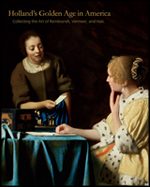
New Vermeer-related publication
Holland's Golden Age in America: Collecting the Art of Rembrandt, Vermeer and Hals
by Esmée Quodbach
ed. New York (The Frick Collection) and University Park (The Pennsylvania State University Press)
2014
From the Pennsylvania State University Press website:
Americans have long had a taste for the art and culture of Holland's Golden Age. As a result, the United States can boast extraordinary holdings of Dutch paintings. Celebrated masters such as Rembrandt van Rijn, Johannes Vermeer, and Frans Hals are exceptionally well represented, but many fine paintings by their contemporaries can be found as well. In this groundbreaking volume, fourteen noted American and Dutch scholars examine the allure of seventeenth-century Dutch painting to Americans over the past centuries. The authors of Holland's Golden Age in America explain in lively detail why and how American collectors as well as museums turned to the Dutch masters to enrich their collections. They examine the role played by Dutch settlers in colonial America and their descendants, the evolution of American appreciation of the Dutch school, the circumstances that led to the Dutch school swiftly becoming one of the most coveted national schools of painting, and, finally, the market for Dutch pictures today. Richly illustrated, this volume is an invaluable contribution to the scholarship on the collecting history of Dutch art in America, and it is certain to inspire further research.
In addition to the editor, the contributors are Ronni Baer, Quentin Buvelot, Lloyd DeWitt, Peter Hecht, Lance Humphries, Walter Liedtke, Louisa Wood Ruby, Catherine B. Scallen, Annette Stott, Peter C. Sutton, Dennis P. Weller, Arthur K. Wheelock, Jr., and Anne T. Woollett.
This book provides answers for anyone who has ever wondered why there are so many great Dutch paintings in U.S. collections. Essays by leading curators and scholars draw on the history of art, as well as an understanding of cultural, economic and political conditions, to illuminate the American taste for seventeenth-century Dutch painting.
— Emilie Gordenker, Director, Mauritshuis, The HagueDrawing on the experience and insights of many of her colleagues in museums and the academy, Esmée Quodbach brings us an impressively broad overview of the early collectors of Dutch art in America. This essential volume provides illuminating context for major figures such as J. P. Morgan and welcomes unsung heroes such as Robert Gilmor, Jr., onto this stage, but also lifts the curtain on early colonial as well as contemporary collections. These varied accounts are spiked with color, drama and highlights, including the story of the wealthy collector who has to ask, "Who is Vermeer?"
— David de Witt, Bader Curator of European Art, Queen's University
Esmée Quodbach is Assistant Director of the Center for the History of Collecting at The Frick Collection and Frick Art Reference Library in New York.
http://www.psupress.org/books/titles/978-0-271-06201-3.html
CONTENTS
Foreword
— Esmée Quodbach
Introduction: A Taste for Dutch Art
— Peter C. Sutton
PART I
The Early Years: The Formation of America's Taste for Dutch Art
1. Pictures chiefly painted in oils, on board": Dutch Paintings in Colonial New York
— Louisa Wood Ruby
2. Robert Gilmor, Jr.'s "Rea" Dutch Paintings
— Lance Humphries
3. Collecting Old Dutch Masters: Originals, Interpretations, Copies and Reproductions
— Annette Stott
4. Wilhelm von Bode and Collecting in America
— Catherine B. Scallen
PART II
The Gilded Age: Great Collections and Collectors of Seventeenth-Century Dutch Art
5. Golden Age Paintings in the Gilded Age: New York Collectors and the Metropolitan Museum of Art, 1870–1920
— Walter Liedtke
6. "They leave us as they find us, they never elevate": John G. Johnson and the Dutch Masters
— Lloyd DeWitt
7. Collecting Vermeer, 1887–1919
— Esmée Quodbach
8 Collecting Dutch Paintings in Boston
— Ronni Baer
9. The Dutch Painting Collection at the National Gallery of Art
— Arthur K. Wheelock, Jr.
PART III
The Twentieth Century: The Dissemination of Dutch Art Across America and the Dutch Reaction
10. The Passionate Eye of W. R. Valentiner: Shaping the Canon of Dutch Painting in America
—Dennis P. Weller
11. Unexpected Rivals for the Dutch: Competing with the Americans for Holland's National Heritage in Great Britain and Elsewhere
— Peter Hecht
12. Golden Opportunities: Collecting Rembrandt in Southern California
— Anne T. Woollett
13. Has the Great Age of Collecting Dutch Old Master Paintings Come to an End?
— Quentin Buvelot
National Gallery of Art Online Editions
from the NGA website:
Available for the first time on the National Gallery of Art website, NGA Online Editions presents the most current, in-depth information on the Gallery's collections by the world's leading art historians along with rich capabilities for exploring that information. A customized reading environment and toolkit for managing text and images are intended both to provide scholars with a useful workspace for research and to encourage the study and appreciation of art.
NGA Online Editions launches with Dutch Paintings of the Seventeenth Century by Gallery curator Arthur K. Wheelock Jr. and will ultimately document more than 5,000 paintings, sculptures and decorative arts in the nation's collection. Editions include an introduction by the curator, illustrated scholarly entries (each preceded by a short overview), artists' biographies, technical summaries, and a complement of rich media, educational materials, and appendices related to the featured collection. Formerly known as The Collections of the National Gallery of Art Systematic Catalogue (a printed series of authoritative volumes on the Gallery's permanent collections), NGA Online Editions puts this same detailed information—and more—at the fingertips of students, scholars and anyone eager to learn more about the treasures of the National Gallery of Art.
Here are the relative pages:
National Gallery of Art
Online Editions
http://www.nga.gov/content/ngaweb/research/online-editions.html
Dutch Paintings of the Seventeenth Century
http://www.nga.gov/content/ngaweb/research/online-editions/17th-century-dutch-paintings.html
Johannes Vermeer
http://www.nga.gov/content/ngaweb/Collection/artist-info.1951.html?artobj_artistId=1951&pageNumber=1
Is Vermeer's stolen Concert closer to being recovered?
At 1:24 a.m. of March 18, 1990, two thieves stole thirteen works of art from the Italianate mansion Isabella Stewart Gardner Museum in Boston, including Vermeer's mid-career masterpiece, The Concert. None of the paintings have been recovered. In the years following the theft, most of the leads went cold. Billboards announcing the a $5,000,000 reward for information about the theft and the arrest if a Boston mob leaders suspected of having information on the heist yielded nothings. Until 2013.
On 19 March, 2013, on the 23rd anniversary of the crime, the FBI made the stunning announcement that they knew who was behind 1990 theft, but they did not supply names because the investigation was ongoing.
On May, 2013, Robert Gentile, 76, convicted of receiving stolen goods, carrying a deadly weapon in a motor vehicle and possession of illegal firearms, was arrested. Police suspected he knew something about the heist. Gentile denied knowing anything but failed a FBI polygraph test when asked if he knew anything about the Boston heist. Moreover, a police investigation in Gentile's house turned up a handwritten list of the stolen paintings, their estimated worth and a newspaper article about the heist a day after it happened.
And now, an FBI agent in charge of the investigation for the bureau says there are confirmed sightings of the missing artwork from credible sources. FBI Special Agent Geoff Kelly told MyFoxBoston.com, "We believe that over certain periods of time, this artwork has been spotted." Up until now, there were no official sightings of the artwork.
Two FBI informants told law enforcement that Carmello Merlino was planning to return Rembrandt's "The Storm on the Sea of Galilee" in the 1990s, to try to collect reward money. His plans were foiled when he was arrested for an aborted armored car heist, according to MyFoxBoston.com.
All about the theft of The Concert.
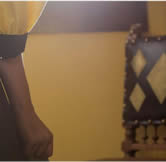
Vermeer painting recreated in video
Girl Reading a Letter at an Open Window
Video installation by Menno Otten
35 mm celluloid
from the film maker's website:
Johannes Vermeer's Girl Reading a Letter at an Open Window has been recreated by filmmaker Menno Otten as a continuous picturesque loop, subtly evolving around Vermeer's masterpiece. Due to its duration and inconspicuous development the installation is seen as a still at first glance, only to reveal its true form in the following moments. In an elegant symbiosis between the expressive moment and dynamic movement a timeless masterpiece comes to life.
Only in the last century have the visual arts surpassed the limitations of 'mere' suggestions of movement. And yet the time-space continuum of cinematography hasn't diminished the expressive power of the single two-dimensional image. On the contrary, the introduction of motion into the visual arts made the decisive moment—the unique concurrence of both the dramatic and the visual highlight of an event (Cartier-Bresson, 1952)—even more compelling. Movement aroused our awareness of non-movement.
The artistic tension between movement and motionlessness is the essence of Living Paintings, an Inner Visions project in which the award-winning Dutch documentary maker and video artist Menno Otten literally sheds a new light on old master's paintings. Through video installations that recreate these icons and expose a time span that encloses their decisive moment, the paintings come to life. On the boundary of cinema and photography, the classical images enter the world of time and motion, in an attempt to unify the antithesis described by Bill Viola: "Film can embody time, something the Old Masters couldn't do."
see video fragment here:
http://vimeo.com/mennootten/girlreadingletter

A Young Woman Seated at the Virginals exhibition at Philadelphia Museum of Art extended to September 30
Vermeer's Young Woman Seated at the Virginals
Philadelphia Museuym of Art
October 26, 2013–September 30, 2014
from the museum website:
Vermeer's Young Woman Seated at the Virginal will be joined by two additional loans from the Leiden Collection: Frans Hals's Portrait of Samuel Ampzing and The Coat of Many Colors attributed to Rembrandt's pupil Gerbrand van den Eeckhout. All three paintings are on view in the galleries of European art 1500–1850 on the second floor, in the company of a selection of the Museum's own paintings from the Dutch Golden Age. The Museum possesses more than three hundred seventeenth-century Dutch paintings, the largest collection of its kind in North America.
For further in formation, click here.
exhibition curator:
Christopher Atkins, Associate Curator of European Painting & Sculpture
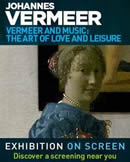
Vermeer-related film
Vermeer and Music
In cinemas worldwide on October 10 & varying dates
The National Gallery, London, is offering a fresh look at one of the most startling and fascinating artists of all—Johannes Vermeer, painter of the famous Girl with a Pearl Earring. The National Gallery has chosen to focus on Vermeer's relationship with music. It is one of the most popular themes of Dutch painting and reveals an enormous amount about the sitter and the society they lived in. New research, revealed for the first time at this exhibition, shows how his technique and materials affected his works.
Tim Marlow goes beyond the exhibition to tell the entire story of Vermeer's life—and, in doing so, shows in fabulous HD detail many other of the artist's captivating works.
To book tickets go to the find a venue page.
Vermeer-related article
"MOST RARE WORKMEN": OPTICAL PRACTITIONERS IN EARLY
SEVENTEETH-CENTURY DELFT "
Huib J. Zuidervaart and Marlise Rijks
The British Journal for the History of Science, pp. 1–33,
March 2014
online article can be
accessed at:
http://journals.cambridge.org/action/displayAbstract?fromPage=online&aid=9202672&fileId
=S0007087414000181
abstract:
A special interest in optics among various seventeenth-century painters living in the Dutch city of Delft has intrigued historians, including art historians, for a long time. Equally, the impressive career of the Delft microscopist Antoni van Leeuwenhoek has been studied by many historians of science. However, it has never been investigated who, at that time, had access to the mathematical and optical knowledge necessary for the impressive achievements of these Delft practitioners. We have tried to gain insight into Delft as a 'node' of optical knowledge by following the careers of three minor local figures in early seventeenth-century Delft. We argue that through their work, products, discussions in the vernacular and exchange of skills, rather than via learned publications, these practitioners constituted a foundation on which the later scientific and artistic achievements of other Delft citizens were built. Our Delft case demonstrates that these practitioners were not simple and isolated craftsmen; rather they were crucial components in a network of scholars, savants, painters and rich virtuosi. Decades before Vermeer made his masterworks, or Van Leeuwenhoek started his famous microscopic investigations, the intellectual atmosphere and artisanal knowledge in this city centered on optical topics.
Especially of interest is the authors' tie between three optical practitioners who lived in Delft simultaneously with Vermeer. One of them, Jacob Spoors, was in 1674 the notary of Vermeer and his mother-in-law Maria Thins. Another was an acquaintance of Spoors, the military engineer Johan van der Wyck, who made an optical device in Delft in 1654, most likely a camera obscura. A report about the demonstration in nearby The Hague has been preserved. Van der Wyck also made telescopes and microscopes and an apparatus that probably was a kind of perspective box. As a telescope maker he was preceded by Evert Harmansz Steenwyck, brother-in- law of the Leiden painter David Bailly and father of two Delft still-life painters: Harman and Pieter Steenwyck. The latter was familiar with Vermeer's father Reynier Jansz Vermeer, at a time when the young Vermeer was still living with his parents. According to the authors, this is the first real archival evidence that such a device existed in Delft during Vermeer's life.

Vermeer-related exhibition
The Myth of the Golden Age. From Vermeer to Rembrandt:
Masterpieces from the Mauritshuis
(La ragazza con l'orecchino di perla: Il mito della Golden Age Da Vermeer a Rembrandt Capolavori dal Mauritshuis)
Bologna, Palazzo Fava
February 8–May 25, 2014
Among the paintings going on exhibition are the Girl with a Pearl Earring and the Diana and her Companions by Johannes Vermeer and The Goldfinch by Carel Fabritius, neither of which will have been seen by Italian audiences in many years. The decision to organize a major international traveling exhibition of a select group of paintings from the museum's rich collection was prompted by the large-scale renovations to its premises, which will be finished in 2014. The exhibition is organized by Linea d'ombra.
exhibition curators:
Marco Goldin
Emilie E.S. Gordenker
Quentin Buvelot
Ariane van Suchtelen
Lea van der Vinde

Vermeer-related lecture
"Silence in the Studio: Vermeer and Terborch"
by Mariët Westermann
Washington College, Chestertown MD (Hotchkiss Recital Hall, Gibson Center for the Arts)
Wednesday, April 9 | 5 p.m.
from the Washington College website:
Celebrated art historian Mariët Westermann, vice president of the Andrew W. Mellon Foundation, will explore the technical innovations by Dutch painters of the Golden Age such as Vermeer and Gerrit ter Borch in a lecture entitled "Silence in the Studio: Vermeer and Terborch." T he lecture will be given on the occasion of the 11th annual Janson-La Palme Distinguished Lecture in European Art History on the college campus.
A native of Holland, Westermann graduated magna cum laude from Williams College with a degree in history. She later completed her master's degree and Ph.D. in art history at NYU's Institute of Fine Arts and has written extensively on Dutch painting and Vermeer. Westermann is the author of several acclaimed books, including A Worldly Art: The Dutch Republic 1585–1718 (ranked a Notable Book of the Year by the New York Times); The Amusements of Jan Steen: Comic Painting in the 17th Century; Rembrandt: Art and Ideas; and Anthropologies of Art. She also authored Johannes Vermeer 1632–1675 for the Rijksmuseum Dossiers series and served as guest curator of "Art and Home: Dutch Interiors in the Age of Rembrandt" at the Newark Museum and Denver Art Museum.
The lecture is free and open to the public.

Vermeer-related exhibition
Vermeer's A Young Woman Seated at the Virginals
Philadelphia Museum of Art
October 26, 2013–March 2014
from the museum website:
Vermeer's A Young Woman Seated at the Virginals will be joined by two additional loans from the Leiden Collection: Frans Hals's Portrait of Samuel Ampzing and The Coat of Many Colors attributed to Rembrandt's pupil Gerbrand van den Eeckhout. All three paintings are on view in the galleries of European art 1500–1850 on the second floor, in the company of a selection of the Museum's own paintings from the Dutch Golden Age. The Museum possesses more than three hundred seventeenth-century Dutch paintings, the largest collection of its kind in North America.
For further in formation, click here.
exhibition curator:
Christopher Atkins, Associate Curator of European Painting & Sculpture
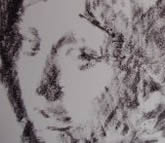
Vermeer-related study
From Perception to Paint: The Practical Use of the Camera Obscura in the Time of Vermeer
Jane Jelley
in Art and Perception
July 2013
There has been much debate as to whether Vermeer himself would have used any kind of optical aid in the execution of his paintings. The paintings themselves appear to show optical effects and distortions, seen only through a lens and not with the naked eye. Was Vermeer just influenced by the view through a camera, or did he transfer the projected images directly to his paintings?
The experiment shows a method that would have made transfers from a projection to a canvas a practical possibility, using readily available materials and contemporary technology. This technique not only solves the problems of the reversals of camera obscura images, but significantly, the resultant transfers from the lens show striking resonances with Vermeer's own underpainting, revealed by scientific analysis. This research also provides some answers about the use of particular materials in the seventeenth-century studio.
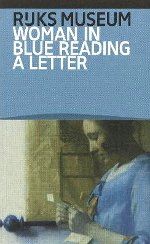
New Vermeer publication
Woman in Blue Reading a Letter (Rijksmuseum publication)
by Gregor J.M. Weber
64 pages full-color, paperback, Dutch and English
2013
The hushed mood, the painstaking composition, the modulating blues, the suggestion of light–all these aspects make Vermeer's Woman in Blue (c. 1663) one of the great masterpieces of painting. Discover this Rijksmuseum highlight in a book by Vermeer expert Gregor Weber.
Click here to order.
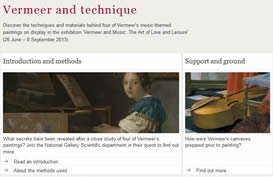
Vermeer-related web study
Vermeer and Technique
http://www.nationalgallery.org.uk/paintings/research/meaning-of-making/vermeer-and-technique/
Discover the techniques and materials behind four of Vermeer's music-themed paintings on display in the exhibition Vermeer and Music: The Art of Love and Leisure (26 June–8 September, 2013).
Illuminating and richly illustrated.
topics include:
- Support and ground
- Infrared examination
- Vermeer's palette
- Binding medium
- Paint application
- Secrets of the studio
- Altered appearance of ultramarine
- Fading of yellow and red lake pigments
- Drying and paint defects
- Formation of lead and zinc soaps
from the National Gallery website:
The extended loan of Vermeer's Guitar Player from Kenwood House enabled National Gallery researchers to analyze the painting's materials and closely study the techniques used. The findings were compared with other late paintings by Vermeer in the National Gallery (A Lady Seated at a Virginal and A Lady Standing at a Virginal), and a slightly earlier work (The Music Lesson) kindly lent by the Royal Collection for the National Gallery's 2013 summer exhibition Vermeer and Music: The Art of Love and Leisure.
This project presented an opportunity for close visual examination and technical imaging of these works. In addition, a small number of paint samples obtained from each of these paintings in the 1960s and archived since that time at the Doerner Institut were kindly loaned for study. Techniques for the analysis of these samples, not available in the 1960s, scanning electron microscopy with energy dispersive X-ray analysis (SEM-EDX) and attenuated total reflectance—Fourier transform infrared (ATR-FTIR) spectroscopy have now been undertaken. The aim has been to draw together information from current visual inspections, analytical evidence from the old paint samples, and the results of the analysis of a very small number of new samples which we have been able to take from our own paintings. The study has been directed to understanding the current condition of the paintings and how this may relate to the alteration of Vermeer's original painting materials and to conservation treatments undertaken in the past.

Vermeer-related publication
"Canvas matches in Vermeer: A case study in the fabric analysis of canvas supports"
Metropolitan Museum Journal, vol. 47, 2012, pp. 99–106
by Walter Liedtke, C. Richard Johnson Jr. and Don H. Johnson
the article is downloadable at:
http://people.ece.cornell.edu/johnson/LiedtkeMMJ.pdf
For the past several years two American scientists, C. Richard Johnson Jr. and Don H. Johnson, "have developed computer algorithms that allow an analysis of canvas weaves that is more precise than traditional methods. They have digitally mapped canvases used by European artists ranging in date from the 1450s to Vincent van Gogh's pictures of 1888–90. The results so far have been variously revealing for those artists and for Velázquez, Vermeer, Monet, Renoir, Gauguin and Matisse.
In the case of Johannes Vermeer, twenty nine of his canvases have been digitally mapped to date, out of the thirty-six paintings by him (two of which are on wood) that are generally accepted by scholars. The two scientists discovered that "three canvas weave matches were found, with three different implications: a question of authenticity; another concerning chronology; and the hypothesis that two pictures were intended by the artist as a pair. The results of the analysis suggest that the canvas of The Lacemaker originated from the same bolt of canvas as that of the recently reattributed Young Woman Seated at a Virginal (not to be confused with the London work of Vermeer by a similar title). Another weave match found in Vermeer's oeuvre is between two genre paintings of identical size, Young Woman Standing at a Virginal and Young Woman Seated at a Virginal, both in the National Gallery, London.
Walter Liedtke, the curator of the Metropolitan Museum of Art and Vermeer expert, furnishes an art historical reading of the investigation.
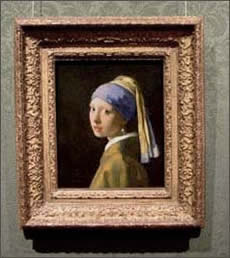
Vermeer's Girl with a Pearl Earring in the United States in 2013 & in Bologna, Italy, 2014
Girl with a Pearl Earring: Dutch Paintings from the Mauritshuis (35 works)
de Young - San Francisco Museum of Fine Arts
San Francisco
January 26–June 2, 2013
Girl with a Pearl Earring: Dutch Paintings from the Mauritshuis (35 works)
High Museum of Art
Atlanta
June 22–September 29, 2013
Vermeer, Rembrandt and Hals: Masterpieces of Dutch Painting from the Mauritshuis
(10 works)
Frick Collection
New York
October 22, 2013–January 19, 2014
La ragazza con l'orecchino di perla: Il mito della Golden Age. Da Vermeer a Rembrandt capolavori dal Mauritshuis
8 February –May 25, 2014
Bologna, Italy (Palazzo Fava)
press release:
Masterpieces from the Royal Picture Gallery Mauritshuis will be exhibited at three museums in the United States from January 2013 to January 2014. The Mauritshuis has agreed to send more than thirty works to the de Young/Fine Arts Museums of San Francisco and the High Museum of Art in Atlanta; the tour will finish with a smaller selection at The Frick Collection in New York. Among the paintings going on tour are the famous Girl with a Pearl Earring by Johannes Vermeer and The Goldfinch by Carel Fabritius, neither of which will have been seen by American audiences in ten years. Furthermore, this is the first occasion since the mid-1980s that a substantial group of works from the Mauritshuis has come to the United States. The decision to organize a major international traveling exhibition of a select group of paintings from the museum's rich collection was prompted by the large-scale renovations to its premises, which will be finished in 2014.
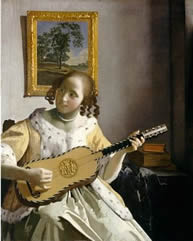
Vermeer exhibition in London
Vermeer and Music: Love and Leisure in the Dutch Golden Age
Sainsbury Wing, National Gallery of Art, London
June 26–September 8, 2013
Admission free
This exhibition explores the concept of music as a pastime of the elite in the northern Netherlands during the seventeenth century. Vermeer and Music: Love and Leisure in the Dutch Golden Age will bring together the National Gallery's two paintings by Vermeer, A Lady Standing at a Virginal and A Lady Seated at a Virginal, The Royal Collection's Music Lesson, A Young Woman Seated at the Virginals (attributed to Johannes Vermeer) and The Guitar Player, on exceptional loan from the Iveagh Bequest, Kenwood House.
The exhibition aims to enhance viewers' appreciation of these beautiful and evocative paintings by Vermeer and his contemporaries by juxtaposing them with musical instruments and songbooks of the period. Visitors will be able to compare seventeenth-century virginals, guitars, lutes and other instruments with their painted representations to judge the accuracy of representation and what liberties the painter might have taken to enhance the visual or symbolic appeal of his work. In seventeenth-century Dutch paintings, music often figured as a metaphor for harmony, a symbol of transience or, depending on the type of music being performed, an indicator of one's education and position in society. Musical instruments and songbooks were also included as attributes in elegant portraits to suggest that the sitter was accomplished in this area.

Vermeer-related film
In Tim's Vermeer, Tim Jenison, a Texas-based inventor and giant of video and post-production software for home computers, (Video Toaster, LightWave, TriCaster) attempts to solve one of the greatest mysteries in European art: How did the seventeenth- century Dutch master Johannes Vermeer manage to paint so realistically—150 years before the invention of photography?
In the search of an answer, Jenison began by working off of the theories set forth in David Hockney's Secret Knowledge: Rediscovering the Lost Techniques of the Old Masters and Philip Steadman's Vermeer's Camera: Uncovering the Truth behind the Masterpieces, both of which allege that Vermeer employed an optical device, the camera obscura, as an aid to his painting. Fascinated by the theories of Hockney and Steadman (both outsiders to the art history enclave), Jenison built his own camera obscura but found something was amiss. He immediately came to suspect that not only had Vermeer used some sort of optical device to trace the drawing of his motif onto his canvas (as Steadman had for all practical purposes proved) but must have used it to register the colors and tonal values of his paintings which have been long admired for their uncanny precision, apparently out of reach of his contemporaries.
While viewing in person Vermeer's Music Lesson, perhaps the artist's most "optically based" work, Jenison, a video engineer well versed in analyzing images scientifically, became firmly convinced that the work presents optical information that cannot be gathered by retinal observation. Pondering how Vermeer could have achieved such results, he invented—the idea came to him as he was relaxing in a bath tub—a simple, easy-to-use optical device, whose technology was easily within the reach of the seventeenth-century artist, and painstakingly taught himself to paint with it. The mirror of Jenison's device reflects an object in such a way that a painter can duplicate not only an object's principal contours on canvas but its precise colors and tones. Putting his theory to the ultimate test, Jenison built a perfectly scaled "set" of The Music Lesson in a San Antonio studio and "repainted" Vermeer's Music Lesson from it using the device. After various false starts, Jenison learned how to handle the device with greater efficacy, how to hand grind paint and how to domesticate paint and brush, an entirely new experience for the digital engineer. He employed seven months to complete the work, which he claims is easily accurate enough to uphold his hypothesis.
Although Jenison admits that there is no historical evidence that proves his hypothesis, he believes that if his method for transferring form, color and tone form with a mechanical device to a canvas was used by Vermeer, a chapter of art history would have to be revised.
Jenison's friends, the illusionists and professional debunkers Penn & Teller, united with him to fully document his years- long investigation into the mysterious methods of Dutch Master Johannes Vermeer. The movie includes commentary from Jillett, Hockney and Steadman. Speaking of the film, Hockney said, "It might disturb quite a lot of people," since it forces you to question everything that you thought you knew about great art and the people responsible for it. But, as Jillette points out, "it doesn't argue that they weren't geniuses; it just shows that they were fathomable geniuses, rather than unfathomable ones."
video interviews:
Click here to view a YouTube interview with Jenison and hear his ideas on Vermeer at 34:35 minutes into the video. Another YouTube interview with Jenison, https://www.youtube.com/watch?v=sfsbSK0WPqU
review:
Variety - "Penn and Teller's uncanny crowdpleaser begs the question, is it still a masterpiece if an amateur could do it?" - Peter Debruge
http://variety.com/2013/film/reviews/telluride-film-review-tims-vermeer-1200596123/
review:
The Guardian - "DIY Vermeer documentary utterly misses the point about old masters
Tim Jenison tried for a whole year to recreate a Vermeer painting—and all he got was a pedantic imitation"-Jonathan Jones
http://www.theguardian.com/artanddesign/jonathanjonesblog/2014/jan/28/tims-vermeer-fails
GIRL WITH A PEARL EARRING
AND OTHER TREASURES FROM THE MAURITSHUIS MUSEUM NETHERLANDS
in cinemas from 13 January
from
Exhibition on Screen' website:
Girl with a Pearl Earring by Johannes Vermeer is one of the most enduring paintings in the history of art. Even today, its recent world tour garnered huge queues lining up for the briefest glimpse of its majestic beauty. In Japan 1.2 million people saw the exhibition. Yet the painting itself is surrounded in mystery. This beautifully filmed new documentary seeks to investigate the many unanswered questions associated with this extraordinary piece. Who was this girl? Why and how was it painted? Why is it so revered?
After its world tour, the Girl with a Pearl Earring returned to the much-loved Mauritshuis in The Hague, Netherlands, which has just completed extensive renovations. Enjoying unparalleled exclusive access to this historical exhibition, the film takes the audience on a journey as it seeks to answer many of the questions surrounding this enigmatic painting and its mysterious creator, Vermeer. Using the recently completed and highly complex makeover of the museum as its starting point, the film goes on a behind the scenes detective journey to seek out the answers that lie within the other masterpieces housed in the collection.
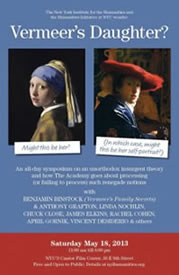
Vermeer-related conference
Vermeer's Daughter?
NYU Cantor Film Center, New York
May 18, 2013 | 1:00 a.m.–6: p.m.
In his book Vermeer's Family Secrets (Routledge in 2009), Cooper Union art history professor Benjamin Binstock proposed that four paintings by Vermeer, including the Girl with a Red Hat, might actually have been painted by his daughter, Maria, who he further identified as the model for the famous Girl with a Pearl Earring. Thus far, however, Binstock's thesis has been met with silence in the art historical press—itself a fascinating response. But what if we were to take Binstock's claims seriously, or at least allow them a fair hearing? How might we go about doing so? Beyond that, what if we in turn were to think about how such theories make their way through the art historical vetting process? How generally does scholarship evaluate such claims, and in turn how ought we evaluate how it does so? And if Binstock were proven right?
An all-day symposium will address Binstock's unorthodox theory and related questions will be held at the NYU Cantor Film Center, Saturday May 18, 2013 (11:00 a.m.–6: p.m.). The symposium will attended by:
- Benjamin Binstock
- Anthony Grafton
- Linda Nochlin
- Chuck Close (painter)
- James Elkins (art historian)
- Vincent Desiderio
- Rachael Cohen
- Ulrich Baer
Entrance is open to the public and free.

One big step closer to recovering Vermeer's stolen Concert?
:The FBI said Monday it believes it knows who was behind one of the most significant art heists in the United States—the 1990 theft of 13 precious works, once valued at $500 million, from Boston's Isabella Stewart Gardner Museum. The did not reveal the suspects' names, but know that they "are members of a criminal organization with a base in the mid-Atlantic states and New England."
The bureau also said it believes the Vermeer's Concert—including paintings by Rembrandt—was taken to Connecticut and the Philadelphia area and that the thieves unsuccessfully tried to sell some of the artwork in Philadelphia about 10 years ago. The announcement comes on the 23rd anniversary of the theft, which the FBI says is one of the largest property crimes in U.S. history.
see full story:
http://edition.cnn.com/2013/03/18/justice/massachusetts-fbi-art-theft/index.html?hpt=hp_t2
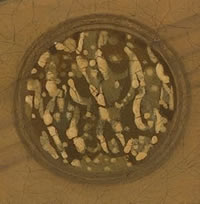
High-resolution of Vermeer's Guitar Player
The National Gallery of Art in London has just published a high-resolution image of Vermeer's Guitar Player which will reside at the gallery until the renovation of the picture's permanent collect (Kenwood House, London) is completed.
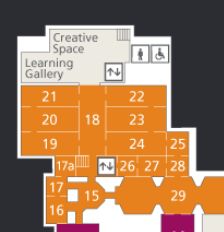
The Guitar Player now on display at the National Gallery
The National Gallery of Art in London is now exhibiting Vermeer's late Guitar Player during the renovation of the Kenwood House, where it is normally housed. The work is in the same room as the National Gallery's own A Lady Standing at a Virginal, room 25, second level.

Vermeer travels to Shanghai, São Paulo and Los Angeles
The Rijksmuseum is starting its global campaign for the Grand Opening on 13 April, 2013 with an international tour of one of its masterpieces, Woman in Blue Reading a Letter. It will be first shown in Shanghai at the China Art Museum in the exhibition Congratulations from the World, then at the Museu de Arte in São Paulo, Brazil and finally at J. Paul Getty Museum in Los Angeles. At Grand Opening on 13 April, 2013, the painting will be on show again in the Rijksmuseum.
- China Art Palace (Shanghai) - October 1–October 31, 2012
http://www.sh-artmuseum.org.cn/ - Museu de Arte in São Paulo (São Paulo) December 12, 2012–February 10, 2013
http://masp.art.br/masp2010/exposicoes_integra.php?id=
127&periodo_menu=cartaz - J. Paul Getty Museum (Los Angeles) February 16–March 31, 2013
http://www.getty.edu/visit/exhibitions/future.html
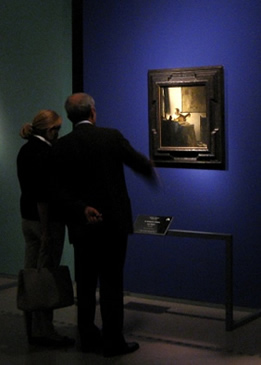
Vermeer and Dutch painting exhibition in Rome, Italy
Vermeer. Il secolo d'oro dell'arte olandese (in Italian only)
(Vermeer and the Golden Age of Dutch Art)
Scuderie del Quirinale
Rome, Italy
October 2012– January 20, 2013
from the exhibition website:
Vermeer and the Golden Age of Dutch Art is the first large-scale exhibition dedicated to one of the foremost Dutch painters of the seventeen century, and perhaps one of the general public's most beloved artists.
Organized by the Azienda Speciale Palaexpo and co-produced with MondoMostre, the exhibition is curated by Arthur K. Wheelock, Curator of Northern Baroque Paintings - National Gallery of Art in Washington, Walter Liedtke, Curator of European Paintings Metropolitan Museum of Art in New York and Sandrina Bandera, Soprintendente per il Patrimonio Artistico Storico, Artistico ed Etnoantopologico di Milano.
Other than the eight confirmed works by Vermeer, many paintings by the key protagonists of the seventeenth-century Dutch genre school will be on display.
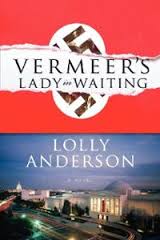
Vermeer-related novel
Vermeer's Lady in Waiting
by Laurel "Lolly" Anderson
2012
Millicent Clermont must learn what is real or fake in art, life and love. A painting discovered in her mentor's Virginia plantation is on the list of Nazi looted art. Is it a real Vermeer? Was does the secret code in the overpainting mean and why will people kill for it? From the majestic halls of the National Gallery of Art, Washington DC, and the luscious landscapes of VIrginia, to Paris, Jerusalem and Germany, readers will be enthralled with fascinating details of painting authentication, forgeries and the Nazi desecration of the world's cultural treasures.
Oklahoma Book Awards 2013
to order, click here
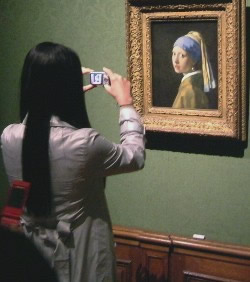
Vermeer's Girl with a Pearl Earring & the Diana and her Companions go to Japan in 2012
Masterpieces from the Royal Picture Gallery Mauritshuis
City Museum Kobe, Japan
October 29–December, 2012
This show will feature Vermeer's masterpiece Girl with a Pearl Earring and the early Diana and her Companions while many other masterpieces are already on display at a separate Vermeer show (continuing through March 14) at Tokyo's Bunkamura.
video presentation:
http://www.youtube.com/watch?feature=player_
embedded&v=ZalFLhX0_o0
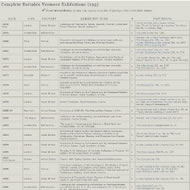
Essential Vermeer website additions
- Vermeer Exhibitions: 1838–2019
A complete sortable list of past, ongoing and future Vermeer exhibitions. To sort all 193 exhibitions by date, city, country or number of Vermeer pictures displayed, click the table's headers. - Provenances of Vermeer's Paintings
The provenience of all Vermeer paintings. - Dating Vermeer's Paintings
Dates given to Vermeer's paintings by Vermeer scholars.
Vermeer's Woman with a Pearl Necklace travels to Tokyo
From Renaissance to Rococo. Four Centuries of European Drawing, Painting and Sculpture
National Museum of Western Art, Tokyo
June 13–September 17, 2012
from the exhibition website:
Arriving in Japan will be 107 paintings, sculptures and drawings from the collections at the National Museums of Berlin (Staatliche Museen zu Berlin)—magnificent collections amassed at the museums as a national mission, after their founding in the 19th century when Berlin was the capital of the Kingdom of Prussia. The exhibition will enable viewers to compare artworks of the Italian and Northern Renaissances as they view European art of the fifteenth to eighteenth centuries.
Included is one work that must not be missed, Young Lady with a Pearl Necklace, one of the finest of the few surviving masterpieces by Jan Vermeer van Delft, the foremost artist of seventeenth-century Dutch painting. The painting will be making its first appearance in Japan.
Along with paintings by Rembrandt and sculptures by the master German sculptor Tilman Riemenschneider, the exhibition will also offer some 30 drawings from the Italian Renaissance—a period spanning 200 years, from 1420 to around 1600—including works by Sandro Botticelli and Michelangelo Buonarroti.
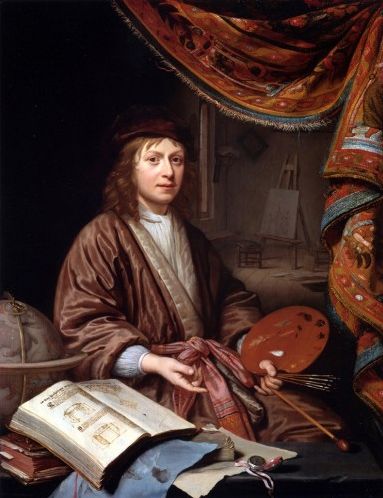
Vermeer contemporary Michiel van Musscher commemorated at the Van Loon Museum in Amsterdam
Michiel van Musscher: the opulence of the Golden Age
March 9 –June 10, 2012
Museum van Loon, Amsterdam
While Vermeer lovers might remember Michiel Van Musscher's emulation of Vermeer's Art of Painting, perhaps only a few have given this lesser-known seventeenth-century Dutch painter the full attention he deserves. To rectify the situation, on March 9, 2012 the Museum Van Loon opened an exhibition Michiel van Musscher (1645–1705) the Wealth of the Golden Age, the very first exhibition dedicated to this talented artist.
By the end of the seventeenth century, Van Musscher had become a successful portraitist. While visiting the capital in 1687, Swedish architect Nicodemus Tessin deemed him the very best Amsterdam painter for small portraits. He is noted for having portrayed the exuberant lifestyle of the Dutch elite and the wealth of the Golden Age with great pictorial quality and richness in detail. His portraits are painted in the tradition of Netscher and Van Mieris although it is clear that he had seen and drawn inspiration from Vermeer as well for a few of his own compositions. Among his sitters was Tsar Peter the Great.
The exhibition counts not only his more famous paintings from Dutch collections and the Van Loon Museum itself, but also a significant number of paintings from private collections and international museums. The exhibition is a tribute to the work of Van Musscher and visualizes the latter days of the Dutch Golden Age.
catalogue available at: info@museumvanloon.nl
Michiel Van Musscher (1645–1705). The Wealth of the Golden Age.
Gerhardt, Robert. Francis Quint.
Amsterdam, Museum van Loon,
Zwolle,
2012
(paperback, pp. 64, col. ill., 24 x 27 cm.)
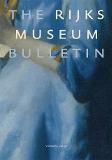
Rijksmuseum publishes new bulletin with two articles on Vermeer's newly restored Woman in Blue Reading a Letter
The Rijksmuseum Bulletin 2012 - 1
"The restoration of Woman in Blue Reading a Letter by Johannes Vermeer"s
by IGE VERSLYPE
"A Question of Framing: On Vermeer's Woman in Blue Reading a Letter"
by GREGOR J.M. WEBER
to order, click here: https://bulletin.rijksmuseum.nl/article/view/9695

View digital image of Vermeer's recently restored Woman in Blue Reading a Letter
click here to access high resolution image
The Rijksmuseum has updated their hi-res image of the Woman in Blue Reading a Letter after its recent restoration. At first sight it looks a bit disjointed as pictures always do after restoration. The whole much cooler in hue now the long winding scarf-like piece of cloth on the table, once fairly muddled, can be made out a bit better recalling a similar scarf-like object that drapes down in The Art of Painting. The figure has gained much force and now stands out of the picture more than it did before the dark, yellow varnish was removed. The painting now appears to have greater spatial resonance and sense of volume.
Some color can be made out in the map as well as a few topographical features which had been overpainted. A row of discreet brass buttons with tiny highlights now run along the side of the foreground chair which had been completely obscured by retouches.

Vermeer's Girl with a Pearl Earring & the Diana and her Companions go to Japan in 2012
Masterpieces from the Royal Picture Gallery Mauritshuis
Tokyo Metropolitan Art Museum
June 30–September 17, 2012
This exhibition will mark the reopening of the Tokyo Metropolitan Art Museum, which has been closed for renovations for two years.
This show will feature Vermeer's masterpiece Girl with a Pearl Earring and the early Diana and her Companions while many other masterpieces are already on display at a separate Vermeer show (continuing through March 14) at Tokyo's Bunkamura.
video presentation:
http://www.youtube.com/watch?feature=player_
embedded&v=ZalFLhX0_o0
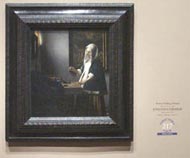
Vermeer painting goes to Detroit
Detroit Institute of Art
August 8–Labor Day (about), 2012
On loan from the National Gallery of Art in Washington, D.C., Vermeer's Woman Holding a Balance will take center stage in a tightly focused exhibition, flanked by two similarly intimate scenes painted by Gerrit ter Borch and Pieter de Hooch, two of Vermeer's contemporaries and stars of the DIA's Dutch collection. The painting is the first Vermeer to visit Detroit in probably 65 years.
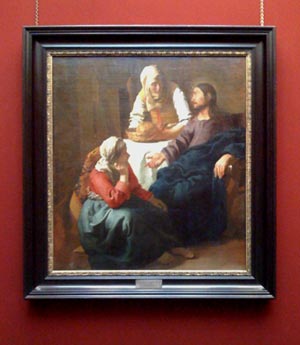
Vermeer's early Christ in the House of Martha and Mary to be exhibited in Italy
Da Vermeer a Kandinsky. Capolavori dai musei del mondo a Rimini
Castel Sismondo
Piazza Malatesta
47900 Rimini, Italy
January 21–June 3, 2012
Catalogue:
https://amzn.to/3DFUcsb
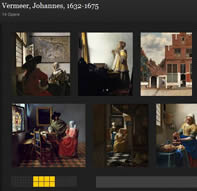
New hi-res images of 8 Vermeer's paintings
Google has added seven new high-resolution images of Vermeer's painting to their Google Art Project, bringing the total works of this master to fourteen. The Art of Painting is quite good in color but at maximum magnifications it is notably out of focus. The Music Lesson is more or less a disaster: it is overexposed, rotated slightly to the right and not even all that large. The Young Woman with a Water Pitcher is the same image already available on the Metropolitan website. The two Dresden paintings, for some reason, are both very poor in color and out of focus. The Christ in the House of Martha and Mary is only acceptable. That leaves the Washington Woman Holding a Balance and the Lady Writing, both which are in focus and perfectly registered in color, useful for the scholar and first-tier Vermeer admirer alike.
links to Google hi-res images:
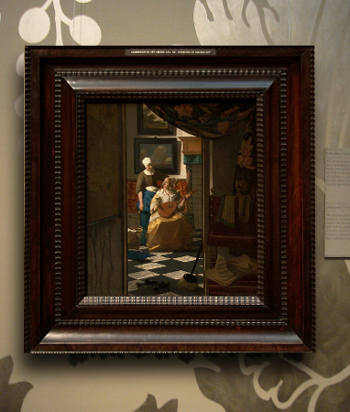
Rijksmuseum sends Vermeer's Love Letter to Turkey for the first time
Where Darkness Meets Light...Rembrandt & his Contemporaries
Sakip Sabanci Museum in Istanbul
February 21–June 10, 2012
from artdaily.com:
For the first time, the Rijksmuseum is organizing an exhibition on the Dutch Golden Age in Turkey, including five paintings by Rembrandt and Love Letter by Vermeer. Over 100 masterpieces from the Rijksmuseum collection will be on display in Sakip Sabanci Museum in Istanbul from 21 February to 10 June, 2012. The exhibition is part of the festivities marking 400 years of diplomatic relations between Turkey and the Netherlands.
The exhibition showcases the rich and varied nature of seventeenth-century Dutch art and history, telling the story of the power and majesty of the young Dutch Republic in the Golden Age through a selection of 111 paintings, drawings, prints and applied art in the form of carpets, ceramics, silverware and glassware. The exhibits include landscapes by Jan van Goyen, Jacob van Ruisdael and Aelbert Cuyp, still lifes by Pieter Claesz and Adriaen Coorte, genre pieces by Gerrit ter Borch, Gabriël Metsu and Pieter de Hooch, and jocular scenes by Jan Steen and Adriaen van Ostade. Two portraits by Frans Hals will also be on display, alongside several cityscapes by Gerrit Berckheyde and two pen paintings by Willem van de Velde de Oude.
The highlights of the exhibition are The Love Letter (1669–1670) by Johannes Vermeer and no fewer than five paintings by Rembrandt van Rijn: Portrait of Haesje van Cleyburgh (1634), Still Life with Peacocks (c. 1639) and Portrait of Dr Ephraïm Bueno (1645–1647), The music lesson (1626) and Joseph recounting his dreams (1633).
Museum website:
https://www.sakipsabancimuzesi.org/en

Vermeer's late Young Woman Seated at a Virginal exhibited in Oxford
Ashmolean Museum of Art, Oxford
January 23–September, 2012
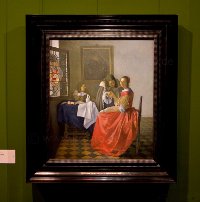
Vermeer's Girl with a Glass of Wine on exhibition in Kassel
Light Structure - The Light in the Age of Rembrandt and Vermeer
Museum Hessen Kassel, Kassel, Germany
November 28, 2011– February 26, 2012
Seventy superb works from the Baroque age of painting will be displayed in the upcoming exhibition Light structure: The light in the Age of Rembrandt and Vermeer, in William Castle Museum in Kassel. The exhibition will address one of the most notable aspects of European painting: the translation of light in painting. Attempts on the part of painters to render the myriad effects of light with paint were paralleled by intense scientific research on light.
In cooperation with the Berlin research group Historical light structure the exhibition examines the different aspects of light painting in the seventeenth century on the basis of paintings, graphics and optical devices, also in view of the contemporary scientific treatises. The starting point is the art of the fifteenth and 16 Century and the fundamental innovations of Caravaggio. North of the Alps have been taken including those of Utrecht artists like Gerard van Honthorst and developed.
Different areas of the exhibition are dedicated to the particular diversity and range of Dutch paintings of light, including day light, nocturnal landscapes, interior and portrait paintings. Vermeer's Girl with a Glass of Wine will be one of the principal works of the exhibition.
museum website (German only):
https://www.heritage-kassel.de/en
opening times:
Tues.–Sun. and holidays 10–17 o'clock, Thur. 10–20 o'clock, closed Mondays

Vermeer's Guitar Player to be exhibited at the London National Gallery in 2012 and 2013
With the closure of the Kenwood House for urgent restoration in 2012, the museum was posed with the dilemma of what to do with their masterpieces. The Kenwood has just announced that Vermeer's Guitar Player will be displayed at the National Gallery in London. The exquisite work, never before relined, will also be examined by the National Gallery's conservation department. Keeping it in storage was ruled out because it was the most costly alternative. Dates to be announced.
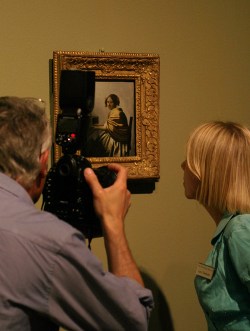
Vermeer lecture in London
The "Newest" Vermeer—How Technical Research Convinced the Doubting Scholars
presented by Libby Sheldon
Art Workers Guild, 6 Queen Square
London
February 29, 2012 | 6.30 p.m.
from the BACPR press release:
The only painting by Vermeer in private ownership, the tiny A Young Woman Seated at the Virginal has been on display in the UK for the first time since it was sold in 2004, first at the Fitzwilliam and now at the Ashmolean, Oxford until September. Ten years previously it was believed by many to be a nineteenth-century pastiche or a twentieth-century fake. It proved relatively unproblematic to show it was earlier, but even if it was of a contemporary date, why should it be by Vermeer?
The talk will explain the research trail followed by Libby Sheldon, Catherine Hassall and Nicola Costaras, (and help from many other colleagues in the UK and abroad) to find the author of the painting, and presents the compelling technical evidence unearthed that led to its final attribution. It came to them in a Jiffy bag and left for the final time in a specially made box and two bodyguards. What had made the difference?
Libby Sheldon is a paint analyst/historian and a lecturer at UCL. She has made in-depth studies of the techniques of Vermeer and the Pre-Raphaelites, has been closely involved in the Making Art in Tudor Britain project and is starting a research project on Aelbert Cuyp. Her main research interest is the historic employment of pigments.
rspv:
Sam Robinson by email secretary@bapcr.org.uk or by phone 01372 468 143
cost:
Free To BAPCR Members, £10 to Non Members
location:
Art Workers Guild Tel 0207 728 3009 Nearest underground Holborn or Russell Square
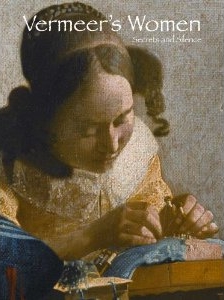
Vermeer exhibition catalogue
Vermeer's Women: Secrets and Silence
by Marjorie E. Wieseman, Mr. Wayne Franits & H. Perry Chapman
224 pages, Yale University Press
2011
product description:
Focusing on the extraordinary Lacemaker from the Musée du Louvre, this beautiful book investigates the subtle and enigmatic paintings by Johannes Vermeer that celebrate the intimacy of the Dutch household. Moments frozen in paint that reveal young women sewing, reading or playing musical instruments, captured in Vermeer's uniquely luminous style, recreate a silent and often mysterious domestic realm, closed to the outside world, and inhabited almost exclusively by women and children.
Three internationally recognized experts in the field explain why women engaged in mundane domestic tasks, or in pleasurable pastimes such as music making, writing letters, or adjusting their toilette, comprise some of the most popular Dutch paintings of the seventeenth century. Among the most intriguing of these compositions are those that consciously avoid any engagement with the viewer. Rather than acknowledging our presence, figures avert their gazes or turn their backs upon us; they stare moodily into space or focus intently on the activities at hand. In viewing these paintings, we have the impression that we have stumbled upon a private world kept hidden from casual regard.
purchase exhibition catalogue from Fitzwilliam Museum online shop

Vermeer's Girl with a Glass of Wine on exhibition in Kassel
Light Structure - The Light in the Age of Rembrandt and Vermeer
Museum Hessen Kassel
November 12, 2011– February 26, 2012
Seventy superb works from the Baroque age of painting will be displayed in the upcoming exhibition Light structure: The Light in the Age of Rembrandt and Vermeer, in William Castle Museum in Kassel. The exhibition will address one of the most notable aspects of European painting: the translation of light in painting. Attempts on the part of painters to render the myriad effects of light with paint were paralleled by intense scientific research on light.
In cooperation with the Berlin research group Historical Light Structure, the exhibition examines the different aspects of light painting in the seventeenth century on the basis of paintings, graphics and optical devices, also in view of the contemporary scientific treatises. The starting point is the art of the fifteenth and 16th century and the fundamental innovations of Caravaggio. North of the Alps have been taken including those of Utrecht artists like Gerard van Honthorst and developed.
Different areas of the exhibition are dedicated to the particular diversity and range of Dutch paintings of light, including day light, nocturnal landscapes, interior and portrait paintings. Vermeer's Girl with a Glass of Wine will be one of the principal works of the exhibition.
museum website (German only):
https://www.heritage-kassel.de/en

Vermeer's Love Letter travels to the Hermitage
Love Letter by Vermeer. From the collection of the Rijksmuseum, Amsterdam. In the Masterpieces from the World`s Museums
Italian Cabinet (233), New Hermitage
Saint Petersburg, Russia
October 12, 2011– November 6, 2011
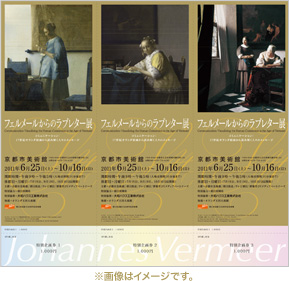
Vermeers in Japan
Communication: Visualizing Human Connection in the Age of Vermeer
Other than the previously announced (see entry below for details) world premiere of Vermeer's Woman in Blue Reading a Letter after its restoration, A Lady Writing and the Lady Writing a Letter with her Maid will be a part of the exhibition Communication: Visualizing Human Connection in the Age of Vermeer in Japan.
- Kyoto Municipal Museum of Art, Kyoto: 25 June–16 Oct 2011
- Miyagi Museum of Art, Sendai: 27 Oct'2011–12 Dec 2011
- The Bunkamura Museum of Art, Tokyo: 23 Dec–14 March 2012
curator:
Arthur K. Wheelock Jr.

Vermeer exhibition catalogue
Human Connections in the Age of Vermeer
Arthur K. Wheelock Jr. and Danielle H.A.C. Lokin
Scala Publishers Ltd
2011
This book focuses on the many forms of communication that existed in seventeenth-century Dutch society between family members, lovers and professional acquaintances, both present and absent. The forty-four carefully selected Dutch genre paintings include major works by many of the finest masters of the period, including Johannes Vermeer, Pieter de Hooch, Gerrit ter Borch and Gabriel Metsu. Vermeer's three masterpieces about love letters form the core of the exhibition as they are profound examples of the power of communication. Dutch artists of the seventeenth century portrayed the wide range of emotions elicited by the various forms of communication, not only in the manner in which they render gestures and facial expressions of personal interactions, but also in the ways in which they show men and women responding to the written word. The painters often introduced objects from daily life that had symbolic implications, among them musical instruments, to enrich the pictorial narratives of their scenes. Published in conjunction with the exhibition Communication: Visualizing the Human Connection in the Age of Vermeer (2011–2012), which celebrates the 400th anniversary of the diplomatic exchanges between Japan and the Netherlands, this book connects the pictorial and the literary aspects of Dutch cultural traditions during the Golden Age.
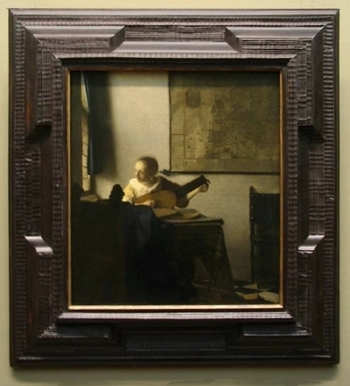
Vermeer travels to California
Vermeer's Woman with a Lute of the New York Metropolitan Museum of Art will be on temporary loan to the Norton Simon Museum in Pasadena from July 8 through September 26, 2011.
http://www.nortonsimon.org/vermeer-s-woman-with-a-lute-on-loan-from-the-metropolitan-museum-of-art
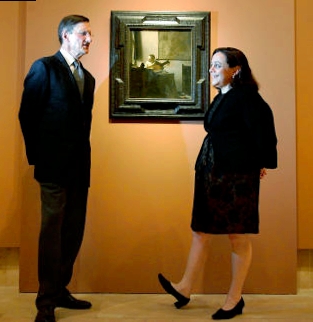
Vermeer lecture
Vermeer's Women: Discreet Objects of Desire
Walter Liedtke, (curator of European paintings at the Metropolitan in New York City)
Norton SImon Museum of Art, Pasadena, California
July 9, 2011 | 4:00 p.m.–5:00 p.m.
:
In this lecture, held in conjunction with the loan of Vermeer's Woman with a Lute from the Metropolitan Museum, Walter Liedtke, will focus on the diverse women in Vermeer's paintings and considers what they meant to the artist, as subjects in Dutch art and society, and as reflections of his distinctive approach to visual experience. It could be said that Vermeer engaged in an intellectual (although strongly felt) voyeurism, since many of his women are idealized objects of male desire, enthralling but beyond reach. The theme was well suited to Vermeer's style, which defined intimate spaces in mostly optical terms. The viewer is unable to enter the space or touch the objects, but he—and a man is surely assumed—can also not escape the hypnotic vision. Held in the Theater.
Gangsters and Vermeer: Will we ever see Vermeer's stolen Concert again? Perhaps yes.
:
http://www.sacbee.com/2011/06/24/3725190/can-whitey-bulger-help-solve-biggest.html
With the arrest Wednesday of notorious Boston crime boss James "Whitey" Bulger, many in the art world are now asking: Could it provide a break in the greatest art heist in American history which included Vermeer's Concert? Rumors have long swirled that Bulger, the head of the city's powerful Irish-American mob at the time, may have played a role—or must have known who did. Some have speculated that he stashed the stolen masterpieces away to use as a "get-out-of-jail-free card" if he was ever caught. Others think he sent the paintings to allies in the Irish Republican Army to use as a bargaining chip. The Gardner Museum had no comment Thursday on the arrest other than a Tweet saying, "Until a recovery is made, our work continues." Many who have studied the case are similarly skeptical about Bulger's direct involvement. Last year, investigators in the Gardner case said there was no evidence in the mountains of wiretaps and other records to link Bulger to the crime.
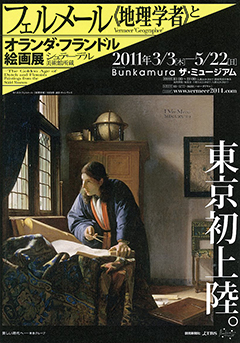
Vermeer's Geographer continues exodus
The Golden Age of Dutch and Flemish Paintings
Toyota Municipal Museum of Aichi
Aichi, Japan
June 11–August 28, 2011
After the exhibition at the Guggenheim Museum Bilbao, Vermeer's Geographer continues its exodus to Tokyo and Aichi, then further overseas to Wellington, New Zealand and Melbourne, Australia. The Städel Museum in Frankfurt, which is currently closed for full renovation, assures it that all its paintings in the exhibition will be back home for reopening in late 2011 or 2012, in total to seven museums.
Ownership of Vermeer's Art of Painting questioned
Heirs' Claim for Hitler's Vermeer Painting Is Rejected by Austrian Panel
An Austrian panel has rejected a claim for a Vermeer painting by the heirs of a man who sold it to Adolf Hitler, saying there was no evidence the sale was forced or that the seller was persecuted. Austria's art restitution panel threw out the argument by the heirs of Jaromir Czernin that Hitler's acquisition amounted to a "sale under duress" and should be nullified. The panel instead recommended that Austria keeps the painting. "There is no reason to assume that the sale of 'The Art of Painting' by Jaromir Czernin to Adolf Hitler was an invalid transaction," the panel said in a statement on its website.
Something to smile about
Google has recently added some extremely detailed (and nuanced) digital images of Vermeer's works in their Google Art Project collection. Enjoy please.
- The Love Letter
http://www.googleartproject.com/museums/rijks/the-love-letter-44 - The Little Street
http://www.googleartproject.com/museums/rinks/view-of-houses-in-delft-known-as-the-little-street-46 - The Milkmaid
http://www.googleartproject.com/museums/rijks/the-milkmaid-48 - Woman with a Pearl Necklace
http://www.googleartproject.com/museums/gemaldegalerie/young-woman-with-a-pearl-necklace-98 - Officer and Laughing Girl
http://www.googleartproject.com/museums/frick/officer-and-laughing-girl-6 - The Glass of Wine
http://www.googleartproject.com/museums/gemaldegalerie/the-glass-of-wine-100

Vermeer's Woman Holding a Balance travels to Munich
Vermeer in Munich: King Max I Joseph of Bavaria as a Collector of Old Masters
Alte Pinakothek
Barer Strasse 27
D-80799 Munich
March 17–June 19, 2011
curator: Dr. Marcus Dekiert
from the museum website:
At the beginning of the 19th century, the first king of Bavaria, Max I Joseph (1756–1825), amassed a private art collection of the highest quality. He focused almost exclusively on seventeenth-century Dutch masters, mostly landscapes and genre paintings. To these he added the works of contemporary painters in Munich who were inspired by such Old Masters. In December 1826, the private royal collection was sold at auction. Some exceptional works were acquired for the state collections; others found their way to the Alte Pinakothek via roundabout routes—as part of Ludwig I's collection, for example; many are now scattered far afield. From today's point of view, the greatest loss is a masterpiece by Johannes Vermeer: Woman Holding a Balance of 1664. This exquisite work is returning to Munich from the National Gallery of Art in Washington for a three-month period. Surrounded by other exceptional paintings from the "Golden Age" – including works by Jacob van Ruisdael, Willem van de Velde the Younger and Philips Wouwerman—it gives visitors the opportunity to discover Max I Joseph of Bavaria as a collector of Old Masters.
Vermeer travels to Qatar
The Golden Age of Dutch Painting, Masterpieces from the Rijksmuseum
Museum of Islamic Art, Doha
March 11–June 6, 2011
Qatar Museums Authority (QMA) in collaboration with the Rijksmuseum, Amsterdam, presents The Golden Age of Dutch Painting, Masterpieces from the Rijksmuseum, the first major exhibition of Dutch art in the Gulf region. It will take place in the temporary exhibition hall at the Museum of Islamic Art from 11 March–6 June, 2011.
Forty-four paintings, among the best in the Rijksmuseum's collection are being loaned to QMA. These paintings give a wide-ranging view of the artists, lifestyle and topography of Holland in the seventeenth century. Included are works of Rembrandt and Vermeer.
Vermeers travels to Cambridge
Masterpiece a Month: Presiding Genius
Johannes Vermeer - A Lady at the Virginals with a Gentleman (The Music Lesson)
The Dulwich Picture Gallery
March 2011
Vermeer's Music Lesson, too infrequently on public display, will be shown for the month of March at the Dulwich Picture Gallery as a part of the yearly celebration of the Gallery's bicentenary.
Vermeer lecture in Edinburgh
Vermeer: Being the Viewer
National Gallery Complex, National Gallery of Scotland, Edinburgh
February 18, 2011 | 12:45 –1.30 p.m.
(free, unticketed)
from the gallery website:
Vermeer's painting is famously hushed. He tried to paint dramatic events, but moved off to conjure real events.
Dr James Lawson, Lecturer in Architectural History at the University of Edinburgh, explores how the observer occupies an increasingly odd position in relation to what is to be seen in Vermeer's paintings.
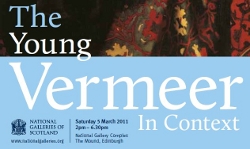
Vermeer conference
The Young Vermeer in Context
National Gallery of Scotland
The Mound, Edinburgh EH2 2EL United Kingdom
March 5, 2011 | 2 p.m.–6:30 p.m.
information form the museum:
The young Vermeer presents a unique opportunity to compare directly the three earliest paintings by Johannes Vermeer. On occasion of this exhibition the National Gallery of Scotland is staging a study afternoon, bringing together a distinguished group of international experts. Focusing on Vermeer's early career the talks will revisit his start as a history painter and shift to genre painting, his artistic and social environment, and the rediscovery of "Young Vermeer" in the 19th century. The podium will offer the opportunity to get involved and discuss these important paintings with the experts and to discover more about the development of one of the world's most celebrated artists.
speakers:
- Dr. Albert Blankert, Independent Scholar, The Hague
- Edwin Buijsen, Head of Collections, Royal Picture Gallery Mauritshuis, The Hague
- Dr. Adriaan E. Waiboer, Curator of Northern European Art, National Gallery of Ireland, Dublin
podium:
- Professor Christopher Brown, Director, The Ashmolean Museum, Oxford
- Professor Gregor J. M. Weber, Head of the Department of Fine Arts, Rijksmuseum, Amsterdam
moderation:
- Dr Tico Seifert Senior Curator of Northern
European Art, National Gallery of Scotland, Edinburgh
1.30–2 p.m., registration (HLT)
2–5 p.m., study afternoon (HLT)
5–6.30 p.m., Wine reception and private view (NG)
Tickets: £12 (£10 concessions) are available from
the Information Desk at the National Gallery Complex,
or by calling 0131 624 6560, Monday
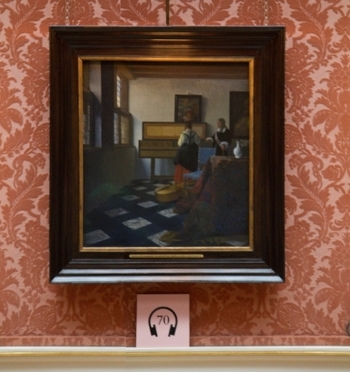
Vermeer's Music Lesson on public display
The Music Lesson is frequently inaccessible to the general public.
It will hang in Buckingham Palace, in the State Apartments picture
gallery for the months of August and September, 2011.
2010

Vermeer showing
Young Woman Seated at a Virginal on display at the Chrysler Museum of Art
Vermeer's minuscule Young Woman Seated at a Virginal - the only Vermeer in private hands - will be temporarily exhibited at it Chrysler Museum of Art, in Norfolk, Virginia from 1 June, 2010–1 January, 2011. News on programming related to the work will be reported here as they become available.
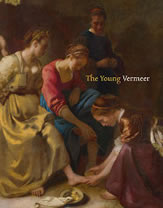
Vermeer exhibition catalogue
The Young Vermeer
by Edwin Buijsen
2010
The exhibition catalogue, with informative text and fine reproductions, delves into the three paintings from the beginning of Vermeer's artistic career: the Mauritshuis' Diana and her nymphs of c. 1653–1654, the Christ in the House of Martha and Mary (c. 1654–1656) and the National Gallery of Scotland in Edinburgh, and The Procuress (1656) from the Staatliche Kunstsammlungen in Dresden.
available at the Mauritshuis online bookshop:
http://www.mauritshuis.nl/index.aspx?ChapterID=2424&ContentID=
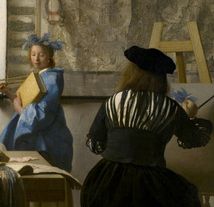
Special exhibition in Vienna of The Art of Painting
Vermeer: The Art of Painting
Kunsthistorisches Museum
Maria Theresien-Platz, Vienna
January 25 –April 5, 2010
The Art of Painting has a unique place in Vermeer's oeuvre. Although it was very likely not executed as a commission, it never left the artist's studio. Even after Vermeer's death, which left his family with enormous financial problems, his widow Catharina tried to prevent a sale of this precious painting. Most likely, it was made as a showcase piece to be presented to connoisseurs and potential customers. The exhibition investigates a number of facets of this most complex of Vermeer's compositions.
Besides extensive technological studies regarding the work's state of conservation, several central subjects are faced including the complex iconography supported by period documentation. Some of the props in the picture will be on display; a period chandelier, tapestry, wallmap as well as a precise reconstruction of a slashed doublet worn by the painter.
Other questions are investigated as well. Does the painting represent Vermeer's real studio? What does the painting reveal about Vermeer's working methods? Which pigments did painter utilized? How was the composition developed? Did the painter make use of optical devices?
Numerous loans from European and American museums and private collections and historical documents from Dutch archives provide a springboard for discovering Vermeer's masterpiece.
In addition the Kunsthistorisches Museum displays paintings, sculptures and details of films by contemporary artists (George Deem, Maria Lassnig, Peter Greenaway etc.) whose creation were inspired by Vermeer's Art of Painting.
Essential Vermeer attempts Facebook
Essential Vermeer: Facebook
http://www.facebook.com/pages/Essential-Vermeer/133691276693957
What does the global social network Facebook have to do with Vermeer? At first glance very little. Take a look at many of the art institutions' Facebook pages that tend to be one-way monologues with insignificant interaction. People's comments really don't seem to matter.
And yet the chance to bring the Vermeer community a bit closer might be worth a try. I have found Facebook surprisingly efficient for diffusing news rapidly and opening lines of quick, two-way communication.
So what can you do? Have a look, leave a comment and keep on coming I'll keep on plugging away for a year or so—the time necessary to evaluate any web initiative—and see if a marriage between social networking and art history makes any sense.
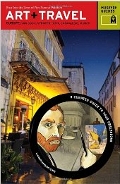
Art Travel Guide
Art + Travel Europe: Step into the Lives of Five Famous Painters
Museyon Guides
2010
Van Gogh. Munch. VERMEER. Caravaggio. Goya. Five iconic artists whose inspirational works have been obsessed over by art lovers and travelers for years.
Curated by industry experts, Art + Travel Europe is the first guidebook to feature detailed walking tours of the five cities where these artists lived, loved and labored. Readers will discover the sights and stories behind such iconic works as Starry Night and The Scream, go on the run to retrace the steps of Caravaggio in exile, plus much, much more. You know their art; now step into their lives.
Walking tours of five cities as seen through the eyes of five iconic artists: Van Gogh's Arles, Munch's Oslo, Vermeer's Delft, Caravaggio's Rome, Goya's Madrid
Contributors: Kristin Hohenadel (The Los Angeles Times), Lea Feinstein (SF Weekly), Sandra Smallenburg (Arts Editor NRC Handelsblad), George Stolz (ARTnews), Barbie Latza Nadeau (CNN Traveler)- Meticulously researched articles curated by local experts.
- Chapters loaded with useful sidebars, travel tips, and suggested itineraries with easy-to-read maps.
- Comprehensive index of artworks and museum locations around the globe.
- Listings of books, films and music inspired by or about each artist.
- Over 100 color photographs.
- Appeal for both the armchair traveler as well as the get-up-and-go traveler.
- Original cover illustrations by Tiny Inventions.
Click here to purchase at Amazon.com.
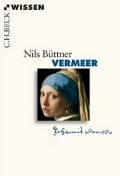
Vermeer book
Vermeer (German only)
by Nils von Büttner
2010
Jan Vermeer van Delft had a formative influence over our ideas of the Dutch Golden Age. Yet during his lifetime there were few indications of his later fame. His incomparable genre scenes came to typify his work. Nils Büttner's concise and lively introduction traces the painter's life, presents his work in its historical and social context and explains the pictures' symbolism, still often regarded as mysterious.
Vermeer lecture
VERMEER, LAIRESSE AND COMPOSITION
lecture by Paul Taylor
Auditorium of the National Library complex, 5 Prins Willem Alexanderhof, The Hague
March 5, 2010 | 4:00 p.m.
The Netherlands Institute for Art History (RKD) aims to spotlight art historians who have conducted pioneering research on Dutch art. The first lecture, entitled Vermeer, Lairesse and Composition, will be given by Dr Paul Taylor, deputy curator of the Photographic Collection at the Warburg Institute in London and a specialist in Dutch seventeenth- and eighteenth-century art and art theory. The text of the Hofstede de Groot Lecture will be published as the first volume in a new series of publications (Waanders Publishers).
Paul Taylor has distinguished himself with his investigation of several key Dutch painting concepts, such as houding, gloe and 'lakheid, on which he has published various scholarly articles: "The Concept of 'Houding' in Dutch Art Theory" (1992); "The Glow in Late Sixteenth and Seventeenth Century Dutch Paintings" (1998); "Flatness in Dutch Art: Theory and Practice"(2008). By thoroughly analyzing these terms, searching for comparable terms in Italian and French writings, and linking them with pictorial aspects of Dutch seventeenth-century painting and drawing, he has singled out in a remarkably original fashion several pictorial qualities that are characteristic of Dutch visual art in the Golden Age.
The Hofstede de Groot Lecture is named after the art historian Cornelis Hofstede de Groot (1863–1930), whose extensive art-historical documentation forms the basis of the RKD collection.
The Hofstede de Groot Lecture will be followed by a reception.
date: Friday, 5 March, 2010
time: 4:00 p.m. (you are welcome as of 3:30 p.m.: tea and coffee will be served)
admission: Free of charge
location: Auditorium of the National Library complex, 5 Prins Willem Alexanderhof, The Hague
official language: English
registration (mandatory): activiteiten@rkd.nl
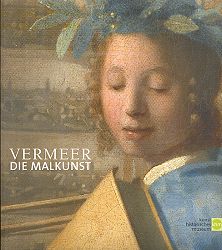
Art of Painting catalogue on sale
The sumptuous Kunsthistorisches Museum catalogue of the Art of Painting exhibition is currently on sale at the Kunsthistorisches online shop. Other than the extraordinarily fine illustrations this 259- page volume presents excellent essays.
Vermeer: Die Malkunst
exhibition catalog
2010
paperback in German
with English Translations of all essays
price: EUR 29,90
click here for bookshop link
The museum also proposes a number of Vermeer Art of Painting spinoffs like scarfs, shoulder bags, coffee cups, jigsaw puzzles and magnets as well as the more conventional postcards and reproductions.

Vermeer painting restored
Vermeer's Woman in Blue Reading a Letter to be restored
The Rijksmuseum has just announced that as a part of an ambitious conservation program Vermeer's Woman in Blue Reading a Letter will be thoroughly restored.
Other than Vermeer's masterwork, other pieces will restored and ready for the 2013 reopening of the Rijksmuseum. They include Six burial figures from the T'ang Dynasty, a mahogany period room from 1748 called The Beuning room, and the Silver table ornament by Jamnitzer which is one of the absolute highlights of the museum's collection of European silversmither.
from the Rijksmuseum website:
As it is flanked in the exhibition room by Vermeer's two other masterpieces, The Milkmaid and The Little Street, it is even more noticeable that Woman in Blue Reading a Letter is in distinct need of restoration. The coat of varnish has turned yellow, the blue is worn, the uneven layer of paint is peppered with minor irregularities, the retouches have faded, etc. Precisely that which is so appealing in Vermeer's paintings—i.e. the bright color and the incidence of light—is now hidden behind an irregular yellowed layer of varnish.
2009

Vermeer's Love Letter travels to Paris
The Dutch Golden Age: From Rembrandt to Vermeer
Pinacothèque de Paris
October 7, 2009–February 7, 2010
The Pinacothèque de Paris will host an exhibition will put on an outstanding Dutch works of art, an ensemble of over one hundred and thirty pieces, including about sixty paintings, thirty graphic works, ten etchings as well as ten objects to give an ample representation of carved ivories, tapestries, china, wooden miniatures, silverware, glassworks and furnishings.
Vermeer's late little Love Letter, will be on display.
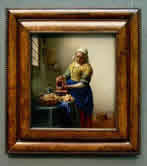
Vermeer's Milkmaid exhibited in New York
Vermeer's Masterpiece,"The Milkmaid"
Metropolitan Museum of Art, New York
September 10–November 29, 2009
Organized to honor the 400th anniversary of Henry Hudson's historic voyage to New York from Amsterdam, the show, September 10 through November 29, 2009 will focus on old masters who, like Vermeer, were active in the period of exploration, trade and artistic flowering that occurred during the Dutch Golden Age in the seventeenth century.
Documentary on Vermeer
Views on Vermeer: 12 Short Stories
color, HD, 52 min
2009
- director - Hans Pool
- photography - Hans Pool
- screenplay - Koos de Wilt
Youtube.com trailer:
http://www.youtube.com/watch?v=HTGXd-wT8_A
https://en.koosdewiltconcept.nl/
on sale at: ICARUS FILMS.com
Johannes Vermeer (1632–1675) left us a small oeuvre of only 36 paintings. Internationally, the power of his work is now more profound than ever. Blockbuster exhibitions, the novel and movie Girl with a pearl earring caught a broad audience. Millions are touched by his work. What do we see in Vermeer that makes him so contemporary? The dignity of his painted ladies, the cinematic and photographic character of his images, the psychological impact, the serenity or apparent glimpse in our own everyday life? Influential contemporary artists, photographers and opinion leaders unravel the extraordinary and mysterious impact of this seventeenth-century master in our day and age. A Film by Hans Pool and Koos de Wilt.
interviews with:
Tom Hunter, Alain de Botton, Walter Liedtke, Otto Naumann, Thomas Kaplan, Chuck Close, Philip Steadman, Peter Webber, Erwin Olaf, Joel Meyerowitz, Lawrence Weschler, Tracy Chevalier, Steve McCurry, Arthur K. Wheelock, Jonathan Janson, Philip-Lorca diCorcia, Geoffrey Batchen

Vermeer-related publication
Preserving our Heritage: Conservation, Restoration and Technical Research in the Mauritshuis
by Petria Noble, Sabrina Meloni, Carol Pottasch, Peter van der Ploeg. Epco Runia
The Mauritshuis in The Hague is one of the few Dutch museums to have its own restoration workshop. Here in recent years a team of experts have restored top works by Rembrandt, Johannes Vermeer, Carel Fabritius, Frans Hals, Hans Holbein, Jan Brueghel de Oude, Peter Paul Rubens, Anthonie van Dyck and others.
This book, with an introductory chapter, describes how a painting is made and the types of technical research that can be used. The concise texts and abundant visual material make the book accessible for a wide public.
208 pages
133 color photographs
30 b&w photographs
http://www.kunstboeken.nl/books.asp?boek=1784&rubriek=
&herkomst=zoekterm%3Dj
Dutch Art Database
The Montias Database of Seventeenth-Century Dutch Art Inventories
https://research.frick.org/montias
The Frick Library has provided an invaluable internet interface with the database compiled Montias during his studies. from the Frick website:
The Montias database, compiled by late Yale University Professor John Michael Montias, contains information from 1,280 inventories of goods (paintings, prints, sculpture, furniture, etc.) owned by people living in seventeenth century Amsterdam. Drawn from the Gemeentearchief (now known as the Stadsarchief), the actual dates of the inventories range from 1597–1681. Nearly half of the inventories were made by the Orphan Chamber for auction purposes, while almost as many were notorial death inventories for estate purposes. The remainder were bankruptcy inventories. The database includes detailed information on the 51,071 individual works of art listed in the inventories. Searches may be performed on specific artists, types of objects (painting, prints, drawings), subject matter etc. There is also extensive information on the owners, as well as on buyers and prices paid when the goods were actually in a sale. While not a complete record of all inventories in Amsterdam during this time period, the database contains a wealth of information that can elucidate patterns of buying, selling, inventorying and collecting art in Holland during the Dutch Golden Age.

Vermeer blog
The Flying Fox
Jonathan Janson, author of the Essential Vermeer, launches a blog which investigates Vermeer, current events in art history, painting technique and contemporary art.
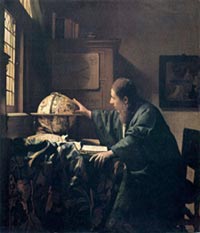
The Musée du Louvre Astronomer travels to Minneapolis
The Louvre and the Masterpiece
Art, Minneapolis, Minnesota
October 18, 2009–January 19, 2010
The Louvre and the Masterpiece will explore how the definition of a "masterpiece," as well as taste and connoisseurship, have changed over time. The exhibition will feature ninety-one works of art drawn from all eight of the Musée du Louvre's collection areas, spanning 4,000 years. Paintings, sculpture, decorative arts, and drawings will reflect three major themes: the changing historical and cultural definitions of a masterpiece; authenticity and connoisseurship; and the evolution of taste and scholarship. The exhibition is divided into three sections which together explore a range of thematic questions about the concept of a masterpiece. The exhibition includes Vermeer's Astronomer.
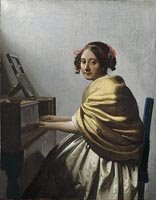
New Vermeer Painting exhibited in New York
Young Woman Seated at a Virginal at the Metropolitan Museum of Art
Metropolitan Museum of Art, New York
January 9–December, 2009
After its zigzag performance, the Young Woman Seated at a Virginal, reattributed in recent times to Vermeer, has bobbed up again in an unexpected place, next to the Woman with a Water Pitcher at the MET.
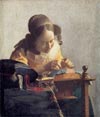
Vermeer Painting exhibited in Canada
The Louvre Museum Exhibition: Seventeenth-Century European Masterpieces.
The Louvre will be sending about 70 artworks to Japan in 2009 for a special exhibition of seventeenth-century paintings, The Louvre Museum Exhibition: Seventeenth-century European Masterpieces. The exhibition will be held at the National Museum of Western Art in Tokyo and the Kyoto Municipal Museum of Art and will include Vermeer's dazzling little Lacemaker.

Vermeer Painting exhibited in Amsterdam
Woman Holding a Balance travels to Amsterdam
Rijksmuseum, Amsterdam
March 11–June 1, 2009
The Washington National Gallery of Art will lend its Woman Holding a Balance to the Rijksmuseum in Amsterdam. The work will be displayed next to other superb works by Vermeer in the collection of the Rijksmuseum.
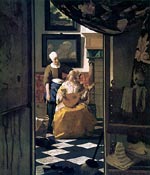
Vermeer Painting exhibited in Canada
Vermeer, Rembrandt and the Golden Age of Dutch Art: Masterpieces from the Rijksmuseum
May 9–September 13, 2009
Vancouver Art Gallery
This exhibition will highlight works of art of the seventeenth-century Dutch painting masters of the Golden Age. It will feature well over 100 works by many of the most celebrated masters of the period such as Aelbert Cuyp, Gerard Dou, Franz Hals, Rembrandt van Rijn, Jacob van Ruisdael, Gerrit ter Borch and Johannes Vermeer, as well as an extraordinary selection of decorative arts, including furniture, silver, glassware, porcelain and textiles.
This exhibition is organized in collaboration with the Rijksmuseum and will include Vermeer's late masterpiece, The Love Letter.

Dutch landscape exhibition
PRIDE OF PLACE: DUTCH CITYSCAPES OF THE GOLDEN AGE
National Gallery of Art, Washington D.C.
February 1–May 3, 2009
from the NGA website:
In the seventeenth century, a new genre of painting—the cityscape—emerged, fostered by the booming economy of the Dutch Republic and its affluent urbanites. Images of towns and cities became expressions of enormous civic pride. This exhibition of some 48 paintings, as well as 23 maps, atlases, illustrated books, and prints, offers a comprehensive survey of the Dutch cityscape, from wide-angle panoramas depicting the urban skyline with its fortifications, windmills and church steeples, to renderings of daily life along canals, in city streets, and in town squares. Joining Jacob van Ruisdael's celebrated Haarlem with the Bleaching Fields (c. 1670–1675) are works by some 40 Dutch masters. Primarily active in Amsterdam, Delft and Haarlem, these artists include Gerrit Berckheyde, Aelbert Cuyp, Jan van Goyen, Jan van der Heyden, Pieter de Hooch, Hendrick Vroom, Pieter Saenredam, and Jan Steen.
The exhibition coincides with the 400th anniversary of the Dutch exploration and settlement of the Hudson River Valley.
for further information:
- New York Times review
http://www.nytimes.com/2009/01/30/arts/design/30dutc.html
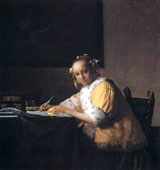
Vermeer exhibition
West Coast art lovers to see a Vermeer when the Norton Simon Museum in Pasadena, CA, exhibits "A Lady Writing"
November 7–February 2, 2009
West Coast art lovers will be offered a rare opportunity to see a Vermeer when the Norton Simon Museum in Pasadena, CA., exhibits A Lady Writing, above, from November 7 through February 2, 2009. On loan from the National Gallery of Art in Washington, the painting, one of about 35 known works by Vermeer, will come to Pasadena as part of a series of exchanges between the Norton Simon foundations and the National Gallery.

Vermeer painting exhibited in Atlanta
The Louvre and the Masterpiece
The High Museum of Art, Atlanta, Georgia
October 12, 2008–September 6, 2009
The Louvre and the Masterpiece will explore how the definition of a "masterpiece," as well as taste and connoisseurship, have changed over time. The exhibition will feature ninety-one works of art drawn from all eight of the Musée du Louvre's collection areas, spanning 4,000 years. Paintings, sculpture, decorative arts, and drawings will reflect three major themes: the changing historical and cultural definitions of a masterpiece; authenticity and connoisseurship; and the evolution of taste and scholarship. The exhibition is divided into three sections which together explore a range of thematic questions about the concept of a masterpiece. The exhibition includes Vermeer's Astronomer. February 17, 2009 "The Card Shark" by Georges de la Tour arrives to replace Vermeer's Astronomer.
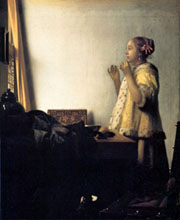
The Girl with a Pearl Necklace travels to Rome
Rembrandt to Vermeer. Civil Values in Seventeenth Century Flemish and Dutch Painting
Fondazione Roma, Museo del Corso
November 11, 2008–February 15, 2009
Representing the "Golden Century" of Flemish and Dutch art, the exhibition focuses on the development of the genre of the domestic interior, which was dedicated to family life and reflected the innovative social context and civil values of Holland in the seventeenth century. The 55 masterpieces on display will enable visitors to learn about the art and culture of Flanders and Holland during their "Golden Century."
For the first time in Italy, it will finally be possible to admire a large selection of works belonging the world's most important collection of seventeenth-century Dutch and Flemish paintings: that of Berlin's Gemäldegalerie, which includes masterpieces such as Rembrandt's The Money Changer and Vermeer's Woman with a Pearl Necklace.
for more information click here
Vermeer-related conference at the Metropolitan Museum of Art
VERMEER: TRUE AND FALSE
Grace Rainey Rodgers Auditorium, the Metropolitan Museum of Art
November 14, 2008
Lecture, 6:00 pm
from the Metropolitan Museum of Art website:
Between 1887 and 1917, thirteen paintings by Johannes Vermeer and several works wrongly attributed to him entered American collections. Continuing demand for Vermeer's rare pictures (36 are known today) created a niche market for forgers during the 1920s and 1930s, of whom the most gifted and notorious was the Dutch artist Han van Meegeren, who was active as a forger throughout most of the inter-war period. Metropolitan Museum curator Walter Liedtke (author of a n6ew monograph on Vermeer) and independent scholar Jonathan Lopez (author of a new biography of Van Meegeren) consider the difference between a Vermeer of about 1660 and one of about 1925.
Tickets go on sale on or about September 1 Order online (after September 1) at the Met's website, by phone at (212) 570-3949 by phone at (212) 570-3949, or in person at the Concerts & Lectures box office, located in the Museum's Great Hall, 1000 Fifth Avenue (at 82nd Street).
Vermeer: The Complete Paintings
by Walter Liedtke2008

Vermeer catalogue
Vermeer: The Complete Paintings
2008
Since his rediscovery in the later half of the 19th century, Johannes Vermeer (1632–1675) has been one of the most admired and influential European painters. His extremely private life, his supposed use of a camera obscura, and the fact that his teacher remains unidentified have, until recently, encouraged a view of the "Sphinx of Delft" as an isolated genius shrouded in an air of mystery. Walter Liedtke's new monograph reveals Vermeer's life to be well-documented and places his work in the context of the Delft school and of Delft society as a whole. Vermeer's many admirers will relish Liedtke's exploration of subtleties of meaning and refinements of technique and style. Alongside the most historical approach to Vermeer to date, the annotated color catalogue of Vermeer's complete paintings reveals a master whose rare sensibility may be described but not explained.
Walter Liedtke is Curator of European Paintings at the Metropolitan Museum of Art, New York. He has written widely on Dutch painting and the Delft school and is the author of fundamental texts including Vermeer and the Delft School (2001).
The Man Who Made Vermeers: Unvarnishing the Legend of Master Forger Han van Meegeren
by Jonathan Lopez2008
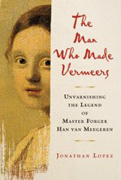
Book on Van Meegeren
Best remembered for selling a fake Vermeer to Hermann Goering during the Second World War, Han van Meegeren never admitted to creating any fakes dating from before 1937—but there have always been rumors suggesting that his career actually began much earlier than that. Drawing upon three years of archival research conducted in five nations and interviews with the descendants of Van Meegeren's partners in crime, Jonathan Lopez reveals that Van Meegeren worked virtually his entire adult life turning out bogus old masters for a ring of art-world intriguers operating out of London and Berlin. Major dealers like Sir Joseph Duveen were stung by these forgeries, as was the great Pittsburgh banker Andrew Mellon, who bought two of Van Meegeren's fake Vermeers during the 1920s. As Koen Kleijn of De Groene Amsterdammer has remarked, "The Man Who Made Vermeers shatters the popular image of Han van Meegeren as a lone gunman or picaresque rogue. Jonathan Lopez reveals the master forger as an arch-opportunist, a cunning liar, and a fervent sympathizer of the fascist cause from as early as 1928. Deftly reconstructing an insidious network of illicit trade in the art market's underworld, Lopez allows few reputations to emerge unscathed in this gripping and delicious book."
about the author:
JONATHAN LOPEZ's writings on art and history appear frequently in Apollo: The International Magazine of Art and Antiques, published in London. The Man Who Made Vermeers grew out of an article that originally appeared in Dutch in De Groene Amsterdammer. Lopez lives with his wife, an art historian and critic, in Manhattan.

6 Vermeers travel to Japan
Vermeer and the Delft Style
Tokyo Metropolitan Art Museum in Ueno-koen
August 2–December 14, 2008
Vermeer and the Delft Style features 6 rare masterpieces by Johannes Vermeer and other paintings by his contemporaries affording viewers a suggestive glance of Golden Age of Dutch Art. There has been no occasion, where these masterpieces come together in one exhibition ever hosted in Asia and only three of the Vermeer's have been formally exhibited. The Vermeer paintings included in the exhibition are: The Little Street, Diana and her Companions, The Girl with the Wine Glass, Woman with a Lute, Christ in the House of Martha and Mary and the recently re-attributed A Young Woman Seated at the Virginals which is rarely on public view. The exhibition also features the minuscule masterpiece View of Delft by Carel Fabritius, a splendid view of Delft by Van der Heyden and two fine De Hooch's.
Vermeer Lecture at the Vermeer Centrum, Delft
February 2008 | 8 p.m.
In a lecture at the Vermeer Center in Delft, Ms Karin H. Jense will explore the musical culture of the 1650s basing her observations of the paintings of Vermeer with musical themes. Period music will also performed allowing the audience to experience the atmosphere of the times and specifically of the compositions of Vermeer.
Ms Jense has studied musical education, harpsichord and choir conducting at the Koninklijk Conservatorium Den Haag (Royal Conservatory The Hague) and has been actively engaged as a music lecturer and advisor for thirty years and currently gives regular audio lectures.
further information:
e-mail:
vriendenvermeer@hetnet.nl
tel.
015 – 256 53 06 (D. Mostert-Bok)
or 06-33704508 (C. J. Oerlemans).
Vermeer's Family Secrets
by Benjamin Binstock2008
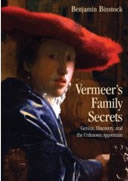
New book on Vermeer
Johannes Vermeer, one of the greatest Dutch painters and for some the single greatest painter of all, produced a remarkably small corpus of work. In Vermeer's Family Secrets, Benjamin Binstock revolutionizes how we think about Vermeer's work and life. Vermeer, "the Sphinx of Delft," is famously a mystery in art: despite the common claim that little is known of his biography, there is in fact an abundance of fascinating information about Vermeer's life that Binstock brings to bear on Vermeer's art for the first time; he also offers new interpretations of several key documents pertaining to Vermeer that have been misunderstood. Lavishly illustrated with more than 180 black and white images and more than sixty color plates, the book also includes a remarkable color gatefold spread that presents the entirety of Vermeer's oeuvre arranged in chronological order in 1/20 scale, demonstrating his gradual formal and conceptual development. No book on Vermeer has ever done this kind of visual comparison of his complete output. Like Poe's purloined letter, Vermeer's secrets are sometimes out in the open where everyone can see them. Benjamin Binstock shows us where to look. Piecing together evidence, the tools of art history, and his own intuitive skills, he gives us for the first time a history of Vermeer's work in light of Vermeer's life.
On almost every page of Vermeer's Family Secrets, there is a perception or an adjustment that rethinks what we know about Vermeer, his oeuvre, Dutch painting, and Western Art. Perhaps the most arresting revelation of Vermeer's Family Secrets is the final one: In response to inconsistencies in technique, materials and artistic level, Binstock posits that several of the paintings accepted as canonical works by Vermeer, are in fact not by Vermeer at all but by his eldest daughter, Maria. How he argues this is one of the book's many pleasures.
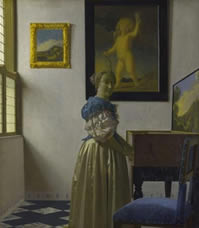
Vermeer's A Lady Standing at a Virginal part of a special exhibition
Love is in the air at the Laing Art Gallery
Newcastle upon Tyne, U.K.
April 19 –July 13, 2008
Love is in the air at the Laing Art Gallery, as flirtation, disappointment and intimacy are among the themes explored in a new exhibition. Love is a new National Gallery touring exhibition, which looks at the ways artists have responded to the pains and pleasures of love over the centuries. It features work by artists including Tracey Emin, David Hockney, Johannes Vermeer (A Lady Standing at a Virginal) and Marc Chagall. The Laing's Marble Hall will also be home to Marc Quinn's spectacular sculpture, Kiss.
venue:
New Bridge Street, Newcastle upon Tyne NE1 8AG
U.K.
tel:
(0191) 232 7734
fax:
(0191) 222 0952
open:
Monday to Saturday 10 a.m.–5 p.m., Sunday 2 p.m.–5 p.m., Closed: 25 & 26 December & 1 January.
museum website:
http://www.twmuseums.org.uk/laing
Talks programme:
A free programme of talks will take place to accompany the National Gallery touring exhibition, Love. No booking is required.
Wednesday 23 April, 12.30–1 p.m.
Love Relationships, featuring Vermeer, Wright of Derby, Stanley Spencer, and Marc Quinn
With Sarah Richardson, Keeper of Fine Art at the Laing Art Gallery
Wednesday 30 April, 12.30–1 p.m.
Romantic Love, featuring Cranach, Claude, Turner, Chagall, Emin and Hockney
With Sarah Richardson, Keeper of Fine Art at the Laing Art Gallery
Wednesday 7 May, 12.30–1 p.m.
Pre-Raphaelite Women
With Marie-Therese Mayne, Assistant Keeper of Fine Art at the Laing Art Gallery
Wednesday 14 May, 12.30–1 p.m.
Love: An Artist's Perspective
With John Dummett, whose installation Full Bloom will be on show at the Laing on the evening of Saturday 17 May.
Wednesday 21 May, 12.30–1 p.m.
A Public Display of Affection
With artist Manuel Saiz whose installation Public Display of Affection will be at the Laing from 17–25 May.
Wednesday 28 May, 12.30–1 p.m.
Love Stories
With Chris Bostock, Storyteller.
Wednesday 4 June, 12.30–1.15 p.m.
Love is a Mystery
With Serena Cant, Art Historian. Talk in Sign-Supported English.
Wednesday 11 June, 12.30–1.15 p.m.
Love in the Giardini: Sophie Calle and Tracey Emin at the Venice Bienalle 2007.
With Peter Quinn, Art Historian.
Wednesday 18 June, 12.30–1.1 p.m.
Are These Pictures About Love?
With Paul Usherwood, Art Historian.
Wednesday 25 June, 12.30–1.15 p.m.
Happy Ever After
With Serena Cant, Art Historian. Talk in Sign-Supported English.
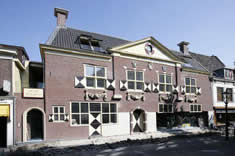
Vermeer Center reopens, Delft
Although the newly built Vermeer Center of Delft was quickly overcome by economic woes, it now seems destined to reopen. On the evening of 11th December, when the citizens of Delft gather in Market Place for the traditional Lichtjesavond ("Lights' evening") the Center will open free of charge to Delft citizens.
From January 2008 it will be opened to the public.
The center offers a valid educational starting point for the thousands visitors who flock to Vermeer's native city which, in fact, has not a single original painting by the native artist. Keep in touch with the Center's future by signing up free of the Essential Vermeer Newsletter or by clicking on the Center's website listed below.
Vermeercentrum
Voldersgracht 21
NL 2611 Delft
tel. 015 213 8588
email: info@vermeerdelft.nl
website: http://www.vermeerdelft.nl
2007
New Vermeer-related book
In this impressive and informative work, the artist's origins and home environment are revealed and his paintings are displayed and discussed within the context of time alongside a history of the influences and repercussions of this master's art.
This lavishly illustrated and beautifully bound edition includes reproductions of all of Vermeer's paintings, many of the works of his contemporaries, and documents relating to his life and city, Delft.
In the hands of an award-winning historian, Vermeer's dazzling paintings become windows that reveal how daily life and thought—from Delft to Beijing—were transformed in the seventeenth century, when the world first became global.
"Vermeer's Hat is a deftly eclectic book, in which Timothy Brook uses details drawn from the great painter's work as a series of entry points to the widest circles of world trade and cultural exchange in the seventeenth century. From the epicenter of Delft, Brook takes his readers on a journey that encompasses Chinese porcelain and beaver pelts, global temperatures and firearms, shipwrecked sailors and their companions, silver mines and Manila galleons. It is a book full of surprising pleasures."- Jonathan Spence, author of The Death of Woman Wang, In Search of Modern China and The Memory Palace of Mateo Ricci
Poems on Vermeer
Canada's first poet laureate, Bowering is both highly skilled in the formal aspects of poetry and perfectly accessible to the average reader. He is one of those old-school poets whose command of meter makes its employment seem effortless. Although some of his poems are in familiar forms and such self-invented nonce forms as those of the alphabet poems that make up part of this collection, his strong formal sense shines through even in free-verse poems, which never drag or digress but move with unrelenting, though not relentless, certainty. As for the accessibility, he doesn't bow to the fashion of substituting self-disclosure for self-awareness, and his poems are not so private as to be hermetic. In them we follow the recent life events of a man widowed after decades of marriage who finds new love and companionship, who mourns the deaths of friends and colleagues, and who finds life still rich and rewarding in its winter season. A delightful collection that may inspire readers to seek out Bowering's earlier work.
In His Milieu: Essays on Netherlandish Art in Memory of John Michael Montias
edited by Amy Golahny, Mia Mochizuki and LisaVergara
2007

New Vermeer-related book
Collected in memory of the Vermeer scholar and Yale economist J. Michael Montias, these essays take into account the latest trends in the field and provide new data on a wide range of topics in Netherlandish art. Themes include the reception of paintings and architecture; art collecting as interpreted through inventories and other documents that reveal modes of display; relationships between patrons and painters; recently found or attributed works of art; artists as teachers; and the art market. Taken together, these focused studies offer fresh perspectives on the historical appreciation and evaluation of art. Drawing upon J.M. Montias' contribution to art history, these 32 essays present new analyses, attributions and documents on Netherlandish art and material culture—including the work of Vermeer, Rubens, Rembrandt, van Eyck and others—by internationally known scholars of art history and the economics of art.
Of particular interest are those essays directly related to Vermeer:
- Albert Blankert, "The Case of Han van Meegeren's Fake Vermeer 'Supper at Erasmus' Reconsidered"
- Yoriko Kobayashi-Sato, "Vermeer and the Use of Perspective"
- Herman Roodenburg, "Visiting Vermeer: Performing Civility"
New Vermeer-related novel
In April of 1653 Joannis Vermeer married Catharina Bolnes. He was twenty and she, just twenty-one. Their marriage was opposed by her mother and the Catholic church. Vermeer was in the final year of his long apprenticeship and his ideas about art and its meaning were just forming. FAITH is the story of three winter months before that marriage—the most important months of his short life.
author's statement:
The novel, FAITH, started out as a puzzle and grew into something far more comprehensive and profound. My original idea was to write about Vermeer's wife, Catharina and her efforts to regain the painting, The Allegory of Art, after his untimely death. To do this, I knew I would have to go back to the beginning and explain how a Protestant innkeeper's son could meet, love and marry the daughter of a wealthy Catholic woman. Nothing at all is known about these events except that they actually happened. That was the first puzzle. In order to solve it, I would have to connect the young artist to his world: Delft in Holland's remarkable Golden Age. This led to further puzzles: With whom did he study? Who influenced him? Where did he paint? The list goes on and I was determined to solve these questions in an accurate and probable way. Apart from building a small but comprehensive Vermeer library and spending countless hours on the web, I traveled to Delft (exactly one year ago this month) and walked his streets and 'felt' his presence. These impressions, I trust, are captured in the novel.
However, FAITH is not a mere finger exercise in Art History or biography. The people involved in this story were artists, collectors, patrons, agents for powerful corporations, merchants, soldiers and priests, all driven by their personal passions and the heady power of their time. That world and those people form the background for FAITH, but it is a genuine and challenging love story that is at the center of it, as it should be.
In the end, I feel that I succeeded in exploring that world, but at a cost. One novel could not hold it all and do justice to it. FAITH would have to be the first in a series and I knew that I could write them. So, as it turns out, FAITH covers not 'years' in Vermeer's life but only two and a half winter months at the end of 1652. Still, as a single novel, it is complete and all of the elements mentioned above are explored in it. The second novel in the series, FIRE, will cover his marriage, entry into the Guild of Saint Luke, several early paintings including Saint Praxedis and the death of Carel Fabritius. If I live long enough, the other five: LIGHT, IMAGE, DARK, SILENCE and LOSS might also get written. One can only hope.
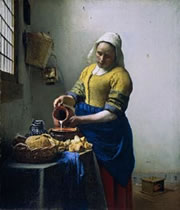
Exceptional loan of the Rijksmuseum's Milkmaid to Japan
The Milkmaid by Vermeer and Dutch Genre Painting - Masterworks from the Rijksmuseum Amsterdam
The National Art Center, Tokyo
September 26–December 17, 2007
Johannes Vermeer's The Kitchen Maid, also affectionately known as The Milkmaid, is being loaned temporarily to The National Art Center in Tokyo, Japan, where it will be on display from 26 September until 17 December, 2007 as part of the exhibition 'The Milkmaid by Vermeer and Dutch Genre Painting'. Dutch Genre Painting from the 17th–19th century introduced with 116 masterworks from the Rijksmuseum Amsterdam, featuring Vermeer's Milkmaid as a centerpiece.
check the special exhibition website (Japanese only)
The National Art Center, Tokyo
September 26–December 17, 2007
7-22-2 Roppongi Minato-ku
Tokyo, Japan
direct inquiries to:
The National Art Center, Tokyo
7-22-2 Roppongi, Minato-ku, Tokyo
Japan 106-8558
URL http://www.nact.jp
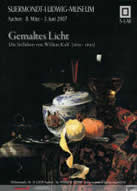
Exhibition of a great Dutch still life painter
GEMALTES LICHT: DIE STILLEBEN VON WILLEM KALF (1619–1693) (Painted light: the still life paintings of Willem Kalf (1619–1693)
Suermondt-Ludwig-Museum
Wilhelmstraße 18
D-52070 Aachen
Germany
March 8, 2007–June 3, 2007
from the website of Museum Boijmans Van Beuningen:
Willem Kalf may be the most important painter of still life pictures of the Golden Age. But, oddly enough, he is not that well-known. Kalf was born in 1619 in Rotterdam, and left for Paris at a young age. There, he painted interiors of barns, a theme typical of Rotterdam, which made him famous in Paris. After his return, in 1651, he married a wealthy and literary gifted lady in Hoorn. After which he lived in Amsterdam until his death in 1693.
Here, he painted still life pictures of very valuable objects, that sparkled against a dark background. It is as if the silver goblets and platters, the flashing Venetian glasses and expensive Chinese plates want to enchant the viewer with their mysterious splendor. Museum Boijmans Van Beuningen presents Willem Kalf for the first time with thirty paintings, mainly from foreign museums.
catalogue:
Gemaltes Licht: die Stilleben von Willem Kalf (1619–1693)
Includes essays by seven authors
c. 160 pp., with c. 125 color and 50 black-and-white illustrations
24 x 30 cm, paperbound
Deutscher Kunstverlag, Berlin
ISBN 3-422-06673-X
tel. +49 241 479 800
fax: +49 241 37075
email: info@suermondt-ludwig-museum.de
venues:
Rotterdam, Museum Boijmans Van Beuningen (25 November, 2006'18 February, 2007)
Aachen, Suermondt-Ludwig Museum (8 March'3 June, 2007)
Exhibition of a Dutch landscape painter
BRAND! JAN VAN DER HEYDEN, SCHILDER EN UITVINDER (JAN VAN DER HEYDEN- 1637–1712)
Rijksmuseum, Amsterdam
February 2, 2007–April 2007
curator:
Peter C. Sutton, executive director of the Bruce Museum
In 2007 the Rijksmuseum presents the first monographic exhibition on Jan van der Heyden in the Netherlands since 1937. Van der Heyden was one of the leading seventeenth-century painters of Dutch cityscapes. He was also fascinated by firefighting and is still remembered to this day by many as the inventor of the fire hose. The Rijksmuseum exhibition focuses on the diversity of Van der Heyden, who became known as the Dutch Leonardo da Vinci. The first part features a selection of sixteen of his finest paintings, on loan from various museums and private collections in Europe and the United States. The second part concentrates on his dramatic sketches and prints of fires in the city. In addition, his famous book on firefighting, published in 1690, is displayed, alongside an early example of his fire hose.
Eye for detail
Jan van der Heyden (Gorinchem 1637–1712 Amsterdam) was one of the leading pioneers of Dutch cityscape painting in the seventeenth century. His depictions of canals, churches, public squares, castles and courtyards reveal a remarkable eye for detail. He used sharp color, with subtle nuances of tone and atmosphere to portray these scenes, often creating striking perspective constructions.
Idealized cityscapes
Van der Heyden's paintings were already famous in his own day for their wealth of detail. Despite the apparent natural effect of the depiction, for which he developed innovative techniques, topographical accuracy was not Van der Heyden's primary concern. He often took buildings out of their original setting and placed them in an entirely new context. A composition had above all to convey the atmosphere of the location. As the inventor of the architectural capriccio, a depiction of a fictional location, Van der Heyden was a major precursor of eighteenth-century Italian vedute artists such as the Venetian Canaletto and Bernardo Bellotto.
Besides cityscapes of Amsterdam and the Rhineland, Van der Heyden also painted landscapes and several still lifes, some of which are shown in the exhibition.
catalogue:
Jan van der Heyden (1637–1712)
Peter C. Sutton, lead author. Essays: Jonathan Bikker and Arie Wallert. Catalogue entries: Taco Dibbits, Marijn Schapelhouman, and Norbert Middelkoop
250 illustrated pages, including 130 paintings, drawings and figures
New Haven, Yale University Press
venues:
Greenwich, Connecticut, The Bruce Museum (16 September, 2006–January 2007)
Amsterdam, Rijksmuseum (2 February'30 April, 2007)
address:
Rijksmuseum
Postbus 74888
1070 DN Amsterdam
Netherlands
tel. +31 20 674 7000
fax: +31 20 674 7001
email: info@rijksmuseum.nl
2
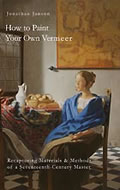
(NO LONGER available at
Lulu.com)
Vermeer-related publication
How to Paint Your Own Vermeer: Recapturing Materials and Methods of a Seventeenth-Century Masterby Jonathan Janson
2006
Which materials and techniques did Johannes Vermeer use to create his masterpieces? Is it still possible to emulate those methods today? Contemporary American painter Jonathan Janson offers straightforward, practical advice on how to reproduce Vermeer's day-to-day working procedures as closely as possible in your own studio. Detailed explanations document each and every step, from the stretching of the canvas to the three-step method used by Vermeer and his contemporaries including indispensable historical and theoretical background regarding the art and craft of Northern seventeenth-century painters.
In the first part, Vermeer's palette, drawing, pigments, brushwork, mediums, glazing, grounds are thoroughly analyzed as they are gradually encountered during the painting process The second part contains insights into crucial stylistic components which, together, make a Vermeer a Vermeer, such as color, composition, camera obscura vision and perspective.
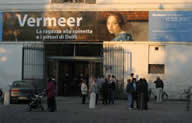
Exhibition of Vermeer's A Lady Seated at a Virginal in Modena, Italy
VERMEER: LA RAGAZZA E I PITORI DI DELFT
Galleria Estense
Modena, Italy
April 15–July 15, 2006
curator: Bert Meijer
After The Love Letter in Rome, another Vermeer will be traveling to Italy. The London A Lady Seated at a Virginal and other paintings from Delft will be exhibited at the Galleria Estense in Modena. The initiative is promoted by the superintendent of the gallery Maria Grazia Bernardini in collaboration with Bert Meijer, noted specialist active in the Dutch Institute of Florence. The exhibit will feature the works of about 25 other Dutch masters in the collections from The Hague, London, Vienna, Amsterdam, Washington, Los Angeles, Boston and Florence. The exhibit will be organized in three sections. The first is dedicated to Delft and its immediate environs. The second presents various facets of daily life of the second half of the seventeenth century focused around works of Pieter de Hooch. The third section features Vermeer's late A Lady Seated at a Virginal with other pictures of analogous theme.

Vermeer's Love Letter goes to Rome
LA LETTERA D'AMORE di VERMEER A PALAZZO BARBERINI
Galleria de arte antica de Palazzo Barberini, Rome
April 27–June, 2006
Vermeer's late Love Letter will be exhibited at Galleria di Arte Antica di Palazzo Barberini from April 26 to the June 27, 2006. The exhibition will be curated by Angela Negro and Anna lo Bianco.
more information at:
http://www.mondomostre.it/
Exhibition of the greatest seventeenth-century Dutch landscape painter
JACOB VAN RUISDAEL: MASTER OF LANDSCAPE
Royal Academy, Piccadilly, London
until 4 June, 2006
from the museum's website:
Jacob van Ruisdael was one of the greatest painters of the Golden Age of Dutch painting. He was born into abject poverty in 1628 or 1629 and much of his life is shrouded in mystery. Raised in Haarlem he moved to Amsterdam and died there in 1682. In the course of his life Ruisdael broke with many of the traditions of Dutch painting and became a figure of great influence. He is celebrated for faithfully recording nature while responding to it imaginatively. His works are also considered to be fine meditations on human experience in a world shaped by constant cycles of growth and decay.
Ruisdael's impact can be seen in the Barbizon School of France, the American Hudson River School, and in the work of John Constable, England's own leading landscape painter. To coincide with this exhibition the John Madejski Fine Rooms have been hung with a selection of landscape paintings from the Royal Academy's Permanent Collection. These works can be seen free of charge during Jacob van Ruisdael: Master of Landscape.
catalogue available at Amazon.com
This exhibition has been jointly organized by the Royal Academy of Arts, London, the Los Angeles County Museum of Art and the Philadelphia Museum of Art.
2005
Exhibition of Dutch painting
THE DUTCH GOLDEN AGE AT THE NATIONALMUSEUM
curator: Görel Cavalli-Björkman
Nationalmuseum
Södra Blasieholmshamnen
September 22, 2005–January 8, 2006
The 'realist' paintings of the seventeenth-century Netherlands offer a fascinating experience to visitors to this autumn's major exhibition at the Nationalmuseum devoted to The Dutch Golden Age. Masterpieces by Rembrandt, Frans Hals and their contemporaries will be on show from 22 September, 2005. The core of the exhibition is provided by the museum's own collections of Dutch paintings and drawings. These have been enriched by loans from other museums, most notably from the Rijksmuseum in Amsterdam, Statens Museum for Kunst in Copenhagen and the Ashmolean Museum in Oxford. The exhibition comprises some 300 works presented thematically in four galleries and six smaller rooms.
location:
Nationalmuseum
Södra Blasieholmshamnen
Phone +46 8 5195 4300, fax +46 8 5195 4436
www.nationalmuseum.se

Exhibit on of Vermeer's contemporary Frans van Mieris
VERMEER AND PLATO: PAINTING THE IDEAL
by Robert H. Huerta
2005
In a study that sweeps from Classical Antiquity to the seventeenth century, Robert D. Huerta explores the common intellectual threads that link the art of Johannes Vermeer to the philosophy of Plato. Examining the work of luminaries such as Plotinus, Nicholas of Cusa, Saint Augustine, Ficino, Raphael, Keller, Galileo, Descartes and Hoydens, Huerta argues that the concurrence of idealism and naturalism in Vermeer's art reflects the Dutch master's assimilation of Platonic and classical ideals, concepts that were part of the Renaissance revival of classical thought. Pursuing a Platonic path, Vermeer used his paintings as a visual dialectic, as part of his program to create a physical instantiation of the Ideal. Illustrated. Robert D. Huerta is an independent historian, focusing on the intersection between art and science during the early modern period.
from Bucknell University website
Exhibit on of Vermeer's contemporary Frans van Mieris
FRANS VAN MIERIS (1635–1681)
Mauritshuis, The Hague
October 1, 2005–January 22, 2006
With utmost diligence and patience Van Mieris painted interiors, scenes from daily life and portraits, primarily in a small format. He made likenesses of well-to-do burghers, famous or important residents of Leiden, and self-portraits and portraits of his wife Cunera van der Cock. He also produced a few history pieces and allegorical scenes. The strength of his work lies in his subtle and remarkable painting technique and palette. The way in which he depicted the various fabrics, materials and textures is nothing short of miraculous: an almost perfect miniature rendering of reality.
location:
Mauritshuis
Korte Vijverberg 8
NL-2513 AB The Hague
Netherlands
contact:
T +31 70 302 3456
F +31 70 365 3819
email:
communicatie@mauritshuis.nl
other venue:
National Gallery of Art, Washington (26 February'21 May, 2006)
Exhibition with Vermeer's Music Lesson
ENCHANTING THE EYE: DUTCH PAINTERS OF THE GOLDEN AGE
The Royal Collection, Buckingham Palace
February 11–October 30, 2005
museum info:
The Royal Collection contains one of the world's finest groups of Dutch seventeenth-century paintings. Among the most enduringly popular images in Western Art, these pictures have for centuries been admired for their harmonious compositions, close observation of detail, subtle light effects and meticulous finish. The 51 outstanding examples selected for the exhibition embrace genre scenes, portraits, still lifes, history paintings, landscapes and marinescapes. They include works by the great masters of the period, among them Rembrandt's jewel-like Christ and St Mary Magdalen at the Tomb and his Self-Portrait of 1642, luminous landscapes by Aelbert Cuyp, and Johannes Vermeer's enigmatic The Music Lesson..

Exhibition with Vermeer's Love Letter
DUTCH MASTERS FROM THE RIJKSMUSEUM
National Gallery of Victoria
Melbourne, Australia
June 24– October 22, 2005
museum info:
The most comprehensive display of seventeenth-century Dutch masterpieces is on its way to Melbourne for the second exhibition in the Melbourne Winter Masterpieces series.
Following the success of The Impressionists in 2004, Dutch Masters from the Rijksmuseum, Amsterdam will offer audiences the richest survey of seventeenth century Dutch art ever staged in Australia. Opening Friday 24 June, the exhibition brings together more than 100 sumptuous works and decorative objects by great artists such as Rembrandt, Frans Hals, Pieter de Hooch, and Jan Steen. The exhibition includes Vermeer's late masterpiece, The Love Letter.
Victoria Museum home page:
https://museumsvictoria.com.au/
For information and bookings:
tel.: + 61 3 8662 1555
email: enquiries@ngv.vic.gov.au
A fully illustrated exhibition catalogue will be available for purchase:

Special exhibition with Vermeer's Art of Painting
VERMEER FROM VIENNA
Mauritshuis, The Hague
March 25 –June 26, 2005
museum info:
Very exceptionally, one of the most celebrated paintings by Vermeer, The Art of Painting, c 1666-8, from the collection of the Kunsthistorisches Museum in Vienna will be on loan for three months. Vermeer's careful rendering of the details and different surface textures as well as the subtle gradations of light are testimonies to Vermeer's supreme accomplishments as a painter.
In 1996 the Mauritshuis mounted a survey exhibition of Vermeer's work. Unfortunately, the condition of The Art of Painting was not good enough to travel to the show. In the meantime, the painting has been restored, and nine years later Vermeer's showpiece can be seen to full advantage in The Hague.
email:
communicatie@mauritshuis.nl

Will Vermeer's A Young Woman at the Virginals feel at home in Las Vegas?
according to Arts.telegraph*
Las Vegas casino owner Steve Wynn is revealed this week as the mystery buyer of Vermeer's A Young Woman Seated at the Virginals at Sotheby's last July for £16.2 million. On Thursday (April 28), he opens Wynn, Las Vegas, a new $2.7 billion resort complete with golf course, lakes, a fake mountain and an art gallery in which the tiny painting will be exhibited. Sotheby's spent years trying to establish that the painting, previously dismissed as a fake, was an original. Even then, not everyone was convinced. After the sale, Sotheby's described the buyer only as "anonymous," but its re-appearance in Las Vegas confirms that it was Wynn who took the gamble.
more about Vermeer's brand new home**
The strip's newest and most expensive casino resort is just days away from opening its doors. Wynn, Las Vegas is a 2.7 billion dollar resort. It will have more than 27-hundred rooms. The resort features a large, man-made mountain in the front of the hotel, with huge waterfalls facing inwards. That structure alone cost an estimated 130-million dollars to build.
Wynn, Las Vegas (the name of the new casino) will also feature a Ferrari-Maserati dealership inside. As for entertainment, Franco Dragone will put on a multi-million water-themed production called "La Reve." The two-thousand-plus theater-in-the-round includes a one-million gallon performance pool that doubles as a stage. Wynn will include 18 new restaurants and bars overseen by celebrity chefs.
* :
Market news: Vermeer gamble
Arts.telegraph, 25/04/2005
**:
"Wynn, Las Vegas Only A Few Days Away From Opening"
April 27, 2005, 07:46 PM
Exhibition of Vermeer's contemporary
GERARD TER BORCH
The Detroit Institute of Arts (DIA)
February 27–May 22, 2005
(in Detroit this exhibit is organized by George Keyes, DIA chief curator and curator of European paintings)
museum information:
Gerard ter Borch is one of the most celebrated of all seventeenth-century Dutch painters, yet remarkably, no exhibition in the United States has ever focused on his work. To assess his important oeuvre, the American Federation of Arts and the National Gallery of Art are organizing an exhibition of this great master's paintings. Gerrit ter Borch will comprise approximately forty-five paintings, including Ter Borch's most striking early pictures from the 1630's, the mid-career genre paintings for which he is most famous, depictions of historical events, and the small and delicate portraits that brought the artist prosperity throughout his professional life.
This exhibition will not only give museum visitors in the United States their first opportunity to see a broad overview of Ter Borch's work, but will also result in the first major English-language publication on the artist. The exhibition catalogue, to be published by the American Federation of Arts and the National Gallery of Art, will include an essay by Arthur K. Wheelock, Jr, Curator of Northern Baroque Paintings at the National Gallery of Art, Washington, on Ter Borch's life and work; a study of the modernity of Ter Borch's paintings by Alison McNeil Kettering, Professor of Art History at Carleton College; and an examination of Ter Borch's painting technique by Arie Wallert, Conservator of Paintings at the Rijksmuseum, Amsterdam. In addition, each painting in the exhibition will be illustrated and discussed in a separate entry.
location:
Washington D.C. 20565
USA
tel.: +1 202 737 4215
email: der-info@nga.gov
other venues:
National Gallery of Art
Constitution Avenue NW
November 7, 2004–January 30, 2005
Exhibition of Vermeer's contemporary
CAREL FABRITIUS (1622–1654): DAS WERK
Staatliches Museum Schwerin, Schwerin
January 29–May 16, 2005
curators:
Kornelia von Berswordt-Walrabe, Frits Duparc, Peter van der Ploeg, Gero Seelig and Ariane van Suchtelen.
museum press release, January 2005:
In collaboration with the Mauritshuis The Hague, the Staatliches Museum Schwerin for the first time shows the complete known oeuvre of Fabritius, which consists of 14 paintings. His paintings, scattered all over the world, are highlights of the collections of which they are a part. This exhibition affords the singular opportunity of a synopsis of paintings which feature in collections in Boston, Los Angeles, London, Moscow, Warsaw, Amsterdam, The Hague, Rotterdam, Salzburg, Munich, Hannover and Schwerin.
Carel Fabritius, a pupil of Rembrandt, was undoubtedly one of the most ingenious and versatile painters of the Dutch seventeenth century. His work had a decisive influence on Johannes Vermeer, Pieter de Hooch and Emanuel de Witte. The explosion of the municipal arsenal in Delft in 1654 not only took the painter's life but destroyed many of his work as well. Masterpieces such as The Goldfinch, The Sentry and the View in Delft, with a musical instrument seller's stall, rank among the most handsome and famous of Dutch paintings. Fabritius' complete (modest) oeuvre will be brought together in cooperation with the Staatliches Museum in Schwerin.
catalogue:
Almost half of these works have been attributed to Fabritius only after the publication of Christopher Brown's catalogue raisonée in 1981 and are presented together for the first time in the exhibition catalogue. The catalogue includes a comprehensive essay describing the life and work of the artist, a text on his means of composition as well as entries on every single painting. All paintings are illustrated in full color. His connection to Rembrandt is assessed and the influence on the Delft School discussed. The book is published in English, German and Dutch.
location:
Staatliches Museum Schwerin
Alter Garten 3
D-19055 Schwerin
Germany
contact:
tel. +49 385 5958 119
fax: +49 385 563 090
email:
info@museum-schwerin.de

Exhibition of Dutch trompe-l'œil painter at the Mauritshuis
THE EYE DECEIVED: TROMPE-L'OEIL PAINTINGS BY CORNELIUS GIJSBRECHTS
Mauritshuis, The Hague
February 4 –May 15, 2005
museum info:
The originally Flemish painter Gysbrechts entered the service of the Danish court in 1668. In the following four years he produced a unique series of trompe-l'œil paintings for King Frederik III and his successor Christiaan V. While various seventeenth-century artists attempted to paint the odd trompe-l'œilrepresentation, Gysbrechts made it his specialty. His partially open wall cabinets, letter racks, turned-back cloths and hunting still lifes ingeniously deceive the viewer's eye.
catalogue available (Dutch only)
email:
communicatie@mauritshuis.nl

Exhibition with Vermeer's The Woman with a Lute, A Lady Writing, The Geographer, The Love Letter and The Lacemaker
Der zauber des alltäglichen: Holländische malerei von Adriaen Brouwer bis Johannes Vermeer
(The magic of the ordinary: Dutch painting from Adriaen Brouwer to Johannes Vermeer)
from the museum website:
Elegant ladies in satin dresses, maids in starched bonnets, and pensive scholars in their studies, there is hardly a period we seem to know more about than life in the Golden Age. Yet the well-ordered world of the Dutch burghers has a flip side where the lady of the house is drinking wine in broad daylight and an uncouth peasant is pulling disgusted faces. This exhibition presents the great variety of subjects and meanings of the kind of painting so unsatisfactorily classed as genre painting.
Key works in the collections of the Museum Boijmans Van Beuningen in Rotterdam, longstanding partner of many successful joint projects, and of the Städel itself form the basis on which a new generic concept is to be developed. Dismissed by contemporary art critics, these works were so popular with audiences at the time that painters even specialized in the production of such art. Well-known artists like Jan Vermeer, Adriaen Brouwer and Jan Steen developed their own styles and storylines, which fascinate viewers to this day and whose comic details charm us into laughter.
Among the painters in the exhibition are: Frans van Mieris, Adriaen Brouwer, Adriaen van Ostade, Gerrit Dou, Gerrit ter Borch, Jan Steen, Pieter de Hooch and Gabriel Metsu.
location:
Städelsches Kunstinstitut und Städtische Galerie
Dürerstrasse 2
D-60596 Frankfurt am Main
Germany
tel.: +49 69 605 098 200
fax: +49 69 610 163
e-mail: info@staedelmuseum.de
co-organizer:
In collaboration with the Museum Boijmans Van Beuningen, Rotterdam
Vermeer lecture
THE LIGHT AND SHADE AND THE LADIES: THE QUIET WORLD OF JAN VERMEER
Presented by Barbara Johnston - adjunct professor of art history, Virginia
Commonwealth University
Monday, April 4, 7:30 p.m., Williamsburg Library Theatre, 515 Scotland Street, Williamsburg, Virginia
(USA)
To look at a painting by Jan Vermeer is to enter an enchanted world of silent women and glowing light. The preeminent painter of women in a society fascinated by them, Vermeer's small, intimate paintings have a unique quality that sets them apart from the work of his contemporaries. From the virtuous kitchen maid to the dutiful housewife, Vermeer's women occupy a world of their own, a world of serenity and order that was the ideal of womanhood in seventeenth-century Holland. But things are not always as they seem, for Vermeer was a master of subtext, and in each painting, he has given us clues to help us understand the inner life of his ladies. By examining these works, we come to realize that a great deal lies beneath the serene surfaces Vermeer's women present to the world.
This Century Art Gallery and the library continues their popular art-lecture series which is made possible through the Gallery's partnership program with the Virginia Museum of Fine Arts. A reception provided by This Century Art Gallery will follow.











